You are using an outdated browser. Please upgrade your browser to improve your experience.


Three Passes Trek
- Trekking in Nepal
- Everest Region
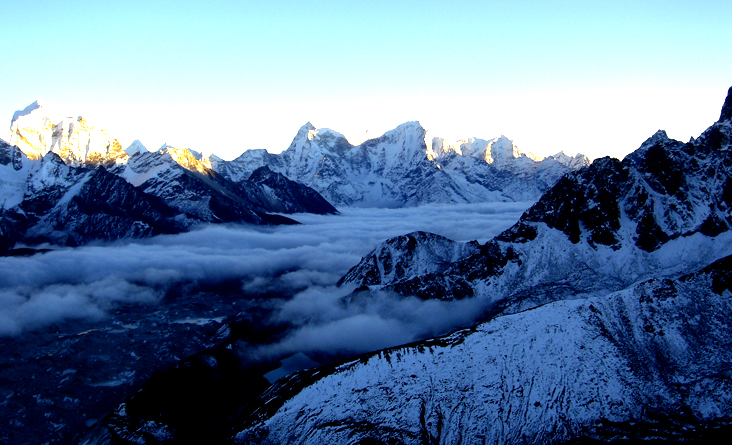
Since the terrain can be hard and the days long, hikers on these treks should be in good physical condition and have some previous mountain walking experience. Steep climbing may be involved, although it is never necessary to use ropes. Treks at this level can he arranged for periods of 16 to 21 days. Typically, a gradual ascent through a green river valley will lead you up to a number of high passes, where you will reach the altitude of 5416m. Often times, you will get a close insight into the Tibetan culture. Participants should expect to trek above 5416m/17872ft.
Group Price
Number of Travellers
- Detail itinerary
- Cost Includes/Excludes
- Fixed Departures
- Reviews (19)
Everest Three Passes Trek in Nepal:
The Three Passes trek in the Everest region is one of the most popular treks in Nepal. The trek takes you through three different passes, each with its unique scenery. You’ll get to see the beautiful Himalayan scenery. The Everest 3 Passes Trek offers high mountain passes, and challenging trekking passes in Nepal . green meadows, and high passes on the alpine plateau of the Everest Region. Additionally, Enjoy the three passes to trek the wonders of the famous Everest region, including Gokyo Lake on this 17-day hike from Lukla. fly from Kathmandu to Lukla and begin the Three-pass trek with Nepal Wilderness Trekking an expert guide and porters. Discovering the history and geology of each site, the old and historical monastery of Tengboche, Sagarmatha National Park offers countless Himalayan peaks, the gorgeous Dudh Koshi river, natural streams, and cool water flowing.
The 3 pass trek follows the Everest Base Camp route for a two to three-week Trip, which provides some stunning views of the Himalayas and Mount Everest during the trek. As one of the most scenic treks in the world, the Everest Base Camp trek can be enjoyable, but the Everest Three Passes trek can offer you even more of the region’s beauty. There has been a lot of interest in the inner Sagarmatha National Park of the Gokyo Lakes trek and the EBC trek which includes the three passes, and this trek takes you through the endpoint of that trek.
The Everest three passes trek is through a remote alpine highlander area of Sherpa Villages, various landscapes , charming Sherpa village, Namche Bazaar , the Birthplace of Apa Sherpa “village THAME” which summits 21 times the top of the world’s highest peak Mt. Everest, glory Gokyo lake , and largest Khumbu glacier. The total distance of the Three Passes Trek is about 92 miles round trip, and it takes 17 days in total to complete the trek. Many solo travelers and small groups of travelers like to take the Three Passes Trek.
Everest 3 passes trek difficulty:
Additionally, the Everest Three Passes trek is also a moderately difficult trek, which requires a lot of stamina for hiking skills, and requires well-prepared equipment with a set of microspikes if necessary. 3 passes in the Nepal trekking area are always covered in snow and ice. This itinerary is meant for those who are looking for a challenging and long hike 17 days of strenuous hikes up the mountains of 3 passes, the high altitude mountain (Bhanjyang), the Renjo la Pass 4,790 meters, the Cho la Pass 5,420 meters, and the Kongma-La pass 5,310 meters.
The best options route is clockwise to do Everest high passes trek that summits Gokyo Ri at 5,420 m (17,782 ft), and Kala Patthar at 5,644 m (18,519 ft). Chhukung Ri 5,550 meters (18,209 ft) or Mhra peak without climbing permits, from these Trekking peaks, you can film – take photographs of beautiful mountains Mt. Everest, Mt. Pumori, Mt. Makalu, Mt. Lhotse, Ama Dablam, and many white peaks, it is a breath-taking mountain view. December and January are remedied alternative paths via Phorche village instead of Cho La because Cho La will be closed if there is heavy snow.
The more hidden Peaks surrounding 3 passes of Everest Trek:
Enhance, there are many hidden Peaks, surrounding the 3 passes Everest Trek, the Sundar Peak 5,360 m in Thame, Nangkartshang Peak 5,100 M in Lungden, Ngozumpa Tse Peak 5,553 M in Gokyo, Awi Peak 5,245 M in Zhong la, Pokalde peak (Dolma Ri 5,806 m) in Kongma-La ridge, Chukhung Ri 5,546 in Chhukung, and Nagartsang Peak 5,083 M in Dingboche. so if your time permits to ascend all peaks then can add some more extra days.
What is the reason for the clockwise itinerary rather than the counterclockwise itinerary?
Our previous experience leading the passes trek has shown that many customers give up after the Everest base camp and Kala Patthar because they have only set their minds on trekking Everest Base Camp. There are, of course, beautiful Gokyo Lakes and charming Gokyo Peak to admire.
If we lead clockwise from Renjo Pass , they all make their way to Everest Base Camp via Gokyo Lake, which is also excellent acclimatization for further passes via clockwise since Renjo Pass is located at 5380 meters, Chola Pass is located at 5420 meters. Kongma Pass is located at 5540 meters.
Numerically, it doesn’t matter , but when you are on the spot, even climbing 30 meters matters. However, for us, it is no problem to lead you on both sides as you wish, so we listed both itineraries and so we do lead as you wish.
Trekking over the three passes:
The highest 3 passes trek is the most popular trekking destination among those seeking extreme adventure around the world. Various trekking routes are available for you to choose from. You will be able to make the best choice according to the length of your stay, your desire for adventure, and your level of determination. You will encounter several trekkers and tourists along the way. As a result, the route is relatively safe. There is no doubt that the 3 passes trek is one of a high caliber, offering a truly unique experience. This package offers a 17-day trek with three passes, which is not only beautiful but also more adventurous.
Three passes trek distance of km:
Three passes trek vs. Everest base camp Length is a total distance of 148 kilometers, per day hike is approximately 11.5 Kilometers, though depending on the altitude area, low altitudes can hike more than 11.5 km, and above the 5,000 altitudes is less km.
Everest three passes Trek is not recommended without a guide:
A 3-pass trek is not recommendable without guides and porters for independent solo travelers, the reasons are miserable trails, difficult ascent climbs, icy, slippery Cliffs, high altitude passes, and often changing weather.
Nepal wilderness trekking guide team is an expert in the 3 passes trek route, we lead a small group and solo trekkers every day at season time, our guide knows all and every corner of the Everest region, because of a local guide who did three high passes trek uncountable, every month at season time, so guides know every stone steps, mountains, peoples, cultures, area parameter trails
Three Passes Trek with Nepal Wilderness Trekking Company:
Nepal Wilderness Trekking and Expedition is known as the top-rated company among many agencies because of the following salient features of the company. Locally Owned and Operated. As a local travel operator, we have a lot of experience regarding the Three Passes Trek and its surroundings. We know how to get you to the Three Passes route in the best way possible and how to get you there in the same way.
Our Three Passes Trek’s success rate is great because Nepal Wilderness Trekking is a very trustworthy trekking company in the sense that we are operating all Three Passes Trek based on reality, integrity, and honesty. We are committed to meeting your needs. We highly value all trekkers and are responsive to their needs and preferences. Depending on the interests and plans of our customers, we can customize our Three Passes Trek package to suit their needs.
Value for money. Nepal Wilderness Trekking provides the value of what you buy of our services at least equal to the amount you pay. You will not be charged any middle and hidden fees when you purchase our services. Our one travel consultant or our local expert trekking guide will stay in close contact with our clients every step of the way. Our company ensures customers’ safety at all times so that they will have peace of mind while trekking to Three Passes with us.
The Three Passes trek is challenging for beginner trekkers:
For beginner trekkers, the altitude and rugged terrain of the Three Passes trek can pose several challenges. Altitude sickness is a real concern, as the trek takes you above 5,000 meters, where oxygen levels are significantly lower. Proper acclimatization and a slow ascent are crucial to minimize the risk of altitude-related illnesses. Additionally, the trail itself can be physically demanding, with steep ascents and descents, rocky paths, and potentially harsh weather conditions. Trekkers should be prepared for long days of hiking, often averaging 6 to 8 hours of walking per day. Ultimately, while the Three Passes trek may be tough for beginners, it is also a transformative experience that rewards those who dare to take on the challenge with unforgettable memories and a sense of accomplishment.
Everest high passes Trip Highlights:
- 3 Best Places for Photographers during Everest High Passes Trek from Gokyo Ri, Kalapathar, and Chhukung Ri.
- The unsurpassed breathtaking view of Mount Everest, Cho Oyu, and Makalu from Gokyo Ri, Kalapathar, and Chhukung
- Experience vibrant Sherpa communities’ cultural heritage
- Stunningly Buddhist religious old monasteries
To do a three-pass trek are only 2 types of permits required, it is Everest National Park Entry Permit and Khumbu Pasang Lhamu Rural Municipality Entrance Permit. this norman permits coverage entire region.
Note: All published dates below are guaranteed departures. If they don’t fit your schedule, we’re happy to arrange a trip on your preferred dates. Share your desired trip details, and we’ll make your dream destination a reality.

Detail Itinerary
- Day 01: Tara air to Lukla Hillary airport early in the morning ( 2860 meters , 35 minutes) and treks to Phakding ( 2640 meters, 3 hours). Overnight at Lodge . During the evening village tour,
- Day 02: Trek to Namche Bazaar ( 3440 meters. 6/7 hours walking) and stay the night at the lodge.
- Day 03: Rest day in the same place for acclimatization. Visit the Sherpa Museum and Everest View Lodge for panoramic views of the Himalayan mountains.
- Day 04: Trek to Thame (3750m) walking for 4 hours. This village is well known to Everest climbers and is a comfortable place to stay overnight.
- Day 05: 5-6 hours walking) to Lungdeng (4600m) and stay overnight at the lodge.
- Day 06: Gokyo ( 4700 meters. ) via Renjo Pass (5360 meters.) 6-hour walking trek) Stay overnight at Gokyo.
- Day 07: Gokyo Peak ( 5357 meters ), our highest point (four and a half hours walking), offers sunrise and an expansive view of the mountain range. Return to Gokyo, and stay overnight at the lodge.
- Day 08: 5 hours walk to Tangnak 4843M . overnight at the lodge (if you have extra days, you can stay one more night in Gokyo and visit the 5th Lake for even more incredible mountain views).
- Day 09: Trek to Zhong La ( 4830 M. via Chola Pass ( 5420 meters. Six or seven hours walking) today the path is narrow and tiny ascending to the top of Cho La. Stay overnight at the lodge.
- Day 10: We trekked to Lobuche ( 4940 meters ..4 hours walk) and stayed at a lodge.
- Day 11: Trek to Gorakshep 5164M , visit Everest base camp 5,364 m the same day, and return to Gorakshep, totals hike will be 8/9 hours, overnight at lodge.
- Day 12: Explore Kalapattar ( 5,545 meters). for the most stunning view of Everest, climb up in the morning before trekking back to Lobuche (5 hours of walking), and spend the night at a lodge.
- Day 13: Cross Kongma-La (5540m), and stay overnight at Ding Boche Lodge.
- Day 14: Trek back to Tyangboche 3860m in five hours and spend the night at the lodge.
- Day 15: Trek back to Namche Bazaar ( 3440 meters , 6/7 hours walking). Stay overnight at the lodge.
- Day 16: Trek back to Lukla (7/8 hours walking) and overnight at the lodge.
- Day 17: Fly back to Kathmandu around 7:00 AM (35 minutes)
Itinerary Options B:
- Day 01: Tara air to Lukla Hillary airport early in the morning ( 2860 meters , 35 minutes) and treks to Phakding ( 2640 meters, 3 hours). Overnight at Lodge . During the evening village tour,
- Day 02: Trek to Namche Bazaar ( 3440 meters 6/7 hours walking) and stay the night at the lodge.
- Day 03: Rest day in the same place for acclimatization. Visit the Sherpa Museum and Everest View Lodge for panoramic views of the Himalayan mountains.
- Day 04: Trek to Tyangboche 3860m in five hours and spend the night at the lodge.
- Day 05: Trek to Dingboche 4,340 m 5-hour hike, overnight at lodge.
- Day 06: rest day for acclimatization, or hike Chhukung RI, overnight at lodge.
- Day 07: Trek to Lobuche ( 4940 meters . Via Kongma-La pass (5540m.6.7 hours walk) and stayed at a lodge.
- Day 08: Trek to Gorakshep 5164 M , store the bags in the lodge visit Everest base camp 5,364 m the same day, and return to Gorakshep, overnight at lodge. total hike will be 8/9 hours.
- Day 09: Explore Kalapattar ( 5,545 meters). for the most stunning view of Everest, climb up in the morning before trekking back to Zong la 4830 M (5 hours walking), and spend the night at a lodge.
- Day 10: 6 hours walk to Tangnak 4843M . via Chola Pass ( 5420 meters, overnight at the lodge
- Day 11: Trek to Gokyo ( 4700 meters. ) 3-hour walking trek) Stay overnight at Gokyo.
- Day 12: visit Gokyo Peak ( 5357 meters ), our highest point (four and a half hours walking), which offers sunrise and an expansive view of the mountain range. Return to Gokyo, and stay overnight at the lodge.
- Day 13: 5-6 hours walking) to Lungdeng (4600m) via Renjo Pass (5360 meters and stay overnight at the lodge.
- Day 14: Trek to Thame (3750m) walking for 5 hours. This village is well known to Everest climbers and is a comfortable place to stay overnight.
- Day 15: Trek back to Namche Bazaar ( 3440 meters 4 hours walking) and stay the night at the lodge.
- Day 16: Trek back to Lukla (7/8 hours walking) and overnight at the lodge.
- Day 17: Fly back to Kathmandu around 7:00 AM (35 minutes)
Cost Included
- Domestic flight tickets from Kathmandu to Lukla and Lukla to Kathmandu
- Italian, Chinese, Nepali, Indian, and other European foods are available three times a day (breakfast, lunch, and dinner).
- Accommodation in tea houses according to the itinerary
- Kitbag for storing your belongings
- Sleeping bag for a comfortable night's sleep on a trek in minus-25 degrees
- Everest National Park Entrance Trekking Permit
- Khumbu Pasang Lhamu Rural Municipality Entrance Permit
- Experienced English-speaking trekking guide licensed by the government, familiar with the area.
- One porter for every two to three participants. (Note: An additional cost applies for solo clients requiring a porter.)
- Guide, and Porter meals, accommodation, salary, and insurance
- Necessary paper works, all government, and local taxes
- A certificate of appreciation from Nepal wilderness trekking after a successful trek
Cost Excluded
- Airfare for international flights
- Upon arrival at Tribhuwan International Airport, Nepal entry visa fees vary by duration (15 days - $25-30, 30 days
- Accommodations and meals in Kathmandu before and after our journey
- Personal equipment for high and cold temperatures
- Emergency high-altitude rescue and evacuation are covered by travel insurance
- All beverages, Soft and coffee table drinks such as coke, beer,
- Drinking water/mineral water, Dessert, etc. Hot shower, laundry
- Tip for guide and porter
- Excluded are all costs and expenses not listed under "cost includes"
- Inclusion of costs or delays beyond the control of the management, such as landslides, weather conditions, itinerary modifications due to safety concerns, illness, changes in government policies, strikes, etc.
Overall, my trek on the Everest 3 passes was fantastic, largely due to the great company and especially the wonderful guide!
I highly recommend Nepal Wilderness Trekking. Himel was incredibly responsive, helping me arrange my trip with just a week’s notice. Many other operators I spoke with wanted to steer me toward a less challenging route in February, but Himal and I decided to give the 3 passes a shot, agreeing to adjust plans if needed for safety. When I arrived in Kathmandu, Himal warmly greeted me at his office, provided the necessary gear (like a sleeping bag, jacket and crampons), and set me up for the journey ahead.
I had an incredible experience with my guide, Naba Raj Rai, whom I would also strongly recommend. His deep knowledge of the region enriched the trek, and he consistently ensured my safety. Naba and I frequently discussed our route, making adjustments as necessary or requested, which significantly enhanced the journey. Moreover, Naba’s assistance with logistics and carrying loads made the trek far more enjoyable. Thank you, Naba!
Wild time with NWT!
My wife and Mirthe I completed the Three Passes Trek with Nepal Wilderness Trekking and had an amazing time. Upon arrival in Kathmandu we visited several trekking agencies and immediately had a good feeling with Himal, the owner of NWT. We choose his company and are very happy we did. Himal professionally took care of all the organization and we left two days later with our guide Abinta and porter Ram. Our guide Abinta was very professional, proactive and social and had excellent English skills and a great sense of humour. It often felt like we were on the trail as a group of friends, while we could rely on Abinta for her help and guidance as well. Ram was a very strong and friendly porter and we could not have completed the trek without him.
Overall, we can recommend Nepal Wilderness Trekking for the experience of a lifetime!
Stunning Three Passes Trek
My friend and I booked the trip with Nepal wilderness, modified Three Passes Trek with the Everest Base Camp add-on, and it was truly an incredible experience! Our guide, Yakub, played a crucial role in making this trip so memorable for us. His attentive care and wealth of knowledge made all the difference.
We encountered a travel delay with our flights into Lukla at the start of our journey, but Yakub handled it brilliantly. He remained positive and quickly arranged an alternative, ensuring that our trip proceeded smoothly.
Thanks to his efforts, we were able to fully enjoy our adventure without any hiccups. It was an unforgettable journey!
Base Camp, Cho La Pass, Renjo La Pass, Kongma Pass, Gokyo Ri, and Kala Patthar
It was under the provision of Mr. Himal Ghale’s Nepal Wilderness Trekking Agency that I participated in one of the most beautiful treks in Nepal, the 17 days Everest Base Camp and three Passes.
As a result of being free from work, I returned to Nepal on October 5th. I felt a sense of misgiving as the plane landed at Tribhuvan since I saw rain out the window. The monsoons lasted longer than expected this year, and the rain followed Rajesh Gurung and me for the first few days. Because of the rain, we spent three days in Dingboche waiting for the rain to stop instead of the two days planned for acclimatization. The rest of the days, however, were sunny and crystal-clear, so we didn’t miss anything.
Visitors are often caught in the defilements caused by high altitudes. It happened to me more or less this time as well. As a result of Rajesh’s assistance on the way, I was able to reach the Everest Base Camp and all three passes with three peaks by October 23rd. As a result of Rajesh’s assistance on the way, I was able to reach the Everest Base Camp and all three passes with three peaks by October 23rd.
Kongma La Trek was a bit of an adventure since the sun had already set when we reached the edge of Solukhumbu Glacier, where the Lobuche direction marker was. Therefore, we had to continue crossing the glacier in the dark. Currently, it appears that we have lost our way. Unfortunately, when I had already resigned to the fact that we would spend the night there, listening to the rocky boulders falling into the water, Rajesh detected the way.
The assistance of his knowledge, patience, and thoughtfulness can match the requirements of critical trekking incidents.
The beauty of nature was worth dying for, so I didn’t regret any shortness of breath. The beauty of nature was worth dying for, so I didn’t regret any shortness of breath. My camera captured some unforgettable moments.
The best of the best are Himal and Riddhi! If you are looking for an agency that can help you plan your Nepal hiking trips, I highly recommend Nepal Wilderness Trekking. We did the 3 Passes Trek, and I have to say, that this is by far the hardest trek that I have ever done, however, it is also the most rewarding.
We are really lucky to have Riddhi as our guide, and the two porters taking care of us the whole time we are in the mountains. There is no doubt that Riddhi is considerate, caring, and has a wealth of knowledge about the area in which he lives. As a result, I really appreciate that he constantly makes sure we have a good time by adjusting our pace and itinerary to ensure we are having a good time.
The purpose of this comment is to thank Himal, Riddhi, and the two porters for their hard work in making this 17-day three passes trek so special to me and memorable for me.
Nepal Wilderness Trekking is a company that is completely trustworthy and seriously committed to its clients. For me, it was a DREAM COME TRUE!! I hiked in the KHUMBU Valley for 16 days to Gokyo, Renjo, and Kongma La, it was an awesome experience, I wanted to go alone to the Everest Region and this trip was incredible, I was with a fantastic guide GUNESH, who took care of everything for me, including logistics, food, and helped make this an incredible experience.
Nepal Wilderness Trekking is a trek I highly recommend. Himal, the owner of the property, was always responsive both leading up to and during the trip. Furthermore, after my hospitalization, Himal took very good care of me and made sure that I still had a memorable experience while I was in Nepal.
As soon as we arrived in Kathmandu, we met up with him for a pre-day check-in and he made himself available for any further questions our group may have. Furthermore, he gave us the option of storing our luggage at his office if we did not want to store our luggage at the hotel. As well as offering some trekking tips, he also gave us the option of either using the duffel bags from his trekking company or the ones we brought with us. The porters would be responsible for carrying the duffel bags.
I am very grateful to have had a trekking guide and a porter to accompany me on the trip. Our trekking guide took care of all the logistics related to permits, and teahouses, and guided us on the right path all by himself. All of the items that I was not going to use while trekking for that particular day was carried by the porter. The result of this was that I was able to trek with a light daypack (maximum recommended weight of 7kg) while the porter carried the remaining 10kg to 15kg of my luggage. The trekking guide we had was Riddhi and my porter was Sid. Both were caring, thoughtful, and wonderful people.
I had the unfortunate experience of getting Acute Mountain Sickness (AMS) on day 3 of my 17-day trek and had to be med-evacuated to the hospital. Since I was unable to be at high altitudes as a result of my medical condition, the Himalayas were no longer an option for me. Instead, Himal and I worked together to design a low-altitude itinerary that would align with all of the parameters of my health requirements. In addition to a personal trekking guide/porter, I visited the cultural and culinary history of Kathmandu, spelunked, and went sightseeing around Pokhara, including a 2-day trek to Poon Hill. I also visited the Buddhist monasteries of Lumbini (birthplace of Buddha) and took a mountain flight through the Himalayas.
Despite the fact that I was unable to complete my 17-day trek through the three passes which included Everest Basecamp, Himal helped me salvage my trip and put me on a custom trip that he and I planned together. Himal was thoughtful, responsive, and did his best to ensure my experience in Nepal was good. He even visited me the first two days I was in the hospital. It was a great pleasure to book my trip through Nepal Wilderness Trekking. I doubt that any other trekking company would have worked as hard as Himal did to help me create such a wonderful 3-week experience in Nepal despite my inability to hike the Himalayas.
I have done the 3 Pass Trek with this company and I have to say it was very challenging, but rewarding and worth it nonetheless. It was one of the hardest ones yet compared to the ones that people usually do (16 days, several nights above 15,000 ft and counterclockwise direction), so it can really push you to the very edge of your abilities. I recommend this trek only to those who are in pretty good hiking shape as even in the best shape, you will still be able to kick your butt out of this trek.
It was a great pleasure to have a guide and porter with us. As a group, we were led by Riddhi who was a great guide – he was warm, welcoming, and took great care of us (there was a lot of adjustment needed to get used to the altitude, cold, and physical requirements required for this trek). We were together for a long time doing this hike and it was wonderful to have someone who knew what they were doing and could take care of the lodging and details for us. In addition, it was really nice to see that the guides also got excited about the mountains as well. He was just as excited as we were to see the views from the passes and Mt Everest from up there.
We also had our porters carry our extra luggage, and they did a great job. In hindsight, it is hard to imagine having to carry everything you would need for this trip all by yourself. Our guide manager, Himal, prior to our trip was very communicative and responsive. We asked him all the questions we had, and he was very helpful when one of our friends needed help during the trip. I would highly recommend him as someone to know when going on a trip like this. As a whole, I found the value and price for this tour to be very good, and I would recommend this company to others.
During our trek to the Everest area, we did an amazing and epic 17-day trek covering three passes. Our guide Riddhi did an outstanding job of setting up a challenging yet spectacular itinerary through some of the tallest mountains in the world with our owner Himal, who was extremely communicative and helpful throughout the trip. On this trek, we had a guide and porters – this made things a lot less stressful, and the passes were all quite challenging (the few people we saw out there carrying all their stuff were suffering).
Also, they were there for us when things went wrong and one of our group members came down with altitude sickness due to an underlying heart condition that they were not aware of. Himal and Riddhi got them the medical care they needed on the mountain, arranged for the helicopter evacuation and subsequent care, and arranged an alternative adventure at a lower altitude after they had recovered. Throughout the whole process, we felt very well taken care of and supported.
Kevin James
Very great place to plan a trek. Walking into Himal’s office you can tell he is a great and experienced trekker himself. If I recall correctly, he has been running the agency since 1990. I asked him for a very strong guide because I wanted to do the Everest Three Pass Trek in 7 days and he gave me a great guide, Parkhidhan Tamang. At first, I was unsure that I needed a guide, but Parkhi helped me so much, that I don’t think I could have done it without him. He guided me through tricky and technical sections of the route – he had friends at all of the best local teahouses and facilitated my stay at each one. Sometimes when we were running late he would call ahead to reserve our spot. He had the strength to both complete my ambitious trek and also support me at the same time.
Ron & Lara
The 3 passes trek was amazing. Himal is a friendly owner who responds quickly to questions.
Mingmar, our guide, was excellent. We are grateful for everything he did for us. He is very familiar with the route and knows everybody and every town up in the mountains. He is fun to be around. He made us feel safe and we highly recommend him to anyone who goes trekking.
Our porter Fulonn was also great. Incredible to see how easily he is walking through the mountains. We considered doing the trek without a porter, however, you’ll provide the opportunity for someone to work and get some extra income. And then we would recommend Fulton.
Arrived alone, left with friends – best agency!
Wilderness Trekking is an excellent agency for trekking and climbing tours in Nepal. Himal’s professionalism has greatly impressed me. Throughout the trip, he never tired of answering my thousand questions – and this almost instantly! Because he has done many kinds of treks himself, as a pleasure or even as a guide, he knows what he is talking about. He remains attentive to any requests or sudden weather changes. Parkhi Dhan, my guide, was absolutely great, trustworthy, and knowledgeable. Parkhi Dhan was one of the most sociable guides I met along the way.
Due to heavy snowfall, I was unable to cross the three high passes, so I trekked each valley separately to the end, then into the next one and back again. The most beautiful panorama and view on Mount Everest can definitely be seen from Gokyo and Gokyo Ri if you have limited time and are not sure which valley to go to. The Khumbu Valley is also beautiful, especially with snow.
Despite going to Kathmandu knowing nothing or anyone, I have left with two new friends – THANK YOU HIMAL and PARKHI DHAN!!!
Three-passes-tour breathtaking
I just finished a trip with my husband, Three passes trek (Ama Dablam BC, Island Peak BC, EBC, Chukhung Ri, Kala Patthar, Gokyo Ri, Bhote Koshi Valley) over 24 days. We met our wonderful porter/guide Makaraj Tamang thanks to Himal Ghale who responded to all our e-mails promptly and competently.
In all situations, Makar was willing to help (finding the most suitable lodges at the best price, giving information on the landscape, culture, and food). It was a joy to start every new day seeing him smile and have fun with me. Throughout our stay, he was very attentive and considerate so that we always felt safe. Trekking in the Everest region is possible with Nepal Wilderness Trekking and Guiding Makar Tamang.
Agnieszka K
Everest Three Passes Trek from Bupsa
In April of this year, my husband and I hired a guide from the agency, Mr. Makaraj Tamang. We had a great time. Mr. Himal, the owner of the agency, answered all of our online questions quickly and efficiently. He was also very helpful on-site. In addition, he respected our “independent trekkers” attitude. It was highly appreciated that he did not try to upsell us services we did not need, so thank you Himal, and 5 stars for not being pushy.
Mr. Makaraj was very knowledgeable and talkative. We learned a lot about Nepal’s culture. During the snowstorm, he walked us through glaciers like it was a stroll in the park on Sunday. He made us feel safe. Thanks for making our trip enjoyable.
I had a great time on the trek. It was likely caused by a pandemic, but to be alone at all the peaks was amazing. This trek is well worth trying even during crowded times since it is so breathtaking. Nepal Wilderness Trekking and Makaraj as a guide are highly recommended.
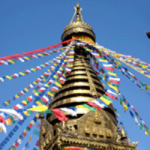
Three Passes Trekking
Our trip with Prakash over Cho La and Renjo La was beautiful! We were delighted with the service and support that Prakash delivered. He has a bright future and is suited to his role as guide. Even though we only needed his services as a porter, we would recommend him to anyone as a guide due to his professional attitude and excellent English.
I will be pleased to provide a testimonial shortly and look forward to using your services again in the future.
Until then, may you have good health and good fortune
Kind regards, Jude Trevillien
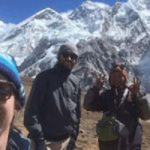
Dean & Laynni
Three pass trek.
Hi, Himal. Just wanted to let you know that we had a fantastic trek up to EBC. We had fantastic weather all the way up. The clouds started only on our way down from Kala Pattar and stayed most of the way down, but the mornings were still lovely.
We wanted to thank you for your help in organizing our porter/guide and porter. They were great guys and worked very hard to make sure our trip went well. Prakash was always very eager to help us in any way possible. He was still watching the other guides and improving his guiding skills as the trip went on and his English was better than we expected for a porter/guide.
We were also surprised by how much English Milan knew, and he often helped us communicate. Thanks again, hope the rest of the season goes well Dean & Laynni
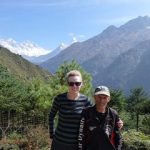
Lex and Kerry
Three pass trekking.
We used the Nepal Wilderness Trekking company for a 19 day “3 Pass Trek” in the Everest region, in October 2012. Himal Ghale, the owner, was highly knowledgeable about the Everest Region having worked there as a Guide in the past.
Himal organized a tailor-made itinerary for us, based on our interests, abilities and time commitments.
That is included the “3 Passes” route, Everest Base Camp and Kala Pattar, and the addition of a summit of Island Peak. Himal was very responsive in answering our initial questions (remotely), meet with us in Kathmandu, and dealt with some challenges that arose from unforeseen weather conditions.
We were also delighted with our assigned Porter/Guide – named “BB.” BB provided first class support to us throughout the trek and lived up to his reputation as a reliable and highly experienced Porter/Guide. Amazingly, BB had competed over the past eight years in the Tensing/ Hillary Everest Marathon!! He knew the region exceptionally well, including the many route variations and options we could take for different terrain/altitude, and chose excellent guest houses for us to stay at BB was well known, respected and welcomed by guest house proprietors along the way. He was also a very kind and caring gentleman – we will always remember BB with great fondness, respect, and gratitude for a wonderful trekking experience.
We wish Himal well over the future years and would recommend the Nepal Wilderness Trekking company to other trekkers for the Everest region.
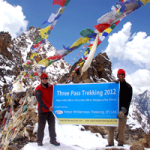
3 pass trekking reviews
Just finished the 3 Passes Trek (Renjo, Cho La and Kongma La pass), EBC and Kala Patthar, and finally, Island Peak summit with Nepal Wilderness Trekking Had a great trip. Himal and our guide Purna worked everything out perfectly. This team comes highly recommended from me.
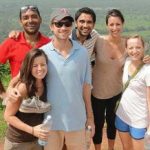
Fred and Evan
3 pass trekking.
We enjoyed our three pass trek. Challenging but rewarding. Magnificent views, Purna + Bir did a very good Job-they were very flexible when we wanted to alter our plans, and we always helpful + supporting their attitude + personality helped us a lot on some of the long climbs, and through the cold +wind. It was a very memorable trip – thanks to Himal + everyone else who helped us along the way!
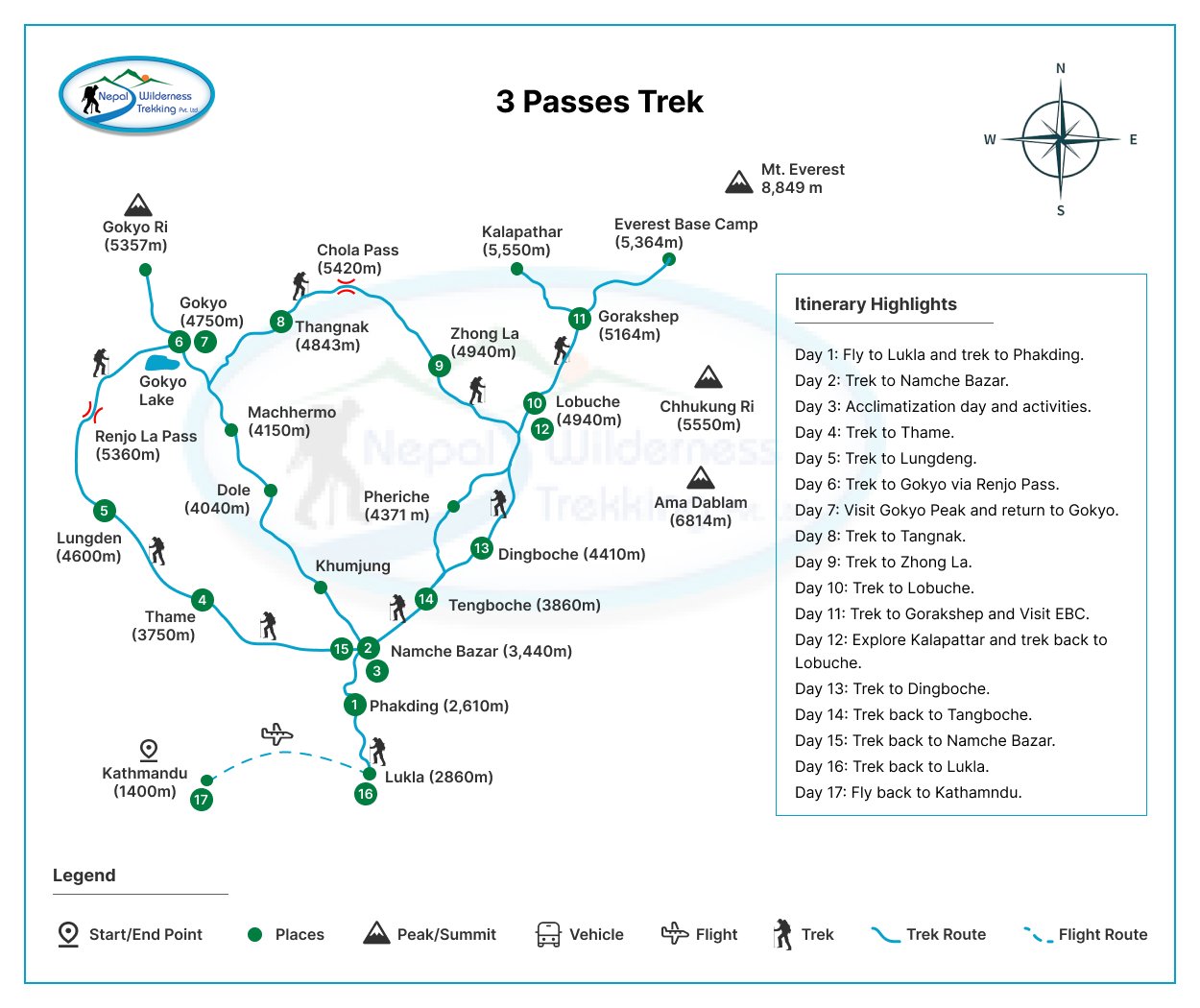
Frequently Asked Questions
How difficult is everest high passes trek, what is the maximum height of this trek, is it possible to do private trek, when is the best time to do the trek, what is the temperature in october and april, what is the accommodation type, are there atms available along the trail, how to prevent altitude sickness during the trek, why are acclimatization hikes necessary, what kind of clothes, gear and equipment do i need for the 3 passes trek, is drinking water available during the trek is it safe, what is acute mountain sickness (ams) and how likely am i to experience it, altitude chart, similar packages, nangpa la pass trek, short trek to everest, luxury everest base camp trek with helicopter return, 13-day everest base camp trek, chola pass trek, numbur cheese circuit trek, we are recommended on.
Nepal Wilderness Trekking Pvt. Ltd.
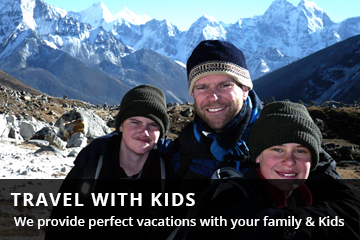
Nepal Traveller's Information
- Nepal Information
- Nepal Visa Information
- Entry Procedure to nepal
- Altitude Mountain Sickness
Halfway Anywhere
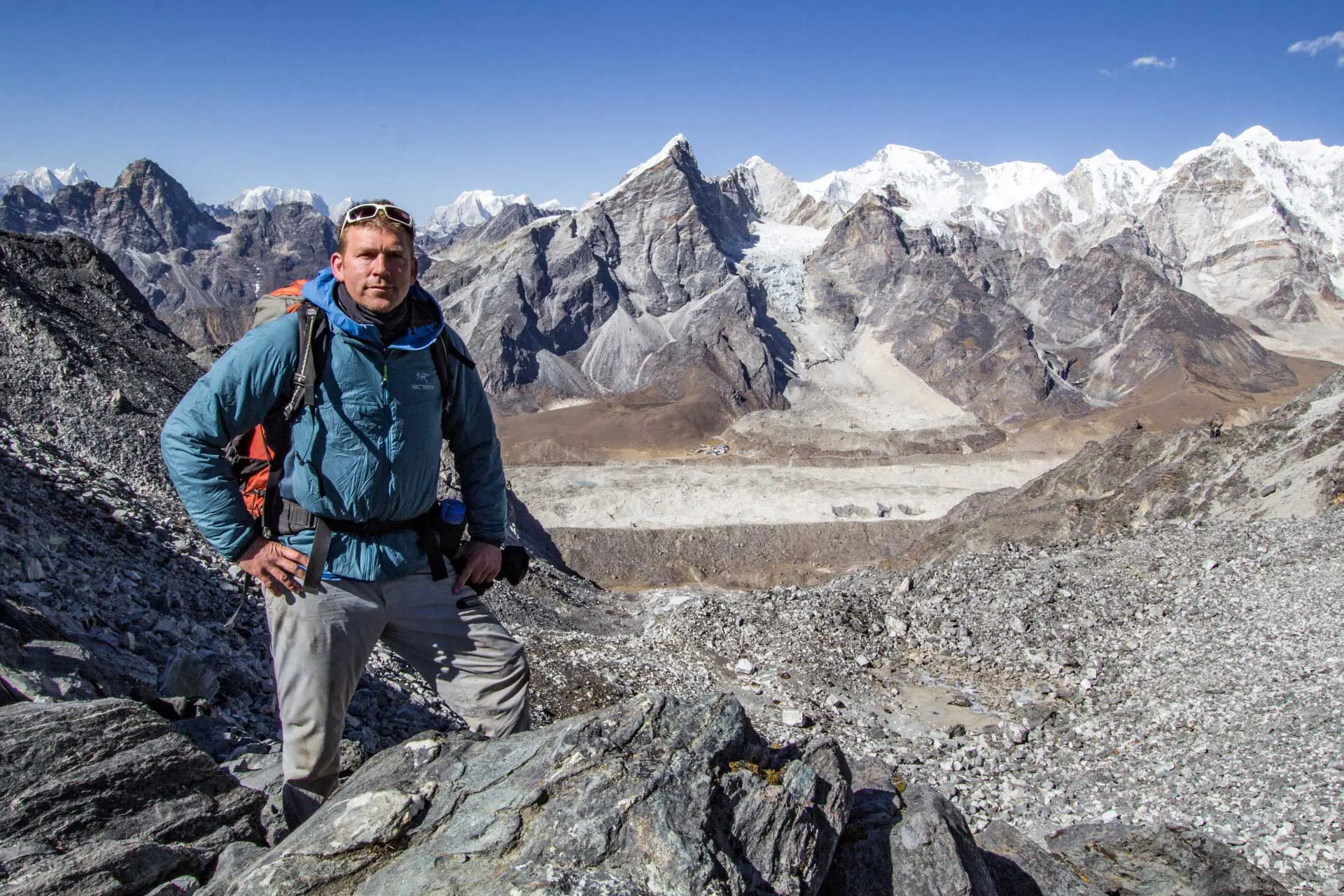
Guide to Nepal’s Three Passes Trek
The Three Passes Trek in Nepal is in the Everest Region (Sagarmatha National Park) and takes trekkers across three high passes, Kongma La (18,209 ft / 5,550 m), Cho La (17,782 ft / 5,420 m), and Renjo La (17,560 ft / 5,360 m) – hence, the Three Passes Trek. It’s a lollipop loop that can be done starting at Lukla (that scary mountain airport that you fly into) or further down the mountains at Jiri, Shivalaya, Salleri, or Phaplu (I recommend starting at Jiri if you have the time – it will also save you on having to buy plane tickets to/from Lukla).
If you’re only going to Nepal once in your life – as you should – and you’re intent on hiking (not doing a meditation retreat or growing dreads and hanging out in Pokhara), then you need to do the Three Passes Trek. And ideally, you need to hike in from Jiri. Fuck Everest Base Camp, fuck the Annapurna Circuit, fuck the Manaslu Circuit , and fuck Poon Hill. Three Passes Trek from Jiri. This is what you need to do. And if Everest Base Camp is really important to you, it can easily be done as a detour from the Three Passes Trek (normally this will add one day – if you’re slow, maybe two; if you’re fast, maybe none).
Are you required to have a guide for the Three Passes Trek? No. Do you need a guide for the Three Passes Trek? Not really (do not buy into all the fear-mongering in Kathmandu – these are just people trying to get you to hand over your rupees). Is hiking the Three Passes Trek expensive? No. Do you need to bring a tent, sleeping pad, or winter sleeping bag? No. Is it expensive to fly to Nepal? Usually, yes, but once you arrive, everything is cheap!
Three Passes Trek Facts
- (Unofficial) Capital: Namche Bazaar
- Language: Nepali
- Currency: Nepalese Rupee, NPR
- Time Zone: NPT (UTC+05:45)
- Calling Code: +977
- Drinking Age: 18
- Drinking In Public: Yes
- Drinking Tap Water: No
- Flushing Toilet Paper: No
- Vaccinations Required: CDC
- Credit Cards: Carry cash
- Tipping: Not expected
- Emergency Number: 100
- Outlets: Type C / D / M (230 V / 50 Hz)
- Visa Requirements: External Link!
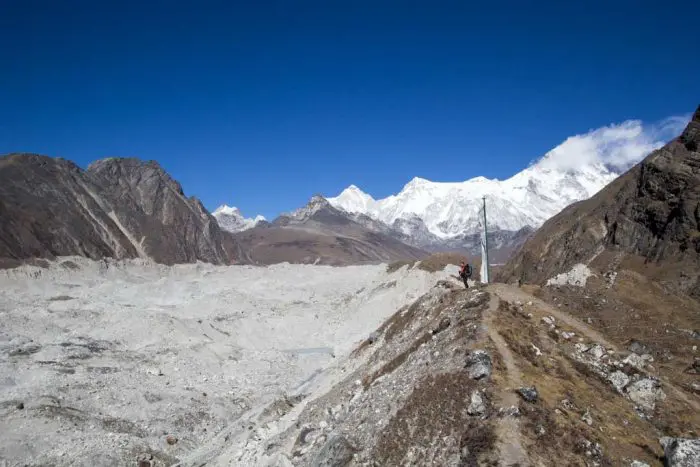
Three Passes Trek Basics
On the Three Passes Trek, almost everyone you meet will have some English language abilities (talk to the kids – they’re very interested in you), so don’t fret if your Nepalese or Hindi is rusty. The two words that you’ll need are namaste (hello) and dhanyabad (thank you). The Sherpa language, called Sherpa, is also spoken by some people. Sherpa is unwritten, which accounts for the various spellings of many of the villages (e.g. Dzonglha/Dzongla/Zonglha), so don’t worry if you’re confused by different spellings on your map versus the menu in your tea house versus your guidebook (which is probably too heavy to be carrying in the first place).
The route to the Three Passes Trek heads north into the mountains until Namche Bazaar. From here, hikers can choose to hike either clockwise or counterclockwise. Counterclockwise is the more common route and the one I recommend (particularly if it’s your first time at altitude). The Three Passes trek takes trekkers through four valleys in addition to the three passes, Kongma La (18,209 ft / 5,550 m), Cho La (17,782 ft / 5,420 m), and Renjo La (17,560 ft / 5,360 m). Kongma La is generally considered the most difficult (longest), Cho La requires you to cross a glacier (microspikes are helpful here), and Renjo La is commonly thought to be the easiest. Granted, this can all change depending on weather and conditions. For more on the Three Passes Trek route, check this post .
The tea houses (i.e. lodges) scattered throughout the villages along the Three Passes Trek are where you will (probably) stay each night (if you wanted to camp, you could, but it’s totally unnecessary and absolutely not required). During peak season, these can (apparently) get crowded. However, if you’re awesome and you go in the winter (more on this below), you shouldn’t have any trouble finding space in a lodge (as practically half of all the buildings in any given town are lodges). The tea houses usually cost between 100 and 400 rupees per night (~$1-$4) and have hot meals and beverages for purchase.
As much as you may imagine “trekking through the Himalayas” to be an exercise in solitude, this idea errs wildly on the side of “nope, sorry.” On the the Three Passes Trek, you will be constantly met with other trekkers, locals, pack animals, and, most exciting of all, villages. Depending on your route, you may pass through as many as five or six villages in a single day. They all (at least on the Three Passes Trek) have food, accommodation, and friendly mountain-dwellers to aid you on your way up into the mountains. If you go up alone and decide you need a guide, hiring someone from one of the villages to go with you on your trek will also be possible.
The most popular season for the Three Passes Trek is the same as Everest Base Camp, the fall (September to November). The second most popular season is spring (March to May), also the peak season for Everest climbers. The summer months are monsoon season in Nepal, so unless you are a huge fan of trekking through the rain with limited views, it’s probably best to avoid this time (unless you are willing to trade views for solitude – but maybe you’ll get lucky with the weather). Winter generally has limited crowds and great weather, but it is cold (I like the winter – more on this below).

Three Passes Trek Route
The Three Passes Trek trail is very well-defined. The scale of the mountains makes navigation much different than what you would find in a heavily forested area. Most of the time, you walk up, down, or across a valley and have few options for where to go. It’s not like you will suddenly make a wrong turn left and accidentally go over a 23,000 ft / 7,000 m. You can get a paper map in Kathmandu for the region, which should help you with the big junctions (if you somehow find yourself alone and with no locals to ask for directions). For more on the Three Passes Trek route, check this post .
As stated above, the passes are Kongma La (18,209 ft / 5,550 m), Cho La (17,782 ft / 5,420 m), and Renjo La (17,560 ft / 5,360 m). Again, Kongma La is generally considered the most difficult (longest), Cho La requires you to cross a glacier (microspikes are helpful here), and Renjo La is commonly thought to be the easiest. Granted, this can all change depending on weather and conditions. It’s wise to get an early start on the days you plan to cross each pass to give yourself adequate time and avoid the afternoon weather (typically worse than what you wake up to).
Everest Base Camp
This is completely doable if you want to detour to Everest Base Camp and/or Kala Patthar. The first village west of Kongma La (the second village east of Cho La), you can make it to Everest Base Camp and back in a day (via Gorak Shep). If you also want to hike Kala Patthar, you could either do one huge day back to Lobuche or stay the night in Gorak Shep and do Kala Patthar the afternoon before your stay or the morning after. For more on Everest Base Camp, check this page .
Hiking from Jiri
Taking a bus or jeep to Jiri (or Shivalaya, one village ahead) and then hiking to Lukla (instead of flying to Lukla) is a challenging and rewarding section of the region that is not as heavily trafficked as the trail above Lukla (where most trekkers start). If you’re short on time, instead of starting from Jiri, you can save yourself a day or two and take a bus or jeep to Salleri or Phaplu, which puts you about two days close to Lukla from Jiri.
Turning Around
Every time I have been up in the Everest Region, there has been much fear-mongering about the passes. “The passes are closed, there is too much snow” or “The passes are closed because ‘I don’t know why I just heard somebody say that.'” Listen, friend, if you’re in Nepal to hike the Three Passes, go and hike the Three Passes. Go and see for yourself. Start early in the morning, and if the trail, pass, or the weather turns out to be too much, turn around. In absolute terms, the passes really aren’t that far from the nearest villages. Don’t be afraid to go and check out the conditions for yourself, but don’t be afraid to turn around if things look above your experience level.
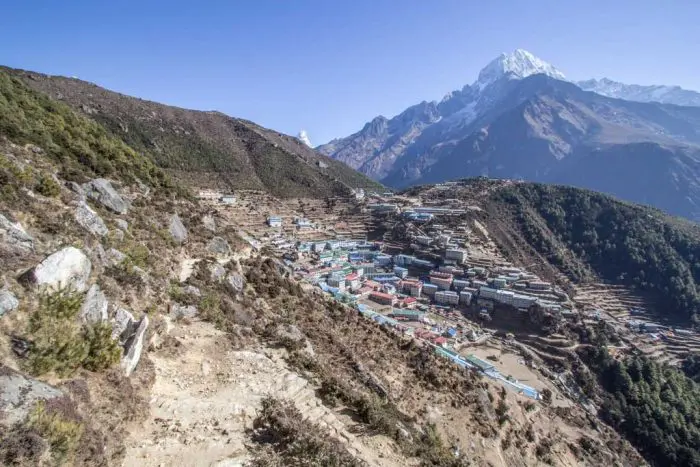
Three Passes Trek Food
Food on the way to Three Passes Trek is far more plentiful than you may imagine. Many lodges have many options, and you could easily eat something different every night (or be like me and stick to Dal Bhat, pizza, and momos). Check out this post for more on food on the Three Passes Trek.
Dal bhat is perhaps the most plentiful dish on the road to the Three Passes Trek and is certainly one that you should be eating to fuel your marathon mountain march. This traditional meal consists of rice, lentil soup (dal), and vegetables (and/or some meat if you’ve opted to eat animals on this trek). In addition to typically being one of the cheaper options on the menu, dal bhat also means refills. You get complimentary refills on your rice, lentil soup, and vegetables. It’s easy to see why this is what the guides and porters usually eat. Remember, “Dal Bhat power, twenty-four hours.”
There’s not a huge debate surrounding the quality of meat on the way up to Base Camp (that I’m aware of), but it’s something trekkers should consider. As much as I love eating roasted animals, I do not eat meat in the Himalayas. Do I have a scientific reason for this decision? No. It’s simply because I don’t know how many days in the sun each meaty meal spent on the back of a porter (and because the meat is generally more expensive). Also, since eating beef isn’t really a thing in Nepal, and since cows are my favorite animals (to eat), it’s not worth the risk.
As with meat, alcohol is something I avoid whilst hiking (upward) in the Himalayas. This is a personal decision, but drinking alcohol (especially in excess) can hinder your acclimatization efforts – and altitude sickness is not something to be taken lightly. A night of partying in Namche is not worth turning your Three Passes Trek adventure into an expensive (but probably awesome) helicopter ride back to Kathmandu.
So now that you’ve sworn off the bottle, it’s time to get serious about hydration. Water should be something you’re constantly ingesting on the Three Passes Trek. Chances are that your body will be in nonstop and desperate need of water to fend off the effects of altitude sickness, dehydration, and the possible fallout from your third helping of dal bhat last night. I bring a SteriPEN with me on my hikes in Nepal and purify water that I get from the tea house’s tap (you usually have to ask for this). Buying plastic water bottles contributes to the garbage problem in the mountains (and we all know plastic bottles are evil).
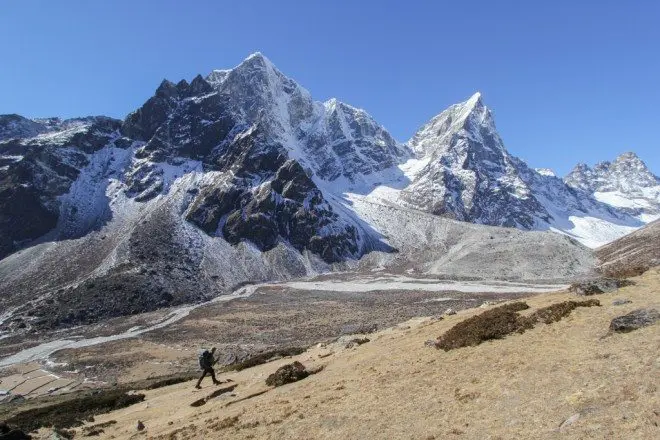
Three Passes Trek Tips & Tricks
Yes, “Winter in the Himalayas” may sound scary, but the truth is that it’s probably the best time to visit (this is based on my having been there twice in winter and once in spring). You may expect the Himalayas’ winter months to bring a ton of snow, but this is not the case. Most days, you can expect clear skies with very little precipitation. Just make sure to bring an extra base layer because it’s cold.
Yes, with the civilization in the Himalayas, you will also find wi-fi. Generally speaking, once you get above Namche Bazaar, getting free wi-fi will be difficult (if not impossible). Generally, you must buy cards from the lodges with passcodes to access the “EVEREST LINK” wi-fi network. These cards are sold in different denominations, the most expensive being 1,000 NPR (~$10 US) for 24 hours of use. These cards may not always be available, and lodges may not always sell them at face value. Also, many lodges turn off the electricity after a certain time (which means no more wi-fi), so be sure to ask beforehand. You will probably get a cell signal in many places if you have a SIM from Kathmandu (Ncell is what you want).
Lukla Flight
I highly recommend taking a bus to Jiri and beginning your hike from there, but if your time is limited, then a flight to Lukla may be your only option. The flight to Lukla is commonly referred to being “the most dangerous flight in the world”. This is largely because of its being placed on under-researched lists of random internet blogs (there have been three fatal accidents involving airplanes at the airport – the most recent of which was in 2010). Yes, the flight to Lukla is an adventure, but it’s certainly not a death sentence. The flight will cost around $150 each way – more on the flight here.
Yes, there are ATMs in the Everest Region. As of writing this, there’s one in Lukla and two in Namche Bazaar. None are guaranteed to work, so I would bring cash from Kathmandu to avoid headaches. Ninety-five percent of places do not accept cards. If the ATMs aren’t working, places in Lukla and Namche offer cash advances with a credit card. Some places in Namche Bazaar accept cards, but few places above Namche will take anything besides cash. Ensure you have enough money for the way up (and back down).
For more on the Three Passes Trek, visit my Three Passes Trek page .
Similar Posts

Three Passes Trek Day 13: Thame to Lukla
Today may very well be the final day of my Three Passes Trek. Before setting out on this adventure, the sometimes not-so-trusty internet indicated that…

Off To Nepal (And Certain Death)
I have already presented “The Ultimate Everest Base Camp Plan” and my exhaustive “Everest Base Camp Gear List”, so now if (when) something goes wrong…
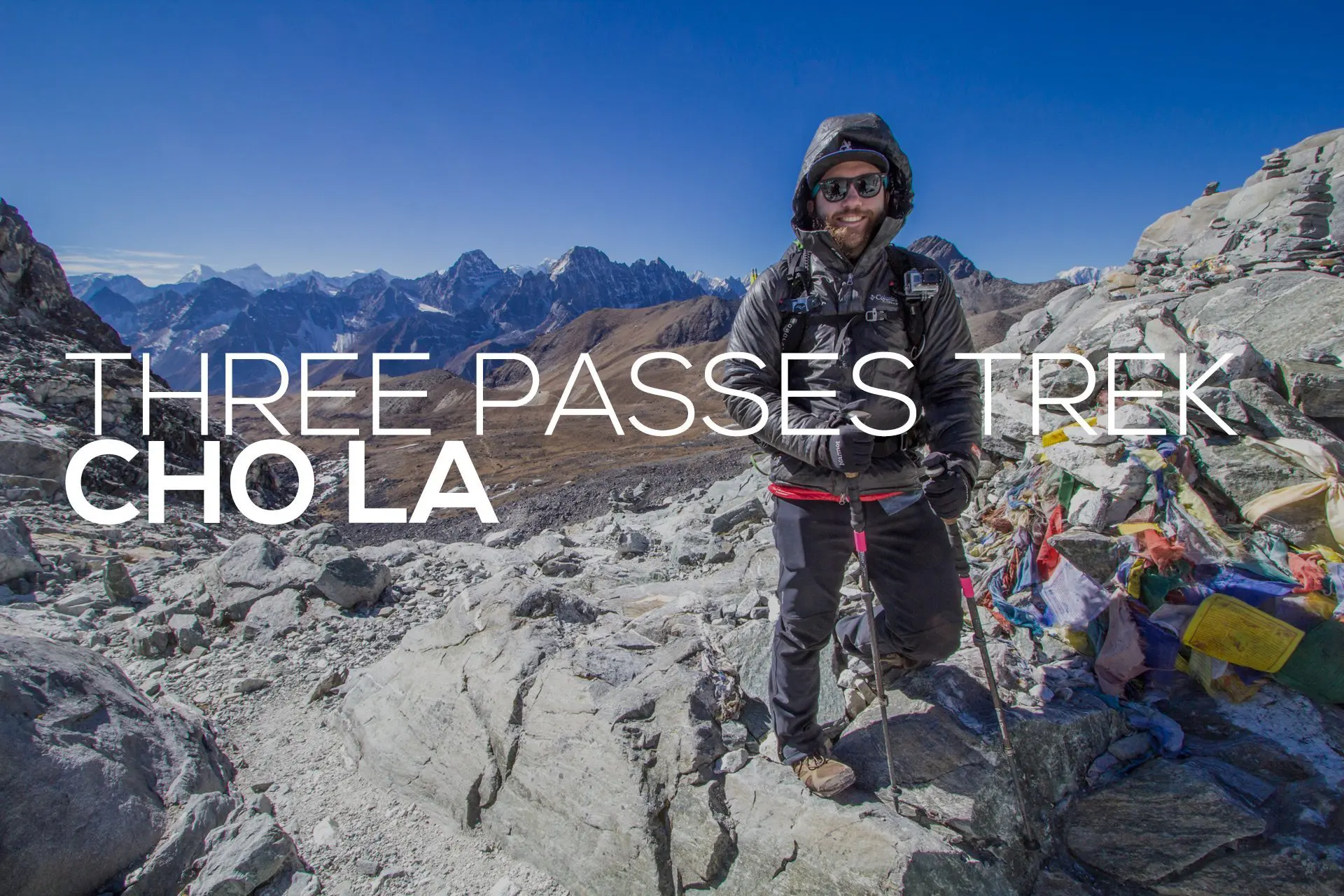
Nepal’s Three Passes Trek: Cho La
Cho La is the second pass of Nepal’s Three Passes Trek (regardless of which direction you are heading) and is probably the most frequently crossed…
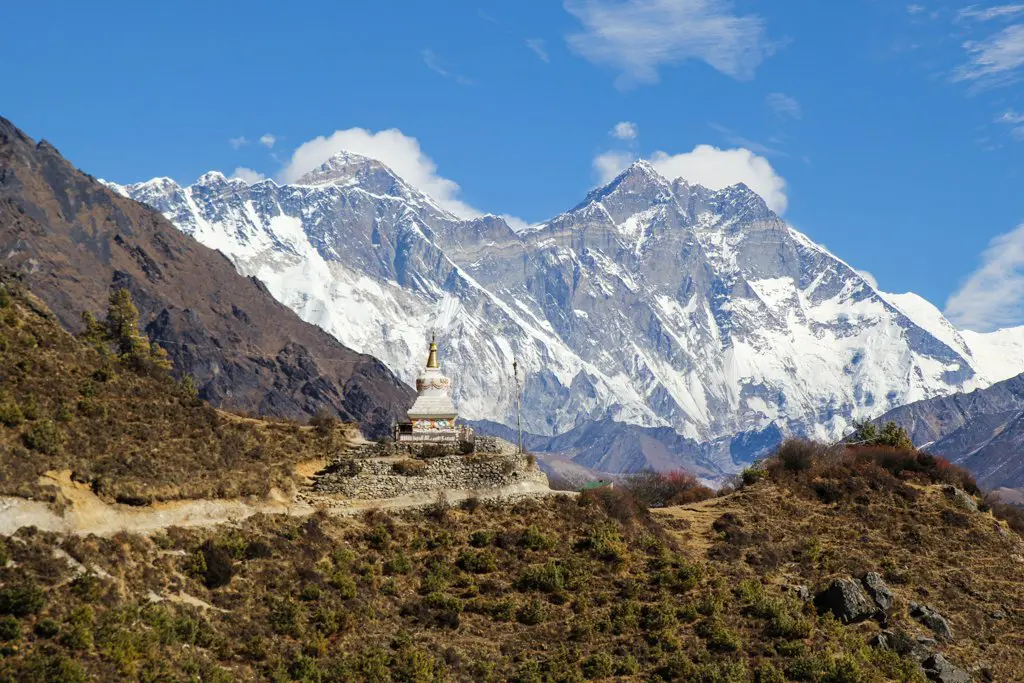
Everest Base Camp Day 11: Tengboche to Namche Bazaar
Starting elevation: 12,687 ft / 3,867 m Ending elevation: 11,290 ft / 3,440 m Elevation change: -1,397 ft / -427 m Starting oxygen: 64% of…
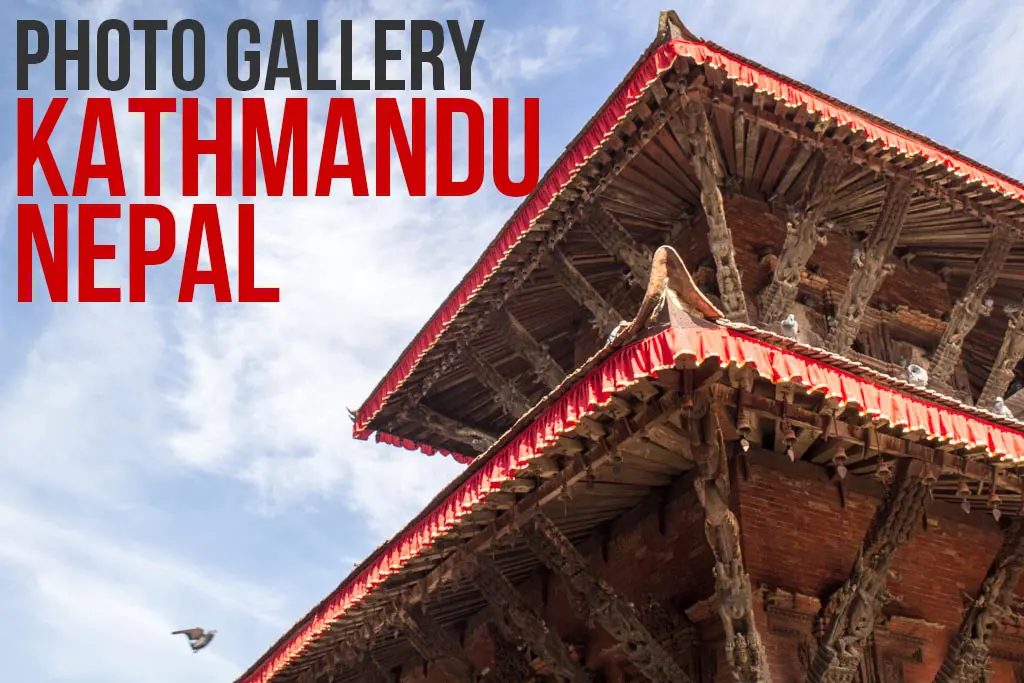
Photo Gallery: Kathmandu, Nepal
Most people find themselves in Nepal with the goal of trekking in the legendary Himalaya, but there’s a lot to see at the lower elevations…
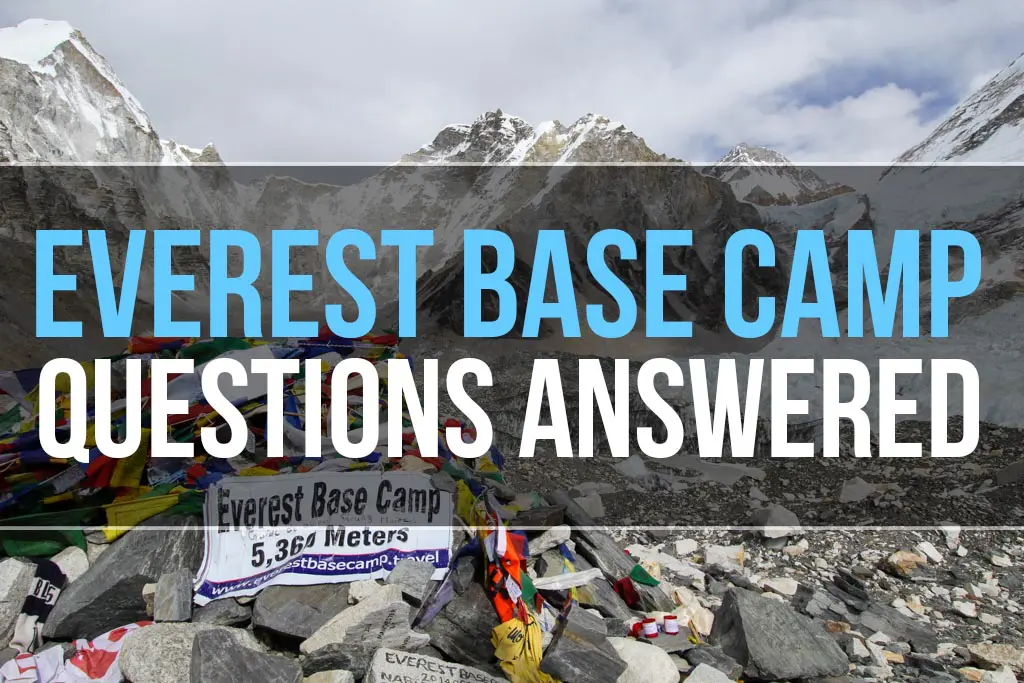
Everest Base Camp Trek Questions Answered!
Before heading off to Everest Base Camp, I wrote this post inspired by all the questions I had but was having difficulties finding answers to….
42 Comments
What a fantastic article on the Everest Three Passes trekking in the Everest region! It provides extensive information about the breathtaking natural landscapes, towering mountains, and vibrant Sherpa cultures.
Glad you enjoyed it!
Thank you very much for the great post
Thank you for reading!
Thanks for sharing such an amazing post, The Everest Region is the hub for adventure, and adventure people complete their passion for adventure in this province. Your blog helps people plan their trip at the right time and the pictures are awesome.
This is very informative. Thank you for taking time in sharing your experience. I have just decided to do it in March 2024 as a solo backpacker, without a guide or porter. In case anyone here is going in the same month I’m more than happy to buddy up instagram handle: ikaterox
Thanks for the great blog. I will be retuning to Everest region in March 20224 and am trying to figure out of I can take on the 3 passes as a solo trekker (no guide, no porter) as a reasonably fit 56 yo woman. The other option is to repeat the amazing trek I did when I was 29 yo from Jiri to Gokyo Ri. Ideally Id like to do something differeint thoigh and dealing witht he throngs of trekkers heading to EBC is not really my thing. I’m wondering aboit path finding – how clearly marked are the passes? Im aware that I can most likely buddy up on the passes or even hire a guide for them but would love your thoughts. THANK YOU!
The trails over the passes aren’t well-marked (although they’ve added more markers since I first did this hike as I saw when I went up Kongma La once more a few years later). The passes themselves are fairly well marked as they’ve been covered in prayer flags.
Thank you Mac! Thinking for me either take a guide or choose an easier better marked trail.
Hi! What an amazing and encouraging trip report! I have done a similar trek in Peru called the Ausangate circuit that went over 4 high altitude passes, but it only took me about 6 days. I have a question about meat eating, however. Did you find plain meats available in the villages at all? I eat a keto low carb diet due to autoimmune issues. I’m fat adapted, so I fuel off of animal fats + meats. I’m planning on bringing pemiccan bars and jerky. I’ve heard I might be able to find yak butter available. Do you know if I can find any dried meats to carry, even in Katmandu?
I avoided meat in the mountains although it was generally available. I am not sure about the availability of dehydrated meals in Kathmandu as I didn’t eat any of these myself. Honestly, if you have a restricted diet I would suggest bringing as much as you’re comfortable with from home.
Thanks so much. Ya, it’s pretty complicated for me because I can’t handle any nuts, grains and seeds in my diet. I’m really hoping I can find dried meats at the very least in Katmandu. I’m a full time nomad so carrying foods from “home” won’t really be possible for a longer trek in Nepal. Anyway, thanks again for this amazing report!
@crystal , Hi im a sherpa living and studying in new york to be a nurse. In our culture we have a dehydrated meat called “sukuti” . In the past sherpas didn’t have a way to keep meat edible and not rot. We didn’t have fridges back then and still we don’t really have them. Sukuti is a goat/lamb dried meat , thats really chewy and tasty in my opinion. you can do a google search on it. Most tea houses and homes in this area will have sukuti , but its usually reserved for their family . Not really sold . BUT I am sure if you ask kindly , they might sell it to you and I think some places sell it to tourists anyway.
Wonderful information! I’m here now getting ready for my first trek. I’ll look for some sukuti in Katmandu!
Hi there, my brothers and I will do the Three passes, starting late March this year. Do we need crampons during this trek because we have to cross a glacier? If so, how big is the distance we have to cover through this glacier? I’m in doubt if my hiking boots (Hanwag tatra II) are suitable in case we need crampons.
Thanks in advance!
I used microspikes to cross the glacier on the east side of Cho La. If in doubt, it’s best to bring some traction with you – worst case you don’t use it.
Thanks for the advise.
I’m going to hike the three passes loop starting from Jiri. I’m traveling solo and would love to meet others to hike with. I’m planning on starting early March 2023. Anyone interested in joining me? I’m female and would prefer to travel with women or a combo.
Hi — I am considering this trip and leaving in the next few days. Have you already arrived / have a group together?
I am leaving for Nepal on 3/20 so will start hiking from Jiri probably on 3/24. No group, going to start solo and hopefully meet up with friendly trekkers. What is your plan???
A complete guide for Everest 3 High Pass Trek. Thanks for sharing your experiences here. Keep on sharing and inspire other people to trek in the Himalayas.
It’s a beautiful place to trek!
Hi there, I am looking at tackling the Three passes trek solo this upcoming late Feb, early march. I have scoured the web and haven’t been able to find any beta on potential snow conditions. Any idea what I may encounter? I am okay with some post holing but I am just curious about avalanche hazards and snowbound conditions. Any insight would be greatly appreciated thanks 🙂
I’ve been up there in March and there was little snow. The mountains get most of their precipitation in the summer months while winter is typically the dryest When I was there I went up Kongma La and there was a bit of snow (it had snowed three days before I hiked), but it was completely manageable.
Thanks for your speedy reply! I really appreciate it. That is good to hear. Any other high pass trekking you would recommend as well?
Hey Mac, Thanks for all the information and great website. There is one thing that is not clear to me about this route. Do I take a satellite/gps device or not? Does gps navigation on phone (with downloaded offline maps in Komoot) will suffice? I have always navigated this way but since the Himalaya are new to me… Is it necessary to have satellite reception on the pass in case of emergency? Hope to hear from you! Best Funs
GPS navigation on a phone will function so long as you’re familiar with it; phone apps will work the same in the Himalayas as they do elsewhere so long as you have the maps downloaded for offline use. When you ask “satellite reception on the pass in case of emergency” are you talking about calling for help? If you need to call for help with a phone you will need (and not have) reception. It’s best to bring a PLB for times like this.
Nowadays we can see many people blogging without information but this article is really informative which is important for travelers.
That’s the goal!
I’m doing the three high passes in October this year! You definitely have the most detailed blog I’ve found. I’m just curious what you do with your toilet paper if you can’t flush it? Do you carry a garbage bag full of toilet paper around? Thank you!
Throw it away or pack it out (bring extra Ziplocs).
I still remember when we met at Tengboche while you were doing this trek. We had some beautiful conservation went on and you were so adventurous. I follow you on Facebook as well love to see your post on there too. And Keep posting such a piece of great information to everyone who wishes the adventure in Nepal.
I remember when we met, too – I can’t wait to make it back to Nepal!
As a trekking guide, i have done this Everest three-pass trek couple of times every time i go there i feel more energetic and fantastic. Reading this article now while staying in the home because of the coronavirus and no trekkers in Nepal for the trek recall all my walking experience in those places.
It’s an awesome post, and really useful to get the information of an Everest Three Passes Trek. Thank you so much for publishing such a nice article.
Thanks for the feedback!
Amazing Trip.
Highly recommended!
It is a great guide Mac. We have a similar 3-passes trek in Indian Himalayas.
I have yet to get there – what’s it called?
Auden’s Col – Mayali Pass – Patangini Dhar trek
I would love to know too. Waiting for reply. Thanks!
Leave a Reply Cancel reply
Your email address will not be published. Required fields are marked *
Create an account
Start your adventure today.
Already a member? Login

Three Passes Trek – The Full Guide and Detailed Itinerary
Quick navigation, three passes trek details, three passes trek: detailed itinerary, three passes trek map.
- Best Time to Do the Three Passes Trek
Accommodation on the Three Passes Trek
Three passes trek costs, three passes trek tour, adventure travel insurance, recommended packing list for the three passes trek, final thoughts, trekking in nepal articles, join our newsletter.
Get a weekly dose of discounts and inspiration for adventure lovers
The Everest region is one of Nepal’s top trekking destinations, with the Three Passes Trek being the ultimate challenging destination. You cross three passes over 5,000 m , each offering panoramic views of some of the world’s highest mountains. This adventure in the Himalayas gives you a unique experience in terms of the vistas and culture of the Sherpa people.

- Difficulty: Challenging
- Highest Elevation: Khongma La Pass at 5,535 m
- Total elevation gain: 8,100 m
- Total elevation loss: 8,079 m
- Time: 14–15 days
- Closest Major City: Lukla
- Permits: TIMS Card, Sagarmatha National Park Permit
- Accommodation: Mostly teahouses
- When to Do: Spring (March to May) and Autumn (September to November)

Imagine spending two weeks deep in the remote Himalayas, pushing past the limits of your comfort zone, and trekking among the world’s most epic peaks. The Three Passes Trek will challenge you as you hike through peaks and valleys, staying at teahouses along the way for a quick rest between long hiking days. Embark on the journey of a lifetime on the most exhilarating trails crossing glaciers and reaching breathtaking heights.

Day 1: Flight to Lukla; Trek to Phakding
After landing in what is considered to be one of the world’s most dangerous airports, Lukla ( 2,860 m ), you find your way through the crammed market in the small town. This is a relatively easy first-day hike covering 6.7 km from Lukla to Phakding ( 2,640 m ). Interestingly, the elevation loss is more than the elevation gain. You’ll be losing about 496 m and gaining around 287 m along the way. The hike should take around 3–4 hours, depending on the level of fitness.
Pass the notable Pasang Lhamu Memorial Gate after showing all the required permits at the counter just before the gate. Follow the path and head towards the Dudh Koshi valley leading to a small settlement known as Chheplung. Many teahouses and small shops are present in Chheplung, where the locals give you a warm smile signaling you to come to their shop. The trail has a copious amount of small stupas and mani stone, a black boulder engraved with Buddhist mantras. It is considered religious to the Buddhists, and you’re supposed to walk on the left side of it.
After leaving Chheplung, follow the riverside trail passing over a suspension bridge. Descending for about 500 m from Chheplung takes you to Thado Koshi, your lunch stop for the day. Enjoy your meal with spectacular views of the surrounding mountains. After crossing several metal suspension bridges over the Dudh Koshi river, you get to Ghat, a village with the Yunging Gompa. Walk past the large gumba and wash your sins away by turning the prayer wheels. A large stunning mani wall is also present as you leave the gumba behind.
Walking for another 30-35 minutes uphill takes you to Phakding. Phakding is a large village with teahouses and lodges on either side of the river. You’ll be surprised to find that this village has everything you fancy. Wi-Fi cafes, luxurious coffee shops, pool houses, and trekking equipment, you name it, they have it all. Continue for another 5-10 minutes and get to the other side of the river, crossing a suspension bridge to avoid the overcrowded lodges in the main bazaar. Just after you finish crossing the bridge, you’ll see a signboard that says to go left for Mountain Lodge. Stay at Mountain Lodge in Phakding for the night. The place is secluded, and still, you can take in all the beauty of the village. The rooms are very comfortable, and you also get a hot shower for an extra charge. They also have arrangements for camping if you’re up for it. Camping is more fun as you get to sleep next to the soothing sound of the flowing river.
Day 2: Trek to Namche Bazaar
Wake up to the sight of the emerging sun gradually warming up Phakding. Kick-off your day with a hearty breakfast as you have to cover about 11.2 km hiking from Phakding to Namche Bazaar ( 3,431 m ). The elevation gain today is about 1,467 m , whereas the elevation loss is at 651 m . The trails are diverse today as you walk up and down following the same Dudh Koshi valley. The uphill climb to Namche is particularly strenuous as the whole climb entails having to walk on stone steps for its entirety.
Come down from the Mountain Lodge and take a left to be in the main EBC trekking route. The sound the river makes when it hits the huge rocks and boulders is quite fascinating to hear. Although the path is easy and flat when you start, it is constantly populated by incoming mules carrying loads of luggage and goods. You encounter a huge waterfall on the way, where you can have a moment and take a picture. The trail goes flat until you reach a small village Benkar. Have a cup of tea in one of the teahouses in the village and rest your muscles to endure the upcoming uphill climb. Cross the first suspension bridge just as you leave Benkar with caution as yaks might be coming from the opposite direction, and you have to return to let them pass first. Continue north through the valley in a rocky trail to Monju. Climb the stone steps, and you’ll be in Monju in no time. There is an army checkpoint at Monju. Don’t worry—they record your details to ensure that you have all the permits so that there is no problem higher up. The official Sagarmatha National Park (SNP) area starts here, and you have to buy the TIMS card and SNP permit here to enter the national park area.
From here, the trail descends to a mani stone between two hills and a beautiful view to savor. Walk down the trail until you reach the lunch stop for the day at Jorsalle ( 2,740 m ). Stop at a lodge, order dal bhat and enjoy it with the open view of the Dudh Koshi valley. The uphill walk to Namche just after leaving Jorsalle. Climb up a series of stairs and descend the path just by the riverside. After walking for a few minutes, you see the steep uphill trail that leads to Namche. As you follow the trail, it takes you up the iconic suspension bridge where you see many trekkers stopping to take a photo. There is another suspension bridge underlying the one you’ll be walking, which is the old bridge. After crossing the bridge, it’s two hours straight uphill until Namche Bazaar. There are a lot of alternative shortcuts on this trail, but taking one is not recommended as you might get lost. So, sticking to the main trail is mandatory. Eventually, you come across a viewpoint, from where you can see the Dudh Koshi river with a sequence of hills in the vista—a fantastic sight. This portion before you reach Namche Bazaar is famously known as “Toph Danda.” Since it’s a challenging route, there is a resting place where you witness a lot of backpackers taking a break to catch their breath. From the resting place, it is about an hour’s walk to Namche.
You will easily recognize the famous Namche Bazaar ( 3,440 m ) with a lot of houses built consecutively on the hills. As you enter Namche, you will see a small gumba and an artificial waterfall made by the locals. Stay at Kalapatthar Lodge near the Irish Pub at Namche. Hydrate yourself well and eat some noodle soup as you’re at a relatively high altitude now. Tomorrow is the acclimatizing day where you go for a hike to nearby viewpoints.

Day 3: Acclimatization day in Namche
Rise and shine! Today is the first acclimatization day of your trek. There are a lot of acclimatization hikes around Namche as most trekkers spend a day or two here. The most famous hike is the Tenzing Hillary Viewpoint, also known as Chor Camp. You can see a panorama of mountains from the vantage point while enjoying a cup of tea. Additionally, you can hike up to Khumjung via Syangboche Airport past the Yak farm. Many hikers decide to see the views from the Viewpoint and then go to Kyangjuma ( 3,700 m ), which is on the way to Tengboche.
Ascend the steep stairs from Namche until you reach the army camp. There is a small narrow trail leading up to the Tenzing Hillary Viewpoint. The trail is undemanding, and it takes about one hour to reach the vantage point from where you see phenomenal views of some majestic mountains like Everest, Khangteka, Thamserku, Kusum Khangkaru, Khumbila, Lhoste, Nuptse, Kongde, Tobuche, Cholatse, and Ama Dablam. Take a snap with the huge statue of Tenzing Norgay with the surrounding peaks in the background. You may choose to return to Namche for lunch or head towards Khumjung, which is a further 2–3 hours hike from here. If you decide to go to Khumjung, head northwest towards the famous but unused Syangboche Airport. You will find a fork on the trail on one of the ends of the airport. The left trail will take you to Khunde, and the right one will take you to Khumjung. Khunde is a village above Namche with a small monastery and a hospital known as Hillary Hospital. The hospital was built by Sir Edmund Hillary in 1966 and serves the locals in the surrounding communities. You can go to Khunde first and then head east on a flat trail to get to Khumjung. The teahouses at Khumjung serve good food.
After having lunch at Khumjung, descend to Namche. On the way back, you can visit the Sherpa Museum close to the army camp. The Sherpa Museum is a great place to learn about the Sherpa culture and mountaineering history in the region. You can also observe a collection of equipment related to the first Everest summit. Stay overnight at Namche.
Day 4: Trek to Thame
After a day of acclimatizing hikes and a good rest at Namche, you are ready to set out west to Thame ( 3,813 m ), a beautiful valley with comparatively less populated trails. The hike today is a pleasant one full of majestic views of the mountains and picturesque villages along the way. You’ll walk approx. 8.0 km from Namche, where the elevation gain is 719 m , and the elevation loss is 373 m .
Head up past the monastery at Namche and some splendid mani stones to get to a rocky cliff above the Dudh Koshi valley. Here, you see the vista of Namche Bazaar with mountains like Thamserku and Ama Dablam on the horizon. As you continue the trail, you traverse through a dusty, rocky trail and descend towards the village Phurte ( 3,390 m ). You come across a lot of chhortens and mani walls in between. After passing Phurte, you will ascend until you reach a promontory where you see the village Thamo ( 3,480 m ) with a beautiful monastery. From here, the valley goes up and down, and in no time, you reach Thamo for a lunch break.
After your meal, brace yourself for the steep stairs to the monastery; however, the trail after crossing the monastery is quite flat. Continue on the trail for an hour or so until you reach another village, Samde ( 3,610 m ). Samde is a small village with only a few houses and fields around. The path continues to rise gradually, and you can see clear views of the open valley of Thame Koshi, which is the way to the famous pass Tashi Lapcha. Continuing on the trail, you come across huge, beautiful Buddhist paintings on the boulders. You cross a small bridge over the river and ascend to find yourself on a field divided into separate pieces by the walls. That is when you reach Thame. Thame has two parts; Lower Thame and Thame Teng. The first village you come across is the Lower Thame, whereas to get to Thame Teng, you must climb up a small ridge from Lower Thame and descend to the large settlement. Stay at Summiteers Lodge in Thame Teng and enjoy the views of the surrounding mountains.

Day 5: Trek to Lungden
Wake up to a beautiful landscape surrounded by huge mountains and lush green fields illuminated by the rising sun. The trail to Lungden ( 4,360 m ) is both uphill and downhill, but the walk is quite effortless. Lungden is about 8.7 km north of Thame, where the elevation gain is 648 m , and the loss is 112 m . The trail is less populated with tourists, so this is a great option for those who like serenity on the trails.
Just after leaving Thame, the trail, besides the river, gradually rises as you walk through a dusty and rocky terrain. The tree line slowly diminishes and all that is left is empty barren lands. The next village you reach is Taranga ( 4,020 m ), which has only local houses but no accommodation for travellers. The views of the mountains start to disappear and all the majestic vistas are hidden behind small black ridges. As you leave Taranga, you cross a small bridge and enter Marlung ( 4,150 m ), the last major village before you get to Lungden. Have a snack or go for a hearty lunch here as Lungden is only about an hour from here. After you finish your meal and make your way to Lungden, you ascend the straight path on a rocky trail. Lungden is a small village with a few lodges. Stay at Kongde View Lodge, the first teahouse you see just as you enter Lungden. Take a good rest tonight—tomorrow, you cross your first pass of the trek.
Day 6: Trek to Gokyo via Renjo La Pass
Start early today as this is the day you cross your first pass of the trek, Renjo La. The trail is straightforward as you leave Lungden. The views are not that extraordinary, but once you get moving, the scenery starts to open as you see the valley you walked yesterday. It is all uphill today, and the high altitude makes it more grueling. Today’s total distance is about 10.5 km , and the elevation gain is 1,027 m , whereas the elevation loss is about 636 m . Take occasional breaks and put your bags down to build up your endurance. Also, remember to take a packed lunch from Lungden as there are no lodges or teahouses in between.
You encounter a lot of small yet beautiful lakes on the way. Tall rocky mountains are omnipresent for the whole walk today until you reach the top of the pass. There is a slight chance that you’ll see indigenous animals and birds like the Danphe and Musk Deer if you’re lucky. Keep a consistent pace, and don’t push yourself in the high altitude as you will be above 5,000 m . Just before the last push to the pass, you see a gorgeous body of water that resembles Gokyo Lake. The final ascent is a rocky uphill path with no signs of an easy walk. After climbing for almost an hour and a half, you see a boulder decorated with prayer flags, which is the Renjo La ( 5,435 m ). You see one of the best views of Mt. Everest from the top of the pass along with Gokyo village, Gokyo Lakes, and other mountains like Cho Oyu as well.
The descent from the pass towards Gokyo ( 4,998 m ) is as back-breaking as the ascent. The trail is a steep downhill filled with small unstable rocks, and if you’re not an experienced runner, then brace your knees well. Gokyo village isn’t as near as it seems even though you see the settlement as soon as you start to walk down from the pass. After you finish the descent, you meet a flat trail just beside the largest Gokyo lake (there are 5 lakes in Gokyo). Continue strolling until you reach the teahouse area. Stay at Gokyo Resort for good accommodation, food, and a nice view of the lake. Since you’ve gained considerable altitude, it is necessary to acclimatize and stay in Gokyo tomorrow.

Day 7: Acclimatization day in Gokyo
This is your second acclimatization day of the trek. There are a couple of options to spend your time wisely in Gokyo while acclimatizing. You can either choose to climb Gokyo Ri ( 5,375 m ) early in the morning or hike up to the fourth and fifth lake of Gokyo valley named Thonak Tsho and Ngozumpa Tsho, respectively. The views from Gokyo Ri are similar to that from Renjo La Pass with the only exception of Cholatse Himal, but it does give a sense of accomplishment being at the top of Gokyo Ri. It is up to you to choose what you want to do.
If you decide to go up to Gokyo Ri, you must wake up really early in the morning and reach the top before sunrise. Head to the northwest of Gokyo and cross a small stream and take the uphill trail leading to Gokyo Ri. You’ll meet a lot of trekkers on this trail going up. The trail is a rocky one, and it is about 650 m of a vertical climb from Gokyo to reach Gokyo Ri. The climb is definitely worth it as you can see unbeatable panoramic views of the surrounding peaks illuminated by the rising sun. It takes about 2 hours to climb Gokyo Ri. The picturesque view of the turquoise Gokyo Lake is not to be missed.
The other option is to hike up to the fourth and fifth lake. About 3.0 km north of Gokyo village is the fourth lake with its high cliffs and peaks rising above it. The trail continues to the fifth lake, where you see a mesmerizing view of the shimmering turquoise blue water. There is a small hill at the edge of the lake from where you get astounding views of Cho Oyu, Makalu, Everest, Nuptse, and Lhotse. The northern part of the fifth lake hosts a fabulous view of the Ngozumpa Glacier, which you will cross when you walk to Thangnak. The return trip from the fourth and fifth lake takes 4–5 hours.
Day 8: Trek to Thangnak
Today is a short walk to Thangnak ( 4,717 m ), covering only about 3.8 km with an elevation gain of 131 m and an elevation loss of 171 m , but it is equally a tricky one. You have to walk over the Ngozumpa Glacier to get to Thangnak from Gokyo. The sketchy glaciers are vast and perilous obstacles constantly changing to make your journey even harder. The trail becomes less obvious, and at times, you think you’re lost for the fact that you hardly meet anyone on the trail.
As you make your way up to the glacial moraine after leaving Gokyo, you encounter a maze of rubble piles, dozens of glacial lakes, and sounds made by the moving glacier. You might find it a tad depressing due to the low clouds and fog surrounding you. Crossing the glacier in bad weather will enhance the difficulty. The trails are always changing, and only when you see small stones marked as landmarks, you are relieved that you are in the right direction. It might take up to 2–3 hours to cross the glacier. Continue along the path until you see a group of fluttering prayer flags welcoming you to the other side. Descend from the path of the prayer flags to get to Thangnak. With only a few teahouses, Thangnak is the base to Cho La Pass, whether you’re descending or ascending the pass. Stay at Cho La Resort in Thangnak and slurp down hot noodle soup to vitalize your body for the next pass tomorrow.

Day 9: Trek to Dhzongla via Cho La Pass
It is always ideal to start early if you’re crossing a high pass due to the high winds and unpredictable weather at high altitude. Cho La Pass ( 5,420 m ) is considered the most demanding pass of all the three passes due to the difficult terrain filled with small unsettled rocks. If you’re crossing the pass in bad weather, you might need climbing equipment to triumph the steep and slippery trail. The distance from Thangnak to Dhzongla ( 4,836 m ) is about 7.9 km , with an elevation gain at 785 m and elevation loss at 652 m . As there are no lodges between Thangnak and Dhzongla, it is best to take a packed lunch.
As you come out of the teahouse to start your trek, you will probably see many other hikers going northeast from Thangnak. The trail at the beginning is a gradual uphill yet a narrow one. This trail to Dhzongla via Cho La Pass is icy and covered with snow most of the time, so it is recommended to take extra care while walking. The gradual uphill ends after you reach a small field, with minimal views of the surrounding peaks. The real grueling path starts after you leave the field as you make your way to the steep uphill. The trail is pretty vertical since there are no stairs, and you literally have to walk on the ridges of the tall hills. Climb up on the rocky and slippery trail, steadily taking breaks to catch your breath as you’ll be nearing 5,000 m . The last stages of the trek, before you reach Cho La Pass, test your climbing skills. After a strenuous climb, you reach the top of the pass decorated with colorful prayer flags. Beautiful mountain views surround you, with Ama Dablam seen to the south, Cholatse to the west, and Lobuche peak to the east.
Descending from the pass is not easy either, as you have to walk through crevasses and trails filled with snow. Walk carefully and make your way through the most amazing vantage point of the whole trek. This vantage point marks the start of a steep downhill path. You can see a surreal view of a flowy valley leading to Pheriche village with Mt. Ama Dablam standing strong in the middle. Take a break, put down your bags, and enjoy a packed lunch with this view. From here, the trail descends on a rocky trail. Continue along the main trail to reach Dhzongla. Stay at Maison Sherpa Lodge at Dhzongla. They serve delicious meals and have comfortable rooms.
Day 10: Trek to Lobuche
Today’s short and relatively easy walk is the perfect compensation to yesterday’s tiring and exhausting hike over Cho La Pass. Dhzongla is a secluded village set up in a beautiful location where you can see the towering Taboche Himal and the omnipresent Ama Dablam. You’ll be heading northeast from Dhzongla to get to Lobuche ( 4,920 m ), covering almost 6.3 km , with an elevation gain of 301 m and an elevation loss of 218 m .
Cross a small stream just as you leave Dhzongla. From here, you gain a bit of elevation, and the turquoise lake Cholatse Tsho starts to appear in view with the Taboche and Cholatse mountains rising straight up from it. Continue along the path until you reach a rest point marked with a memorial. Do not divert your way down from the rest point as it is the way to Phortse village. From the rest point, you see a huge valley with a spectacular landscape spread out before you with the Ama Dablam mountain being most prominent. Head north towards the massive glacial moraine that takes you to the main trail of Everest Base Camp. The trail is mostly flat, making for a pleasant walk. You start to see many trekkers on the other side of the valley coming up from Thukla. As you make your way down, the trail crosses a stream, and two trails merge, and you’re on the EBC trail.
A short hike up the valley beside the glacial moraine takes you to Lobuche. You will arrive in Lobuche quite early, so you have the afternoon to yourself. You can either choose to rest in the teahouse or take a hike in the various vantage points in Lobuche. You get excellent views of Pumori and Nuptse to the east from Lobuche. Stay at Alpine Lodge in Lobuche. Tomorrow, you cross the final pass of the trek.

Day 11: Trek to Dingboche via Khongma La Pass
Today, you cross the third and final pass of the trek, Khongma La Pass ( 5,535 m ), which is also the highest pass among the three. As the ritual demands, start early from Lobuche, so you do not have to face the chilling winds at the top of the pass. As there are no teahouses in between, so take a packed lunch with you when leaving Lobuche. The ascent and descent are both challenging as you have to cover about 10 km with an elevation gain of 759 m and an elevation loss of 1,360 m . Experience various terrains to get to Dingboche ( 4,300 m ) as you walk on glacial moraines, icy surfaces, rocky trails, and dusty tracks.
Head east of Lobuche and climb the small ridge above the village to make your way to the unstable Khumbu glacier. Just as the Ngozumpa glacier, the trail through this glacier is constantly changing, so track the path to the other side of the glacial moraines carefully. After crossing the tricky glacial part, you’ll walk on a flat trail until you reach a huge boulder serving as a rest point. After this, it is a vertical uphill with small unsettled rocks spread throughout the trail. You’ll be out of breath constantly, which is justified by the high altitude. This part of the trail is relatively strenuous because of the slippery trails aggravated by rocky surface. Like most of the passes, Khongma La Pass is decorated with a couple of prayer flags tied to huge rocks. Enjoy a spectacular vista of the mountains, including Lhotse, Lhotse Shar, Baruntse, Ama Dablam, Makalu, and many others. Just a few metres below the pass is a vast turquoise lake that complements the whole scenery.
Descend from the pass and stop by the lake for your lunch break. This lake is mostly frozen, and the trail passes right through the lake at those times. The descent is not as tricky as the ascent, but it is definitely hard on the knees. The trail can be clearly seen unless it is covered with snow. After passing the lake, you get to a large field where you can see the turns and twists of the trails directly against Mt. Ama Dablam. The descent is seemingly endless as you walk through a wide valley surrounded by huge black boulders and glacier-smoothed rocks with Nuptse peeking from behind. Follow the same trail until you reach a fork. From here, you can see the Chhukung village and Dingboche village. Take a right turn and descend until you reach a group of sheds built with black stones. Continue descending and reach the bottom of the trail with a small stream flowing beside it. Finally, the downhill concludes here as you make your way to Dingboche. After walking for about 30 minutes, you reach the large village of Dingboche. Dingboche is the second-largest acclimatization zone in the Khumbu region if you’re trekking to Everest Base Camp. There are a lot of trekking shops, cafes, coffee shops, and pool houses here. Stay at Bright Star Lodge and soak your weary legs in warm water. Congratulate yourself for passing all three passes, and have a hearty dinner.
Day 12: Trek to Tengboche
As you’ve completed all three passes, descend to Tengboche ( 3,857 m ) with pride in your heart. Today’s walk will be much easier because you’re at a lower altitude, and most of the path is downhill. You’ll be back on the main EBC trail today, so the trek will be filled with a considerable number of trekkers. The distance to be covered today is about 9.8 km , with the elevation gain at 296 m and elevation loss at 762 m .
Make your way out of Dingboche by passing through a huge mani stone and walking on a dusty trail. The flat trail leads to a suspension bridge over the Dudh Koshi river. The towering views of Taboche, Ama Dablam, Nuptse, and Lhotse will be present all along the trail until you reach Somarey ( 4,010 m ). Take a break and sip a cup of coffee at Somarey. Stay on the main trail and continue on the same path to reach Pangboche, a principal ancient village in the area. Pangboche accommodates a 16th-century monastery containing famous relics, of which the skull and hand of the Yeti are the most conspicuous. To get to the monastery, you have to go to the upper part of Pangboche, which lies on the opposite side of the trail you’ll be walking. Take a lunch break at Pangboche.
Just as you leave Pangboche, you’ll encounter a huge mani stone. Take a left to reach Lower Pangboche and continue straight ahead, crossing a suspension bridge. The tree line slowly starts to appear as you see rhododendrons and pine trees. Passing through a series of suspension bridges takes you to a deep forest. The trail is completely flat, and you’ll see a couple of small huts in between. After walking on the flat trail for some time, you reach a small village Debuche ( 3,867 m ). Tengboche is just about 10 minutes’ walk from here. There are few teahouses in Debuche, but it is comparatively less crowded than Tengboche. If you prefer to be more secluded, then staying at Debuche is recommended. To get to Tengboche from Debuche, climb a sequence of stairs—it’s more laborious than it looks. Tengboche has a huge monastery that celebrates Mani Rimdu festival during the full moon of November–December. It is an exceptional festival for the locals and equally spectacular for visitors, as well.
Additionally, Tengboche is a fantastic vantage point for Mt. Everest and other surrounding peaks such as Kongde, Nuptse, Lhotse, and Ama Dablam. Stay at Tashi Delek Lodge in Tengboche. The food is excellent, and the lodge has a homey vibe.

Day 13: Trek to Namche Bazaar
Today, you’ll hike to Namche Bazaar from Tengboche. The trail goes down at the start of the trek and heads up again before finally taking a flat surface to reach Namche Bazaar. Dense forests cover the trails, so there is a great chance to see the wildlife of Sagarmatha National Park. You’ll cover about 8.6 km to reach Namche Bazaar with an elevation gain of 665 m and an elevation loss of 1,070 m .
Enjoy the views of the surrounding peaks and visit the monastery at Tengboche. Head south of Tengboche from the “Way to Namche” signboard stuck on a big boulder decorated with Buddhist colours. The trail dives down to the valley below, where it crosses a river and goes right back up. Steep, dusty trails right after leaving Tengboche will really test the strength of your knees. As this part of the trail is quite narrow, you might have to give way to the yaks carrying loads of goods. Finally, when the steep trail ends, you reach Phunki Tenga ( 3,300 m ), where you cross a suspension bridge to get to the other side of the trail. There are lodges on either side of the bridge, and it is best if you take a short break and have refreshments here. Then, the uphill to another small village Leushyasa ( 3,460 m ) starts. This uphill trail is demanding but is the best place to see the Himalayan Monal (Danphe) and Musk Deer. The weather starts to get a bit humid in these parts of the trail. Stop at Leushyasa for lunch.
After leaving Leushyasa, the trail goes up and down until you reach Sanasa ( 3,600 m ). Sanasa is famous for having cozy lodges and many souvenirs for purchase. The locals will greet you with a warm smile and try to sell you the souvenirs here. After Sanasa, a long flat walk leads to Namche with Kyangjuma village ( 3,610 m ) in between. The most difficult part of the trail is from Sanasa to Namche as the trail never seems to end. Take a break and enjoy the serene view of the Dudh Koshi valley with some majestic peaks in the backdrop from Kyangjuma. Kyangjuma is the meeting point of four trails, the first leading to Khumjung, the second to Gokyo, the third to Tengboche, and the fourth to Namche. The directions are marked clearly. Look for the signboard directing to Namche and take that trail. After you leave Kyangjuma, you come across a copious amount of chhortens decorated with fluttering prayer flags, built in the memory of those who lost their lives here. After walking for what seems like forever, you see the army camp at Namche Bazaar. Descend the stairs to get to the main bazaar. Stay at Kalapatthar Lodge and celebrate your success of the three passes with a couple of beers in the local bars at Namche. Don’t drink too much because you cannot afford a hangover, as you have a whole day’s walk to Lukla tomorrow.
Day 14: Trek to Lukla
This is the last day of your trek. You’ll follow the same route as you walked before when coming from Lukla. Although today seems like a doable hike, you will be exhausted by the end of the day. You have to cover almost 16.0 km to get to Lukla. The elevation gain is at 1,015 m , and the elevation loss is at 1,573 m .
Bid farewell to the iconic Namche Bazaar and head south of Namche. The trail plummets down to “Toph Danda” and to the famous suspension bridges. The return trip takes comparatively less time than when you’re ascending the same trail. Descend to Jorsalle and have a tea break. Remember the trail with the mani stone right after Monju when going to Namche? It was a pleasant downhill hike at the time, but now you have to ascend the onerous stairs. It takes more than 30 minutes to conquer the demanding uphill. Pass the village of Monju and cross a suspension bridge to reach Benkar. Continue walking the same trail and reach Phakding, your lunch stop for the day.
After the lunch break at Phakding, descend a stairway to reach Ghat, the village with Yunging Gompa. The trail after Ghat is a mixture of downhill and uphill crossing a series of suspension bridges. The walk is relatively easier until Thado Koshi, but after passing Thado Koshi, the trail gradually climbs up, and it is all uphill from there until you reach Lukla. After a tiring walk, you reach Chheplung, where you can take a short break and have some refreshments. Continue walking on the same trail and reach the Pasang Lhamu Memorial Gate at Lukla, marking the end of your trek. Stay at Khumbu Resort in Lukla. Celebrate your success by going to the Irish Pub at Lukla, famous for having good music and chilled beers.
If you want to trek to Everest Base Camp, it is also possible to hike to Gorakhshep from Lobuche and take a day-hike to the Base Camp. Take as much time as needed for this challenging trek. Some might finish it early, and some might take a bit more time. The time is not the challenge—completing the whole route while also being physically fit and mentally stronger than before is.
Best Time To Do the Three Passes Trek
The Three Passes Trek is located in eastern Nepal, an area that enjoys all four seasons. It’s best to avoid mid-winter and mid-summer due to avalanches and mudslides, respectively. The best time to attempt the Three Passes Trek is during autumn (September to November) and spring (March to May).
If you can travel to Nepal for the Three Passes Trek during Autumn, then go for it! The monsoon season during summer will have the vegetation freshly watered and super lush. In fall, the days are warm and clear, and the nights are cool. Spring in Nepal is also ideal for trekking when the weather is warm, but bear in mind that you may have to endure some rainy afternoons.

While you’re trekking in Nepal, you will most likely stay in accommodation called teahouses. These mountain lodges offer basic amenities a few steps above camping but a notch below a hotel. You’ll find a comfortable bed, shared bathroom, and a shared dining area. Teahouses are super budget-friendly, making a small dent in your wallet anywhere from $3 to $10 per night.
While staying in a teahouse, not only will you have a chance to relax your muscles, but you’ll also meet other like-minded folks trekking the Himalayas. Each teahouse offers a menu with local and western options. To charge your electronics, you’ll pay a small fee, and keep in mind there could be power outages out there. For those looking for a hot shower, especially on a two-week journey like the Three Passes Trek, you can pay a small fee for a quick wash. One guarantee of staying in a teahouse is the undeniably breathtaking views. You’re sleeping in the Himalayas!

Your budget should be around $1035 to $1175 for the Three Passes Trek over 14 days, including transportation, food, permits, visa, guide, and porter.
- Food: $15–$25/day x 14 = $210–$350
- Transportation: $20 (one-way) x 2 = $40
- TIMS card: $8.35
- SNP entry permit: $25
- 30-day visa: $50
- Guide: $30/day x 14 = $420
- Porter: $20/day x 14 = $280
- TOTAL: $1033.35–$1173.35
The Three Passes Trek can be completed on your own by finding guides and porters and handling all the details yourself. For some people, this is part of the joy of travelling. For others, this is a huge hassle, but this can be avoided: sign up with a tour company and let the organization handle all the paperwork.
If you’ve reached this part of the article, trekking in Nepal is probably on your list! Maybe you don’t have time to plan, or you want to enjoy the Himalayas without stressing about details. If that’s the case, check out the tour options in Nepal. All you need to do is pack your bag! Adventure tour companies help you enjoy your limited vacation time by handling the itinerary for you. It’s a super easy and gratifying way to see the world. Here are some pros and cons to choosing a tour.

Pros of trekking with a tour company
Joining a tour listed on the 10Adventures website means your guides are local, experienced, and thoroughly vetted. We look for companies with trained professionals available to answer your questions, teach you things you wouldn’t learn on your own, and so much more. To make an informed decision, you can read reviews and pick which tour suits you best. Adventure tours are stress-free—you don’t need to think about where you’ll sleep, carry a map, or even think about what you’ll eat (except the occasional snack). Everything is taken care of for you! Just pack up (see our recommended packing list below) and enjoy the extraordinary Himalayas without being burdened by logistics.
Cons of trekking with a tour company
If planning trips sparks joy for you, then a tour may not be a great option. Going on your own gives you flexibility if you feel like staying an extra night or taking a recommended day-hike by a fellow trekker. Avoid the fixed itinerary and plan your own trip. We have a few guides for Nepal on the site to help you get started.
Recommended Three Passes Trek Tour
We don’t have a specific tour for the Three Passes, but the closest option is the Everest Base Camp and Gokyo Lakes Trek , an unforgettable 21-day journey, extending what is normally a 14-day trek into a three-week experience. The tour includes sightseeing in Kathmandu, visiting 6 milky turquoise glacial lakes in the Himalayas, and, of course, getting up-close-and-personal with the majestic beast itself at Everest base camp.

Any time you travel, there’s risk involved, and travel insurance will protect you and give you that security if anything goes awry. For the adventure tours listed on our marketplace, travel insurance is mandatory, so we recommend purchasing insurance, whether you travel alone or with an organization.
After many years of adventure travel, the 10Adventures team has landed on the insurance provider World Nomads as the go-to. Their values align with ours as an adventure travel company. Other insurance providers don’t always provide coverage for extreme sports, so make sure to read each policy very carefully to ensure proper coverage. We choose World Nomads because some of their policies include coverage for activities like trekking, which is very important to us. No matter which provider you use, travel safely.

Keeping weight down on multi-day backpacking trips is paramount. Since you’ll stay in teahouses, you won’t have to carry a tent or cooking gear, cutting your pack weight significantly. Here’s a list of what you should pack for your Three Passes Trek. Keep in mind, you’ll have to do a bit of washing after the first week.
Gear + Clothes
- Backpack 50–70 litres with rain cover (try to avoid anything larger, so you’re not tempted to fill the space)
- Sleeping bag
- Sleeping bag liner
- Hiking boots (broken-in and comfortable)
- 5 x Hiking socks (keep 1 clean and dry for nights)
- 5 x Underwear
- 2 x Sports bra (women)
- 2 pairs of trekking pants
- 1 pair of comfy pants for nights
- 2–4 shirts (depending on how often you need to change)
- 2 x Long-sleeve thermal
- Thermal pants
- Packable puffy jacket
- Rain poncho
- Waterproof jacket
- Quick-dry microfibre camp towel
- Slides (slip-on sandals) for nights in teahouses when you take your boots off

Accessories
- Trekking poles
- Toiletries: toothbrush, toothpaste, hairbrush, soap (shampoo if you want to wash your hair, but most likely, you will wait until the end of the journey to shower!)
- Collapsible water bottle or bladder
- First aid kit: sunscreen, band-aids, lip balm, ibuprofen, Imodium
- Insider tip: wrap a small roll of duct tape on your trekking pole + use to prevent blisters. Place it on hot spots where blisters may form. Your socks will glide on the duct tape and prevent blisters from forming. Do not put duct tape on already broken skin! That will be very painful to peel off.
- Hand sanitizer
- Passport + important documents
- Toilet paper (not always available)
- Cash (no ATMs in the mountains)
- Water purification tablets (you can buy purified water, but it is more expensive)
- Electrolytes/Nuun tablets
- Snacks (although you can purchase these along the way, they get more expensive as you get further into the mountains)
- Plastic bags (for wet clothes, dirty laundry, or garbage)

The Three Passes Trek is one of the more challenging trekking routes in the Himalayas that leads you across glaciers and to altitudes around 5000 m. Whether you attempt it on your own or with an adventure tour, the Three Passes Trek will be imprinted in your memory forever—you will be super proud when you complete this trek. If you are eager to trek, but the Three Passes Trek doesn’t sound quite right, we’ve compiled the best treks in Nepal to help you find a trek to suit your needs. Happy exploring!
Thinking about a trek in Nepal? Check out these guides to learn more and have an incredible trip to the Himalayas.
Nepal Trekking Guides
- Guide to the Best Treks in Nepal
- When is the best time to trek in Nepal
- How to prepare for trekking in Nepal
Nepal Trekking Route Guides
- Annapurna Basecamp Trek
- Annapurna Circuit
- Everest Base Camp Trek
- Langtang Trek
- Mustang Trek
- Poon Hill Trek
Top Destinations
Tour activities, top regions, get travel inspiration and discounts.
Join our weekly travel newsletter
- Adventure Style
- Trekking / Hiking
Three Passes Trek - 21 Days
- Cost Details
- Availability

Among the hardest available treks in Nepal, but still these treks are in reach of most people however one must be fit. These trips go above 5000 meters and for the duration of 15 - 20 days walking up to 8 / 9 hours in a day.
Three P asses T rek: Ultimate High Route in Everest , Nepal
The Three Passes Trek offers the ultimate trekking experience in the Everest regio n. This Everest Three High Passes trekking adventure is a challenging high route in Nepal . The high-altitude route best suits experienced trekkers with good physical fitness who crave thrilling adventures and breathtaking landscapes . The epic exhilarating 3 Passes Trek explores not just one, not two, but four incredible valleys of Bhotekoshi, Gokyo, Khumbu, and Imja Tse in the Everest region. The traverse over Renjo La, Chola, and Kongmala will challenge your body and ignite your adventurous spirit. You will conquer 3 epic peaks of Gokyo Ri, Kalaparthar, and Chukung Ri with EBC on your journey of Everest base camp Three Passes Trek in Nepal. All these seven incredible landmarks stand above 5000 meters in elevation. There is no need to have any climbing skills to join this Nepal Three Pass Trek.
Everest's 3 High Passes of Renjo, Chola, and Kongmala in Nepal
Nepal's Three Passes Trek begins with a thrilling flight to Lukla. You spend two nights at Namche for proper acclimation. You will explore and hike the less-trodden trail through Thame and Lungden on your journey to Gokyo . These incredible Himalayan settlements are nestled near the breathtaking Nepal-Tibet border. The ascend over Renjo La is challenging, but it offers stunning views, the best of its kind. Incomparable single-frame photo shots of parades of majestic Himalayan peaks, including the iconic Mt. Everest with serene Gokyo lakes. Your morning climb to Gokyo Ri is the first of the three peaks in our itinerary of the Everest three-pass trek. You have time to savor the breathtaking scenery; no words can explain it. You traverse over the biggest Ngoumpa glacier and Chola pass en route to Lobuche and Gorakshep. Our guide scouts you to scale the Kalapathar, the second peak, and have the most incredible experience of exploring the awe-inspiring Mt. Everest base camp. You will traverse the Kongmala, the less trodden and rugged mountain pass. From Chukung, we climb our third peak: Chukung Ri. It offers a stunning view of Amadablam, Lhotse, Nuptse, and Makalu. While you descend to Lukla , you will be bewildered by exploring the Pangboche and Thyangboche monasteries.
How difficult is the Everest Three Pass trek?
This Everest Three Passes trek takes around 3 weeks to complete. It is a challenging trek on its difficulty level that will push your limits and test your endurance. It involves 4 – 8 hours of walking at a higher elevation of 5000 meters for a week. The better you prepare, the more you enjoy the adventure that promises stunning landscapes and great achievement. You can start the preparation for the epic adventure by engaging in comprehensive physical training. Such exercises are running, jogging, cycling, swimming, hiking, walking ups and downs starting with a day pack, and acclimatizing your body to altitude if possible. There are no age restrictions for joining the three-high pass trekking in Nepal. However, it is not suitable for pregnant women and people with heart issues.
Best Company and Safety backup on High Altitude treks in Nepal:
The Everest three passes trek is undoubtedly a challenging journey with its high-altitude traverses, rugged terrains, and unpredictable weather. You can mitigate the potential risk by implementing safety and being well-prepared for the adventure. Choosing the best company and skilled medical guide is paramount for a safe experience to high pass routes in the Himalayas. We (Mountain Monarch) carry a handy supplementary oxygen cylinder and a medical kit to ensure a safe journey. Our signature responsible travel policy of assigning a dedicated porter to each trekker sets us apart from the rest of the travel companies. It is a tangible and impactful action every trekker feels while your porter is walking with less weight and ready for any support. We ensure that the Nepal Three Passes trek journey goes as planned, and trek itinerary adjustment is possible if needed for some.
Trip Cost and Best Time for 3 Pass Trek
Spring (March to May) or autumn (September to November) are the best times to join this Everest base camp three pass trek in Nepal. This season offers stable weather and clear skies. We provide an all-inclusive package at an affordable cost. This three passes trek cost includes all of your expenses on the trek. We provide the full board meal and stay in a twin-bedded room at a tea house on a hike. We ensure all trek permits and Lukla flights with a reliable guide/crew on service.
Join Three Passes Trek in Spring or Autumn 202 4 and 202 5
Are you looking for an incredible adventure? Look no further! Join us on this epic journey to Three Passes during the breathtaking Spring or tantalizing Autumn season of 2024 or 2025. This Everest base camp three passes trekking in Nepal will take your breath away. Get ready for jaw-dropping views, thrilling challenges, and unforgettable memories. Don't miss the opportunity to Immerse yourself in nature's wonderland and recharge your soul on this wonderful journey to Everest.
Everest Three High Pass Trekking Itinerary. Check out the hiking route, elevation, walking hours, accommodation, and meals.
Mountain Monarch representative will receive you at the Airport. Then, transfer you to the hotel check-in briefing about Hotel facilities. Pre-trek briefing and trek pack distribution. Traditional Nepali dinner with a cultural show in the evening. The next morning, a half-day city tour followed by gear checking and trek preparation
Early morning flight to Lukla. 3 hour picturesque trek to Phakding for the first night sleeping in a mountain. Enter the Sagarmatha National Park World Heritage site. It offers spectacular high mountain views, including the majestic Mt. Everest. The following day acclimatization hike to Everest View Hotel. In the afternoon, explore the Sherpa Museum and the local market of Namche Bazar.
Today, we hike to Thame, the clockwise direction of Everest Base Camp. We follow the West Bhotekoshi River valley towards Nyangpala Pass. This is a gateway of the Tibet-Nepal traditional way. It is a short day trek from Thame to Lungden. It takes about 4 hours to get to the Nangpa La. This is the glaciated pass on the Nepal-Tibet border. At Lungen, we spend our second day hiking to the surrounding Hills.
Start early to reach Rinjola on top of time for a great view. The views from the pass are incredible Majestic. Mt. Everest, Nuptse, Lhotse, Makalu, the fourth highest in the world. There are many more gigantic Himalayan peaks, Cho- Oyu above 8000 m, in close view. We descend to Gokyo at an elevation of 4,7900 meters.
We start a steady ascent of Gokyo Ri early in the morning. Average 4 hours walk to top Nepal's best panoramic viewpoint. In the afternoon, we crossed the glacier sections to Thangna.
We start walking in the early morning to avoid unforeseen situations. In addition, frozen conditions have more stability advantages. So, there are fewer chances of falling loose rocks before a pass. After the Pass, there are no hazardous sections to come across.
We traverse high pasture land before we reach Lobuche. We get Lobuche by lunchtime. Walk the western side of Khumbu Glacier and pass the moraine to Gorak Shep. We hike Everest Base camp after lunch. It is a strenuous day excursion due to the high altitude.
Early morning Ascent Kalapathar with the help of a flashlight. The trail is challenging to follow in the dark. But gets rewarding views from the summit of Kalapathar. We descend to the lodge and have breakfast before continuing to Lobuche.
The route leads to wilderness away from the main trekking area. We walk carefully to climb and cross the glacier. Then we reach nearby the Nuptse wall. Steady climb toward the Kongmala pass, 5535 meters, the highest pass on our trip. The walk leads higher up and then descends towards the glacier pond. Furthermore, the walk leads to the Chukung village.
Chhukung Ri, 5,550 meters, is an accessible trekking peak. It used to be an NMA peak that required a climbing permit. Don't require any specific climbing gear and skills to summit this trekking peak. The summit view of parades of peaks is simply breathtaking.
You descend the windy trail to Pangboche. We pass the beautiful village Dingboche, set on the Imjatse valley. We explore the Pangboche monastery, the oldest in Khumbu Valley. There can be a tendency to rush on the way back. We visit Tengboche Monastery, which sits on the lap of Amadablam Peak. We retrace our route back to Namche, making a big circle. We trek out to Lukla and spend the last night on the trek. We celebrate the success of the trek with our crew.
This morning we fly back to Kathmandu. This will likely have Lukla to Ramechhpa flight and then drive to Kathmandu. It is due to the heavy air traffic at Kathmandu airport. The next day, we organized the airport transfer for the onward flight,
- Airport transfers on both domestic and international flights
- Standard hotel accommodation in Kathmandu on a twin with breakfast.
- Full board meals while on three passes trekking.
- Responsible for trekking, having a Porter for each trekker
- Accommodation at a teahouse or lodge on twin shares a private room.
- Welcome dinner with cultural program as listed in the itinerary.
- A half-day guided city tour with a world heritage entrance permit.
- All Domestic flights and airport taxes are listed in the itinerary.
- Free use of quality trekking gear - sleeping bag, fleece liner, down jacket, and rain poncho as required.
- Professional trek guide trained in Wilderness First Aid and trek crew with salary, wages, transportation, proper insurance, and required trek gear.
- Supplementary OXYGEN cylinder and comprehensive First Aid Kit as a safety backup
- Complementary trek Duffle bag, Mountain Monarch T-shirts, and trek map
- TIMS or VDC trekking permit, Everest National Park entry fees, VAT, all government taxes, etc.
- Nepal entry Visa fees, Your travel insurance of any kin
- International Airfare
- All beverage drinks
- Main meals ( Lunch and Dinner) in cities.
- Tips and Items of personal expenses like the hot shower, battering charge, wifi, and beverage drinks

My husband and I had an amazing trip to 3 Passes and Everest Base Camp area with Mountain Monarch and Ram as our trusty guide. This area is one of...
Just back in Australia after completing a wonderful 3-Passes adventure with Mountain Monarch. The trip was perfectly organized and executed. I was the sole client for my trek with an...

Everest High Passes and Peaks - 23 Days

Everest Circuit Trek - 19 Days

Annapurna Circuit Trek with Tilicho Lake - 16 Days
Paradox Travel
Free travel itineraries, reviews and recommendations
- Jun 12, 2023
- 22 min read
Nepal - 3 Passes trekking adventure
Updated: Mar 6
A 12-day travel itinerary with tips for the 3 Passes Trek and the Katmandu area

Being active travel lovers who experience peace and awe in the mountains, Nepal has been on our 'bucket list' for more than 20 years. My husband, who is a professional photographer, suggested the trip when we first met. But understanding that it takes a time commitment and some financial investment for to get halfway around the globe, it took us a while to make it happen.
Neither of us are fans of busy trails and 'popular' places that get a lot of foot traffic or social media coverage. So we knew we did not want to do the traditional Everest Base Camp (EBC) trek. The growing popularity of this trek, combined with Nepal's need for income, has unfortunately left the Everest area crowded and littered with garbage. The sheer numbers of visitors to this particular area has not only made it more dangerous to climbers, but it has become a definite 'no-interest' zone for us. So we selected the 3 Passes Trek instead, as our introduction to this country - a notoriously gorgeous but tough route through parts of Sargamatha National Park, which also included some amazing views of Everest.
So this itinerary represents what we call 'hybrid travel' – where we mix an active, outdoor adventure and simple accommodations with a dash of 'reward' in the form of a more luxurious resort stay and a few fabulous meals at the end. This post is for those travelers who enjoy both local guesthouses and simple living, as well as an occasional luxury lodge and elevated experience along the way. Three weeks is really not enough time to see all that Nepal has to offer. But we managed to get a sampling of the diversity this country has to offer. And it's one that has us already planning to go back.
So let's check out Nepal!
NOTE - If you're interested in reading about how this trip highlighted 3 key factors that influence our Emotional Development, check out this post from my other website.

My husband researched a lot of different companies and selected Mountain Monarch . And they exceeded our expectations. You can read my review on Trip Advisor to learn more about our experience. And you can get more information about the many guided hikes they offer from their website This company was timely, responsive and professional. Their prices were reasonable even for the private tour we did. We appreciated their "1 Porter to 1 Hiker' responsible trekking policy and how much they focused on client safety and experience satisfaction. And they were extremely flexible with our plans. The 3 Passes Trek is designed to take 16 days, including appropriate days to safely acclimate at different altitudes. But the owner was willing to customize a trip that would meet our need to limit our days on trail to twelve. Of course, do your own research and see what meets your needs. But if you select this company, you won't be disappointed in their service or the expertise.

The Leisure
As a rejuvenating reward after our trek and as counter-balance to not washing my hair for 12 days, we retreated for three nights to the marvelous Terraces Resort and Spa . Although there are many luxury hotels within Katmandu, we purposely wanted to escape the air, traffic and noise of the city. We had already done a day-tour of a few historic areas before our trek. Terraces is a modern-style gem that is a 45-minute bumpy-road drive from Katmandu. And it was a welcome and quiet respite from the busy streets of the city. The decor was modern, the food was delicious and our stay included breakfast each day - either 'English style', 'Indian Style' or both ( which we did one morning ). Whether you eat in your room or in the restaurant, the menu was the same. Room service was no extra charge and neither was the stocked mini-fridge that was refilled each day. The infinity pool area was gorgeous, complete with cabana-style day beds and a view of the city. A beautiful spa, a large koi pond and dedicated outdoor meditation areas all contributed to zen-like, tranquil atmosphere. The service was attentive and because we were traveling in 'shoulder season', we had the place to pretty much to ourselves, yet the service was the same as if the resort was fully booked. Transportation to/from resort is an extra charge (~$70 USD each way) but can be arranged through the resort.
Click here for more luxury hotel options outside Katmandu
Click here for more luxury hotel options within the city of katmandu.

How to Connect
Nepal is an extremely impoverished country and one of the best ways to support them is through using local guide and porter services when you travel there. If you'd like to contribute in a more extensive way, organizations like the Help Nepal and Cleanup Nepal provide quality education to children in remote villages, as well as help educate the public on how to responsibly manage waste and sustainably improve the quality of their air, water and land.
Trip Rating - L3 English is spoken by many guides and employees of the larger hotels and restaurants in the city. The further you get into the mountains, the more you'll hear Nepalese as the primary spoken language. But menus at teahouses were in English. The cleanliness and 'style' of public restrooms may be different than what you are used to where you live. Have patience and compassion. Realize, that in a highly impoverished area, they are providing what they can. So carry hand sanitizer, and be prepared to use Nepalese 'squatty-potties' in most villages. Some teahouses did have 'western' style toilets with elevated seats. But you must bring your own toilet paper or pack of tissues with you. None is provided. The food, is mostly comprised of familiar ingredients such as rice, noodles, chicken, eggs, fresh vegetables and a wide range of potatoes. And you will also have opportunity to try yak cheese and yak burgers, as well as Dahl Bhat - the standard ( and recommended ) meal of Nepalese guides and porters while acclimating. As for safety, we stayed in the tourist region of Katmandu. Although we didn't feel as if we'd be robbed, the danger lies in just walking around the streets! There are no sidewalks and no traffic lanes. Traffic is chaotic and there are no stop signs, few lights and the roundabouts often have traffic going in multiple directions. The air quality was so bad in Katmandu that I had to wear a mask just to walk to dinner without feeling the impact. I strongly recommend hiring a driver-guide if you want to tour the city.

Length of trip - 20 days total: 12 days trekking, 4 days total in Katmandu, plus 2 days each way flying to/from Los Angeles, USA.
Month of Travel - April 30th-May 20th. We initially thought this was 'prime' season. But now, because climate change is affecting monsoon season, April and October are now 'prime' season, and will see the most travelers. When we were there, it was really quiet with very few people at the high-mountain teahouses. We actually enjoyed this because it allowed us to 'upgrade' our rooms on occasion, more easily. In high season, teahouses are booked solid several months in advance by the guides, which doesn't leave room for any last minute modifications to your plan or route.
Physical training - the most frequent question I get asked is regarding how to train in order to trek in Nepal. First let me say that not all trekking routes are as difficult as the 3 Passes Trek. So do some research and ask a lot of questions of your potential guide service to be clear on the distances, elevation gain and terrain profile. That way you understand how 'steep' the terrain is. That being said, if you want to do this same route, my best suggestion is to have a baseline fitness already (so not 'off the couch') and climb a lot of stairs - like at the gym on a machine, or on bleachers in a local sports stadium - and do so with a loaded backpack. Although you may hire porters to carry your heavy packs like we did, if you don't live at high altitude, you need to do something to train for the cardio-vascular intensity that moving at high altitude demands. We are also runners. So this helped as well. But fitness aside, you need to go into this trek with an attitude of patience, and respect for both nature and the human body. Its needs to adapt slowly. And a good local guide will make sure you do that. We saw many very fit and athletic trekkers who relied on their physical fitness and under-estimated the time it takes even a fit body, to acclimate physiologically. And some of those very fit, athletic trekkers were very ill, and didn't look like they were enjoying themselves much. A ltitude sickness is no joke. It's not uncommon for trekkers to come half way across the world and then have to chopper back to Katmandu early in their adventure. So not trying to scare you, just keeping it real. Get in some basic shape. Plan to hike slower than you probably have before. And listen to your guides advice when he/she suggests staying an extra night in a certain village to acclimate.

The Details
Arriving in Nepal - Flights - We took a direct, 16-hour flight from LAX to Doha on Qatar Airlines. Then a 5-hour flight on Qatar from Doha to Katmandu. (Terrific airline, by the way) To get to Lukla to start trekking, you now need to fly from Ramechhap, which is a 4-hour drive from Katmandu. Airline options from Ramechhap to Lukla include Summit Air , Tara Air and Sita Air .
NOTE - Unless you're on a private charter, there are currently no more public flights from Katmandu to Lukla during peak season. Our guide service included the 4-hour drive and then the 20-minute flight from Ramechhap to Lukla
Ground transportation - Our guide service met us at the airport and drove us to a local hotel they arranged. I don't recommend renting a car in Katmandu. It's quite a chaotic city when it comes to ground transportation. Our guided service included Jeep transportation to/from the airport as well as to/from Ramechhap.
NOTE - As of April 1, 2023 foreign tourists traveling to Nepal must hire a licensed guide before trekking through the country’s wilderness. Although there are various interpretations of how that will be applied and enforced in the Everest region and the National Park areas, we actually enjoyed the relaxed, 'non-thinking' effect of having a local guide lead the route, and select our teahouses. To us, it was worth paying for. Plus we see it as a way to help the local economy.

Day 1 - Katmandu arrival - (4,344 ft / 1,324 meters in elevation )
We arrived in Katmandu around 11am and easily found our driver waiting outside with a named sign. We transferred to a local hotel in the tourist district and settled into our room. Our trip leader and driver returned later that afternoon to deliver the duffle bags we'd be using on the trek, talk us through the next few days schedule, and make some recommendations for dinner.
Accommodation - Harati Manor
Food/dining suggestions - ask your guide or the hotel owner. But I highly suggest you save your more 'adventuresome' dining until after your trek. Stick to vegetarian and more familiar foods, avoid too much cheese or dairy - they are harder to digest as your body is adjusting to altitude. Keep is simple. TIP - Always use hand sanitizer (carry with you) and boil your water before drinking it or use bottled water. I hated using plastic bottles. So I used my Nalgene as often as I could or used the plastic ones I purchased several times. I just used the electric kettle in the room and refilled bottles once it cooled.
Click here for other moderate hotel options in Katmandu

Day 2 - Katmandu city tour
Today, as part of guided trekking package with Mountain Monarch, we had a driver and English-speaking guide take us to two different historical areas: the Pashupatinath Hindu temple and Boudhanath Buddhist Stupa - a UNESCO World Heritage site. We also were treated to a traditional Nepalese meal at Gokarna House restaurant.
NOTE - Our hotel was willing to hold any luggage we weren't taking with us in the trek. We would pick it up on the return.

Day 3 - Flight to Lukla, (9,334 ft/ 2,845 meters ) ... followed by trek to Phakding
(8,563 feet / 2,610 meters .)
This was a loooong day, as the drive to Ramechhap started at 2:30am! But after a 4-hour bumpy van ride, we arrived to catch an early flight to Lukla. Our guides and porters were waiting for us there, ready for our first trekking section. Our porters left to get ahead of us on trail, while our guide ate breakfast with us and talked about that day's 3-4 hour downhill trek to Phakding. It rained our entire first day. But our guide provided waterproof ponchos, which covered our packs nicely.
NOTE - for the Lukla flight, there is a combined weight limit of ~33 lbs (15 kg) between your checked duffle and carry on bag. So think carefully about how much heavy camera equipment you want to bring. They will weigh everything. One advantage of hiring a guide service is they often provide a warm sleeping bag, liner and microspikes (Yak Trax) - so we didn't need to waste weight on that. So ask about this. Also, you will most likely be passing through Namche Bazaar at the beginning and of your trek, and you can rent needed equipment there. I just recommend bringing your own sleeping bag liner and maybe your own pillow/pillowcase.
Accommodation - Snowland Hotel & Restaurant

Day 4 - Hike to Namche (11,286 ft / 3,440 metres )
The next days hike was beautiful but steep! We went over 5 suspension bridges and the last climb up into Namche was a long series of steep , rocky steps. Our guide showed us a lesser know off-shoot from the trail where we got our first, distant view of Everest. Namche is a bustling place and the start/end point for many treks, including those planning to climb Everest. You can purchase or rent pretty much anything here, including famous brand 'knock-off' gear at lower prices. Our trekking plan included staying here 2 nights to acclimate.
Accommodation (2 nights) - AD Friendship Lodge

Day 5 - Acclimatization hike to Everest View Hotel (Namche)
Today, as a way to acclimate, we hiked to the Everest View Hotel . A steep local hike that not only helped us acclimate faster but resulted in a fabulous view point to enjoy some late morning tea. The views en route were also incredible. Although the title may be deceiving, this blog post from my other website will describe why it's better to be active while acclimating, than to just sit around doing nothing.
Exploration recommendation - if you are into yoga, there is an amazing retreat center / hotel right on the trail to Everest View hotel called Sherpa Panorama Hotel . They were offering hourly yoga sessions ($7 USD) that were open to the public. If I had known ahead of time, I would have asked our guide to help us plan to add this to our day.

Day 6 - Hike to Thame (12,533 ft / 3820 metres )
NOTE - We did the 3 Passes Trek in the reverse direction (clockwise) than most trekkers do. And here's why we we were glad we took our guides recommendation on this. First, there were far less people , which added to our experience. Second, although the approach over each pass was steeper / harder than going in the typical counter-clockwise direction, we felt the forward-facing views were much better. Third, there are many more village options for gradual acclimatization and/or emergency evacuation if (hopefully not) needed. This village (Thame) was so beautiful. We were so glad we stayed a night here to acclimate, even though it was only a short days hike from Namche. Hikers going the opposite direction skipped it, as they were going downhill and more interested in getting back to Namche.
Exploration recommendation - if you have time, go walk around this beautiful village. The views are incredible. There's a trail behind the village that leads to a small stupa and a great lookout.
Accommodation - Paradise Lodge

Day 7 - Hike to Lungdon (14,268 ft / 4349 metres )
This day's trek was fairly easy in sections, again with great views. We stopped for lunch en route at Riverside Lodge teahouse. It initially looked deserted. But we were served up some tasty noodle and rice dishes. We even got to watch a yak train go by as we were eating. Lungdon village was almost 2,000 ft higher than Thame, so our plan was to stay here two nights to acclimate. We saw some trekkers who only stayed one night before going over Renjo-La Pass the next day. They didn't fare as well. Unless you are very confident in high altitude activity, stay the extra night.
Accommodation - 3 Pass G.H (guesthouse)

Day 8 - Acclimatization hike around Lungdon
This morning we spent 3-4 hours hiking up towards the pass we would climb over the next day as sort of 'practice'. Although we repeated it the next morning, I was glad I did it this day, because I quickly came to realize and accept how slow the next day's hike would be at this altitude. Oi. If you don't know what a 'rest-step' is yet, learn it in this short video . You will put it to good use.

Day 9 - Renjo-La Pass and onto Gokyo - (17,536 feet / 5345 metres at pass. 15,583 ft / 4,750 metres in Gokyo)
This morning started at 5am and it was COLD! Be prepared to start out in down pants and jacket, full gloves and beanie. The sun was a welcome comfort when it finally came up. As we neared the pass, we donned our micro-spikes for better traction in the snow. The views looking back were incredible. So when you stop to rest look where you came from! As hard as the final push was for me, the moment I saw the view from the pass looking towards Gokyo, I was awestruck, my eyes got a little teary and my suffering was immediately relieved. If you get clear weather, pack a lunch and enjoy the view. It's one of THE best views of all 3 Passes.
NOTE - Our hotel in Gokyo wasn't very busy when we were there. So we opted to upgrade our room to one that had an en suite bathroom, memory foam mattress, flannel sheets, our own charging outlet (!), double-pained windows and carpeted floors. Which meant the room was warmer and a lot quieter. Plus it had a lake view and we even got a short, solar-heated shower! ( I still didn't wash my hair. But it was a nice, warm 'rinse'.) Room upgrade was from ~ $7 USD to ~$20 USD per night.
Accommodations - Fitzroy Inn (2 nights)

Day 10 - Acclimatization hike to Goyko-Ri (17,575 ft / 5,357 metres)
My husband had been tracking the weather forecast over the last few days and we knew in advance that snow and crappy weather was in our future. So we made the decision to bypass the last pass (Kongma-La) on this trek and spend another day in the Gokyo area since the weather was great at the time we were there. That meant we also were willing to pay for a chopper out of the valley 2 days later, so we could make it back to Katmandu on time for our other plans and flights.
The next morning, as tired as my legs were from the previous days hike, I had to see the views from this local summit. Especially because it was another clear day! We talked to some hikers who got up at 3am to hike up to see sunrise. The experience got mixed reviews. Having been so cold in the previous days pre-dawn hours, I was not interested in doing that at all. But we did leave at 7am. This hike is one of THE steepest I've ever done. It covered 1900' in only 1.15 mile! Even as fit hikers, it took us 2 hours to cover that mile and get to the top. But once there, the views were as fabulous as Renjo-la Pass, and included the Everest Massif (which is the surrounding range with 2 more of the world's highest peaks in sight ). Breakfast, when we returned, never tasted so good. And they served real Americano coffee. Heaven.

Day 11 - Hike over the glacier to Dragnah ( 15,420 ft / 4,700 metres )
Today was a relative 'rest day' and the hike was pretty easy, although a bit technical at times. We trekked over the glacier in the Everest Massif photo above, winding in and around pools of melting ice. I was grateful for this shorter day. Tomorrow was Chola Pass and another early start.
Accommodations - Mountain Paradise lodge/teahouse

Day 12 - Chola Pass and then Dzongla ( 17,782 ft/ 5,420 metres at pass. 15,846 ft / 4,830 metres in Dzongla )
Another 5am start today. But I was getting the hang of it now. And I got smart and went to bed wearing my hiking clothes for the next day! This pass was tough as well. And coming from the clockwise direction, we encountered cable-assist on the way UP to the summit, which I thought was more helpful than using it to go down (if we had done the more traditional direction). The first part of the hike was as expected. The last section was more physical in nature and required some scrambling and bouldering with cable-assist. I was extremely grateful for our porters that day and that I didn't have to carry a heavy backpack. The view was beautiful of course. But I really enjoyed covering the massive snowfield on the way down. It felt like we were on the moon! And we were constantly in view of Lhotse and Ama Dablam - two of the most impressive peaks in the area.
Accommodations - Hotel Zongla Inn and restaurant

Day 13 - Hike to Dingboche (14,470 ft / 4,410 metres in elevation )
Today's hike was downhill and through a long beautiful valley. We stopped for tea at a location where we could see the 'masses' who were making their way up to Everest Base Camp, pass by. It only affirmed our choice. I'm not knocking those who choose to do it. Everest Base Camp is quite a feat in itself. Crowds just are not our style.
The decision we made in Gokyo to cut the last pass out of our plans, was a good one. The storm clouds started forming as we made our way down valley. And as we were post-lunch napping, it started to snow. And then hail. When we woke up, the ground was covered and the visibility no more than a few hundred feet.

Day 14 - Chopper back to Katmandu
We were a bit disappointed by the sudden shift in weather. We were hoping to do a local hike in the Dingboche area on this day, But that is the risk anyone takes when trekking in the mountains. The visibility that day was really inconsistent. So when our guide asked up if were interested in getting a chopper out a day early, we jumped at the opportunity.
NOTE - Chopper 'taxi's' in the area are typically booked in advance during high season or are busy with evacuations. We were able to get one with shorter notice because it was 'shoulder' season and more were available. We still has to wait until the weather cleared enough for them to land and take off. And we had to be ready within a 10-15 minutes notice. Although it wasn't cheap, it was worth it for us to cut out the last 2 days of hiking back to Namche and then Lukla, and bypassing that bumpy car ride between Ramchhap and Katmandu.

Day 15-18 - Terraces Resort and Spa
Our guide service picked us up at the Katmandu heliport and drove us to our final destination. We spent our last 3 nights relaxing around the pool, sleeping in, and even treating ourselves to a massage.

Day 18 - Heading back home
Flight - Katmandu to Doha, the Doha to Los Angeles, CA
I hope the details and photos in this itinerary inspire you to get out and explore Nepal! We really felt it was a trip of a lifetime, and plan to go back to trek the Annapurna area in the next few years. Below are some of the FAQ's I've been emailed, as well as some packing ideas. But feel free to email me at [email protected] for any other questions you may have. If you'd like to see more photos from our experience, you can see them either on the Paradox Travel Facebook page , or check out my husband's professional photos in the Portfolio-Nepal section of Nic Stover Photography.
Cheers! And happy travels!

What was the deciding factor on choosing May? Initially May and October have always been touted as prime season - October supposedly can be colder and May still being 'Summer'. However, as we found out from the locals while there, weather patterns have changed and the rainy season is starting earlier each year. So now APRIL is really prime season. HOWEVER - this also means you will see far more crowds/people on the trail. Now, some people like this. It also means the tea houses are a bit more lively. But we actually found that coming in EARLY MAY was sort of a shoulder season, that had fewer people and when we came to villages there was far more rooms available. Although our guide reserved our rooms ahead of time, this time of year was easier to 'upgrade' if we wanted to, when we wanted to - which we did when we wanted a room with private toilet etc. In April, those types rooms are probably booked in advance. So it's up to you - April or EARLY May and October are supposedly best seasons (we already had plans in October). Keep in mind, there's no guarantee on mountain weather. You may get caught in rain whenever you go. We ran into people who had been trekking the entire month of April and then got caught in a random whiteout snowstorm at higher elevations - even in April . So plan some flexibility in your schedule if you can. We modified our plans mid-trek, but it was much easier to do when we went, than it would have been 2-3 weeks earlier.
How did you select the tour company Mountain Monarch? My husband found them years ago on Trip Advisor. They get great reviews. You can see my review here . Plus we like their Responsible Trekking 1 trekker to 1 porter policy (some companies have 1 porter carry 2 loads ) And we liked their emphasis on safety.
What made you decide on the reverse (clockwise) route, rather than the more traditional (counter-clockwise) route for the Three Passes? It was suggested by MM. Plus my husband had already scouted the Gokyo area and knew he wanted to spend more time there. The climbs are steeper going the clockwise direction. I won't lie. But I personally think the views have more of a 'wow' factor going this way. Obviously, it's the same views in the opposite direction. But few people remember to look backwards when they are hiking and often miss it. The other reason I sense MM chooses this way is it's a more gradual acclimation, with some beautiful villages en route. This route also provides more options, more frequent 'outs' if your body doesn't acclimate well and you need to chopper back to Lukla. That does happen. This direction, we had plenty of time (especially when we stayed 2 nights somewhere ) to slowly acclimate.
How far in advance did you plan your trip? We began conversing with Pradip ( MM owner) early to ask questions. The typical 3 Passes Trek is 16 days. We only had 12 days available to trek and wanted to modify the last part of it. Once we nailed down the month, we booked flights before the holidays and I think put a deposit down the previous Fall.
One of your Facebook photo descriptions said you have 57 year old knees, is that true? My husband and I are 58 and we’d love to take a trip to Nepal. Can older people do this trek? Yes, I am 57. My husband is 46. We saw others on trail in their late 50's and early 60's as well. Some with their college age kids, others solo. Overall health and fitness more than age, is really what counts. And there are many trekking routes in Nepal to choose from. This one we did was one of the most difficult. But there are many beautiful routes to check out.
How fit do I need to be to do this trek?
Having a baseline fitness level, with no heart, lung or orthopedic issues definitely helps, especially on this particular trek ( "3 Passes" ). And having some experience walking at altitude also works in your favor. I had experience with this and was familiar with how it feels to walk slowly, be reasonably short of breath while moving and knew my body signs when I needed to rest. Fitness does help. But it's no guarantee when it comes to altitude. We met some very 'athlete-type-fit' people who under-estimated the altitude and rushed through acclimatizing and were very sick. So in a way, if you have a baseline healthy fitness can walk slowly for 5-7 hours a day, you may do better than if you were a triathlete! Also, realize there are many ways to see the Himalayas and experience the Nepalese culture. Some treks in Nepal are not quite as difficult as this one.
Did you take any herbal remedies or medications for altitude on this trip?
I experimented with taken chlorophyll on our last high-altitude trip in Peru and didn't have any problems or side effects. So I used it again for this trip. I start taking it 3 weeks before I leave home. Does it make a difference? I honestly don't know. But it doesn't hurt me. (It makes your poop a funny color though, so don't panic). I'd ask your medical professional about it first. As for taking Diamox , we bring it with us , but don't use it unless we absolutely have to. We have not ever needed to take it. Again, I can't really make a recommendation on this as everyone is so different. My husband doesn't take anything extra, and acclimates just fine if he does it slowly. I would recommend asking your doctor for Ciproflaxin to take with you on the trip, in case you pick up any intestinal bug. Namche and Gokyo each have medical clinics. If you're interested in reading more about how our brains and bodies adjust to altitude, check out this post from my other website.
How did you train for the trip? Did you do anything in particular that helped you physically prepare? Because we live at sea level, we needed to find other ways to simulate the effort of altitude. We ran and hiked hills with loaded backpacks. If you have access to a gym, using a stepper machine or one of those that look like a revolving staircase would be great. And if you can do it with a loaded day pack, even better. Also climbing both UP and DOWN stairs anywhere you can find them (school bleachers?). There are a LOT of stone steps especially between Lukla and Namche. You need to be comfortable walking 5-8 hours a day.
Is there anything you wish you’d taken with you that you didn’t pack? Not really, as we have a variety of gear and knew from experience what we could get away with. And we know how to dress in layers. If your hands get cold easily like mine do, invest in a good pair of mittens or gloves, or bring those little hand warmers. The key is to plan for layers you can use repeatedly a nd in different combinations. Treat your hiking clothes like a 'uniform' you wear repeatedly each day. I brought changes of underwear, and socks that I tuned inside-out and re-used. You can save weight by not over-packing camera gear or renting sleeping bags and micro-spikes in Namche. Some guide services provide bags and spikes. Ours did. Key pieces to pack: Down jacket, rain jacket/ wind breaker, warm gloves or mittens, fleece beanie, Buff-style neck gaiter, first layer synthetic, second layer wool-blend/Smartwool top, trekking tights or pants with cargo pockets, rain pants, down pants (or buy a cheap knock-off pair in Namche), smart-wool socks, trekking poles (can rent there too) waterproof/resistant hiking shoes or boots . Then pack ONE outfit and slippers/flip-flops for wearing around the teahouse. And then reuse everything. You don't sweat a lot because you're moving so slowly.
Did you have high altitude experience before this trip? Yes, see above. As you can see from other itineraries, we've hiked in Peru, Bolivia, Italy, Ecuador and many mountain areas in the USA. Granted, more often it was between 12-14,000'. This was the most extended time I've spent over 14k and the highest I'd had gone over a pass. I won't lie. It's tough. It takes a willingness to let go of what you believe 'hiking' should feel and look like. Sometimes it took us 3-4 hours to go 2 miles. It's a slow process for us lower-land peeps to work through terrain like this! So you have to go at it with a lot of patience and body tolerance to be on your feet for a while. Trekking poles and good hiking shoes help a lot.
Feel free to check out some of our other travel itineraries
From all other world (as well as another area where i love to give a lot of free stuff away), if you like van-camping, check out some of the cool road trips we've done in our sprinter van , are you a photographer looking to hone your skills my husband's a pro and hosts affordable online classes as well as a terrific speaker series with tips from other world-class professionals that will enhance you skill and creativity., check it out.
- Epic Journeys
Recent Posts
Peru in 10 days - a hybrid itinerary for active travelers
Trekking in the Dolomites - a 7 day self-guided travel itinerary
The Chilean Atacama Desert and the Bolivian Altaplano - a 10 day hybrid travel itinerary
Ace the Himalaya
Trekking in Nepal, Peak Climbing, Mt Biking and Tours in Nepal, Bhutan and Tibet
- Everest Base Camp Trek - 14 Days
- EBC Trek with Helicopter Return - 12 Days
- Everest Base Camp Luxury Trek - 14 Days
- Everest Base Camp with Island Peak - 19 Days
Everest Three Passes Trek - 20 Days
- Annapurna Base Camp Trek - 13 Days
- Annapurna Circuit Trek - 19 Days
- Ghorepani Poon Hill Trek - 9 Days
- Manaslu Circuit Trek - 15 Days
- Gokyo to Everest Base Camp Trek - 17 Days

Get the chance to cross the three passes of everest region, the Kongma La Pass, Cho La Pass and Renjo La Pass witnessing the remarkable views of Gokyo valley and Khumbu glaciers.
Three Passes Trek Highlights
- Scenic flight to and from Lukla.
- Step inside and experience life as the “mountain people” live, in the heart of Himalayas.
- Everest Base Camp and walking on the Khumbu glacier.
- Encounter the turquoise water of Gokyo Lake.
- Hike up to Kala Patthar and Gokyo Ri, the astounding viewpoints in the Everest Region.
- Witness the remarkable views of super Gokyo valley, massive Ngozumpa glacier and incredible view of Khumbu Himalayas.
- Visit Tengboche Monastery – one of largest Buddhist Monasteries.
- Wonderful staying Experience in remote region.
- Cross the 3 beautiful high elevation passes- Kongma La Pass, Cho La Pass and Renjo La Pass of Everest Region.
Everest Three Passes Trek Overview
Everest Three Passes Trek presents an exceptional chance to witness gigantic Himalayas over 8,000 m. This includes the highest Mt. Everest, Cho Oyu, Lhotse, Makalu, and the Ngozumpa Glacier– the largest glacier in the Nepal Himalayas.
We get to see the sights of Gokyo valley which has a collection of stoned houses and meadows on the shore of a great lake, Dudh Pokhari. Most importantly, we will cross the three high passes in the Everest Region namely Kongma La Pass, Cho La Pass and Renjo La Pass.
The beautiful view from the Everest three passes trek almost knocks everyone off their knees. However, it is equally challenging. This part of the trek is thus one of the most adventurous yet beautiful experiences the trekkers can have.
To begin our trekking from Lukla Airport , we walk down to the Dudh Koshi River. From here we will stick with the major track to Namche Bazaar, the administrative hub of Everest region.
And the remarkable sight of the Khumbu mountains like Ama Dablam (6,856 m), Thamserku (6,608 m) as well as the immense vistas of Everest will spell-bind you. We will also walk on the messy, risky moraines of Ngozumpa Glacier – the main glacier in Nepal.
The varied scenery of the Gokyo Valley including the series of beautiful Gokyo Lakes is enchanting. We will get to observe the first lake Longpongo situated at a height of 4,690 m.
Subsequently, the second lake, Taboche Tsho totally enthralls us with its shiny turquoise blue water alluring in the sun. The Gokyo village set by the third lake and Cho-Oyu peak as a backdrop provides a wonderful sight here.
Short Itinerary
Arrival at Tribhuvan International Airport in Kathmandu (1,400 m) and transfer to hotel. Overnight at a hotel.
Fly to Lukla (2,840 m) from Kathmandu – 35 minutes or drive to Manthali/Ramechhap – 5 to 6 hours and a – 20 minutes flight to Lukla, and then trek to Phakding (2,610 m) – 3 to 4 hours. Overnight at a guesthouse.
Trek to Namche Bazaar (3,440 m) from Phakding – 5 to 6 hours. Overnight at a guesthouse.
Acclimatization Day at Namche Bazaar. Hike to Hotel Everest View (3,880 m) and back – 4 to 5 hours. Overnight at a guesthouse.
Trek to Tengboche (3,860 m) from Namche Bazaar – 5 to 6 hours. Overnight at a guesthouse.
Trek to Dingboche (4,410 m) from Tengboche – 5 to 6 hours. Overnight at a guesthouse.
Acclimatization Day at Dingboche. Hike to Nangkartsang Peak (5,083 m) and back – 4 to 5 hours. Overnight at a guesthouse.
Trek to Chhukung (4,730 m) from Dingboche – 4 to 5 hours. Overnight at a guesthouse.
Trek to Lobuche (4,910 m) via Cross Kongma La pass (5,535 m) – 7 to 8 hours. Overnight at a guesthouse.
Trek to Everest Base Camp (5,364 m) and then back to Gorak Shep (5,164 m) – 8 to 9 hours. Overnight at a guesthouse.
Early morning hike to Kala Patthar (5,555 m) and then, descend to Lobuche (4,910 m) – 8 to 9 hours. Overnight at a guesthouse.
Trek to Dzongla (4,830 m) from Lobuche – 4 to 5 hours. Overnight at a guesthouse.
Trek to Gokyo (4,800 m) from Dzongla via Crossing Cho La Pass (5,368 m) – 8 to 9 hours. Overnight at a guesthouse.
Climb Gokyo Ri (5,483 m) and return back to Gokyo – 3 to 4 hours. Overnight at a guesthouse.
Trek to Lunden (4,300 m) via Crossing Renjo La Pass (5,340 m) – 7 to 8 hours. Overnight at a guesthouse.
Trek to Thame (3,800 m) from Lunden – 4 to 5 hours. Overnight at a Guesthouse.
Trek to Namche Bazar (3,440 m) from Thame – 4 to 5 hours. Overnight at a guesthouse.
Trek to Lukla (2,840 m) from Namche Bazaar – 6 to 7 hours. Overnight at a guesthouse.
Fly to Kathmandu – 35 minutes or Manthali/Ramechhap – 20 minutes from Lukla (2,840 m) and same-day drive to Kathmandu – 5 to 6 hours. Overnight at a hotel.
Transfer to the International Airport for Your Final Departure.
Our standard itinerary might differ slightly due to unpredictable happenings and events out of our control. Factors such as flight cancellation/delay, unfavorable weather, natural calamities, newly implemented government rules, political affairs, trekkers’ health condition, etc., are possible. Evaluating the situation’s possible solutions allow the trekking to resume as much as possible based on the best alternatives. In these times, we look for your cooperation and flexibility.
It is advised you arrive a day before the trip start date so you can rest and it also gives you time to buy clothing equipment and gear required for the trek. Also, it is best if you book your international flights with spare days in Nepal before and after your trek in case of any flight delays or cancellations due to weather. Moreover, you have options to customize this trip where you can add on a sightseeing tour in Kathmandu, other adventure sports or day trips around the country before or after the trek.
Lukla flight information
We would like to inform you regarding the Lukla flight details which may affect your itinerary. During peak seasons, (including March, April, May, October and November) the flight to Lukla will be operated from Ramechhap/Manthali due to air traffic expansion, which is about a 5 to 6-hour drive from Kathmandu. Whereas, during nonpeak seasons, (including January, February, June, July, August, September and December) the flight is operated from Kathmandu.
Please be aware that the decision regarding the operation of flights solely depends on the airline and is influenced by the volume of travelers during the specific month.
Unpleasant weather conditions, congested traffic in the Airport, unmanaged runway, topographical difficulties, etc., are the significant reasons for Lukla flight delay/cancellation. Therefore, if you intend on trekking in the land of Everest region, arranging additional one or two days in your trip is highly preferable. This will help in case of flight delay/cancellation and thus board on the pre-planned international flight.
Departures & Availability
Our groups are small with maximum 14 people. We create groups of independent travelers, friends and families which maintains close interpersonal connection, engage more and get into depth of the journey. Choose a date from the calendar to reserve your spot.
Looking for personalized experience? We organize privately guided journey which is mainly designed to fit your taste and interest. Please fill out the form below to get started.
Departure Date
- Lead Traveler's Full Name *
- No. of Travellers * No. of Travellers 1 2 3 4 5 6 7 8 9 10 11 12 13 14 15 16 17 18 19 20 20+
- Country Country Afghanistan Albania Algeria American Samoa Andorra Angola Antigua and Barbuda Argentina Armenia Australia Austria Azerbaijan Bahamas Bahrain Bangladesh Barbados Belarus Belgium Belize Benin Bermuda Bhutan Bolivia Bosnia and Herzegovina Botswana Brazil Brunei Bulgaria Burkina Faso Burundi Cambodia Cameroon Canada Cape Verde Cayman Islands Central African Republic Chad Chile China Colombia Comoros Congo, Democratic Republic of the Congo, Republic of the Costa Rica Côte d'Ivoire Croatia Cuba Cyprus Czech Republic Denmark Djibouti Dominica Dominican Republic East Timor Ecuador Egypt El Salvador Equatorial Guinea Eritrea Estonia Ethiopia Faroe Islands Fiji Finland France French Polynesia Gabon Gambia Georgia Germany Ghana Greece Greenland Grenada Guam Guatemala Guinea Guinea-Bissau Guyana Haiti Honduras Hong Kong Hungary Iceland India Indonesia Iran Iraq Ireland Israel Italy Jamaica Japan Jordan Kazakhstan Kenya Kiribati North Korea South Korea Kosovo Kuwait Kyrgyzstan Laos Latvia Lebanon Lesotho Liberia Libya Liechtenstein Lithuania Luxembourg Macedonia Madagascar Malawi Malaysia Maldives Mali Malta Marshall Islands Mauritania Mauritius Mexico Micronesia Moldova Monaco Mongolia Montenegro Morocco Mozambique Myanmar Namibia Nauru Nepal Netherlands New Zealand Nicaragua Niger Nigeria Northern Mariana Islands Norway Oman Pakistan Palau Palestine, State of Panama Papua New Guinea Paraguay Peru Philippines Poland Portugal Puerto Rico Qatar Romania Russia Rwanda Saint Kitts and Nevis Saint Lucia Saint Vincent and the Grenadines Samoa San Marino Sao Tome and Principe Saudi Arabia Senegal Serbia Seychelles Sierra Leone Singapore Sint Maarten Slovakia Slovenia Solomon Islands Somalia South Africa Spain Sri Lanka Sudan Sudan, South Suriname Swaziland Sweden Switzerland Syria Taiwan Tajikistan Tanzania Thailand Togo Tonga Trinidad and Tobago Tunisia Turkey Turkmenistan Tuvalu Uganda Ukraine United Arab Emirates United Kingdom United States Uruguay Uzbekistan Vanuatu Vatican City Venezuela Vietnam Virgin Islands, British Virgin Islands, U.S. Yemen Zambia Zimbabwe
- How did you find Ace the Himalaya? * How did you find Ace the Himalaya? Google Search Yahoo Other Search Engine Facebook Twitter Newsletter Ace Blog I m a Previous Client Friend Recommendation Lonely planet Trip Advisor Magazine Advertisement Brochures/flyers I met you in Trade shows I am your Trade partners From North American Representative From European Representative From Australian Representative The Clymb Groupon Travel Zoo Scoupon From Other Deal Sites Others
- I agree to Ace the Himalaya Terms and Conditions
- Prove your humanity : eight plus 6 =
- Name This field is for validation purposes and should be left unchanged.
Price Includes
- All (international and domestic) airport transfers on a tourist vehicle
Standard twin-sharing/double accommodation in a 3-star hotel for 2 nights in Kathmandu including breakfast (Private room accommodation can be organized at an extra cost)
Twin-sharing guesthouse accommodation during the trek for 17 nights in the Everest region with attached toilets in Lukla, Phakding & Namche
- All your standard meals during the trek (Breakfast, Lunch, and Dinner) including one hot drink and seasonal fruits
- Experienced, first-aid trained, government licensed, English-speaking Ace the Himalaya's trekking guide
- Permits for Sagarmatha/Everest National Park and TIMS (Trekkers' Information Management System)
- Porters during the trek for carrying luggage (1 porter for every 2 clients)
- Wages, accommodation, meals, gear, insurance, and medications for all staff
- Filtered water in the trails using Water Filter or using water purification tablets
- Round-trip airfare between Kathmandu/Manthali and Lukla
- 1 Ace the Himalaya’s duffel/kit bag, trekking map, sun hat, Buff (Neck Gaiter) and trip completion certificate
- A farewell dinner on the last night in Nepal
- All administrative expenses and government taxes
Price Excludes
- Meals (lunch and dinner) in Kathmandu
- International flight fare and airport departure tax
- Any beverages including bottled and boiled water
- Travel insurance along with high-altitude emergency evacuation coverage
- Tips to trekking staff and driver
- Nepal Entry Visa (Visa can be acquired easily after your arrival at Tribhuvan International Airport in Kathmandu with a fee of USD 50 for 30 days visa and USD 125 for 90 days visa)
- Personal Trekking gear and equipment
- Any expenses other than the Price Include section
Everest Three Passes Trek Itinerary
Day 01: arrival at tribhuvan international airport in kathmandu and transfer to hotel.
One of our officials will greet you at the Tribhuvan International Airport, Kathmandu, upon your arrival. We will take you to the hotel in our private tourist vehicle. Pre-trip meeting will be done and you will meet with your trip guide. Make sure to confirm your queries about trekking in the mountains.
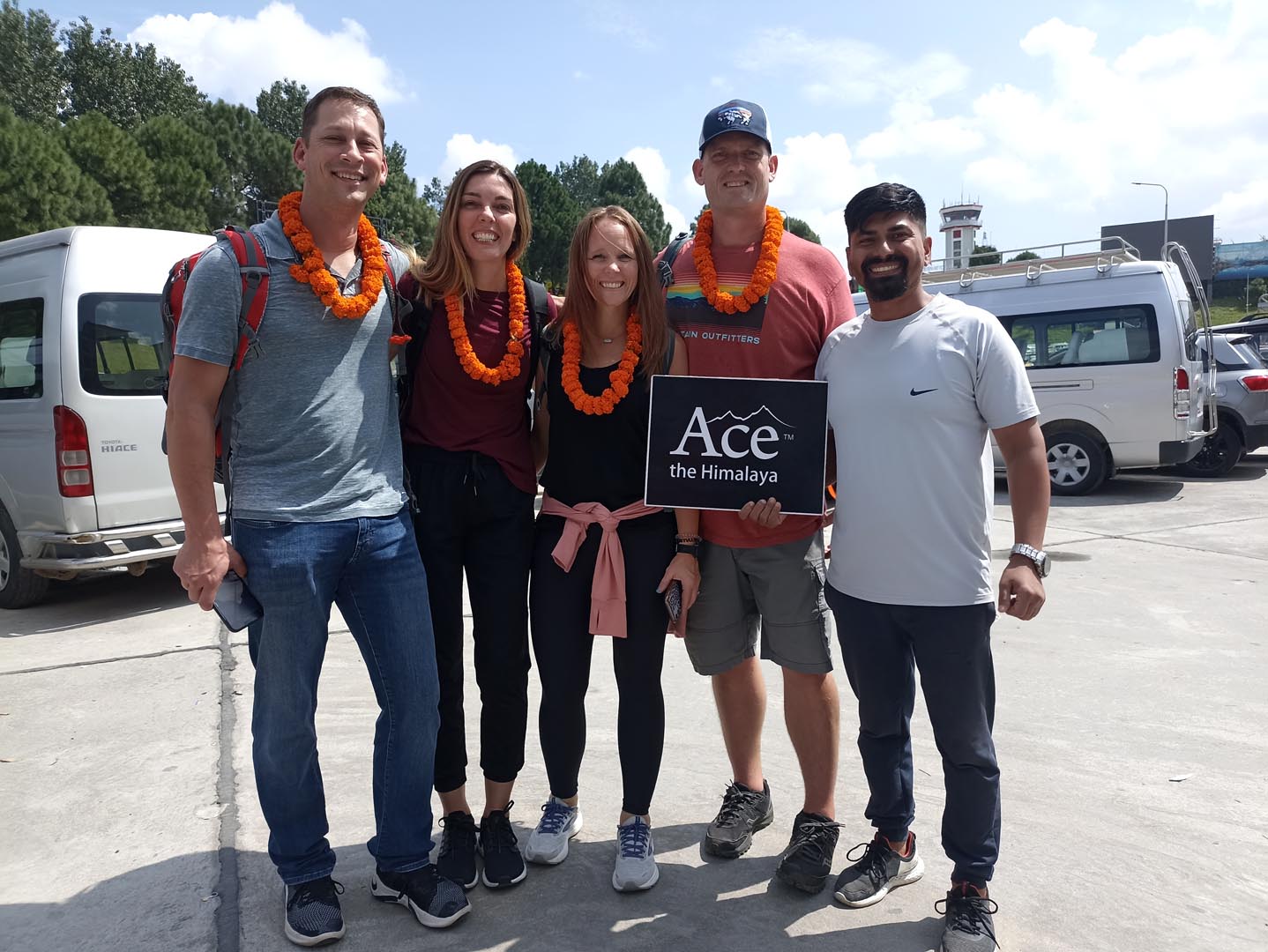
Note : Pre-trip meeting will be done at the office if you arrive before 4 pm and in your hotel itself if you arrive later in the evening. Be sure to bring two copies of passport-sized photos and a readable copy of your travel insurance policy to the meeting. These documents help to acquire trekking permits and related documentation during the trek. Pay the remaining balance of your invoice and sign in the legally binding trip form and non-liability disclaimer.
Day 02: Fly to Lukla from Kathmandu or drive to Manthali (Ramechhap) & flight to Lukla and then, trek to Phakding
Manthali to Lukla Flight (March, April, May, October, and November) During peak seasons, such as March, April, May, October, and November, the flight to Lukla will be operated from Ramechhap/Manthali due to air traffic expansion. The Manthali/Ramechhap airport is about a 5 to 6 hours drive away from Kathmandu. On this day we wake up at 1:30 to 2:30 am and take an escorted shuttle to Manthali airport on a shared tourist vehicle and board a 20-minute flight to Lukla.
Kathmandu to Lukla Flight (January, February, June, July, August, September, and December) The flight to Lukla is typically operated from Kathmandu during nonpeak seasons, which include January, February, June, July, August, September, and December . Please be aware that the decision regarding the operation of flights solely depends on the airline and is influenced by the volume of travelers during a specific month. On this day we wake up at 5 to 6 am. Our staff will escort you to the domestic airport terminal in Kathmandu and board a 35-minute flight to Lukla.
Helicopter Option
You have the option to book a direct helicopter flight from Kathmandu to Lukla for an extra charge of USD 550 per person. This price is quoted on a 5-people sharing basis. This is the best alternative to avoid the long drive to Manthali airport during peak season (March, April, May, October, and November).
Flight to Tenzing-Hillary Airport usually takes place early in the morning. We suggest you make all the sorting and packing the day before, so there is no rush on Day 2. Once you reach Lukla, have your breakfast while our guide will make an arrangement for porters. We assign one porter to every two clients. Begin the trek by descending towards the Dudh Kosi River where you join the main trail to Namche Bazaar, located just above Chaunikharka (2,713 m/8,900 ft). The walking is easy and after passing through the small village of Ghat (2,550 m/8,366 ft), it is a short walk to Phakding.
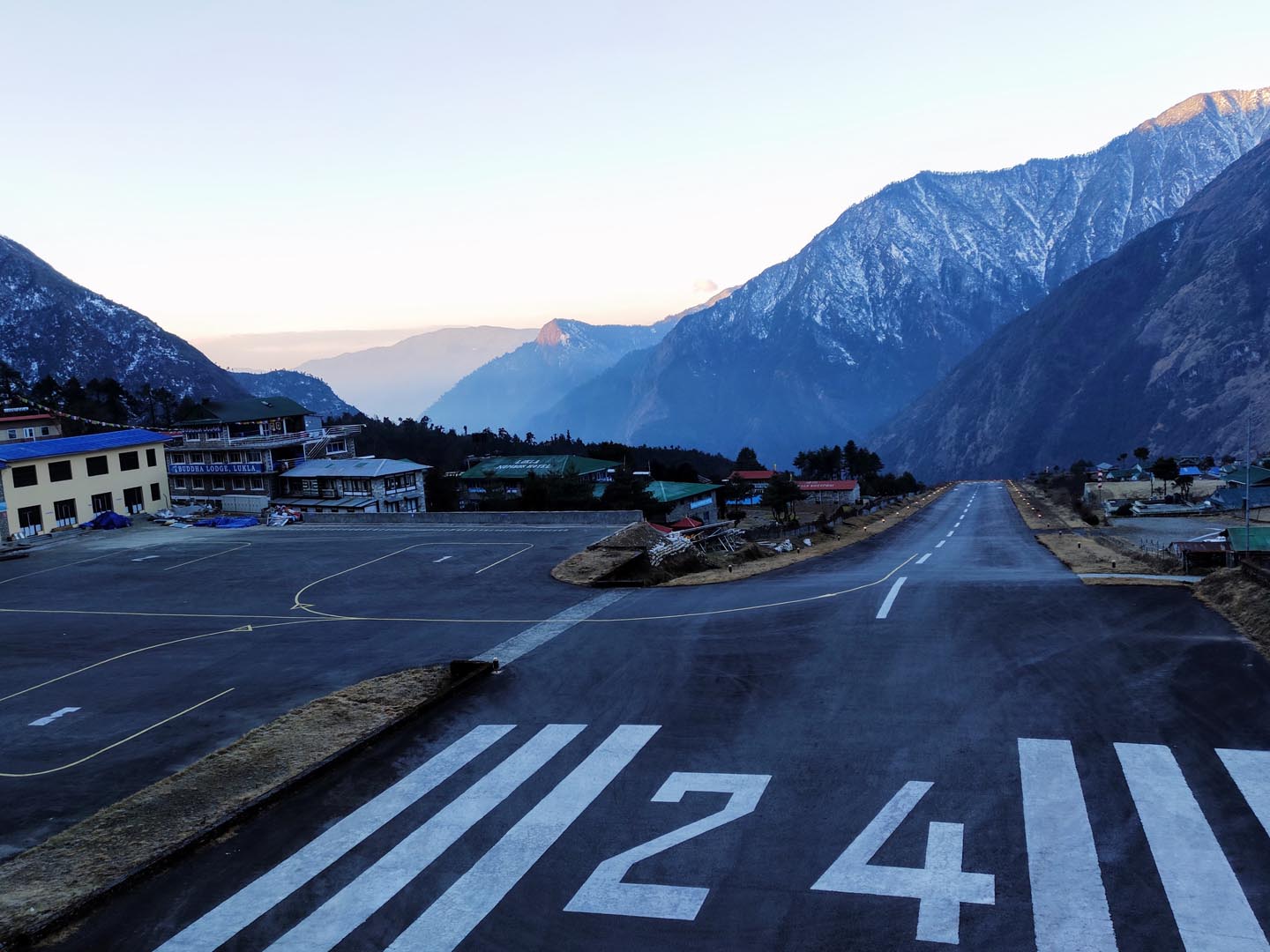
Day 03: Trek to Namche Bazaar from Phakding
There are many suspension bridges laden with prayer flag where Dudh Koshi River is following our way up to Namche Bazaar. Namche Bazaar is the main trading center in Khumbu region.
It is also known as Gateway to Everest. There are many good facility hotels and restaurant along with proper pubs and cyber cafés.
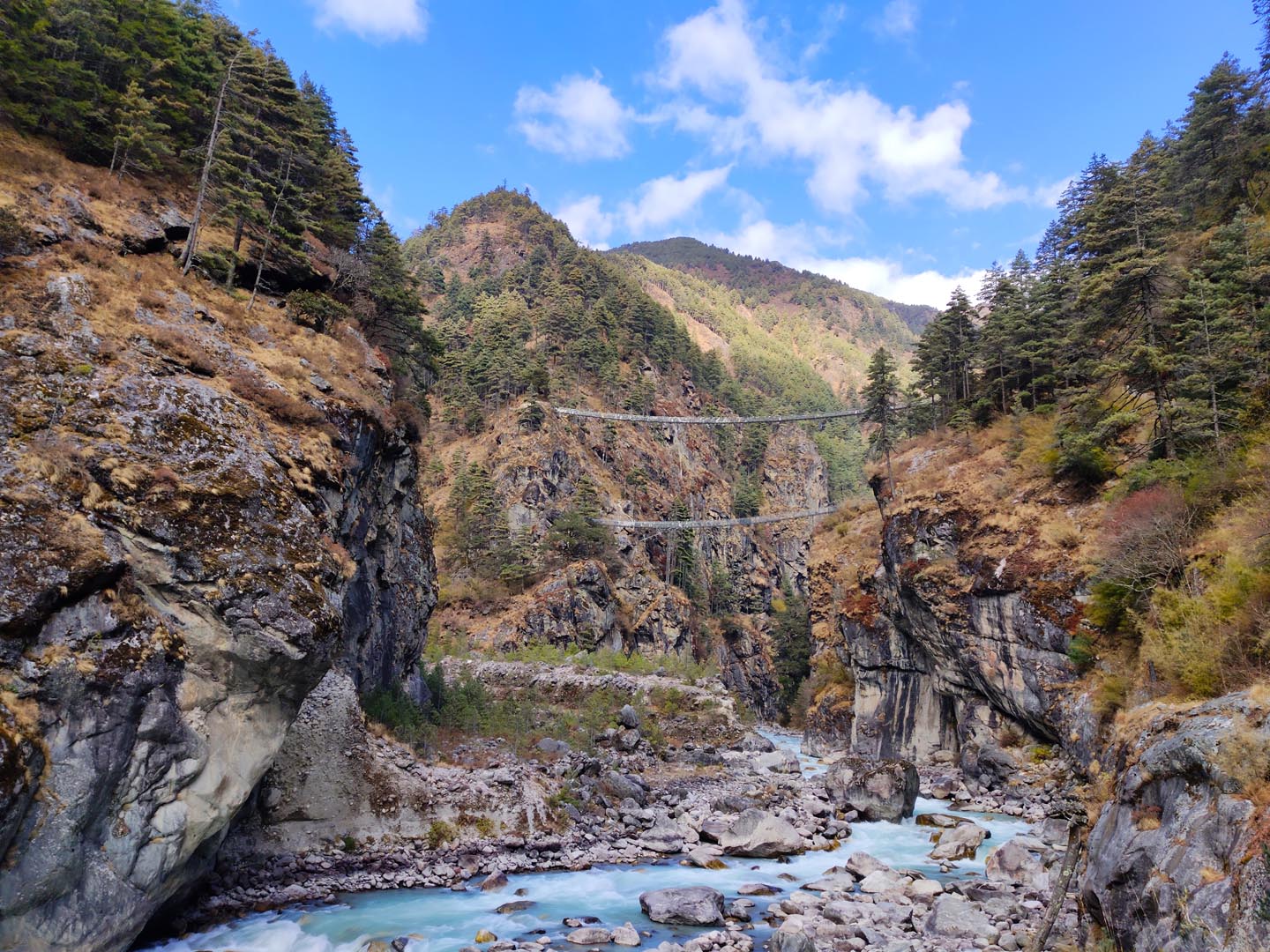
Day 04: Acclimatization Day at Namche Bazaar. Hike to Hotel Everest View and back
We will spend a day in Namche Bazaar in order to acclimatize and adjust to the thinning air. We will trek a short distance to a museum that is celebrated for its exhibits of the traditional customs of the Sherpa people.
We will also hike up the Syangboche Airport and the Everest View Hotel, one of the highest-placed hotels in the world. From this point, we can see rewarding views of the Himalayas including Mt Everest.
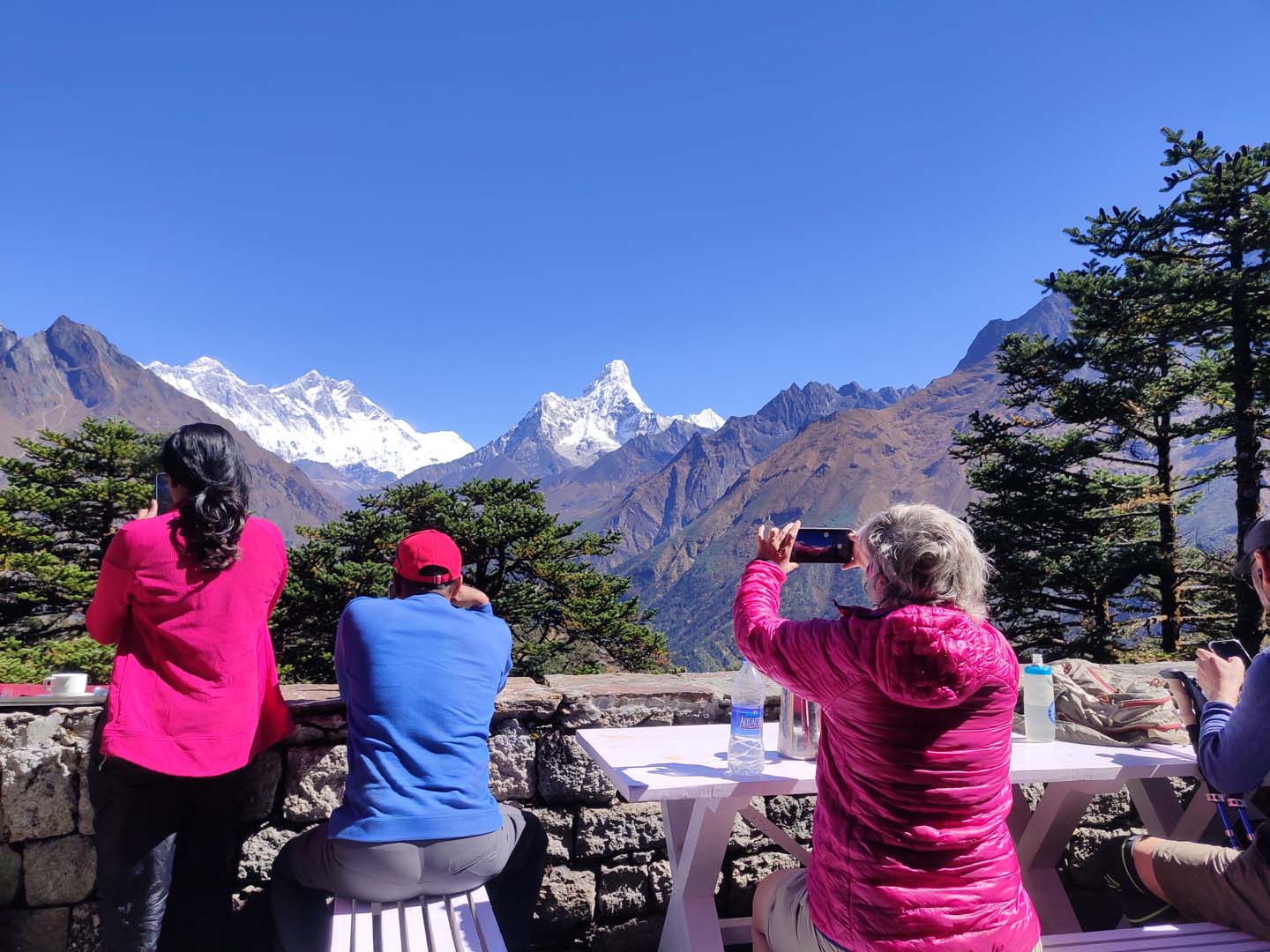
Day 05: Trek to Tengboche from Namche Bazaar
The views of Khumbi La and Taboche are magnificent throughout the day. We should dress warmly because cold wind blows throughout the trail. In the middle of the trek, there are two trails which divides into lower and upper trail. To continue our journey, we take left.
In Phorste Thanga there are few houses and lodges. After some hours of walking we reach our today’s destination Tengboche. It is inhabited by Sherpa’s where their main source of income comes from tourism.
There is an important and largest Buddhist Monastery, Tengboche Monastery where Ama Dablan lies behind.
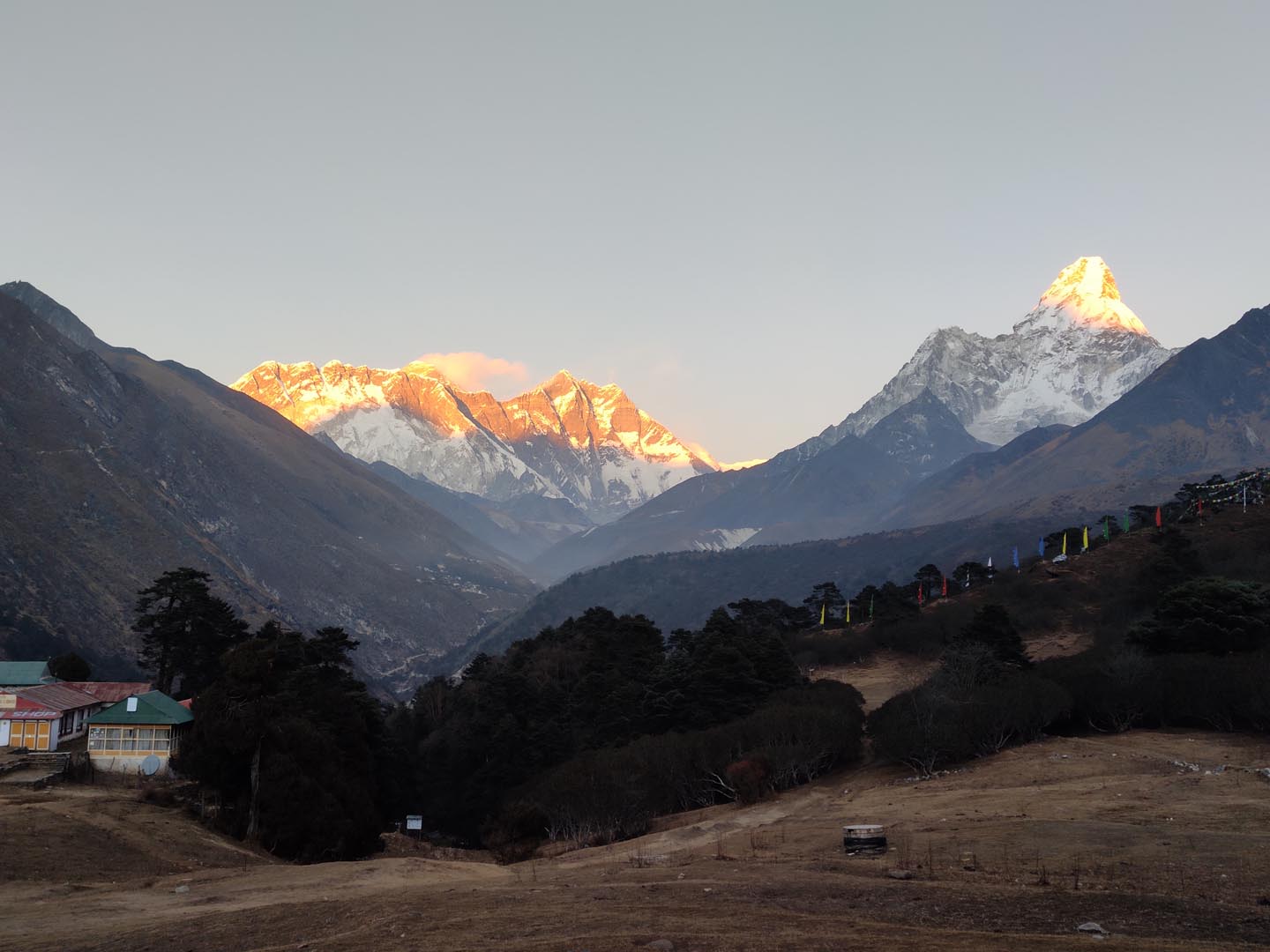
Day 06: Trek to Dingboche from Tengboche
After breakfast we start our trek towards Dingboche. Today’s trek covers 9.1Km and its easy trail with going downhill on a fairly wide path covered with beautiful rhododendron trees.
After few hours of walk and crossing bridge over Imja River, it takes us to Pangboche. In the whole trek, we can see wide open areas where trekkers can view more beautiful landscapes.
Walking trail above Pangboche, we get a magnificent view of Himalayas and Pangboche Monastery. We move ahead towards the Imja valley and finally we reach Dingboche.
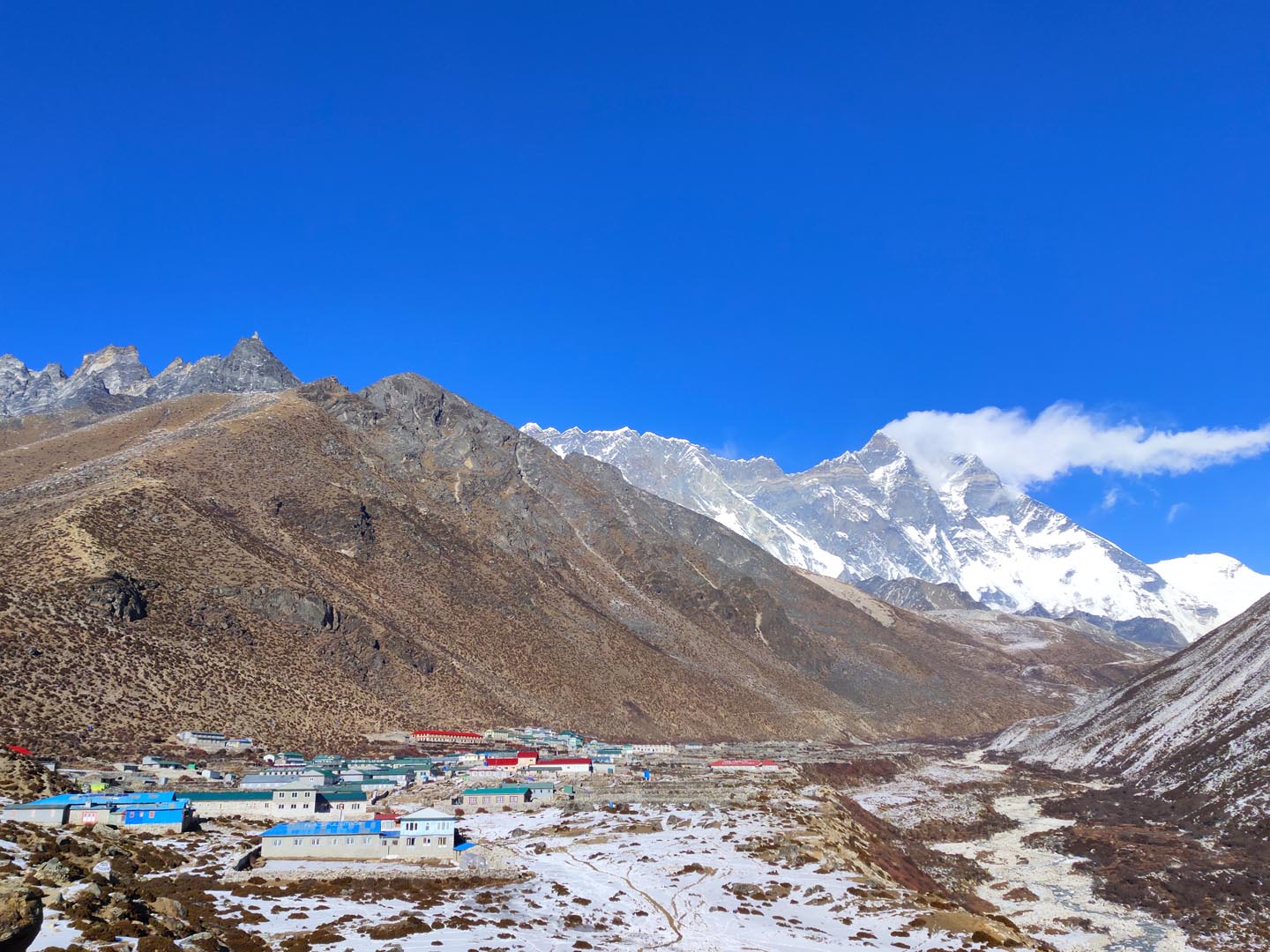
Day 07: Acclimatization Day at Dingboche. Hike to Nangkartsang Peak and back
Dingboche is a popular stop for trekkers and climbers headed to Mt. Everest, Ama Dablam and Imja Tse. It is a Sherpa village. According to the 2011 census, its population was around 200. There is also a helicopter landing pad with internet café (using satellite technology) and one of the world’s highest billiard parlors.
One can see great view of many Himalayas from Nagarjung Hill which may take some hour of hike from Dingboche.
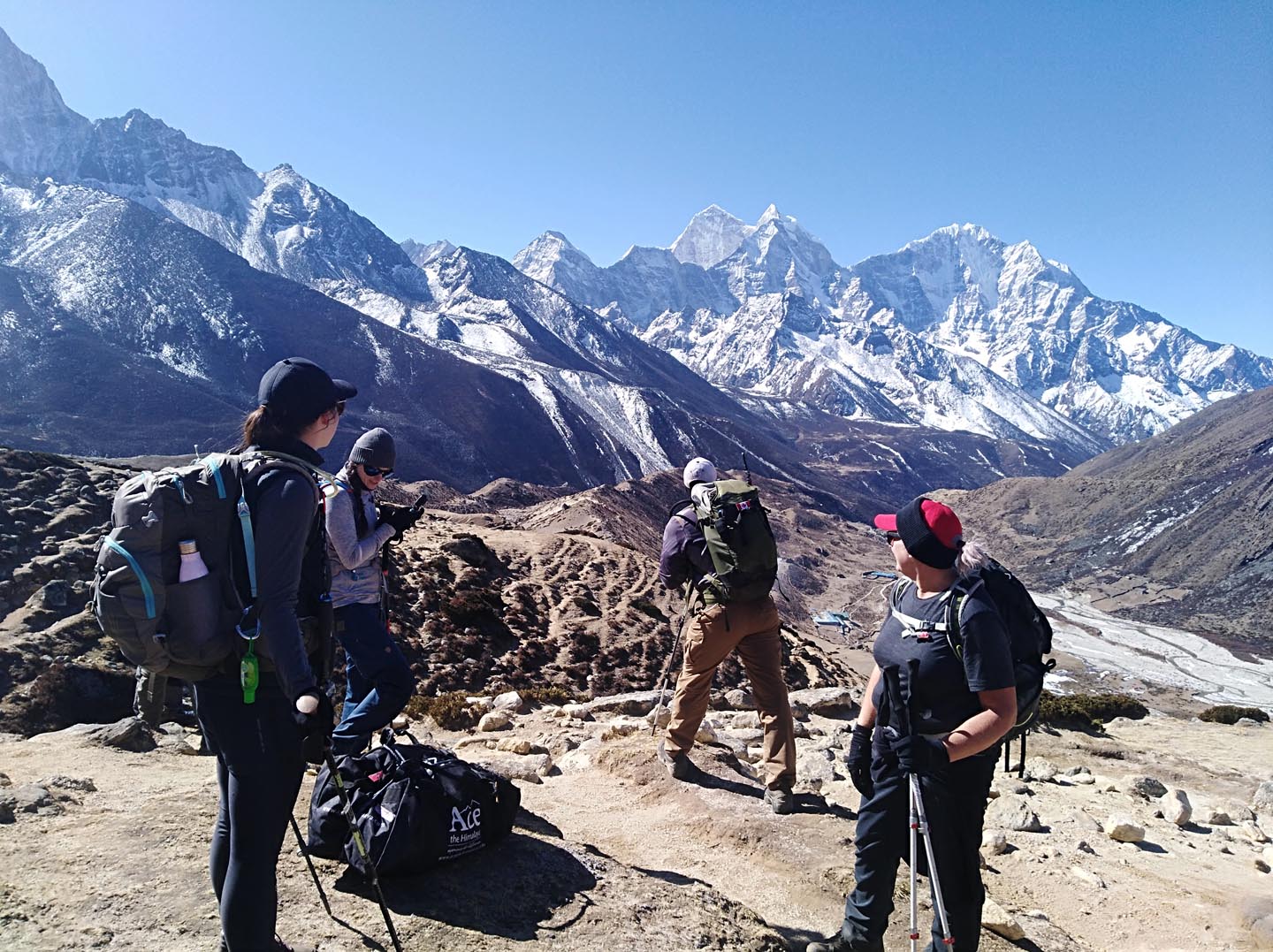
Day 08: Trek to Chhukung from Dingboche
Today, the trail is combined with some uphill and downhill climbs. After breakfast in Dingboche, we move towards Chhukung and have our lunch over there. As our last destination is Chhukung for the day you can slowly and steadily walk on the trails.
Along the trail, you can see several traditional farms and fences built from local stones. And then pass through Imja Khola valley, Bibre (which is a yak herdsman place). After half an 4 to 5 hours of walking, we reach to Chhukung where we will have lunch and stay overnight.
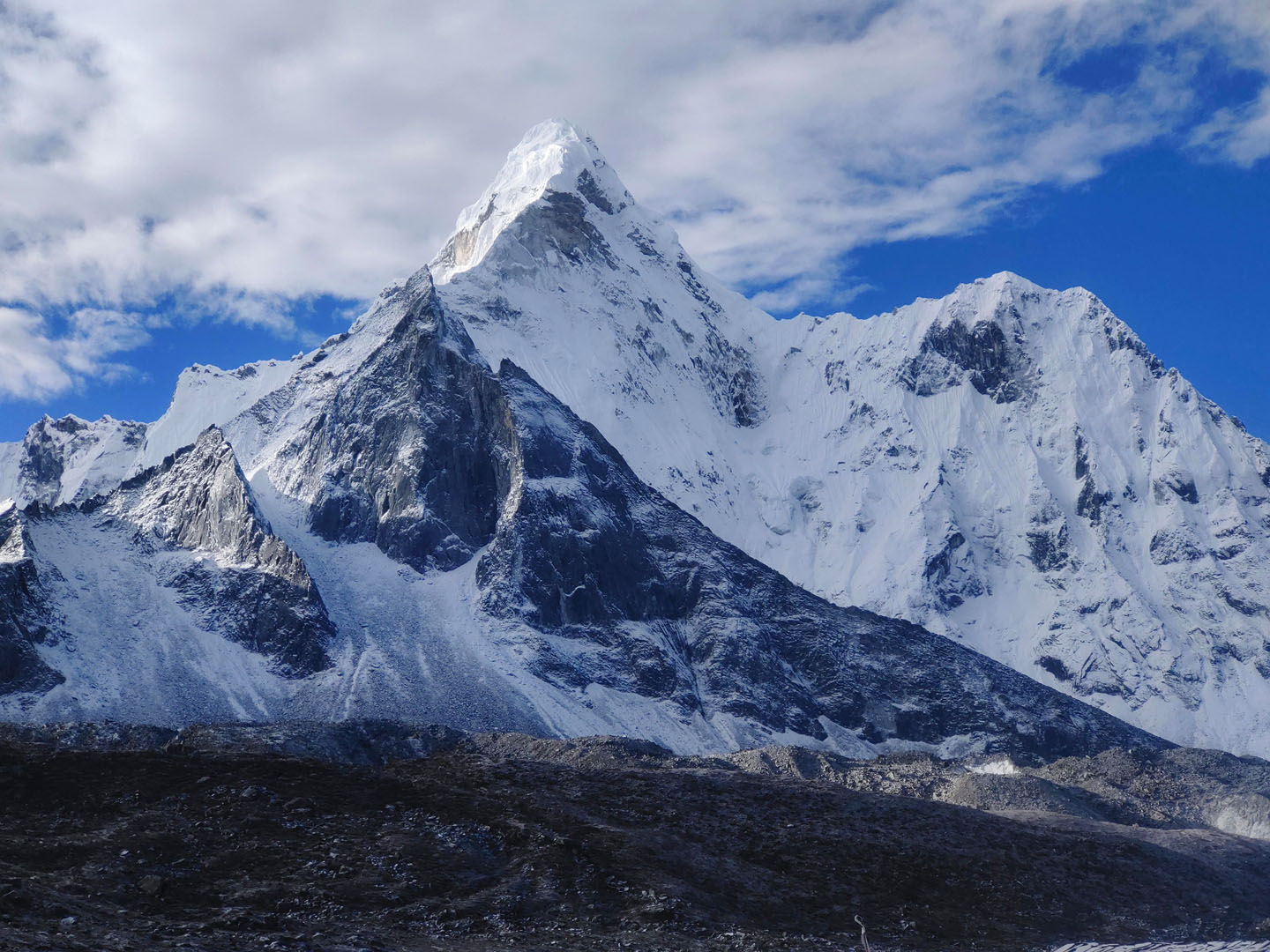
Day 09: Trek to Lobuche via Crossing Kongma La Pass
Today we climb for about 8-9 hours to reach the top of Kongma La pass. There are two trails for Kongma La pass; one is to the northwest of Chhukung over the Nuptse Glacier moraines and another one is back to Bibre and trek on the trail above the Niyang Khola.
As there aren’t any hotels, shops and tea houses, we carry our own packed foods and water. At the top of Kongma La pass, we can see beautiful Buddhist prayer flags. By turning north of Khumbu Glacier, we reach Lobuche.
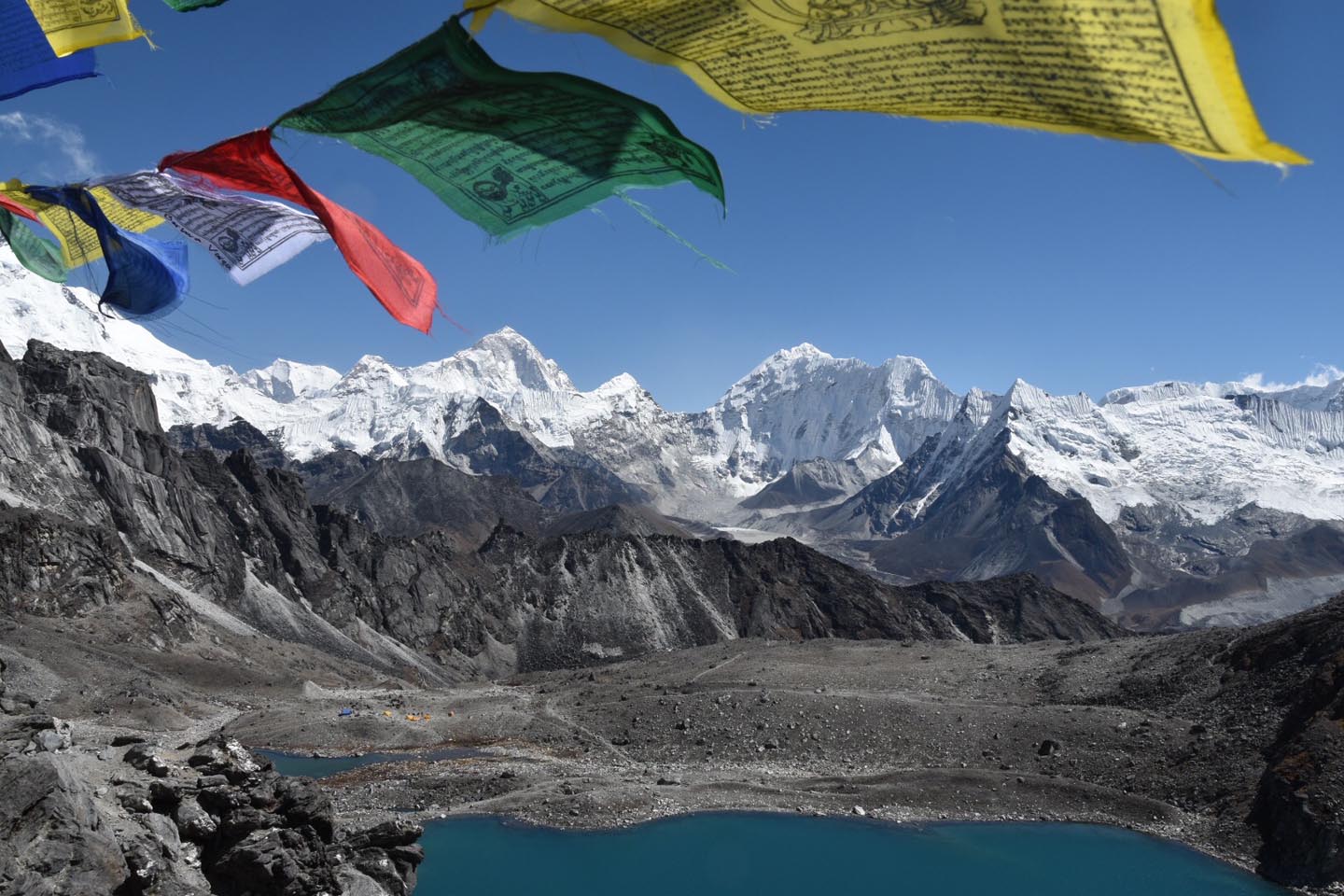
Day 10: Trek to Everest Base Camp and then back to Gorak Shep
Today the trail is of average level up to Gorak Shep. Before heading off to Everest Base Camp, we take lunch and rest at Gorak Shep which takes around 2 hours.
If the weather is good, we will be able to see beautiful Himalaya’s all-round. Then we head towards Everest Base Camp. Everest Base Camp is the closest you can get to Mt. Everest without mountaineering equipment and also highest altitude that most will reach without a climbing permit.
The view of the Khumbu Icefall from Base Camp is spectacular. The earthquake which occurred on 25 th April 2015 caused some damage on the route of the Everest Base Camp. We return back to Gorak Shep for the night.
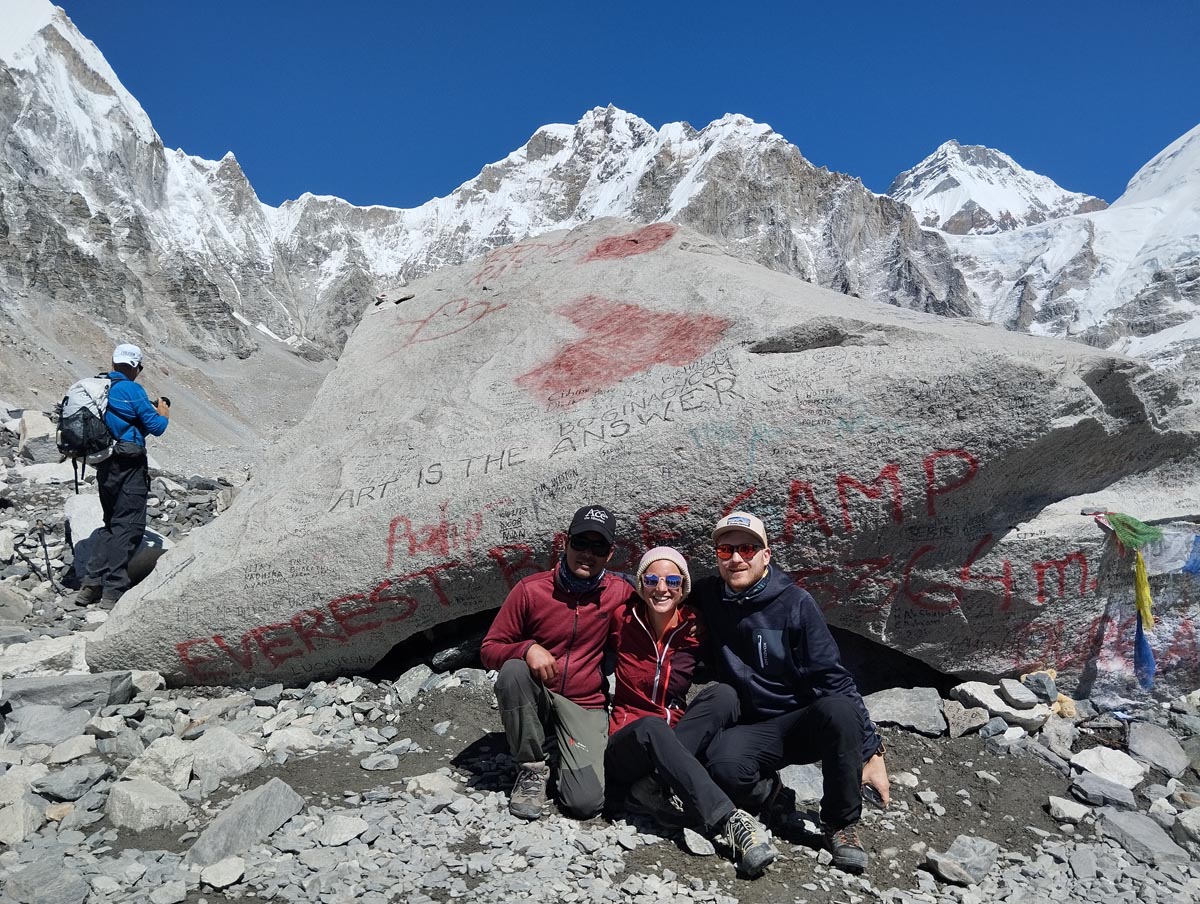
Day 11: Early morning hike to Kala Patthar and then, descend to Lobuche
This will be one of the most difficult yet rewarding days of the trek. Most of this day is spent climbing Mt. Kala Patthar at 5,555 m. From Mt. Kala Patthar one can see the superlative views of Everest.
After spending some time in Kala Patthar we move downwards toward Lobuche. It is a small village surrounded by the Rocky Mountains and the Himalayas. There is a mostly old ancient types of lodges but in recent years more facilitated lodges have been opened where some of them provide internet as well as oxygen serves.
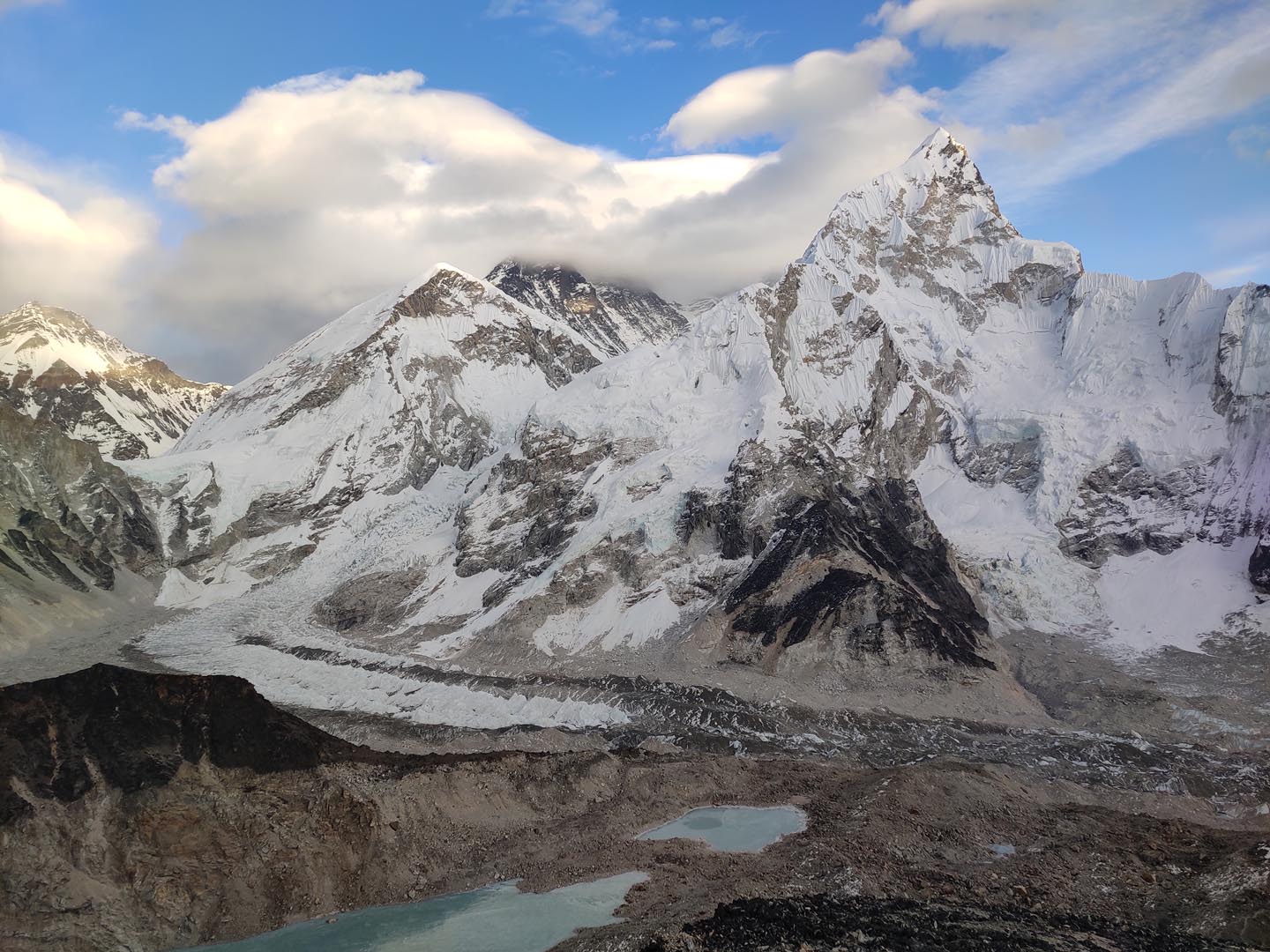
Day 12: Trek to Dzongla from Lobuche
From Lobuche we start to walk downwards where after few hours, trail divides into two and we take right side for Dzongla. We can see stupa and tombstones in the distance. After that we trek upwards where we can see Chola Tsho Lake nearby. We continue to trek by crossing Chola Khola on a bridge before reaching Dzongla.
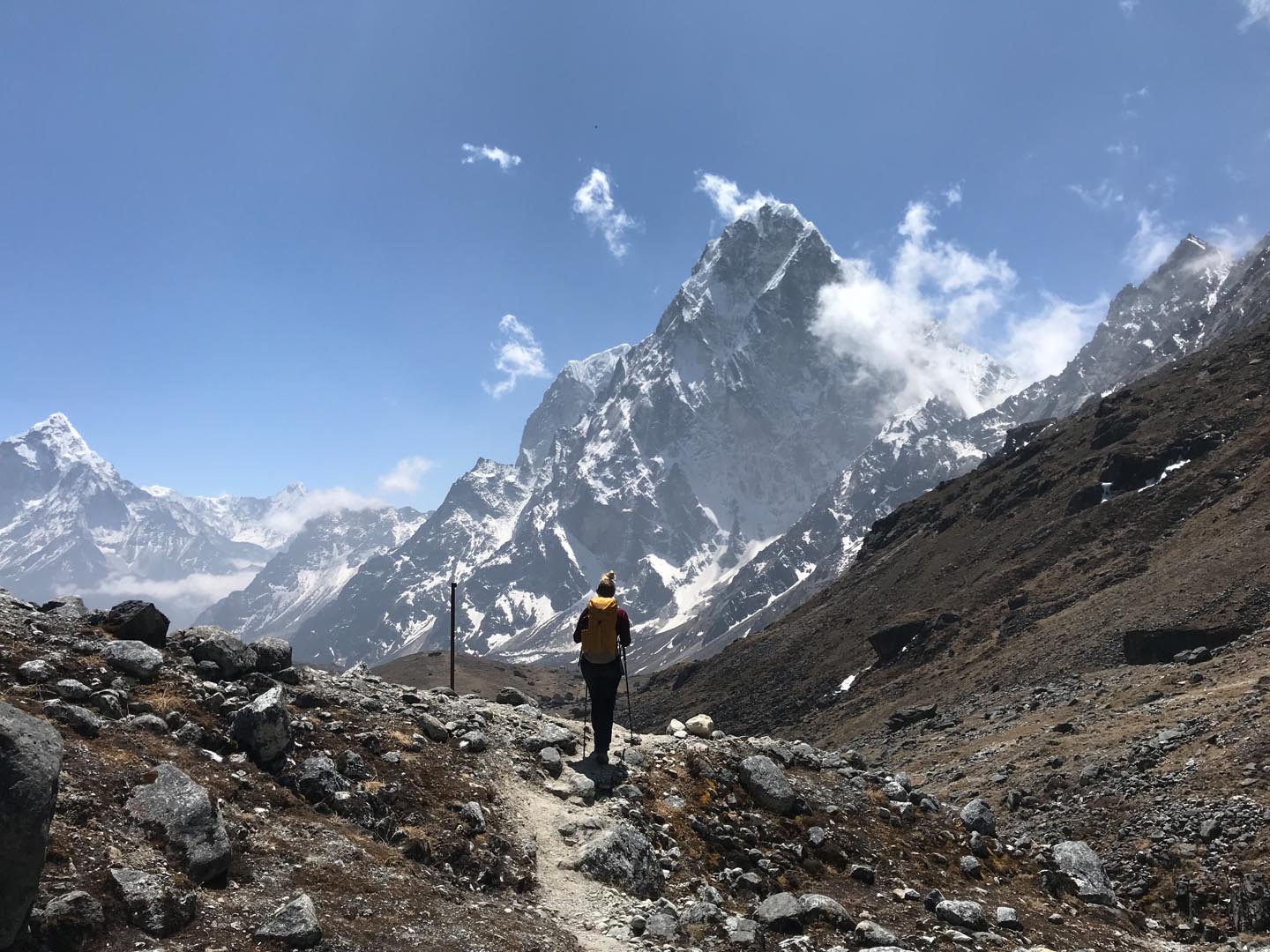
Day 13: Trek to Gokyo from Dzongla via Crossing Cho La Pass
Today we have to start our trek before 4-5 am so we can cross Cho La pass before mid-day and re-assess the hike when the weather turns bad. Today the route maybe little difficult due to high altitude and steeply loose rock.
Snow may cause some problem while crossing Cho La pass and rock fall can also be the problem although weather is good. As a result you can see magnificent view from the top of Cho La Pass then we will descend to our destination, Gokyo (4,800 m).
We have to cross Khara, Pangka, and Ngozumpa glacier (which is the longest glacier in Nepal). We can see the beautiful view of Kantaga and big Mountain Cho-oyu. There are series of six lakes where third one is the Gokyo Lake.
There is a small village near the Gokyo Lake where we will stay 2 nights as we will have sightseeing and hiking trip around Gokyo.
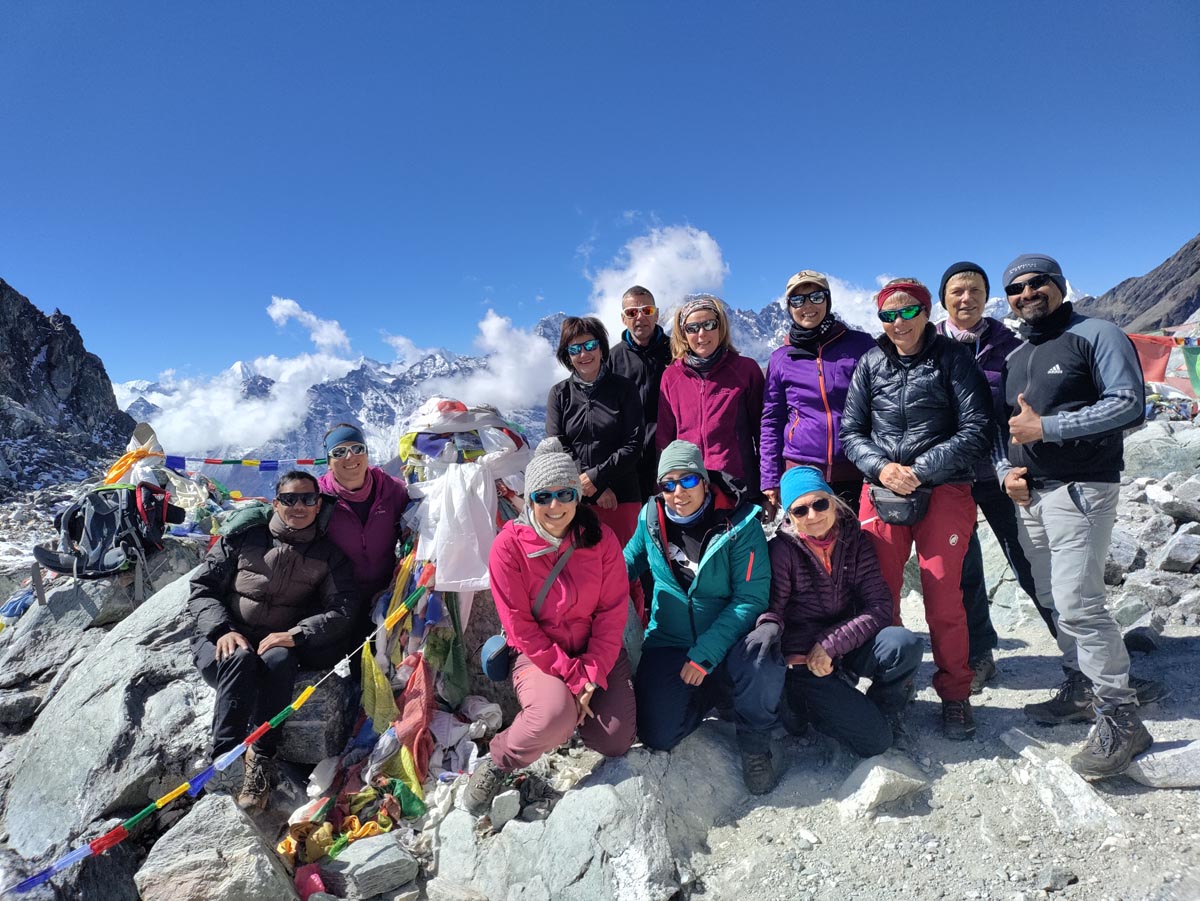
Day 14: Climb Gokyo Ri and return back to Gokyo
Early in the morning, we have a steep climb up to the top of Gokyo Ri at an elevation of 5,483 m. There are ample rewards for those who attempt this trip. You get stunning views of the super Gokyo valley, the massive Ngozumpa glacier and an incredible panoramic view of the whole Khumbu Himalayas, including the giants; Everest, Lhotse, Nuptse, Makalu, Cho-Oyu and Gychung Kang.

Day 15: Trek to Lunden from Gokyo via Crossing Renjo La Pass
Today we start our trek in the morning. Our trek for today is long but on the normal trail. We can see amazing view of Mt. Everest from the top of the Renjo pass. Then we descend down to Lunden for our today’s final destination.
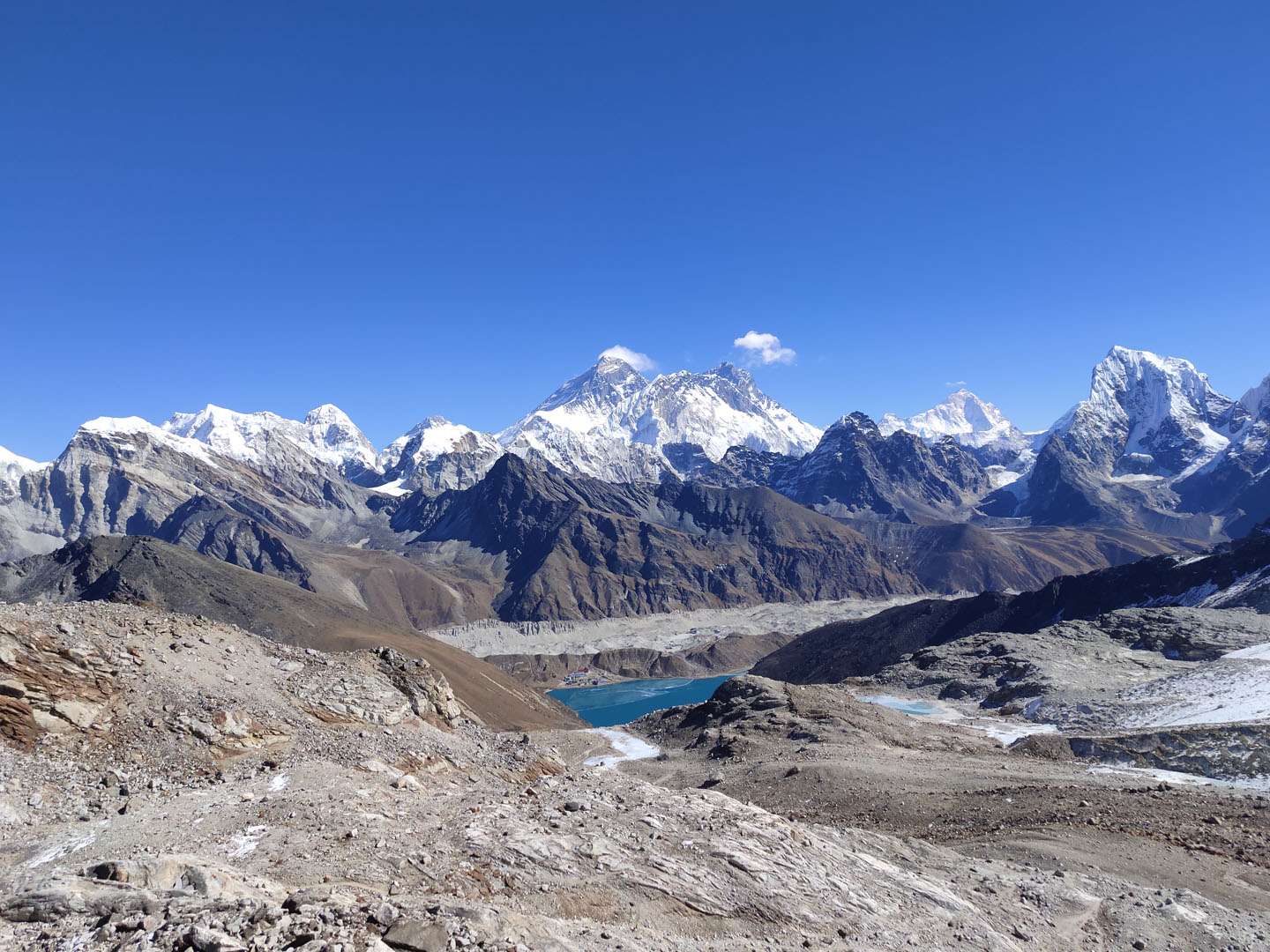
Day 16: Trek to Thame from Lunden
We start our trek after breakfast. Today, the trail will mostly descend down to to Thame.
While on the trail we can see amazing snow peaks. About 150 meters above Thame, there is a Thame Monastery, a picturesque monastery set among the many homes of monks and lay people.
It resides on the side of a hill overlooking the valley. This is the site for the spring celebration of the Mani Rimdu festival, held about the middle of May each year.
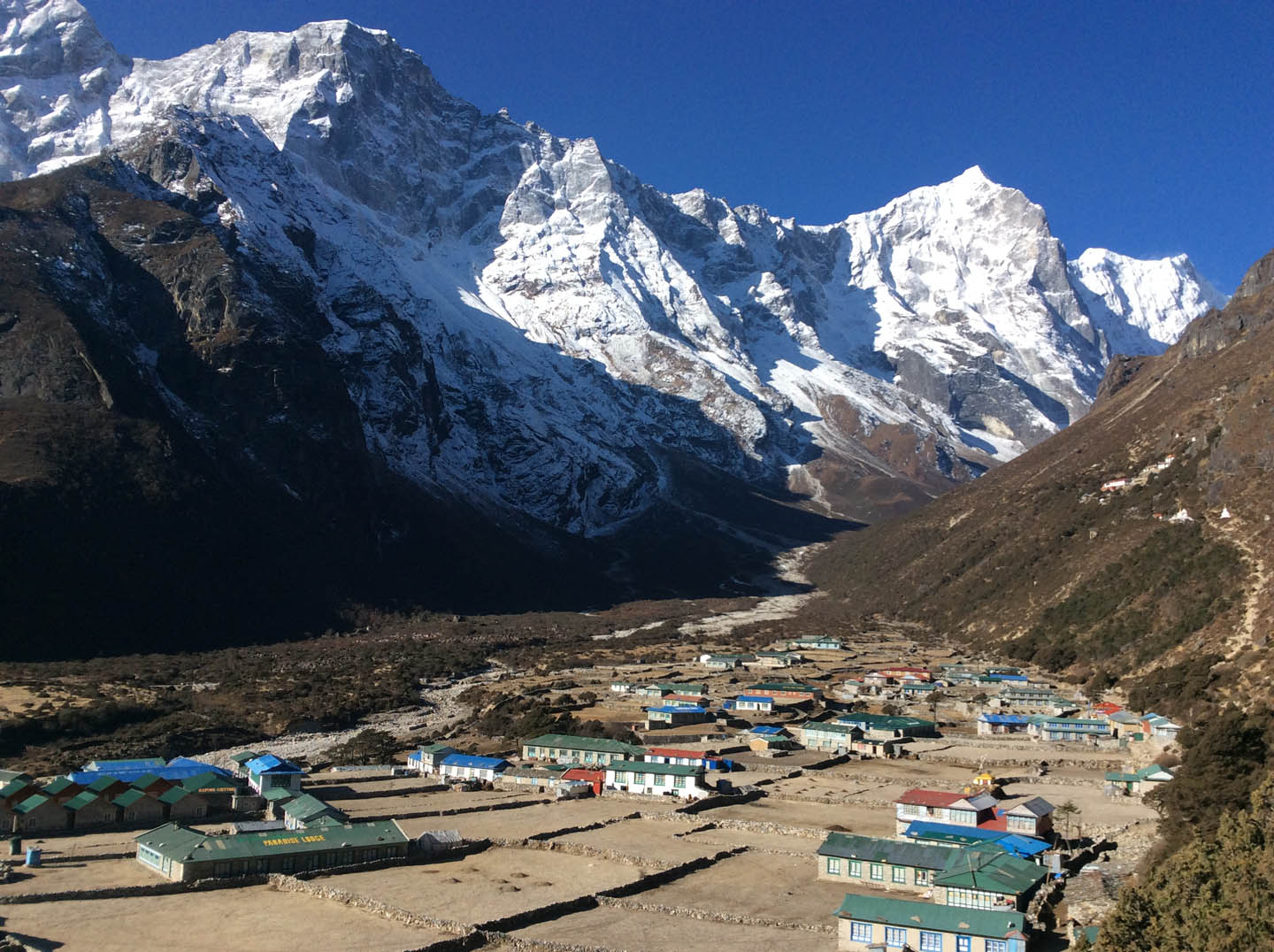
Day 17: Trek to Namche Bazar from Thame
Thame is a traditional Sherpa village that has escaped the crowds trekking to Everest and has one of the oldest monasteries in the region. The village is notably the hometown of Apa Sherpa who has made it to the summit of Everest 21 times!
The walk itself is peaceful with excellent views of the mountains as it winds in and out of the forest on the side of the canyon. This day, we continue our journey walking down the hill from Thame.
The trek will be easy and short and the final destination for the day and the trip will be at Namche Bazar.

Day 18: Trek to Lukla from Namche Bazaar
Finally we return back to Lukla where the trek began, which will seem like ages ago. It will give you time to reflect on the trek also giving you time to explore the town.
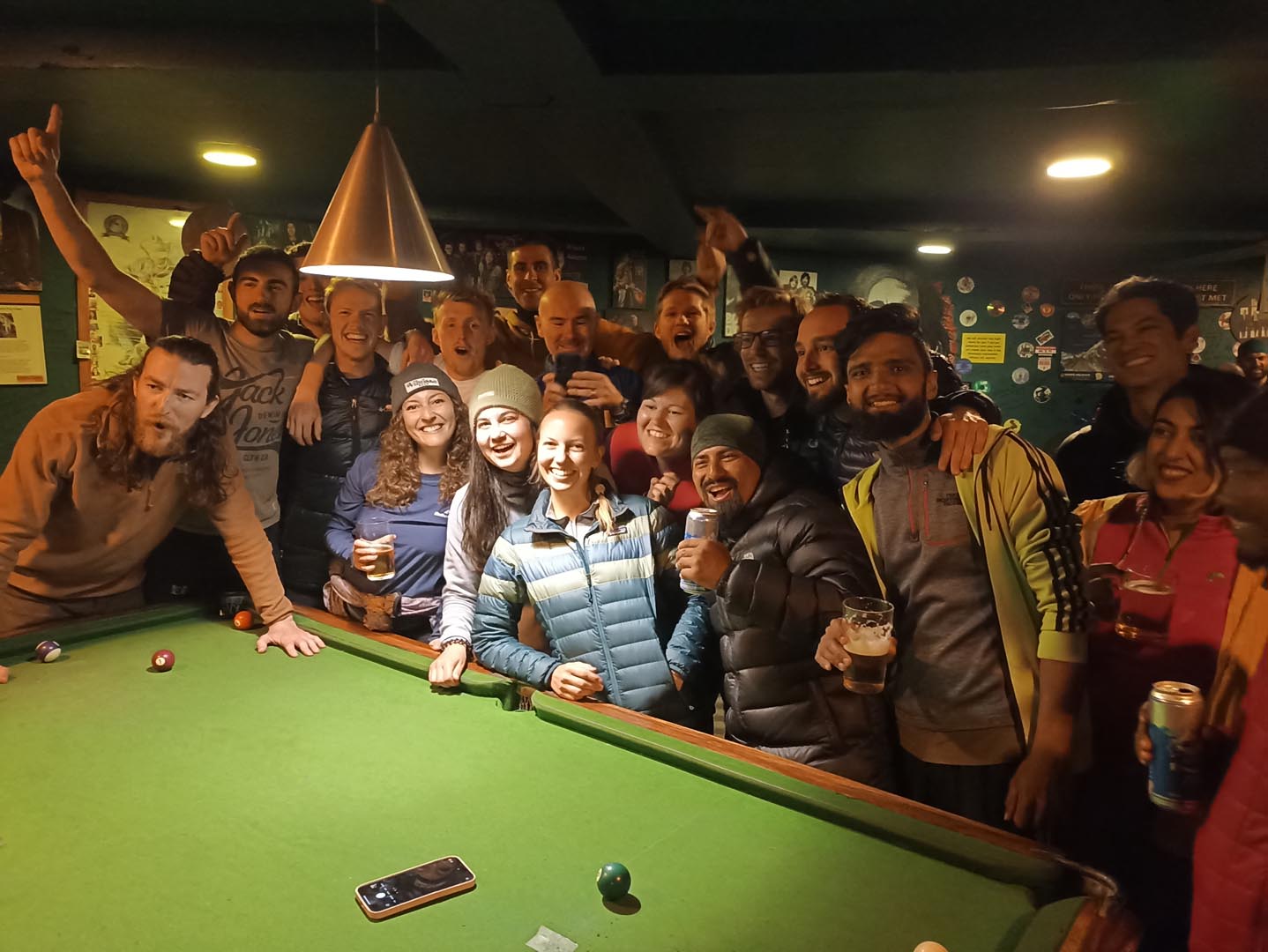
Day 19: Fly back to Kathmandu or Manthali from Lukla and same day drive to Kathmandu
Lukla to Manthali Flight (March, April, May, October, and November) The flight from Lukla to Manthali is a 20-minute flight. After that, it is about a 5 to 6 hour drive to Kathmandu. Please note that the driving hours may vary according to the highway traffic condition. You’ll be transferred to the hotel in Kathmandu on a shared tourist vehicle.
Lukla to Kathmandu Flight (January, February, June, July, August, September, and December) The flight from Lukla takes about 35 minutes. After arriving at the airport, you will be transferred to the hotel in Kathmandu via a shared tourist vehicle. Please be aware that the decision regarding the operation of flights solely depends on the airline and is influenced by the volume of travelers during a specific month.
You have the option to book a direct helicopter flight from Lukla to Kathmandu for an extra charge of USD 550 per person. This price is quoted on a 5-people sharing basis. This is the best alternative to avoid the long drive to from Manthali airport to Kathmandu during peak season (March, April, May, October and November).
You might want to stay a little more in Nepal. If you are looking for extending your trip, there are options such as a visit to Chitwan National Park, known for wildlife viewing, and to Pokhara, considered one of the most beautiful cities in Nepal. You can also extend your trip to Tibet, India, or Bhutan.
You will be served a farewell dinner in a fine restaurant.
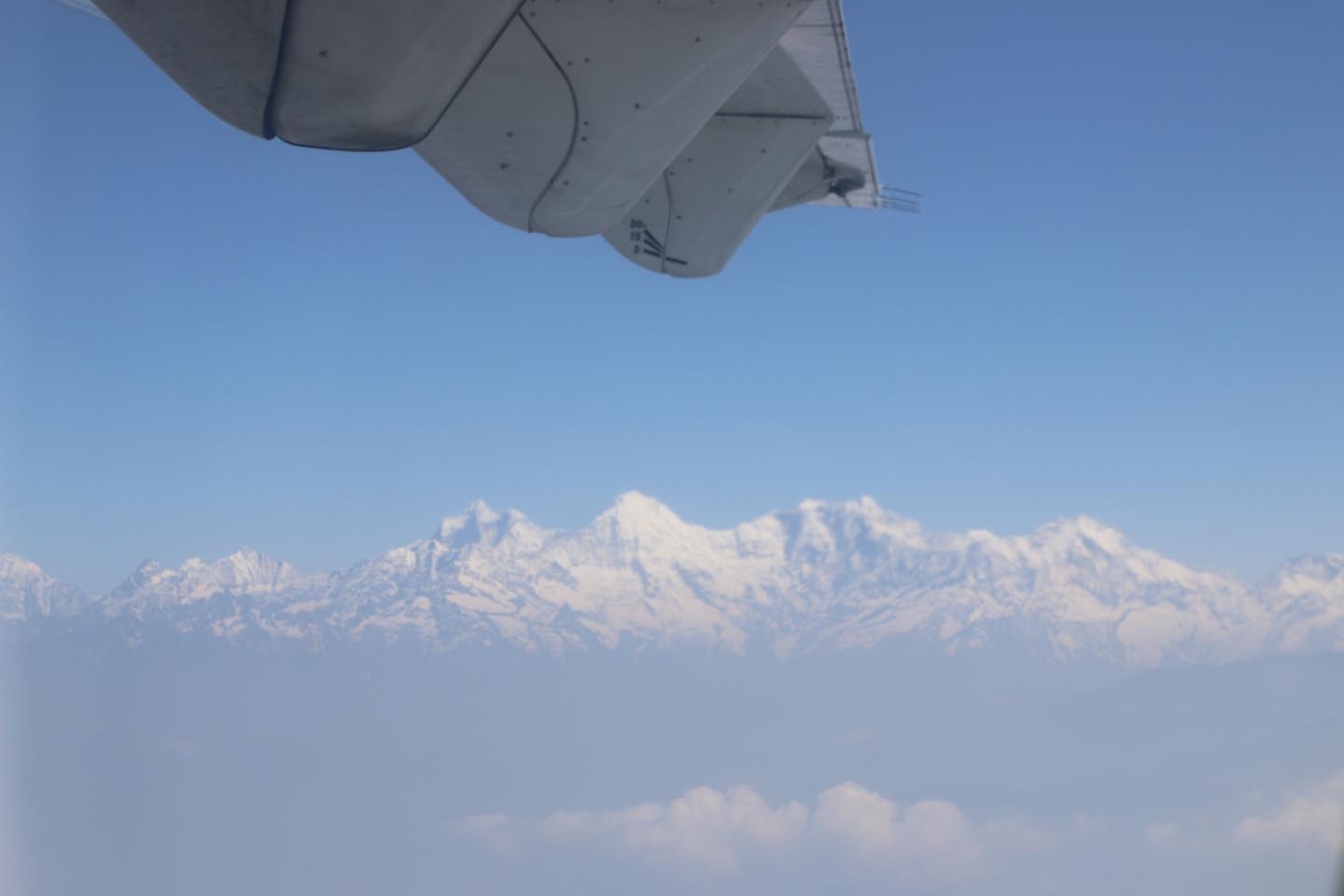
Day 20: Transfer to the International Airport for Your Final Departure
The trip concludes – our airport representative will drop you to Kathmandu’s Tribhuwan International Airport for your flight departure from Nepal.
Packing list for Everest three passes trekking
Here is a list of what you might want to pack for the hike. Please take this as a starting point. You’ll need layers of warmer clothing during the winter. We provide a 75 liter duffel bag for you to use for the trek.
It will be given to you during your pre-trip meeting in Kathmandu. The duffle bag is yours to keep. Also, you can rent sleeping bag and down jacket with us at the additional fee of USD 35 for each once you are in Kathmandu.
- Four-season (zero degree) sleeping bag (We have rental sleeping bags available for an additional USD 35)
- Puffy down jacket ( We have rental jackets available for an additional USD 35)
- Daypack (35-45 liters recommended) with rain cover
- Sleeping bag liner
- Sun hat or cap (We'll provide you with a free Ace the Himalaya baseball cap.)
- Knitted hat/Beanie
- Technical fabric base layer (light for warmer months, heavy for colder months)
- Technical fabric short (2) and long sleeve (2) shirts
- Waterproof, windproof shell
- Fleece jacket or pullover
- Hiking pants (2)
- Comfortable pants for inside the teahouses
- Hiking shorts
- Wool or technical fabric liner gloves
- Hard-shell outer gloves (insulated for colder months)
- Wool or technical fabric warm socks
- Hiking socks
- Liner socks (optional such as silk)
- Trekking/hiking boots (waterproof recommended)
- Ice Cleats /Micro Spikes (For trekking from November to March, it's recommended to include Ice Cleats/ Micro Spikes to prevent slipping on icy or wet surfaces.)
- Casual shoes
- Gaiters (lightweight for dust or heavy for snow in colder months)
Undergarments
Note: The quantity of each article of clothing can be adjusted to suit the preferences of each participant.
- Technical fabric/quick drying is best for underwear (opportunities to launder during the trip)
- Sports bras (women)
- Pajamas or sleeping clothes
First Aid Kits and Medications
- ( Note : Guides carry medications and first aid kits during the trip. However, personal kits and medications are highly recommended.)
Other Essentials
- Extra copies of passport-sized photos
- Reusable water bottle
- Toiletry kits
- Water purification tablets or UV water purifier (if you plan to treat water)
- Hydration bladder
- Toilet paper (2 rolls)
- High protein snacks (such as protein bars or nuts)
- Waterproof/dry bags for carrying important documents and money
- Airline tickets (Please leave a copy at our office in Kathmandu. This can be useful if there is a change in the date of the flight.)
Once in Nepal, if you have the time, you can purchase supplies and gear for hiking. Thamel, Kathmandu’s tourist hub, is home to many shops where you can get a variety of reasonably priced trekking equipment.
- Power bank or extra batteries
- Cameras and mobile phone
- Trekking poles
- Thermos for hot water
Important Information
- We give you a free duffel bag and baseball cap during your pre-trip meeting in Kathmandu. The duffel bag will be used to pack your trekking supplies.
- For every two participants, we assign one porter. The duffel bag, which should weigh around10 kg/22 lbs, will be carried by the porter throughout the walk.
- To carry your daily necessities like cash, crucial papers, a water bottle or bladder, a camera, toiletries, sunscreen, a notebook, clothing, etc., you must have your own daypack (with a waterproof cover).
- You can store your luggage (non- trekking items) at the hotel in Kathmandu.
- Total luggage allotment allowance for Kathmandu-Lukla flight is 15 Kg/33 lbs including both duffel (10 Kg/22 lbs.) and backpack (5Kg/11 lbs.)
- Down jacket with a hood is a must for altitudes above 4,000 m to keep warm. You can rent a down jacket for USD 35. Please note that in case of loss or damage, you need to reimburse the cost of USD 200 per item.
- You can rent a 4-season sleeping bag for USD 35. Please note that in case of loss or damage, you need to reimburse the cost of USD 200 per item.
Note: Some clothing, especially form-fitting, figure-hugging items made of elastic material (like yoga pants), may offend locals. Therefore, if you choose to wear these clothes for comfort, please make sure to wear something over them.
Everest High Passes Trek Map & Elevation
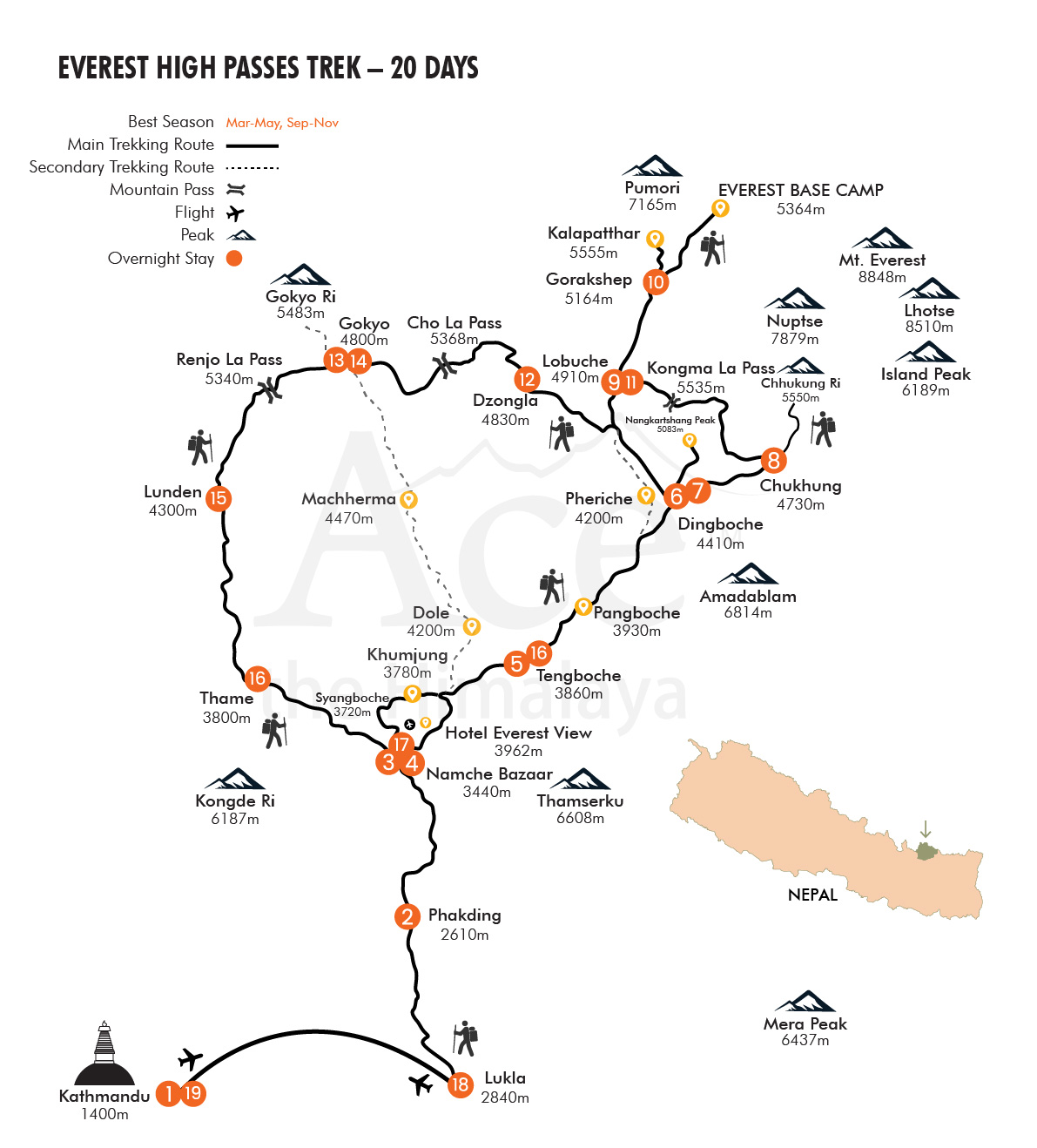
FAQs for Everest Three Passes Trek
Why trek with ace the himalaya.
Ace has a reputation for successfully leading treks with knowledgeable leaders and staff taking care of all your travel needs. We are a certified sustainable travel company that also endorses the idea of giving back to the community by participating in various philanthropic activities. Here are 17 reasons why you should choose Ace the Himalaya for your next adventure!
Is Nepal open to travelers following the Covid-19 pandemic?
Indeed, Nepal is entirely open. Travelers are welcome in Nepal without any restrictions. Arriving travelers can obtain a visa on arrival at the Kathmandu airport as well.
What are the conditions to travel to Nepal post Covid-19?
Traveling to Nepal is now hassle-free. You don’t need a vaccination certificate or negative PCR test, but check with your airlines and transit countries for any specific requirements.
We suggest you look at the Nepal immigration site https://www.immigration.gov.np for the most up-to-date information.
What additional documents do I need?
- Two passport-sized photos (2×2 inch) to give to our office staff
- A copy of your international flight ticket to give to our office staff
- A copy of travel insurance to give to our office staff
What should I know about booking my flights to/from Nepal? Do I need to plan extra days in case of delays?
The best course of action is to add a day or two before and after your intended trek days in case of flight delays or cancellations. It also gives you time to buy clothing equipment and gear required before your trip.
Please be aware that Ace the Himalaya is not responsible for any inconveniences or missed international flights resulting from unforeseen events like airport changes, flight delays or cancellations, etc.
Is hiring a guide necessary even if I have trekking experience?
You can hike in Everest Region without a guide. A guide is there to assist you in going forward and making alternative plans and arrangements when unanticipated occurrences happen or when things get difficult.
Our hiking leaders are qualified experts. When talking about their trip, our guests frequently remark on how much fun they had and how crucial their guide was to make it successful.
Can the guide speak English?
Our guides are fluent in English. All the guides that we assign speak and understand English. They’ll share with you the fascinating stories, traditions, and folklore of the mountains. The guides will also help you communicate with the locals since many shopkeepers and hosts of teahouses don’t speak English.
Weather and Temperature
What is the best season for this trek.
The best seasons to hike Everest high passes trek are autumn (Mid-September to November) and spring (March to early June). This trek is possible year-round, and we can organize it when it suits your schedule.
However, we generally suggest doing this trek in the favorable seasons and keep away from rainstorm season (July and August). In cold months of January and February, the temperature can be a little harsh in the mountains.
However, some prefer to travel during these months as it is less crowded given that you are well prepared with appropriate winter wear and other gears.
What kind of weather and temperature can I expect while trekking?
Due to its tendency to be localized, the weather in the Everest region is challenging to forecast. You could see rain, fog, cold, or hot and sunny weather while trekking. It is best to be equipped to handle various weather situations. In the Everest region, nighttime temperatures are significantly lower than midday temperatures. In less than a day, the temperature can change from a high of 25°C (77°F) to a low of – 20°C (-4°F). The weather and temperature ranges are typically predictable based on the month and season, even though it might be challenging to predict what each day in the mountains will bring.
Spring – March/April/May/June
Despite being the busiest season, spring is perhaps the best time to visit the Everest region. Activities assisting the expedition teams take place in Everest Base Camp. The many varieties of blossoming trees should be visible, and the sky should be clear with stunning vistas. During springtime, the average temperature is 20°C (68°F), with a high of 25°C (77°F) during clear days and a low of – 15°C (5°F) overnight above 4000 meters.
Monsoon season – July/August through Mid-September
Since it rains heavily at elevations below 3500 meters, this season isn’t exactly ideal for travel in the Everest region. While it can occasionally be dry in areas above 4000 meters, it frequently rains so therefore not many people travel during this season. Trekking during the monsoon season has some advantages, such as a greater possibility of seeing waterfalls and the best opportunity to escape crowds. During the monsoon, the average temperature is 22°C (71.6°F), with a high of 30°C (86°F) during clear days and a low of- 5°C (23°F) overnight above 4000 meters.
Autumn – End of September/October/November
In the Everest region, autumn is equally as busy as spring. It is one of the best times to go, too. While the plants and trees are not in bloom, the sky is often clear, offering breathtaking vistas from almost every viewpoint. The average temperature in autumn is 17°C (62.6°F), with a high of 20°C (68°F) during clear days and a low of – 15°C (5°F) overnight above 4000 meters.
Winter – December/January/February
Due to fewer tourists, some people like winter travel. Even while the views are still beautiful, it can be cloudy, thus adding extra days is highly advised during this time. The average temperature is 10°C (50°F), with a high of 17°C (62.6°F) during clear days and a low of – 20°C (- 4°F) overnight above 4000 meters. The teahouses provide extra blankets for warmth at night.
What is the temperature rating of the sleeping bag that you lend to trekkers?
The temperature rating of the sleeping bags that we rent to trekkers is about -10°C (14°F). Also, our guides can obtain extra blankets if needed at the teahouses.
Arrival and Visas
Is it possible to obtain a visa for nepal upon arrival at the airport.
Yes, you can obtain a Nepal visa upon your arrival at the airport. There are kiosks in the arrival hall that you use to complete the necessary forms. The cost is USD 30 for a 15-day tourist visa, including numerous entries, or USD 50 and USD 125 for a 30-day or 90-day tourist visa including numerous entries respectively. You should carry cash (USD) with you to pay your visa fees quickly and easily, as digital payments are frequently unavailable.
Who will come to pick me up at the airport upon my arrival?
Our staff will be waiting for you outside the airport terminal with our signboard (Ace the Himalaya). You will be accompanied to a hotel in a private tourist vehicle.
Everest three passes trek cost
How much additional money do i need per day.
Typically, USD 15 to 20 per person per day will be sufficient. This is to purchase water, tea/espresso, snacks, and hot showers in the mountains and for lunch or dinner in Kathmandu. Additionally, if you want to buy souvenirs or native Nepali goods, you can bring extra cash with you.
Is it possible to use credit cards in the places I visit during the trek?
Nepalese Rupees cash is preferred to a credit card while trekking in the mountain region. Exchanging your cash into Nepali Rupees in Kathmandu before the beginning of the trek is ideal. This can be accomplished at the airport, at banks, or at your hotel. Please note the hotels will exchange up to about USD 100 for each transaction only. There are ATMs up to Namche Bazaar but can be unreliable. The currency exchange rate is better in Kathmandu.
Is it possible to reserve a trip now and pay a deposit later, or do I have to pay a deposit at booking/reservation?
When you book, you must pay a 30% deposit to secure your itinerary. The remaining balance can be paid upon your arrival at Kathmandu or before arrival. US Dollars cash and credit cards (Visa, Master, and American Express) are accepted once in Nepal. Please note a 4% transaction fee will be added for all credit card transactions.
How do I pay the remainder of my balance upon arrival in Kathmandu? US Dollars cash or credit card?
You can make payments via US Dollars cash or credit card (Visa, Master, and American Express). A 4% transaction fee is added if paying with a credit card. Thus, we encourage you to pay with USD cash if you are planning to pay upon your arrival in Kathmandu.
We prefer you pay with larger bills (USD 50 or 100). Please note that the cash should not be older than 2009 and in good condition, as banks do not accept worn, torn, or crumpled bills.
How are the ATM and money exchange facilities in Kathmandu?
There are ATM and money exchange facilities almost every few meters in Thamel, where you will be staying in Kathmandu. So, you can easily use your cards to cash out limited sum of money to which a minimum charge is deducted by the ATM facility itself. You can easily exchange your foreign currencies in currency exchange centers for an exact rate.
Who Can Trek?
Do i need prior trekking experience.
Previous trekking experience is not required if you are physically healthy and have enough enthusiasm for the trek.
Are there any age requirements for mountain trekking?
Our treks have no age restrictions if members are healthy and willing. We have had families with kids as young as 5 years do the treks along this region, and our oldest adventurers have been in their late 70s.
Is trekking to mountain regions safe for solo female travelers?
It is safe for a female to trek alone in Nepal. Nepal is usually regarded as a safe nation for female visitors traveling alone. It is entirely safe for a solo woman to trek with Ace the Himalaya on any of our treks.
Physical Fitness
How challenging is the trek.
The Everest high passes trek is somewhat challenging due to the higher elevation and long duration of the trek . It is a very strenuous journey that comprises walking 5 to 8 hours a day.
How quickly do you walk on the trail?
The average walking speed for a reasonably fit person is 4 kilometers per hour. At higher elevations, it is highly recommended that you walk slowly to help with acclimatization.
What kind of physical training is necessary for trek preparation?
For trekking, you must prepare your body to walk over uneven, hilly landscapes while carrying a backpack. Walking at an incline, jogging, cycling, and going for long-distance hikes are all good ways to exercise. You should work out for at least one hour four to five times a week for at least two months before trekking.
What are the physical standards that I need for the trek?
Participants in good physical condition should be able to complete this trek. If you are not physically active, we advise starting an exercise regimen two months before the trek that includes at least an hour of walking at an incline, running, or biking four to five times a week.
Incorporating hiking into your workouts is ideal. It is advised to speak with a doctor before making travel arrangements if you have any health conditions that could affect your ability to complete the trek.
Trek Preparation and Packing
What is the weight limit for the lukla flight.
The weight limit for the Lukla flight is 15 kg (33 pounds), including your duffel bag and daypack. If your daypack weighs more than the allowed weight, you can pay an extra USD 2 to USD 5 per kilogram. Despite the extra pay, the baggage allowance is occasionally withheld. Therefore, we recommend you pack within the 15 kg weight limit.
What are the procedures after I make my deposit?
After making the deposit, one of our staff will email you for further information. We will require a copy of your passport photo page and your arrival/departure flight details. We will also provide you with additional trip information.
What sort of insurance do I need? How can I obtain a policy?
Travel insurance is mandatory for our hiking itineraries. We require your policy have medical evacuation coverage for the maximum elevation of your itinerary. Insurance may also cover additional costs in the event of a flight delay or cancellation caused by bad weather, medical costs, theft, loss, and damage to your items while traveling.
Travel insurance can be obtained online by one of several travel insurance companies. Please note that insurance obtained from an airline at the time of booking your flight may not cover medical evacuation coverage.
What are the necessary items that I should pack for my trip?
You can find the necessary items to pack for the trek on the Equipment Section of this trek. Gear and equipment can be bought or rented upon your arrival in Kathmandu. If you plan on buying or renting gear in Kathmandu, please allow extra time.
Do you provide sleeping bags or down jackets for rent?
Yes, we do provide sleeping bags or down jackets for rental costs of USD 35 each. Do let us know before initiating the trek and we shall provide items.
What type of bag will the porters carry?
We provide you with a free duffel bag of 70 to 80-liter capacity that our porters will carry. The maximum weight that porters can safely carry is 30kg, and each porter is assigned to two people.
What type of daypack should I bring?
We suggest a 30 to 40-liter capacity daypack. Wider straps and hip belts are recommended to assist you in carrying weight evenly and reduce pain.
What about my passport, medications, and belongings?
Bring copies of your passport, insurance papers, and other essential items in your carry-on during your flight. If you need to take medications daily, keep them in your daypack with your other essential possessions. You can store other non-trekking essentials in the office of Ace the Himalaya or at the hotel in Kathmandu.
Accommodation
What kind of lodging is available on this trip.
In Kathmandu, we use three-star hotels including breakfast. We use Hotel Thamel House, Gaju Suite Hotel, Hotel Jampa, or comparable-class lodging in Kathmandu. Teahouses with clean rooms are used during the trek. For further information see Teahouses in the Everest region trek
Is it possible to have private rooms while trekking in the Everest region or while in Kathmandu?
A private room in the teahouses and in Kathmandu can be guaranteed for an additional cost.
Do the rooms at the teahouse have a private attached toilet or do we have to use a common toilet?
Yes, we provide you with attached toilets in the teahouse in some places like Lukla, Phakding, and Namche only. You will have a shared toilet available in the teahouse for the rest of the places.
What happens if I end up staying an extra night/s in Kathmandu due to an unforeseen delay or cancelation?
In case of unforeseen circumstances such as flight cancellation, your health, or for any reason you decide to discontinue the trip and arrive early in Kathmandu then you will need extra accommodations in Kathmandu.
The cost of the teahouses in the mountains is not equivalent to the cost of a hotel in Kathmandu. In such cases, we will arrange your accommodations, but you will need to pay a supplemental charge.
Is it necessary to bring toilet paper for the trek?
You can buy toilet paper in the guesthouses during the trek, but it can be expensive, so we suggest you bring some with you. You also need to bring personal items such as towels, soap, hand sanitizers, and so on.
Are there restrooms along the trail?
There are toilet facilities in the teahouses/lodges during the trek. Trekkers can also find private areas along the trail for emergencies.
What sort of food can I expect in trekking?
Multiple food choices are available in the guesthouses. Options include daal bhat (rice and lentil), bread, eggs, potatoes, noodles, soup, pasta, and pastries. We suggest eating vegetarian during the trip.
You will find a great deal of garlic on the menu since it helps with acclimatization. Each meal includes one hot drink. Hot drinks include coffee, hot chocolate, tea, and hot lemon drinks. You can purchase an additional hot drink or sometimes soda at your own expense. You can also purchase candy or cookies (crisps) at your own expense.
Is the food in the mountains prepared to international standards in terms of safety?
Indeed, the guesthouses follow international guidelines while setting up the food and serve you clean, protected, and warm meals .
I'm a vegetarian. Is that a problem?
Most of the teahouses in the mountains offer vegetarian meals. So, being a vegetarian is not a problem. Vegetarian meals are preferable to avoid food poisoning and indigestion.
Is the water okay to drink? Do I need to bring purifying tablets or filters?
Natural spring water or tap water can be found along the trek and in guesthouses but must be treated. We use Katadyn filters to purify the natural water sources to make them safe to drink. This way, it is sustainable and pocket friendly as you need not buy bottled mineral water. You must carry a water bottle that can hold both hot and cold water and a hydration pack.
If the temperature drops too low for the Katadyn filter to function properly or if any technical issues occur, it is recommended to buy boiled water from the teahouse to ensure safe drinking water as an alternative.
Can we get hot or boiled drinking water? Does it cost extra?
Yes, teahouses do provide hot boiled water for an extra charge of USD 2 to 5 per liter. The cost varies and increases at higher altitudes.
Can I shower/bathe during the trek?
Yes, hot showers are available from Lukla upto Namche Bazaar for an additional cost. Some villages at higher elevation too might have shower availability. However, you can purchase a pail of warm water at higher elevations to bathe with.
It is not recommended to take showers above the village of Dingboche to avoid sickness. Depending on the location, it will cost an additional USD 5 to USD 8 for each shower during the trip.
Are there any laundry services available on Everest Region?
Some teahouses provide laundry services in the Everest region for an extra charge. However, it’s not guaranteed that your clothes will dry on the same day.
There is a possibility that you can wash your clothes yourself during acclimatization days in Namche and Dingboche. However, we recommend you pack enough clothes for your trek and do not rely on laundry services.
Can I charge my electronic equipment during the trek?
Yes, you can charge your equipment during the trek for an additional cost. The cost will vary but is around USD 1-5 per charge. Two pins (type C) and three pins (type D) adaptors are highly recommended. Bring these adaptors or purchase them while you are in Kathmandu.
Health and Safety
Do your guides have the trekking guide certificates from the hotel management and tourism center have they received first aid training for high altitudes.
We provide licensed trekking guides with fluent English. Our guides are certified by the Hotel Management and Tourism Center after receiving 45 days of training. Similarly, the guides receive high-altitude training from Kathmandu Environmental Education Project (KEEP).
What are safety measures in place? What safety equipment do your guides carry on the trek to deal with sickness/accidents?
Our guides are well trained and certified in first aid. Throughout the journey, our guides will evaluate your condition and your oxygen level using an oximeter. Our head office receives continuous updates on your condition and location through the guides. In places without a phone signal, your situation will be updated through a satellite phone during emergencies.
How do you allocate guides and porters in a group?
We allocate one guide for groups of up to 8 participants. For groups of over 8 participants, we allot an associate guide. As per the size of the group, we may add more guides or divide them into sub-groups.
We provide one porter for every two clients. Two clients’ duffel bags will be carried by one porter. The weight limit is 30kg or 15kg for each client. For an additional cost, we can arrange for one porter to carry one participant’s duffel.
Is Ace the Himalaya's staff insured?
Our company insures all our trekking staff members, including guides, cooks, Sherpa, and porters. Please browse through our legal docment page to view insurance details.
What vaccinations will I need?
- Typhoid vaccination is recommended but not required
We suggest you have a dental checkup before your trip and know your blood type. It is helpful if you inform us of any medical condition that is relevant so we may convey this information in the event of an emergency. Ace the Himalaya keeps your medical condition confidential unless treatment is necessary.
What if I am very sick in the mountain?
Our guides are 24 hours available for the services during the trek. They are trained to use first aid kit and have knowledge to use Oxy meter. They are very much aware that higher the altitude the oxygen level gets lesser so to get updated on the oxygen level of our client and to know whether they are fit enough or needs extra precautions to continue.
Guides carry local sim cards both Nepal Telecom and Ncell in order to update whereabouts and situation of our every client. During the time of emergency our guides are alert and keeps updated to head office in Kathmandu that is available 24 /7 to arranging from horse to mules or helicopters in the must needed cases especially when client is seriously sick in the mountain and needed to be hospitalized.
Do you guys have a PAC (Portable Altitude Chamber)?
Yes, we have access to a portable altitude chamber in case of an emergency. It is not essential to carry during the trek. Though, we can use arrange it upon request for an extra cost of USD 200.
Do you provide oxygen supply if needed?
Yes. Guesthouses at higher elevations such as Lobuche and Gorak Shep offer oxygen at an extra cost if needed. The cost of oxygen can be high so we recommend having travel insurance so they can reimburse you.
We can also provide pre-booked oxygen for an extra cost of USD 150 for 1 tank that can be carried along with you during the trek starting from Namche to higher elevations.
How are acclimatization and altitude related?
Altitude sickness is a possibility during the Everest Region. Air at higher elevations has less oxygen available. To avoid altitude sickness, acclimatization days and slow climbs are recommended at higher elevations.
Along the trek, you’ll be assisted by our professional guides in recognizing and preventing altitude sickness.
What kind of trekking boot would be best for the trek?
An important piece of equipment is your trekking boots. Invest in a durable and comfortable pair, preferably with water-proof lining. Boots that provide ankle support on rough ground and have stiff soles are recommended.
What is necessary for sun protection during the trek?
Even when the sun isn’t shining, sun protection is essential. UV rays are reflected by the snow and the harshness of the sun will damage your skin before you notice it at high elevations. Therefore, proper clothing and sunblock are necessary. Hat, sunscreen, sunglasses, clothes, etc. are vital for sun protection.
Practical Matters
What is your cancellation policy.
Notice should be provided 20 days before the trip start date in case of cancellation. The trip can be canceled for justifiable reasons. Once the trip is canceled, a fee of 30% of the trip cost is retained for administrative costs.
However, the trip amount is entirely non-refundable if the cancellation is not made before the 20 days as per our terms and conditions. For submitting a claim to your insurance company after the cancellation, we can assist with documentation such as a receipt of monies paid. Refund will not be provided for unused accommodation in case of trip cancellation caused by personal reasons/sickness/weather.
More information about our cancellation policy can be found here in Terms and Conditions page.
Do I need to tip my guide and porter? How much would that be?
Tipping is expected and appreciated. You can tip your trekking guides and porters based on your satisfaction and enjoyment. We suggest you spend at least 10% of your total trek cost for tipping staff. You’ll learn more about how much to tip your group’s guides and porters during our pre-trip briefing in Kathmandu.
Is there any communication while we are trekking?
Yes. The guides carry local cell phones, so you can use their cell phones if necessary and reimburse them. Assuming you have brought your cell phone, you can obtain a local SIM card and use it. Our guides or representatives can help you get a local SIM card after your arrival. There is the availability of Wi-Fi at most teahouses for an additional cost. We utilize satellite telephones for emergencies.
What is the Internet availability in the Everest region?
For internet usage, the Everest region has a network “Everest Link” which can be bought for around NPR 600-800(USD 5-7) for 6GB that can be used at one destination, or you can pay NPR 2500(USD 21) for 10GB data that can be used in the regions that have access to Everest link.
The purchase is valid for one device only. Some teahouses will have internet access and offer Wi-Fi hotspots for a charge. These are usually unreliable and not all teahouses will have connections, so it is recommended you purchase Everest Link or a 3G/4G SIM card to use for the duration of your trek.
Does it cost an extra amount if I am a solo traveler?
If you are a solo traveler and book one of our published dates, there is no additional fee. If you sign up for a private trip or change the trip date from one of our published trip dates, you will be charged an additional fee.
Is there a provision for a refund policy if I don't accomplish the trek?
Trekkers occasionally fail to complete the journey for medical or personal reasons. In this situation, be aware that we do not issue any refunds for products purchased or unused trek days. We must pay our administration staffs, guides, and porters, purchase trekking permits, and all other booked accommodations in advance, so our expenses remain the same.
Who else will be joining my trekking group?
If there are any, you will be allocated to a trekking group. The details of the personal data of your group members cannot be disclosed. However, feel free to contact us if you have queries about other trekkers in the group and we shall give you a general idea of the ages, nationality, and sex of your group members. Chances are you will be trekking with others unless you have booked a private trip.
Can I add extra days to my trekking trip?
You can extend your trekking trip for an additional cost. Potential arrangements will be made if we get a request from your guide. This is applicable for private or solo trips as the itinerary can be easily adjusted. The addition of extra days is bound by time when you are in a group. Therefore, discuss with your group and guide, what changes can possibly be made.
I want to extend my holiday, any recommendations?
Yes, you can extend your holiday. Ace the Himalaya offers many options and alternatives for your holiday extension. For more information, you can visit our Day trips pages.
Transportation and Flights
Do i need to book my international flights for the travel to nepal.
Yes, you must book your international flights. We are a local agency and do not make international flight arrangements. You can easily browse through flight tickets in airlines sites to book ones most feasible for you.
What form of transportation do you utilize?
We utilize private tourist vehicles for touring, city visits, and airport pickups. Based on the group size, we use cars, minibuses, or vans. We use 4WD when necessary.
Can we fly by plane to Lukla directly from the Kathmandu airport?
The flight to Lukla depends on the trekking season. During peak trekking seasons (March, April, May, October and November), the traffic in Kathmandu airport is congested so, the flight to Lukla may be from Manthali airport in the Ramechhap district. However, during the off-season, you can take a flight to Lukla directly from Kathmandu airport.
How can I reach Manthali Airport, Ramechhap? Do the airlines provide shuttle services to get to Manthali from Kathmandu?
You can reach Manthali airport by traveling in a vehicle. The journey is about 4 to 5 hours (depending upon traffic) by road.
Usually, the airline companies provide shuttle services at 3 am to get to Manthali airport, Ramechhap from Kathmandu (depending upon flight time). If airlines’ shuttle services are not available, Ace the Himalaya will arrange for a vehicle to Manthali airport.
To catch your Lukla flights, you will travel to Manthali early in the morning around 2 to 3 am from Kathmandu. If your departure time is early in the morning, you must arrive in Manthali the day before and spend the night there. More information will be shared 2 to 3 weeks before you arrive in Kathmandu.
The return journey from Manthali to Kathmandu will remain like your outward journey.
What sort of bus services can I expect to reach Manthali Airport from Kathmandu?
Generally, vehicles such as Toyota HiAce, Mahindra Scorpio, etc. are used for shuttle services between Kathmandu and Manthali. Even though the roads leading to Manthali are bumpy, sloping, and winding, the transportation options offered will be comfortable during the trip.
Is there a possibility of flying to Kathmandu from Lukla by plane directly after the trek?
The flight to Kathmandu from Lukla depends on the trekking season. Direct flight may not be possible during peak trekking season (March, April, May, October, and November) due to heavy air traffic in Kathmandu. Therefore, the flight arrives at the Manthali airport, Ramechhap.
What are the main reasons for Lukla flight delay or cancellation?
Bad weather conditions are the major reason for Lukla flight delay and cancellation. Other reasons can include congested air traffic at the Kathmandu Airport, staffing shortages, and other difficulties cause flight delays/cancellations.
Is there any alternative option if my flight to and from Lukla is canceled or delayed?
For an additional cost, a helicopter flight is an option in the event of delay or cancellation. This assists with getting you to your planned international flight.
Is it possible to book a helicopter flight instead of regular flight between Lukla and Kathmandu?
Yes, you have the option to book a seat on a helicopter between Kathmandu and Lukla for an extra charge of USD 550 per person for a one-way flight. This price is quoted on a 5-people sharing basis.
How much should I pay for a private Helicopter charter?
A private helicopter can be reserved for an additional cost of USD 3,500 for one way in addition to the flight cost between Kathmandu and Lukla. Similarly, a helicopter charter from Manthali to Lukla costs an extra USD 2,500 for a one-way flight. The seat limit is five. Meaning you will be sharing the cost with your fellow passengers. Sometimes, if you are lucky, the cost can get cheaper if there are passengers from Ace the Himalaya sharing the cost for both ways. We can give more information at the time of booking.
What is the weight limit in a helicopter?
Assuming the five-passenger weight limit of 80kg and a baggage limit of 15kg each, with a captain on board, the helicopter carries 475 to 575 kg on a single helicopter flight.
Traveler Reviews
These full and frank reviews are from travelers who have traveled with Ace the Himalaya previously. The reviews and experiences shown here are from reputable travel websites like TripAdvisor, Google, Facebook, and Trust Pilot, etc.
Google Reviews

What makes this trip different ?
Our csr with sambhav nepal.
- Ace the Himalaya believes in giving back to the communities that surround and support tourism in Nepal. Ace provides logistical support and, if needed, cash donations to the projects of Sambhav Nepal (a local NGO).
- Sambhav Nepal and Ace work together to plan volunteer programs that will bring in foreign volunteers and make use of their enthusiasm, time, and talents in a variety of projects.
Sustainability and Responsible Tourism
- Of the few Travelife Partners in Nepal, Ace the Himalaya is one. We respect the procedures for sustainable tourism. Our excursions are socially and environmentally conscious, leaving the lowest possible impact in the Himalayas.
- About 80% of Ace the Himalaya’s staff members are natives of the regions where our trips are organized. It is one of our sustainable and responsible efforts to help local communities, support small businesses, and promote regional culture and way of life.
Other Treks like Everest High Passes
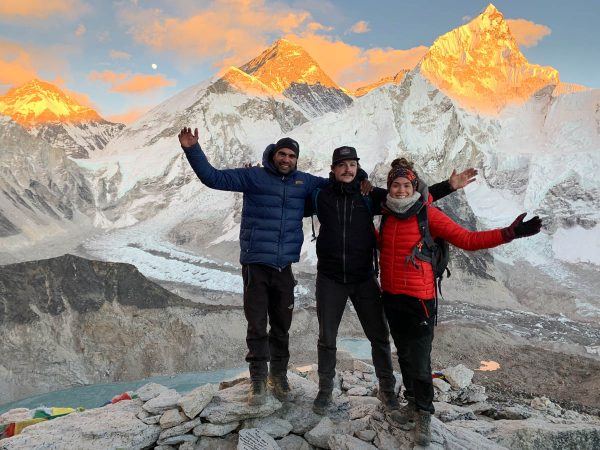
Everest Base Camp Trek
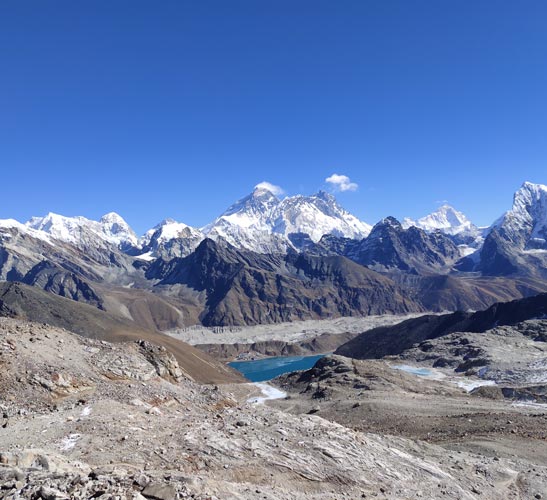
Gokyo and Renjo La Pass Trek
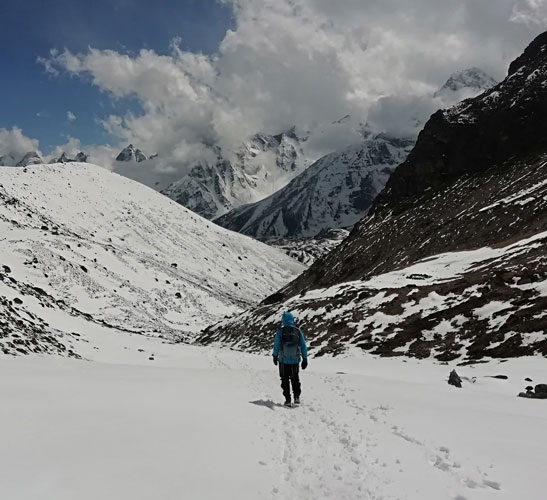
Everest High Passes and Island Peak
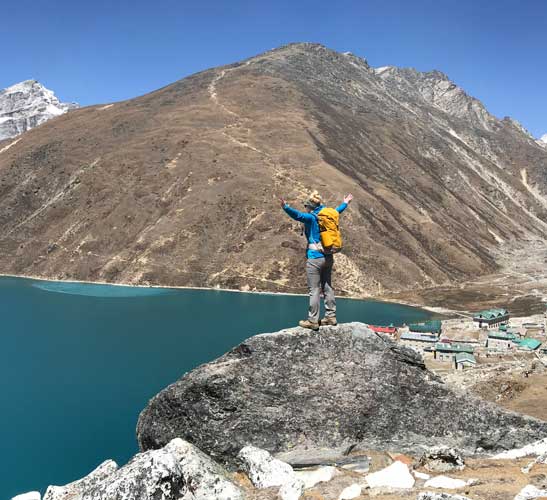
Gokyo to Everest Base Camp Trek
Speak to an expert.
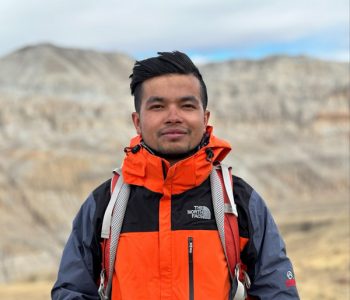
- Availability
Make An Inquiry for

Classic EBC Trek
- EBC + Gokyo Trek
- Jiri to EBC
- 3 Passes Trek to EBC
- Island Peak and EBC
- Acclimatisation
- Packing List
Get a Trek Quote
Three passes trek to everest base camp .
This guide covers the clockwise variation of the Three Passes Trek circuit by providing a detailed itinerary, route maps as well as answering questions on cost, packing, best times to trek and more.
The Three Passes Trek to Everest Base Camp is arguably the most complete trek in Nepal as it covers most of the Everest region on its circular route. The trek is more challenging than the classic Everest Base Camp Trek and its other variations as it involves traversing the three high passes that lend the trek its name – Renjo La, Cho La and Kongma La – each over 5,000m.
The trek begins in the popular starting point of Lukla before heading north along the classic trek to Namche Bazaar. Here, the route veers west as it splits from the main trek and heads up the Dudh Koshi valley, where you will encounter the first of the Three Passes – Renjo La (5,370m). After reaching the high point, the trail descends to the idyllic Gokyo Lakes and further on to the village of Gokyo .
The route then turns east as you make your way to Everest Base Camp by crossing the second pass called Cho La Pass (5,420m). After the second pass you will have the opportunity to explore the intricacies of Everest Base Camp life as well as soaking up some of the best views of Everest and the surrounding peaks when you climb the iconic viewpoint of Kala Patthar .
The inwards leg of the trek involves traversing the final of the Three Passes – Kongma La Pass (5,545m) – to join up with the classic Everest Base Camp Trek route that will take you down to Lukla, where the trek ends.
We do not sell tours, we simply provide impartial advice . If you would like an exact quote from our recommended tour operator click Get a Quote.
[adinserter block="2"]
Three Passes Trek
Regional map.
The Three Passes Trek is situated in the Everest or Khumbu region of Nepal as indicated by the orange block on the map below. Your journey will begin with a flight into the international airport in Kathmandu, the capital city, followed by a domestic flight to Lukla where the actual trekking begins.

Instead of flying to Lukla – an experience itself – you can trek the Jiri to Everest Base Camp variation . This involves taking a bus from Kathmandu to Jiri where you trek through the Solu Khumbu Valley up to Lukla before re-joining the main trek. This variation can be used for any trek that starts in Lukla, but will add at least 6 days onto the trek.
[adinserter block="3"]
Trekking Map
This simplified map below shows the Three Passes Circuit and the major towns and villages it goes through. Both the clockwise and anticlockwise variations of the trek start with the 2-day trek to Namche Bazaar where you will spend a day exploring to acclimatise to the high altitude .
The clockwise variation, detailed in this guide, follows the route north-west through the Dudh Koshi valley and the village of Thame before reaching the first pass – Renjo La. You will pass through Gokyo as you move east towards the second pass of Cho La, which takes you to the town of Lobuche. From Lobuche you will trek north to Gorak Shep – your base while you visit Everest Base Camp and Kala Patthar viewpoint.
The trek back to Lukla crosses the third and final pass of Kongma La, reaching Chhukung before joining up with the classic route back to Lukla. The last few days of the trek involve the relatively easy descent back to Lukla where your flight will be waiting to take you back to Kathmandu.
[adinserter block="4"]
Recommended Guidebooks
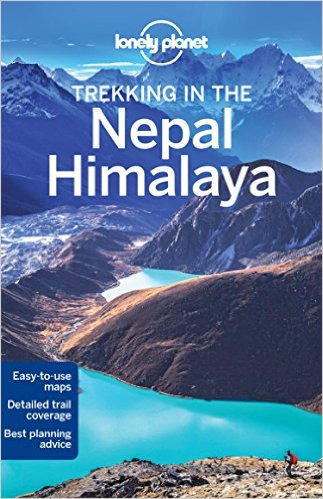
The Three Passes Trek is quite challenging as it involves traversing very high passes over 19 days of trekking. For this reason, we do not recommend trekking solo or without a guide who will have extensive knowledge and experience of trekking in the region.
A good guide book with a map, however, can be very useful when wanting to learn more about the area or when searching activities to do on your rest or acclimatization days.
The Lonely Planet Trekking in Nepal Himalaya guide is a regularly updated and informative guide that will include maps and sightseeing opportunities for a variety of treks in the region.
In terms of a map we recommend Nepa Maps – Three Passes and Everest Region map.
Detailed Itinerary
As with all treks, your journey to trek the Three Passes will start with an international flight into Kathmandu. A short flight to Lukla will precede the start of the trek that takes you through the Dudh Koshi valley before looping around through Gokyo and heading to Everest Base Camp. The inwards leg will take you east over your final pass and back to Lukla.
Most tour operators will list the Three Passes Trek as an 18/19-day trek. Of these days, usually 15 will be spent trekking with a further 1 or 2 acclimatization days, meaning 14 days of actual trekking can be expected.
Day 1: Arrive in Kathmandu
Arrive in the capital of Kathmandu after what is sure to be a long flight from home. Make your way to the hotel where you can relax for a bit before setting out to explore some of the vibrant city.
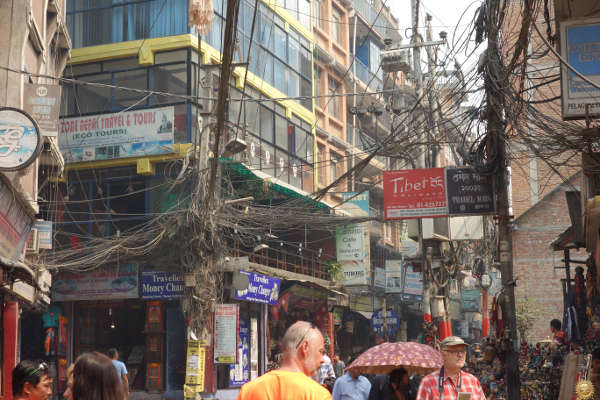
Vibrant streets of Thamel, Kathmandu
Day 2: Fly from Kathmandu to Lukla. Trek to Pkadking
An early morning flight will take you to Lukla, the starting point of the trek. Despite being only 35 minutes, the flight is a memorable one! Try to sit on the right-hand side of the plane for the best views of Everest as you approach Lukla.
The trek starts with fairly short descent to Phadking, where you will pass stone walls decorated with prayer inscriptions – called Mani in the local language. You will spend the night in Phadking.
Day 3: Trek to Namche Bazaar
The trek to Namche Bazaar will see you enter the Sagarmatha National Park , a UNESCO World Heritage Site. The village of Namche Bazaar is the central trading post of the region and is always bustling with life.
Day 4: Acclimatisation Day
Day 4 is an acclimatisation day spent in Namche Bazaar. Explore the village, stock up on some much-needed snacks for the trek ahead and be sure to check out the bakery – one of the best! The market on a Saturday is also a major attraction.
Day 5: Namche to Thame
The trail now splits from the popular base camp route and heads north-west through the small Sherpa village of Thamo before reaching Thame, where you will be staying the night. Take some time to learn a bit about the local traditions and their intrinsic connection with the mountain on which you are standing.
Day 6: Thame to Lumde
4-5 hours of trekking will see you cross the Bhote Koshi river before heading up the valley to Lumde. As you start to gain altitude you should get some great views of the snow-capped peaks in the region.
Day 7: Lumde over Renjo La to Gokyo
Today you will encounter your first of the Three Passes – Renjo La. The route starts off easy but will soon turn into a hard day of hiking as you near the end of the ascent of Renjo La. Try to think of the magnificent views you will get at the top to motivate you!
After the pass, you will descend to the third of the Gokyo Lakes and then trek onto the village of Gokyo for the night. After some rest you can even climb up the ridge to get some amazing views of the lakes, the highest freshwater lake system in the world.
[adinserter block="5"]
Day 8: Gokyo Ri (Acclimatisation Day)
Today you climb your first peak Gokyo Ri for fabulous views of Cho Oyu. You will do this climb early and then have the rest of the day to rest.
Day 9: Gokyo to Thaknak
Cross the Ngozumpa Glacier – the largest glacier in Nepal – over the course of an easy day’s trekking. Once again, keep your camera close as you trek through this beautiful part of Nepal!
You will reach Thaknak where you will go on a small acclimatization hike before lodging for the night.
Day 10: Over Cho La to Zungla
Often considered the hardest day of the trek, today involves traversing the second pass of Cho La. At over 5,300m, reaching the top will require some effort.
You will spot the famous prayer flags as you near the top of the pass, after which you descend over the other side of the pass to reach Zungla.
Day 11: Zungla to Gorak Shep
Start the day with an easy downhill portion to reach Lobuche, one of the major stops on the classic Everest Base Camp Trek. Join up with the crowds of trekkers as you make your way to Gorak Shep.
You will be afforded great views of the famous Khumbu Glacier as well as the peaks of Everest, Lhotse and Nuptse. Spend the night in the busy Gorak Shep.
Day 12: Gorak Shep to EBC and back
A short trek following the ridge of the Khumbu Glacier will take you to the Everest Base Camp. Make the most of your time here, as trekking groups are not typically allowed to stay overnight at the base camp.
Feel the buzz and excitement of the place, packed with potential future summiteers of Everest! Descend later that day down the same ridge back to Gorak Shep for some much-earned rest and sleep.
Day 13: Kala Patthar hike and then onto Lobuche
An early morning start is needed to summit the trekking peak of Kala Patthar – the iconic viewpoint of Everest. After snapping some pics, head back to Gorak Shep for a quick meal before descending further to Lobuche for the night.

View of Everest, EBC and Khumbu Glacier from Kala Pattar
Day 14: Kongma La Pass and onto Chukkung
You leave the classic base camp route today as you head east through the Khumbu Glacier to reach the third and final pass of the trip – Kongma La Pass. At 4,700m the pass is the highest of the three and lacks any shops or tea houses along the way.
After a tiring ascent to the top, descend into the Chukkung Valley and eventually to the village of Chukkung where you will stay in the lodge overnight.
Day 15: Chukkung Ri and then to Dingboche
Today you will climb Chukkung Ri (5,550m) and trek to Dingboche (4,410m)This peak is the hardest of the three you can attempt on this treks and involves some easy scrambling near the summit. The views from the top down the Khumbu Valley are superb. You descend to Dingboche where you will stay in a lodge overnight
Day 16: Dingboche to Namche Bazaar
A downhill trekking day will take you through the verdant fields and rhododendron covered hillside on your way to Namche Bazaar. Pass through the village of Khumjung where you can eat lunch before completing the descent to Namche Bazaar where you will stay overnight.
Day 17: Namche to Phakding
You continue through Namche Bazaar, descend Namche Hill and cross the Dudh Koshi. You are now sauntering back along familiar paths to Phakding. Overnight lodge.
Day 18: Phakding to Lukla
The last day of trekking will take you through some lovely pine scented forests before reaching Lukla where a cold drink and a hot meal await you!
Day 19: Fly back from Lukla to Kathmandu
Weather permitting, catch the morning flight back to Kathmandu to end off what is sure to be the trip of a lifetime.
Day 20: Depart Nepal
After your last night in Nepal, make your way to the airport to hop onto your flight back home, where you can tell all your friends and family about the time you had!
Altitude Profile
The altitude chart below shows the typical progression of the Three Passes Hike through the major stopping points along the way. The three spikes of the passes are clearly visible along with the spike of Kala Patthar – the iconic viewpoint.
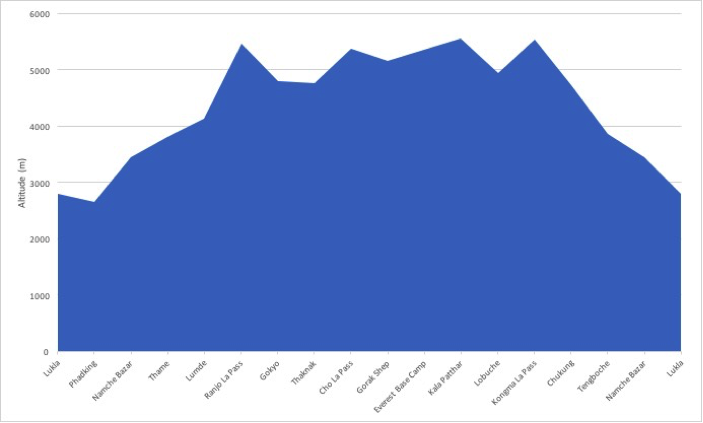
The ascent profile of this trek is slightly harder than the classic Everest Base Camp trek because it involves rapid ascents of the passes.
Three Passes Trek FAQ
How much does the three passes trek cost.
Tour operators will charge in the region of £1,200 to £2,500 for a guided Three Passes Trek. We definitely recommend using a tour operator for a trek of this difficulty and length – preferably a western tour operator whose guides and equipment will be of a higher standard.
The cost will include all board and lodging for the 18 days, all domestic travel and domestic flights, meals, shared equipment and knowledgeable guides. For a detailed breakdown of costs on the classic Everest Base Camp Trek, read our article here .
When is the best time to trek the Three Passes?
As with all treks in the Everest region, it is advisable to avoid the winter months as well as the peak summer months during the monsoon season. The shoulder months of February-May and September-October provide the most stable and dry weather conditions for trekking.
Our detailed article on the best time to trek in the Everest region will give a much more in-depth analysis of the conditions faced in different months.
How difficult is the trek?
The Three Passes Trek is considerably harder than the classic Everest Base Camp Trek so we recommend you have a good fitness level before embarking. Ascending the high passes involves long days of strenuous trekking that would not be encountered on the classic base camp trek and other variations.
6/7 hours of trekking per day is to be expected and altitudes of up to 5,500m are reached on the trek. That being said, the trek is still very popular among people wanting a bit more of a challenge. Read our training article to get an idea of how much you should prepare for a trek in Nepal.
Will I get altitude sickness?
Despite crossing some very high passes, the trek has been designed to follow the principle of trek high, sleep low. That means that you will not be spending extended periods of time at altitudes above 5,000m. The itinerary also has acclimatisation days as well as nights spent at lower altitudes to help the acclimatisation progress. If you follow the guide you should not have a problem.
That being said, altitude sickness can affect anyone regardless of age or level of fitness so we recommend doing some preparation reading. Our detailed article on altitude sickness and acclimatisation is a good starting point.
What gear should I pack for the Three Passes Trek?
The packing list for a trek of this length can look quite long! For this reason, we have dedicated an article to help you tackle the challenge that is packing. In our Everest Base Camp Trek packing list we provide list of clothing and equipment that you should bring, as well as some brands that we recommend based on our experience of using them.
What insurance do I need?
The short answer is yes. Trekking in Nepal at high altitudes comes along with various risks that are not covered by typical travel insurance. We recommend taking out insurance that covers trekking to altitudes up to 6,000m as well as medical evacuation from the mountain.
We have a detailed article to help to find the best policy that will suit your needs. Alternatively, use the quote calculator below from our recommended partner, World Nomads. They offer insurance that covers guided hikes up to 6000m and include a premium for Helicopter Evacuation in Nepal.
Route Variations
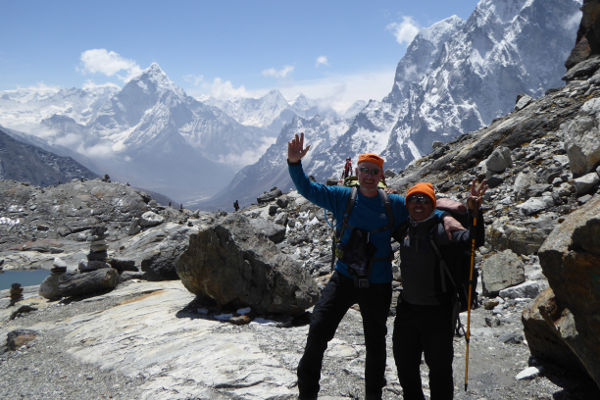
One of the more popular variations of the Everest Base Camp Trek , the Gokyo Lakes Trek, also starts at Lukla and follows the classic base camp trek to Namche Bazar where it forks north-west.
The trek proceeds through the towns of Dole and Machhermo before reaching the stunning Gokyo Lakes. From there you ascend to the peak of Gokyo Ri in the north, before traversing Cho La Pass and re-joining the classic trek at Lobuche.
The detour adds 2/3 days onto the trek but provides the wonderful opportunity to summit a peak while also avoiding some of the busier parts of the trek.
Gokyo Lakes Trek
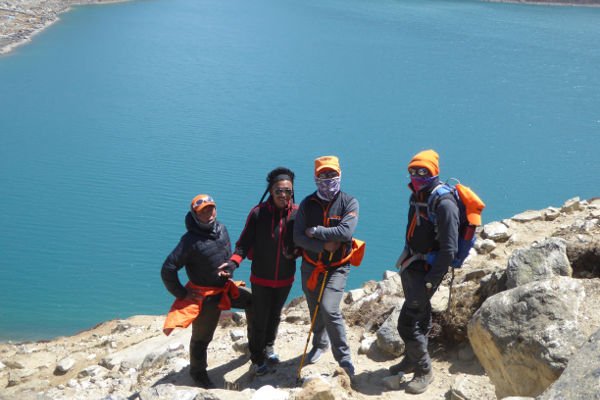
One of the more popular variations of the Everest Base Camp Trek, the Gokyo Lakes Trek, also starts at Lukla and follows the classic base camp trek to Namche Bazar where it forks north-west.
Jiri to Everest Base Camp

This variation of the classic trek offers an alternative to flying into to Lukla from Kathmandu to start the trek. The Jiri variation starts with an 8-hour bus ride from Kathmandu to Jiri, where the trek begins.
The variation adds an extra 5/6 days onto the trip as you trek through the Solu-Khumbu region and make your way past Lukla, where the trek then follows the same route as the classic Everest Base Camp Trek.
It involves a scenic, yet very long, bus ride as well as a lot more exposure to the Tibetan and Sherpa cultures. Expect to trek through more forests and streams as you start at the relatively low altitude of 1,800m and work your way up to Lukla and beyond.
Island Peak Climb

The variation trek that involves summiting Island Peak is significantly harder than the classic Everest Base Camp Trek. The climb to the peak is somewhat technical although and requires basic knowledge of using crampons and ice axes. Standing at just under 6,200m, however, altitude can be the real challenge.
Most climbers of Island Peak use the traditional base camp trek as a means of acclimatising before heading to the Island Peak Base Camp via Dingboche on the main trail, or by traversing the Chongma La pass. Summiting from the base camp typically takes two days and the whole variation will add around 4 days onto the classic trek.
Mark Whitman
Hi, I'm Mark! Welcome to EBC Trek Guide - the Web's No.1 Trekking Guide to Everest Base Camp. I have trekked all over Nepal, but the Everest region remains my favourite. I hope you find all the answers you are looking for on this site. If you have any questions don't hesitate to drop a comment below! Happy Trekking!
Leave a Reply
Your email address will not be published. Required fields are marked
Thank you. How slippery or rocky is the terrain on cho la pass? I don’t feel comfortable boulder hopping or walking on slippery terrain. You can train for uphill or distances but being able to balance on icy or scree surfaces is something else. We are looking at going in october . Any comments would be most welcome.
Hi Brigitte, the Cho La Pass consists of mix terrain that can vary quite considerably depending on prevailing weather conditions during the week you go. In general through you can expect mixed rock / scree terrain with areas that can be a little slippery with black / blue ice. Careful footing throughout is important. Show cover is quite likely too so it is worth taking basic yak tracks just in case you need additional grip. Hope this helps!
Is the path traveled and visible? Are there cairns, that Point the pass? Are there some kind of signs along the path? Is it easy to get accommodation for the night? Thank you
Hi Francisco, the three passes trek does follow a well defined route but it is not very well signposted. I would recommended taking a guide and / or getting a detailed map of the region. Accommodation throughout the route is not a problem, there are many small villages on the route and all have teahouse accommodation for trekkers. All the best!
What do you do for food along the route? The 3 peak pass in particular. Do you buy food for the day at every tea house? Thanks
Hi Frank, there are lots of teahouses along the Three Passes trek. In terms of lunch you can usually find a teahouse to stop at half way through your daily trek, or take a snack with you and only stop for dinner.
Thanks for the reply Mark!
Thanks for the useful information. Is this trek possible late December-early January? I did ACC last year late Dec-early Jan (including Tilicho), and it was wonderful, although desperately cold at higher altitudes. I assume this trek is colder as I would spend more time at higher elevation. I also appreciated that although less crowded that time of the year, there was good company in the higher teahouses and passes. Although I have no problem trekking alone, I would not feel completely comfortable spending days around 5000m completely alone. So my question would be, is this trek less crowded generally and colder than Annapurna Circuit?
Hi Daniel, I would say this trek will be colder than the Annapurna Circuit in Dec/Jan as you spend a lot more time at high altitude. The passes are also prone to closing in the winter if the weather is bad and there has been a lot of snow fall. I would definitely recommend taking a guide if you plan to trek the three passes.
I am planning for three pass trek in the first week of may. I have 15 days Itinerary. Is it possible to get it done including island peak. I am fit and I have plan to walk 9 hours per day. Plz let me know.
Thanks & Regards, Gopal
Hi Gopal, it’s possible to complete the 3 passes trek in 15 days, but the risk of altitude sickness (unless you are pre-acclimatised) is pretty high. Adding in Island Peak in addition would be a big ask, but doable if you are super fit and deal with the altitude well on the passes trek.
Hello there. I’m planning on attempting the 3 passes trek November 20-Dec 9 of this year. Is there a reason that you suggest clockwise? Most of the other places I have seen are suggesting counterclockwise. Any info would be greatly appreciated. Thanks!
Hi Murphy, thanks for getting in touch. I have no strong preference for either format. The reason why I suggest the clockwise route is because this is the I followed when completing the 3 Passes. The counterclockwise is equally as valid though.
Hi Mark, I am thinking about doing the Three Passes Trek. I have done Kilimanjaro one year before and further I do sport (mostly running, climbing, cycling) 3-4 times a week. However, I have never trekked for 19 days at high altitude and I don’t do a lot of trekking in my free time. Neither do I live in a place where my body is accustomed to higher altitude. I wonder if this is a trek I could do? Thank you in advance for your thoughts.
Hi Elene, you definitely sound fit enough to complete the 3 Passes. The key is to pace yourself, build in enough acclimatisation days to get accustomed to the high altitude, and make sure to look after your health with a good diet throughout. If you completed Kilimanjaro, you can definitely do the Three Passes. All the best!
Hi Mark thanks for all your useful information. I’m hoping to complete the Three Passes soon. I have years of experience. When would you suggest is the earliest I can expect to safely complete it. Mid-February OK?
Hi Rick, mid Feb can still be quite snowy and the passes may be closed. If you can push your dates a little bit further out – to mid March – then the probability of closed passes reduces (obviously there are no guarantees though). All the best!
Get a quote from the best local trek operator in Nepal!
Discovering the Beauty of the Himalayas with the 3 Passes Trek in Nepal
Are you a thrill-seeker looking for your next adventure? Look no further than the 3 Passes Trek in Nepal.
This exhilarating trek will take you through some of the most breathtaking landscapes in the world, all while providing you with an opportunity to challenge yourself physically and mentally.
Introduction
The 3 Passes Trek in Nepal is a challenging trekking route that takes you through the heart of the Himalayas in Nepal. The trek is a circular route that starts and ends in Lukla, with the aim of crossing three high passes in the Khumbu region: Kongma La (5,535m), Cho La (5,420m) and Renjo La (5,360m). The trek takes around 20 days to complete and covers a distance of approximately 160 km.
Why to do the 3 Passes Trek In Nepal?
The 3 Passes Trek in Nepal is not for the faint of heart, but the rewards are well worth the effort. The trek offers a unique opportunity to experience the stunning beauty of the Himalayas up close, while challenging yourself physically and mentally. The trek is also a chance to immerse yourself in the rich culture of the Khumbu region and meet the friendly locals who call this rugged terrain home.
Highlights of the 3 Passes Trek
The 3 Passes Trek takes you through some of the most iconic landmarks in the Khumbu region. Here are some of the highlights of the trek:
- Everest Base Camp: The trek starts with a visit to the famous Everest Base Camp, where you can take in stunning views of the world’s highest peak.
- Gokyo Lakes: The trek takes you to the serene Gokyo Lakes, a chain of six glacial lakes that are considered sacred by the Sherpa people.
- Three high passes: The trek takes you over three high passes – Kongma La, Cho La and Renjo La, each of which offers stunning views of the surrounding Himalayan peaks.
- Kala Patthar: The trek takes you to Kala Patthar, a viewpoint that offers the best views of Mount Everest and the surrounding peaks.
Tips for a successful 3 Passes Trek
- Train well: The 3 Passes Trek is a challenging trek that requires a good level of fitness. Make sure to train well in advance, including cardio and strength training.
- Pack light: You will be carrying your own backpack during the trek, so it’s important to pack light. Only bring the essentials and leave unnecessary items behind.
- Acclimatize properly: Altitude sickness is a serious concern during the 3 Passes Trek. Take the time to acclimatize properly by ascending slowly and staying hydrated.
- Bring appropriate gear: Make sure to bring appropriate gear for the trek, including sturdy hiking boots, warm clothing, and a good quality sleeping bag.
The 3 Passes Trek in Nepal is an adventure of a lifetime that offers a chance to experience the raw beauty of the Himalayas. While the trek is challenging, the rewards are well worth the effort. From stunning views of Mount Everest to serene glacial lakes, the trek takes you through some of the most iconic landmarks in the Khumbu region. So, what are you waiting for? Pack your bags, put on your hiking boots, and get ready for an adventure of a lifetime! Explore our Trips – 35+ Years Of Mountaineering Excellence !

- Tours for Seniors
- Nepal Cultural Tour
- Everest Flight Tour
- Nepal Heli Tour
- Nepal Biking Tour
- Nepal River Rafting
- Spa Package in Kathmandu
- Everest Region
- Annapurna Region
- Manaslu Region
- Langtang Region
- Kanchenjunga Region
- Makalu Region
- Dolpo Region
- Nepal Yoga Retreat
- Nepal Climbing
- Nepal Jungle Safari
- Kathmandu Accommodation
- The Life and Legacy
- About Nepal Hiking
- Official Documents
- Vision Statement
- Responsible Travel
- Testimonials
- Tailor Made Holidays
- Become a Partner
- Terms & Conditions
- Privacy Policy
The 3 Passes Trek: Renjo La, Chola, and Kongma La – A Superior Alternative to the Traditional Everest Base Camp Trek
Estimated reading time: 5 minutes
The mighty Himalayas have been drawing adventurers and seekers worldwide for centuries. While the Everest Base Camp (EBC) trek is undoubtedly one of the most popular routes, those yearning for a more comprehensive and challenging experience often set their sights on the thrilling 3 Passes Trek, encompassing Renjo La, Chola, and Kongma La.
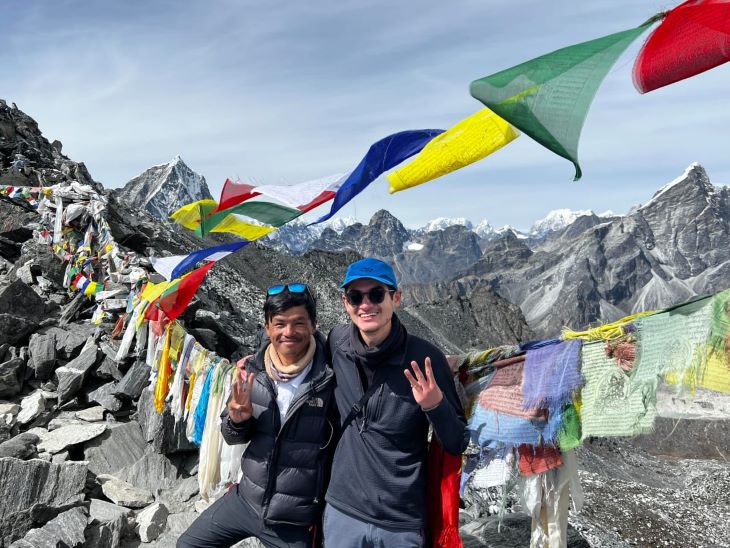
Why Opt for the 3 Passes Trek?
1. Off-the-Beaten Path: While EBC sees a heavy flow of trekkers each season, the 3 Passes Trek is less crowded, offering solitude and a closer communion with nature.
2. Diverse Landscape: Trekking through three high mountain passes not only provides stunning panoramic views but also introduces trekkers to a diverse range of ecosystems and terrains.
3. Challenge: With added altitude and distance, this trek is more demanding than the classic EBC route, making it a rewarding choice for those seeking an added layer of adventure.

A Brief Overview of the Three Passes
1. Renjo La (5,360m): Crossing this pass, you’re treated to a magnificent view of the Everest Range, Cho Oyu, and other majestic peaks. The descent from the pass takes you to the serene Gokyo Lakes and the village of Gokyo.
2. Cho La (5,420m): This pass requires a bit more technical skill, especially during the icy conditions of the pre-monsoon season. However, the view of Ama Dablam, Cholatse, and the shimmering Taboche Tsho Lake more than compensates for the challenge.
3. Kongma La (5,535m): The highest of the three passes, Kongma La offers dramatic views of Baruntse, Makalu, and a distant view of Kanchenjunga.
Highlights of the Trek

Preparing for the Trek
1. Physical Fitness: This trek is strenuous, so it’s essential to be in good shape. Incorporate cardio, strength training, and long walks or hikes in your preparation.
2. Acclimatization: Due to the high altitudes, there’s a risk of Acute Mountain Sickness (AMS). Ensure you have a flexible itinerary to allow for proper acclimatization.
3. Gear: Invest in high-quality trekking gear, including warm clothing, sturdy boots, and necessary equipment.
4. Guide and Porter: Considering the challenging nature of this trek, hiring a knowledgeable guide and porter can be immensely beneficial.
5. Permits: Like all treks in the Everest region, you’ll need the Sagarmatha National Park permit and the Khumbu Pasang Lhamu Rural Municipality permit.
When is the best time for the 3-pass trek?
The best time to embark on the 3 Passes Trek – Renjo La, Chola, and Kongma La – in the Everest region depends largely on what trekkers are seeking in terms of weather, trail conditions, and crowd density. However, generally, the most favoured times are during the pre-monsoon (spring) and post-monsoon (autumn) seasons.
Pre-Monsoon (Spring): March to May
- Weather: The temperatures are relatively moderate during this time, especially in the lower elevations. As you ascend, temperatures will drop, particularly during the night.
- Visibility: The visibility is usually clear in the mornings with occasional afternoon clouds.
- Flora: Spring is when rhododendrons and other alpine flowers bloom, adding vibrant colours to the trail.
- Crowds: This is the most popular time for trekking in the Everest region, so expect more fellow trekkers.
Post-Monsoon (Autumn): Late September to November
- Weather: Similar to spring, autumn offers moderate temperatures. However, it tends to be colder than spring, especially as it nears December.
- Visibility: Post-monsoon skies are crystal clear, offering some of the best mountain views.
- Flora: The lush greenery post-monsoon is a treat, though the rhododendrons aren’t blooming.
- Crowds: Autumn is the second most popular trekking season, but trails might be slightly less crowded than in spring.
Less Popular Times:

Conclusion:
For most trekkers, the best balance of favourable weather, good trail conditions, and excellent mountain visibility will be found in the spring and autumn. Regardless of the chosen period, it’s crucial to be well-prepared for variable conditions and possible challenges. Always check for current weather forecasts, possible trail obstructions, and local advice before setting out.
The 3 Passes Trek – Renjo La, Chola, and Kongma La – is a thrilling journey that takes you deep into the heart of the Khumbu region, offering a richer, more diverse experience than the traditional EBC trek. It’s a journey of physical endurance, but the rewards – the awe-inspiring vistas, the rich cultural immersion, and the sheer thrill of crossing high mountain passes – make every challenging step worth it.
Related Links
- Chola Pass and EBC Trek via Gokyo Lake
- Three Passes Trek
- Discovering Nepal’s Majestic Mountain Passes: A Trekker’s Paradise
- Trekking Routes In Nepal – A Complete List of Treks
Pay Safely With Us
The payment is encrypted and transmitted securely with an SSL protocol.
Get a Question?
Do not hesitate to give us a call. We are an expert team and we are happy to talk to you. +977 9851068290
Stay Updated with the Latest News and Exclusive Offers!
Proceed booking, already a member, don't have an account create one., or continue as guest.

How to Do the Everest Three Passes Trek Solo
This is possibly my favourite trek in the Himalayas. It’s 15 days of trekking through some of the tallest mountains of the world. It’s challenging and exhausting, but also one of the most rewarding hikes you’ll ever go on.
The Three Passes Trek is my favourite hike in the world. Stunning views, iconic sights (like the Khumbu glacier!), high altitude, comfortable tea houses, and so much culture all wrapped up into 17 days. This is going to be a pretty big post with everything you need to know about doing the Three Passes Trek solo, so before I jump into it, I’m going to give you a little table of contents. It’s a full three passes trek blog with loads of information about doing the 3 passes trek solo – this guide should have everything you need to know!
A Brief Summary of the Three Passes Trek

Not too many people know what this trek is! They know its a 3 pass trek, but that’s about it! I’m here to clarify.
The three passes trek is a two-week trip that follows the Everest Base Camp route before splitting off and taking you over three passes that give amazing views of the Himalayas and Mount Everest. It’s been dubbed one of the most beautiful treks in the world, and for good reason! While going on the Everest Base Camp route is nice because of its commercial status, the three passes trek takes you beyond that side of the region and show you even more of its beauty. The Gokyo Lakes trek is another popular trek in Sagarmatha National Park, and this takes you through the end point of that route.
Three Passes Trek in June?
The three passes can be a dangerous trek. You’ll only want to go when the weather is the best. The best months are November, December, and May. You want to avoid from June to September because it’ll be rainy and hazy, and flights to Lukla probably won’t operate. Furthermore, teahouses won’t be open. You also want to avoid from January to March, as it might be too snowy.
How hard is the Everest three passes trek?
You have to remember that this trek goes over three high passes. It’s definitely not easy, but it’s doable! There are some very technical paths over the passes, but if you’re fit and have mountain and altitude experience, you should be fine. That being said, I wouldn’t go alone – always make sure you’re going over a pass with other people! Everest three passes trekking is tougher than trekking just to base camp because of the tough terrain and high altitude over the three passes. This is NOT a trek for beginner hikers if you’re doing it alone.
Looking for hikes that are a little less intense? Everest Base Camp , the Annapurna Circuit, Annapurna Base Camp , Australian Base Camp , and Poon Hill are all stunning.
Three Passes Trek Itinerary

Fly to Lukla, walk to Phakding* | 3 hours | 2610m
*Alternatively, you can walk to Monjo, which is about 3 hours further, if you arrive early or are feeling up for it
Walk to Namche Bazaar | 6 hours | 3440m
Acclimatisation Day | A half day trek to Everest Viewpoint Hotel or up to Tenzing Norgay Statue
Walk to Tengboche | 4 hours | 3870m.
Walk to Dingboche | 5 hours | 4410m
Acclimatisation Day | Walk partly up Nagkartshang Peak
Walk to Chukkung | 3 hours | 4730m
Acclimatisation Day | Walk to Chukkung Ri
*Some choose to climb Island Peak from here, though you need to have a guide and proper training for that summit.*
Walk to Lobuche via Kongma La Pass (5535m)| 10 hours | 4940m
*From here, you can split from the Three Passes trek and go on to Everest Base Camp / Kala Patthar following THIS itinerary*
Walk to Dzongla | 3 hours | 4200m
Walk to Gokyo via Cho La Pass (5420m) | 10 hours | 4750 m
Rest Day | Go up Gokyo Ri or around the lakes
Walk to Lungde via Renjo La Pass (5340m) | 6 hours | 4380m
Walk to Thame | 3 hours | 3800m
Walk to Namche Bazar | 3 hours | 3440m
Walk to Lukla | 7 hours | 2850m
Budget for the Three Passes Trek or EBC

I’ve written a full budget breakdown of the Everest Base Camp trek HERE . The budget accounts for all necessary permits and your daily budget and includes a section on how much getting in and out of Lukla will cost. I would stick to this budget breakdown as a guide for the three passes trek as well.
Before You Go
You’ll need to get a TIMS card to do this trek. You can get a TIMS card in Kathmandu or Pokhara (directions here ), or on the trail in Lukla.
The trek starts in Lukla, a small mountain town. There are plenty of different ways to get to Lukla, which I’ve outlined below!
How to Get In/Out of Lukla

From Kathmandu, you’ll need to get up to Lukla for the start of the trek. You can do this many ways.
The most popular method of getting to Lukla is by aeroplane. Flights to Lukla only operate in good weather conditions (and while inconvenient, this is a good thing because the runway is VERY short), and they’ll only fly out of Kathmandu if they are sure to be able to do a round trip flight. There are often delays and cancellations, so make sure you have a couple days to spare before flights in and out of Kathmandu. You can book flight tickets online, but I recommend booking from a tour office in Kathmandu or emailing your hotel before you arrive to organise your tickets. Buy round trip! You can always cancel for a 10% (of the ticket price) fee, or if your flight is cancelled due to weather, you are entitled to a full refund of that ticket.
Helicopters
When flights are cancelled or delayed for days at a time, or for those who are on tight schedules, helicopters are the way to go. Helicopter flights are significantly cheaper going INTO Lukla than they are going OUT of Lukla. Helicopter prices depend on the season and demand. I’ve heard of people paying as little as $150 USD to fly into Lukla and as much as $500 USD to fly out. When there is a backlog of people in Lukla due to cancelled flights, helicopters are in high demand and the local “Lukla mafia” will charge as much as they please for a seat on a heli back to Kathmandu. It is standard to pay about $250 for a helicopter flight back to Kathmandu, but if there are many people who want to fly out of Lukla during peak season, I’d expect to pay $500.
That being said, if you are stuck in Lukla, you can take a helicopter to Phaplu, then a 10-hour jeep or bus ride . The helicopter will cost about $200 USD, and the jeep will cost 13,000r to 20,000r depending on the demand. I’ll go into more detail about this option in the last section.
Finally, you can walk in and out. It takes about 4 days of walking to get to Jiri or Salleri. It is hot and there is a lot of up and down, but you escape the touristy part of the trek and I’ve heard good things about this (if you like walking!).
Essential Items for Trekking in Nepal

After trekking in the Everest region multiple times, there are a few things that I’ve come to really appreciate bringing up into the mountains with me.
- • Babywipes
- • Hand Sanitizer
- • Sunscreen
- • Extra Pair of Socks
- • Trekking poles
- • Sleeping Bag (some people think relying on teahouse blankets is enough- its not!)
- • TRAVEL INSURANCE – this is very important in case you need to be helicopter evacuated out. Make sure your insurance covers this!
- • Some people like to take Diamox for altitude sickness. When I did EBC, I felt the altitude at Gorak Shep. On this trek, I didn’t feel the effects of altitude as much (excluding going over Kongma La).
Day By Day Overview / What to Expect / My Recommendations / Three Passes Trek Blog
While you can book flights to Lukla at around 8 or 9am, I’d go for the earliest flight, as those are the most likely to take off.
Our flight was early, and we got to Lukla no problem! In Lukla, you have to buy your trekking ticket. Just walk down the main street and you’ll be stopped to buy one. From there, head onto the trail! The walk to Phakding is downhill and pretty easy. Remember to walk left around the stupas and mani stones. We arrived in Phakding at about 11am, so we kept going onto Monjo, which is at a slightly higher altitude. There was more uphill on this section, but nothing so steep it was memorable.
Recommended teahouse: Mount Kailash in Monjo
The day starts off nicely. You’ll have to stop to get a national park permit and for a ticket check, and then you start walking along the river. I personally find this bit absolutely stunning! There’s a beautiful view of two suspension bridges. You’ll eventually cross the higher one. After this viewpoint, it’s all uphill to Namche. About an hour and a half into the uphill section, you’ll come up to a public bathroom. From there, you can see Everest. This is also halfway up the uphill section. You can refill water here. Continue uphill, and eventually, you’ll get to another ticket check. At this point, you’re only about 20 minutes from Namche!

Namche Bazaar is the biggest village on the trek, and it feels like paradise! I love going to the Liquid Bar at 3pm for a movie. Ordering popcorn is a must. There’s a Himalayan Java right next to the Khumbu Lodge that offers free wifi and charging if you purchase something. If you’re feeling the need for a massage, someone who summitted Everest and tried ALL the massage places in Namche recommended the one inside the Khumbu Lodge.
Recommended teahouse: Khumbu Lodge. We splurged on a room with an electric blanket, charging, an attached bathroom (with a hot shower!), and a double bed for $25 USD.
The weather for us was poop. We wanted to walk up to the Everest Viewpoint Hotel, but since it was so cloudy, we were sure we wouldn’t get a view and only went about a third of the way up. Instead, we walked to the Visitor Center and Tenzing Norgay Statue, which is the acclimatisation walk I usually do anyway. I love the Visitor Center and highly recommend going! Note that it is open from 8am to 4pm Sundays to Friday, and that it is closed Saturday and public holidays.
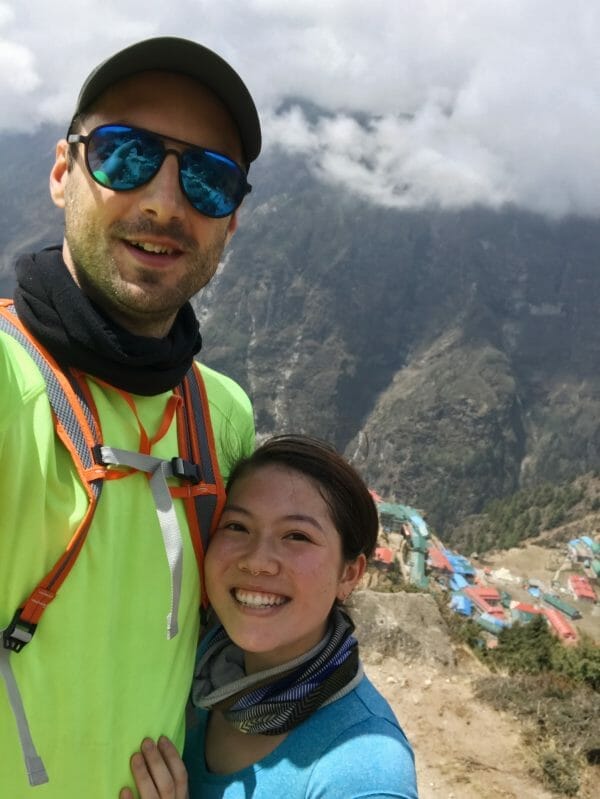
You’ll love the start of this day: it’s flat! And there are great views! Eventually, you’ll start going downhill. I’d stop at the river for a pot of tea or lunch, because after you cross the suspension bridge over the river, it’s a ticket check, then a lot of uphill! I always used to remember this bit as the WORST, but this time, I took it slow and steady, and it really wasn’t as bad as I remembered. Tengboche is absolutely beautiful. If you can, head into the monastery at 3pm for the prayer. You aren’t allowed to take photos.
Definitely go to the bakery to get a slice of apple crumble. It is necessary. And delicious.

Recommended teahouse: Tashi Delek
Our whole time in Nepal, the clouds had been really low and it was foggy, but this day, it cleared up! Tengboche is BEAUTIFUL on a clear day.

Your day will start with a downhill walk before it flattens out. The flat bit is full of blooming rhododendrons in March-May.
Once you hit the river, you’ll start heading uphill again. It’s a pretty bearable uphill hike to Dingboche. The land seems very vast and very barren here. It’s awesome.
In Dingboche, the first lodge you’ll hit is the Snowlion lodge. It’s attached to a French Bakery. I love this lodge and I love the chocolate truffles (more like a dense fudgey cake) at the bakery.
This is an acclimatisation day! Just above the Snowlion lodge is a stupa. Walk up there, and then further up the hill. There will be a rest stop. You can either continue up or stop around here. On my trips to this region, I’ve acclimated by going all the way to the top, to the rest area, and somewhere in between. I honestly don’t think that the height of your acclimatisation hike makes a huge difference, just make sure to get a hike in.
If the weather is clear, the peak offers some stunning views, but if it’s cloudy, I wouldn’t bother.

The walk to Chukkung is a very gradual uphill. It’s quite windy in this valley. I really liked this day because there was a great view, a gentle hike, and only 3 hours of trekking! We stayed at the Khangri Resort. Their dal bhat is fabulous and Skye (the manager) is soooo lovely! Again, the views from Chukkung are beautiful.

Another acclimatisation day! Walk up to Chukkung Ri. This is a pretty steep trail with a couple false peaks. You think you’re almost there, you make it over the ridge of the hill, and bam. Another hill to climb. That being said, the views are worth it! Once you get to the prayer flags, the rest of the trip up to the summit is a little scramble-y. It was really cloudy and we didn’t feel safe on the loose rocks, so we didn’t actually get to the summit, but maybe 30 meters below. Just be mindful of where you step! On the way down, you’ll be proud of how far you walked- it’s so much longer than it seems!

I would bring trekking poles with you- it’s a steep climb and on the way down, your knees will want that extra support!
Day 9: Kongma La
The day of the first pass! We didn’t really know what to expect regarding how long this pass would take… Lonely Planet said it would take 7 hours, online resources said 6, our guesthouse owner in Chukkung said 9. It took 10. This is a LONG day, guys.
You start by walking down towards Dingboche on the side of a hill. It’s a pretty gradual uphill. The walk isn’t too bad at the start, but it gets a lot steeper. Once you see the big frozen lake, it’ll flatten out. Even though it’s flatter, I found this section REALLY tough. I started seeing double, feeling nauseous, and feeling faint. For a moment, I thought I’d have to be med-evac’d out, but I took a breather and then continued when I was feeling better. It’s a steep scramble up to the pass. The view from the pass is amazing if you look behind you. Looking forwards, towards Lobuche, isn’t as impressive, so make sure to look back!

We spent about an hour at the top of the pass, but I would recommend instead having a quick snack and water and continuing to move. Though the uphill part of the pass is over, the hard part isn’t!

Going down, your walking on scree. It’s very slippery, so watch your step! There also isn’t a distinct trail; you’ll look out for rock cairns to guide you. After a couple hours of this, you’ll reach a valley. Unfortunately, you go down the valley only to go back up it. The uphill isn’t too bad, and it’s pretty short.
Once you get back to the top of the valley, you’ll meet the Khumbu Glacier. You have to cross this to get to any lodges. Again, there isn’t a distinct trail, so follow the rock cairns. Lonely Planet describes crossing this glacier as “a final sucker punch,” and I couldn’t agree more. It’s a LOT of up and down. Also, if you go in late May, the glacier will be melting from under you and rocks will be falling around you. It can feel a bit dicey. If you’re a solo trekker, DEFINITELY try to link up with others for this bit.
After you cross the glacier, you just have to walk up one last steep uphill bit, then go downhill, and Lobuche is there!
If you are skipping Everest Base Camp, go to Dzongla. We skipped EBC for two reasons. 1) I’ve already been there and the views are not that incredible compared to the passes. EBC is mainly something you visit to tick off the bucket list. 2) We were really effing tired.
The walk to Dzongla is amazing. It’s a gentle downhill, then a gentle uphill, and then you walk along a side of a mountain, so it’s flat! It takes 3-4 hours at a leisurely pace.

Recommended teahouse: Green Valley Lodge
If you are going to Everest Base Camp, read this post .
Day 11: Cho La
We woke up at about 5, had breakfast at 5:30, and were off by 6! I was honestly dreading another pass… Kongma La nearly killed me. But don’t worry if you’re feeling the same- Cho La is MUCH better.
It’s a gentle uphill for about an hour or two, and then you’re climbing up big boulders. Once you make it up the big boulders, you’ll see a string of prayer flags. There’s a great view from here, but it isn’t the pass.

Keep going up the gentle uphill. You’ll have to cross some very icy paths, which is technically challenging. If you have microspikes, I’d put them on for this section.
You’ll walk up a frozen glacier, then up maybe 10 meters of rocks, and you’ll have made it to Cho La!

The way down is steep and rocky. It was a little icy but not too bad. You’ll be walking on loads of boulders, and again, the path isn’t so clear, so follow the cairns. Once you make it through the boulders, you’ll have to walk up and down to a valley, from which it’s all downhill. You’ll go down the valley to Thangnag, a small town. You can either stop here or continue onto Gokyo. I recommend continuing on – Gokyo is THAT much more amazing when you’ve had a really tough day.
If you’re continuing onto Gokyo, you’ll have another glacier to cross. This one isn’t as tough as the Khumbu Glacier, navigation wise. Once you make it over the glacier, another uphill and downhill, and you’re in Gokyo!
I HIGHLY recommend staying at Thanka Inn. It’s a new hotel (only around 2 months old!) and it’s absolutely BEAUTIFUL. It’s right on the lakefront and the rooms are amazing. They have real duvets (a LUXURY to not have to use a sleeping bag), double glazed windows, and delicious food. I couldn’t recommend this place more.

This is the day most people go up to Gokyo Ri. We decided not to because we were feeling a little sick. Phil ended up having a bad cold with fevers and chills, and I just had some stomach troubles. We walked around the lake, which was more than enough for us.
The lake is beautiful.
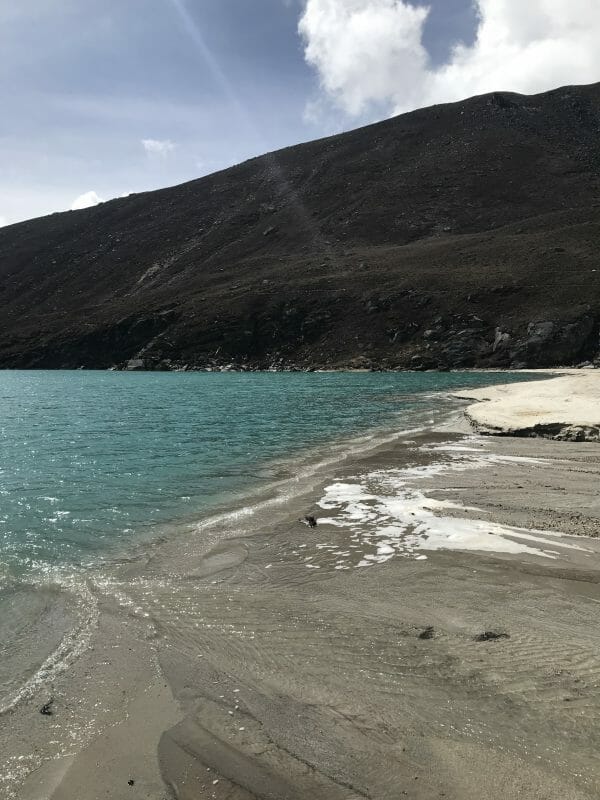
Day 13: Renjo La
The third pass- Renjo La! Follow the trail to Gokyo Ri, but instead of going up, continue straight. There is a sign that will make it easy to follow. It’s a very gradual uphill for about an hour, and then a steep uphill section all the way to the top. This is the easiest pass. That being said, I still found it quite tough- I think my body was just exhausted!

Luckily, once you make it to the top, it isn’t too bad. There was a LOT of ice when we were up there, so we had to be VERY careful for about 30 minutes on the way down. It was windy and cold, and the fog came out, so we couldn’t see very far in front of us. Total whiteout. If the weather is good, this part should be no problem.

It’s a steep downhill section, and then the trail flattens out. After about an hour and a half of walking on flat(ish) ground (HEAVEN), you’ll start going downhill again. It isn’t rocky so it’s easy to go down quickly. After losing 1000m from the pass, you’ll get to Lungdhen. There are a couple teahouses here, but we chose to just stop for tea, then continue walking down. 30 minutes below Lungdhen is another town called Marulung, but we continued down another 3 hours to Thame. The road is pretty flat and the scenery is absolutely beautiful, so it’s a nice day. It’s one of my favourite days on the trek. You get away from the commercial EBC route and get to see how people actually live.
You’ll be super excited to get going this day, because you’re heading to NAMCHE BAZAR! Namche feels like paradise after 2 weeks of trekking. There is a LOT of up and down the whole way to Namche, but with lower altitude is a lot more oxygen, so it doesn’t feel too bad.
It does feel quite warm compared to what you’ll be used to though, so wear short sleeves this day! You’ll make it to Namche in time for a movie at the Liquid Bar. We planned on doing that, but we accidentally fell asleep for about half the day. Our bodies were tired.
The trek down to Lukla is a lot tougher than you’ll have remembered. It’s steep downhill for the first hour or so, then lots of uphill and downhill, then just uphill. Again, it’ll feel really warm. Load up on sunscreen- I got SUPER burnt this day.
While the trek is pretty tiring, you’ll feel really motivated to make it to Lukla because it’ll mean you’re on your way to Kathmandu. Even if people dislike Kathmandu, after a trek in the Himalayas, you’ll crave comforts in Kathmandu you didn’t even know you had!
And that’s it! The Three Passes trek. Have any more questions? Don’t hesitate to leave a comment or email me.
Like this post? Pin it!

Related posts
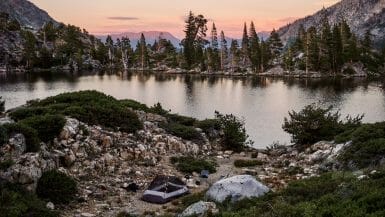
Everything You Need to Know About Backpacking the Grass Lake Trail in Desolation Wilderness
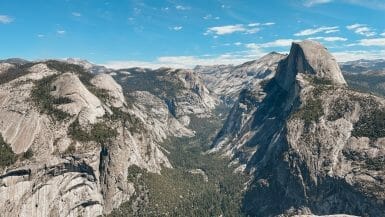
Glacier Point To Panorama Point Trail Guide: Everything You Need To Know About This Day Hike
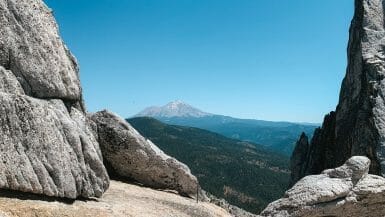
Hiking the Castle Dome Trail in Castle Crags State Park: Ultimate Trail Guide
Leave a reply cancel reply.
Your email address will not be published. Required fields are marked *
66 comments
This all looks amaaaaazing! Your photos are truly stunning! What an epic adventure!!
It was an incredible adventure! I couldn’t recommend it enough!
So jealous! This looks incredible!
We still need to go trekking together?!?!?!?
Hello. This looks amazing! I plan to do this trek next year. I have a question regarding permits: all the permits can be bought in Lukla? It is not necessary to go to Kathmandu first to get permits? Is it possible to exchange money in Lukla/Naamche Bazar as well? If not necessary I would like to avoid visit to Kathmandu and continue directly to Luka (to save one or two days and money in the process). I also have a question regarding shoes: for the last two years I have been trekking only in trail running shoes (adidas terrex), no boots. Would you say that boots are absolutely necessary? Was there snow (deep snow) in the passes in the spring?
All permits are possible to get in Lukla, however the only flights to Lukla go from Kathmandu. What month will you be going? There’s usually some snow, but not deep! I’d say micro spikes are a must!
Thank you for answer. I will be going in the middle of April-beginning of May. I know I have to go to Kathmandu airport, but after arrival I would like to continue directly to Lukla without visiting the city.
What time does your flight arrive? The flights to Lukla are all in the morning. Try to get the earliest one, as that has the highest chance of flying!
The plane should arrive 9:40 am. I hoped there would be flights around noon, but if all the flights are in the morning then I will have to stay in Kathmandu…
Hi Anya, Could you tell me what dates you did this trek,please? We are leaving in 4 weeks for Gokyo and plan to go over the Cho La Pass but in reverse. Did you meet many people coming the other way? It will be our third trek to the Khumbu. Louise
Hi! I did this in late may! We met loads of people going the other way- you just have to be more careful of acclimating! Have a BLAST! Xx
Fantastic post. It’s on my bucket list. I didn’t realise you could get flights into Lukla for as low as $150. I have a fear of flying and much prefer that idea to the teeny plane! Will look into it 🙂
Yes I loved helicoptering into Lukla and I think it would be a great way to make it to Lukla if you’re afraid of flying! But also, the pilots in Nepal that fly into and out of Lukla are some of the most skilled 🙂
Hey there Anya! Awesome post!! Sounds like yall had a fabulous time. May I ask for your advice? I want to do either EBC or the three passes trek solo in late march. I would much rather prefer the three passes trek as it seems far superior to EBC (as your post entails!) I am wondering, do you think I could find guides to take me across just the passes and not have them the whole way? I much rather prefer to hike on my own but am worried about the technical hiking that you spoke of with the glacier and Kongma pass. Would it be advisable for a semi experienced hiker (I am 24F) to go solo? Or should I do EBC? Thanks so much and happy trekking!!
I don’t think you need a guide IF you meet up with other people doing the same passes! If you can’t find anybody doing the Three Passes the same time you are, I’d definitely recommend hiring a guide, which you should be able to do in Dingboche or the towns right before the passes. The weather could be bad in March and if there’s a lot of snow, I’d do EBC. EBC is also an incredible hike and I loved it!!!
Hello, Thank you for your blog! How long are the distances without the internet access?
My son and partner are hiking the Three Passes Trek counterclockwise. We have not heard from them for 9 days.
Hi Claudia! Have you heard from them? Wifi can be spotty up along the passes, but you shouldn’t go more than a week without hearing from them unless they choose not to purchase wifi from their teahouses.
I am so glad I stumbled across your blog! We are planning to do the Three Passes trek but we won’t be starting until May 22. I realize this isn’t ideal. We are experienced in the mountains, but I am still a bit concerned. Any thoughts?
Great blog!
Thanks, Amy
I think you should be alright! I’d definitely go over Kongma La first, then Cho La, and then Renjo La with that timing. If you find Kongma La a little more slippy (and melted) than you like, I’d be careful over Cho La, as that’s the pass where there are crevasses. Definitely make sure other people are going over the passes the same days as you. I would give it a try, and if it feels too dicey, Everest Base Camp is a great backup. You could even hike down and go up to Gokyo if Cho La isn’t possible but Gokyo’s something you really want to see! 🙂
This is perfect & made me realize either a) I’m chicken or b) I’m never going to be prepared to do something like this. I’m glad you had an amazing time and got some awesome pictures!
Haha I guess it’s not for everyone, but there are loads of other amazing treks that are a little less scary in Nepal, too!
your blog more impressive how we start Everest Three pass trek.It very beautiful photos.Thanks for sharing best itinerary for my next trek.
Hi Anya! Thank you for such a detailed guide! My hubs and are planning to do this trek next October, and I had a question about the Lukla flight. We are looking at doing the trek without a guide. Do you know if we can change the date of our return flight from Lukla to Kathmandu, depending on when we return to Lukla? (Like, if we need to take an extra day coming back?) Is there a change fee? Thanks!
Hello! So sorry for the late reply! You can change the date of your return flight from Lukla, but you’ll need a phone! You won’t pay a change fee. You can easily get a SIM card in town, and you should have service from Namche Bazaar, which is a day hike away from Lukla. Alternatively, you could probably ask a very nice guide to help call for you in exchange for a beer or dinner 🙂
This hike looks so amazing! Those views and the sense of accomplishment you must feel when coming to the end. As an avid hiker, this would go on my bucket list of trails to do if it weren’t for the altitude. Nepal is a dream destination but not sure how many trails there are that stay under 2800m.
It is my absolute favourite trek! At 2800m, you can do some of the treks in the foothills- still great views!
WHAT?! How have I never heard of this?! This is so cool!!! It’s nice to know you get a comfy bed to sleep on after all the trekking you do! This definitely just went on my bucket list! (:
Thanks for the post, it’s very helpful! Just to let you know – the links to EBC are not working. If I’d like to connect two hikes together, how many more days would I need to add and would I need to go back from EBC the same route to continue with 3 passes? I was also wondering if it’s possible to stay longer on the trek to do some more rest days, I’d love to do that especially in some picturesque places away from main trails, at a local homestay, so I can enjoy being in the mountains and see the life of locals a would you advise that and which place would you recommend to stay longer? Thanks!
Hey! Thank you so much for letting me know. You can definitely do EBC along with the Three Passes – you’ll just need to add on an extra day to go from Lobuche to Gorak Shep. You’ll go to EBC the same day. And yes you can definitely do some more rest days. Typically homestays are only really available along the trails, but if you ask around I’m sure you’ll find something!
Anya, You post is really helpfull. Appreciated. Last year I did several treks in Annapurna region and the very comfortable thing in those was that you could adjust your daily itinenary on the go because the tea houses were quite abundant scattered between the main points of the trek. Therefore my question – is that the same when it comes to the Everest Three Passes. Are there any tea houses in between the start and stop daily points from your itinenary? And one more – how about the provisions (water, food). Can those be obtained only at your daily start and end point or is it easy to refill the water and purchase some snacks in between. Thanks a lot for the answer.
Hello! You can definitely adjust where you stays for most of the trek! The only days where you will not be able to adjust where you stay are the pass days – so you’ll have to stop in Chukkung before heading up to Kongma La and end in Lobuche, and you’ll have to stop in Dzongla before going up Cho La (though there is one place to stop before Gokyo). After heading up Renjo La, you can stop anywhere, as there are plenty of teahouses after you get over the pass on the descent. As for food and water, the same goes! You’ll be absolutely fine to fill up water bottles and eat anywhere there’s a teahouse, which are scattered around the three passes/Everest Base Camp route. On the days where you’ll be going over a pass, the teahouses can provide a packed lunch if you let them know you’re going over the pass the next day!
Thanks for the great blog, full of really helpful tips. Do you know if you can hire a porter who will also be your guide from Lukla? I have read you can only hire people from Naamche Bazar and also you can hire a porter and a guide but not a porter guide….
Thanks! Nathalie
Hi Nathalie! It’s difficult to find porter-guides in Lukla! I would suggest getting both a porter and a guide as it provides more jobs! Nepal’s been hit pretty hard by the pandemic, with those in the tourism sector losing out on both seasons for trekkers. Also, it’s rare to find porter-guides because there’s a hierarchy and most guides start as porters and don’t typically go back to being a porter-guide. Let me know if you have any other questions 🙂
Hello, I am 63 years old, fit & healthy with no known health issues, average 15 KM running daily. I did Kilimanjaro in 2018 (without any difficulties – Northern Circuit), ABC in 2019 and all the way planned to do EBC with Chola & Gokyo in 2020 & then The Great Himalayan Trail (High & Lower Route Mix)in 2023! Unfortunately, like many others, covid-19 pandemic forced to delay my trip. After reading your article & experience, now I have changed my mind, and would like to do 3-Pass trek with EBC. I have few questions.
Time is not an issue for me, and I never rush in the trail. I take my own pace as I go with my permanent guide & porter (through a Company) and keep more days for acclimatization etc.
Taking in to consideration of my age & fitness what is the difficult level of this entire trek? I can hike/trek long hours…
What is your advise on starting trek from Phaplu/Salleri or Jiri? and on our way back instead of taking a flight out of Lukla – get down to Salleri and take a local transport. (I would like to avoid taking a flight due to uncertainty/flight delays etc. and stick to our schedule as Oct/November is going to be too busy)
I will be doing it in end October/November, will it be the ideal time? If not, any recommendations?
As this will be my first and last trek inside Sagarmatha National Park, I wish to make this trip including EBC because of my forthcoming GHT. What is your opinion going first to Renjo La).
What is the best view at Kalapathar, Sunset or Sunrise? Your opinion matters…
Regards SOMAS
Hi SOMAS! Sorry for the late reply. You seem to be in much better shape than I am! You could absolutely do this trek! It’s definitely more difficult than base camp, but if you’re slow and steady, you shouldn’t have a problem. Of course, altitude can affect everyone differently depending on the day, even, so just be mindful of that and make sure that you aren’t pushing yourself should a problem arise. October or November is a great time as well! Starting from Jiri might be a little tough, especially if it’s been a rainy season because there can be lots of leeches. Let me know if you have any other questions!
I did the 3 Passes at your age. Fit, strong, experienced trail runner, trekker, cyclist, etc. Did this straight after Langtang trek. Was thinking of future ascent of Cho Oyu. You will do ok solo, but it is a challenge. I found 6000m my limit. Well worth doing you will love it. I am 83 now and will be back in Nepal later this year but sadly 3 Passes will be beyond me.
Hi Brian! That is incredible! I absolutely loved hiking the three passes, and completely agree that it was a challenge! Where are you heading in Nepal this year? All the best on your adventure!
Very inspirational account. I am so motivated to the 3 Passes 1st quarter 2023! I Did the ABC 2018 and EBC 2019. Thank you so much
I am planning to cross the 3 passes next Feb 2023. Solo. Anyone keen?
It’s a 17 days trek start n end in Lukla.
Thank you so much for your wonderful account!
Have the best time!
I want to do this trek starting october 21st ,22 i also want to cover base camp in between .Is it recommended to do this trek solo as a female traveller?how easy are the routes to follow if we are on our own
Hi Sneha! It’s definitely possible to do this trek as a solo female traveller, but I highly recommend going over all passes with at least one other person. With high altitude, you never know what to expect, so I personally wouldn’t attempt the passes alone! You’ll be able to find other groups on your schedule the night before most passes! The routes can be a little tricky over the passes—you end up relying on a lot of cairns, and because the glaciers are constantly changing, the route also changes.
I’ve read somewhere that doing that trek in oppsite direction (clockwise) is better. As I remember the reason was that you are gainig acclimatization in more gentle way. Also you are starting first with the “easiest” passes… What do you think about it?
Hi Krzysztof! I think you could do it either way! I did find Kongma La to be pretty brutal, so there’s probably a benefit to doing it clockwise. We chose to start with Kongma La because of the incredible views going counter clockwise. I don’t think you can go wrong 🙂
Wonderful post. Thanks alot! Just had a few questions: Do you think you could book guesthouses/teahouses on arrival or do they all have to be booked beforehand? Also, would you recommend microspikes in hiking in OCT/Nov? Thanks again!
I highly recommend booking on arrival; I think it would be very difficult to book ahead of time! October/November tends to be less snowy than the spring, but I’d still recommend bringing microspikes.
Hi ! I am planning to do this trek in a few months in October / November. If you are solo without a guide or travel agency, can you still easily find a room in every village without booking ? I read it was first come / first serve, but in high season i am worried to not find a room in crowdy places … Thank you !
There are plenty of teahouses to choose from and I’m sure there will be space! I have never had a problem, even in peak season!
Thank you so much for this! So helpful!! Can you share more details about the glacier crossings? Any need for mountaineering gear? Thank you!
Hi Nathalie! Unfortunately I can’t give out detailed information about the glacier crossings because the routes change every year. It’s definitely the trickiest part of the trek. I would highly recommend using microspikes and hiking poles, but full-on crampons aren’t required.
Hi Anya Thanks for your well documented blog. I’m leaving solo November 23, and have planned at least 15 days round trip. Are there others solo, late November ? What places do you recommend in Dzongla, Thame ? Many thanks. Andre
Hi Andre! There will most likely be other trekkers going the same time as you. I recommend trying to meet up with people in Kathmandu or on the route! 🙂 As for places to stay, I would turn up and see what looks good. Teahouses don’t really get full so you’ll have options!
Hi Andre, I am planning also to do it in late November 23. See you on the trek. Anton
Hi! I m planning to go there mid november 23, solo, do you guys know if this one is still allowed to do without a guide? If you want to team up, let me know! 🙂
Hi, thank you for sharing!! All the other guides I have read online state that it takes ~22 days to do the Three Passes Trek. How was your time significantly shorter / did you cut out a part of the loop? Thank you
We skipped EBC and combined a few days when it was safe and we were trekking quickly! In the bottom section of the guide, where I share our experience, I call out these days 🙂
hello, amazing blog.do I still need tims permit for three passes trek?
Yes, you do! Here’s more information about the TIMS card 🙂 https://ntb.gov.np/en/plan-your-trip/before-you-come/tims-card
Hello, when it comes to doing the three passes trek solo I am most concerned about navigation. What do you recommend bringing to be prepared for that ? Is the trail well marked ? I’m leaving on Friday and getting some final things together. How cold do you think it will be this time of year ? Please point me to whatever useful information you can ! And thank you
I love grabbing paper maps in Kathmandu and find them helpful. Over the glacier, navigation is quite tricky as the snow melt changes the route each year, but I’d recommend following the cairns and linking up with other travellers over the passes. The trail is incredibly well marked otherwise—it’s just the glaciers that are tricky to navigate!
Hi, I’m planning to do the 3 pass trek in the middle of January with 3 other mates (little scared as it is mid-winter), just wondering if you have any advice lol. Is this a bad idea? We are all fit and healthy but obviously worried about snow storm possibilities and the extreme cold.
Hey – great post! A tour company is advertising the three passes in 16 days. Would you say this is too quick?
What is the itinerary? I think it’s possible but you might be skipping out on some things.
Hi, thanks for posting an amazing blog about the Nepal three passes trek. I read your complete blog and you explained each and every thing very well. I am also planning to go this trek solo and from this blog i got wonderful information.
Once again thanks for useful content. Keep posting such types of blogs.
Thanks for the great informative post!
May I ask what maps you were using?
I used Himalayan Map House maps for this trek, although National Geographic also makes one. You can find the Himalayan Map House maps anywhere in Kathmandu or Pokhara and they’re what I’ve used for all my treks in the Himalayas.
- Trekking Stuffs
- Best Trekking Season of Nepal
- Be aware of wrong trekking agency
- Spiritual Retreat Nepal
- Yoga Holiday in Nepal
- Yoga Tours and Trek in Nepal
- Yoga Meditation Trekking in Nepal
- Yoga Retreat Nepal
- Nepal Trekking Tours
- Founder Message
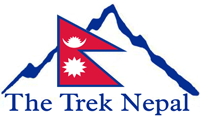
18 Days Three Passes Trek- Adventure Trek
Maximum people, minimum age.
Nepal has most of its trekking routes in its mountain region. Nepal is divided into three segments according to its geography. The lowermost is terai best for agriculture and settlements, hilly regions quality of both mountain and terai little bit, then comes the mountain region filled with tall mountains and hills. This region does not have agricultural potency as terai and does not have huge settlements like hilly and terai also.
The region is filled with the tallest mountains in the world in its topmost part and small settlements in its lower belts. The tall mountains, little settlements, huge forests, rare flora, and fauna make the mountain region the best place for trekking. All the upper sectors from east to west have unique trekking routes that are famous all over the world.
Ready-to-book adventures, personalized
Enjoy a tour with like minded people - Anyone can join
Private Group
Travel with your group - Only your circle join
Day 01: Arrival to Kathmandu
Day 1 of the three passes trek begins after arriving at Kathmandu. After boarding the flight in their home countries, they will make Kathmandu their first destination. Exiting Tribhuvan International Airport, they will have officially entered the land of Nepal. After arrival to Kathmandu, the trekkers will be received from TIA and will be taken to the hotels.
There they will be given plenty of time to rest from their long journey. They can take as much time as they need to rest as long flights can make some very tired. Then at evening time, they will be given a detailed description of the whole trekking. Their questions will be answered and the set of rules to do during the trek and emergencies will be explained thoroughly. The night is spent in Kathmandu.
Day 02 : Visiting Kathmandu Valley
On the second day in Kathmandu, the trekkers will explore Kathmandu. The trekkers will be taken to some of the most popular spots of Kathmandu valley. Kathmandu valley is filled with the most amazing tourism spots which the tourists will be delighted to visit. The trekkers have another job today besides visiting the tourism spots of Kathmandu. They are also here to buy the equipment that they will be needing during the three passes trek. They may be medicine, gears, devices, or other things they require. It is best to get it from Kathmandu as they may not be available in remote Himalayan places. Till evening all the preparations will be made of trekking.
Day 03: To Phakding
On the third day of three passes trek, the trekkers will begin at Kathmandu, but their destination of that day will be far in the mountain region. The trekkers first will go to Lukla through Tribhuvan International Airport. The flight to Lukla takes about 30 minutes from Kathmandu. Lukla airport is considered one of the most dangerous airports in the world due to its terrain and topography.
Trekkers will land at Lukla spend some time and start walking. After landing in Lukla, the trekkers need to get to Phakding. To get to Phakding the trekkers need to hike for about 3 to 4 hours. It is located 7.5km away from Lukla. The night of 3rd day of three passes trek is spent at Phakding.
Day 04: To Namche Bazar
Namche Bazar is one of the most popular places in the Himalayas. It is also one of the largest settlements at that altitude and deep in the mountain region. It is one of the most popular destinations for the tourists that arrive in this region to explore the mountains. Namche is another milestone of three passes trek. The settlement has huge buildings that age exceedingly rare in this area. Namche is also called the gate to Everest. Various beautiful mountain ranges can be seen from Namche Bazar. The trekkers need to hike for about 4 to 5 hours as Namche is 7.4km away from Phakding. The night is spent at Namche.
Day 05 : To Thame
The destination of day 5 of Three pass trek is Thame. The trekkers wake at Namche and move towards Thame. The destination is 5 to 7 hours away from Namche with a distance of 9.5 km. Thame is a beautiful settlement that travelers pass through during the trekking of that region. The night is spent at Thame.
Day 06 : To Marlung
The trekkers wake on the morning of day 6 to reach Marlung. Marlung is a small and beautiful settlement in that region, which the trekkers and mountaineers use as the resting place and spend the night. With hiking of four to five hours, the trekkers can reach Marlung. The trekkers can see Taranga temple and kyaroguba during their hike to the destination that day.
Day 07: To Laguden
The destination of this day of three passes trekking is Laguden. This day’s journey will be completed in 4 to 5 hours. The night is spent at Laguden. During the days of trekking, Kongde peak and Ngozumba glacier can be seen. They are the main sight of this day.
Day 08:Through Renjo La, Gokyo lake to Gokyo village
On the 8th day of three pass trekking, the trekkers get to the first of the three passes Renjo la located at the altitude of 5360m. Mount Makalu, Kongde, Renjo lake, Relama tso are the major sites that are seen of this day along with other beautiful peaks. After the pass, the trekkers move towards Gokyo village. Trekkers can also get an amazing view of the Gokyo lake located near Gokyo village. Gokyo lake is located 5000m above sea level and is one of the highest freshwater lakes in the world. The night after all the amazing visit is spent at Gokyo village.
Day 09 : To Gokyo Ri
Gokyo Ri is not the site that goes forward on the route of the three passes trek. The trekkers if want to go to Gokyo Ri can visit there or if they need the rest, they can be at Gokyo village for the day. Those who want to visit it can go there and need to return to Gokyo village to spend the night.
Gokyo Ri is located at Ngozumpa glacier, which is the largest glacier in the Himalayan range. Gokyo Ri is an amazing spot for the view of the surrounding, from here the trekkers can see Gokyo valley, Gokyo Lakes, Gokyo village, and other beautiful peaks. Gokyo Ri should not be avoided by the people going on three passes trek.
Day 10 : To Thagnak
After waking up at Gokyo village the trekkers need to go to Thagnak. It is located at 4500m from sea level and is 4 to 5 hours walk away from Gokyo. The night of the 10th day of three passes trek is spent at Thagnak.
Day 11 : From Thagnak through Cho La pass to Dzongla
The destination of the 11th day of three passes trek in Dzongla. To reach Dongla the trekkers need to walk 5 to 7 hours. However, while covering this distance the trekkers need to go through Cho la pass which is the second landmark of the three passes trek. Cho La pass is located at an altitude of 5300m from sea level. Cho La pass is a beautiful spot to be and one of the main highlights of the three passes trek.
However, it is also one of the dangerous spots of the trek. It is considered best to complete the Cho La pass before mid-day and as early as possible. The late time of the days may be filled with more chances of harsh weather. After completing Cho La pass, the trekkers move towards Dzongla village.
Day 12 : To Lobuche
The destination on the 12th day of the three passes trek is Lobuche village. It is a beautiful settlement in the mountains from which beautiful peaks can be seen. The name of the village may be based on the mountain that lies near the Khumbu glacier. Both, the village, and mountain have the same name Lobuche. After trekking for few hours in the day the trekkers will reach the Lobuche village from Dzongla.
Day 13 : From Lobuche through Kongma La pass to Chukkung
On day 13 the trekkers will pass through the final pass of the three passes trek. Kongma la pass is located at the altitude of 5535m from sea level. The trekkers are on the routes for two weeks now, so they need to take care of themselves and their teammates as the route can be extremely hard for beginners. The view of the Kongma La pass is magnificent as it is filled with beautiful peaks and mesmerizing views. The walk on this day is high compared to other days as the trekkers need to hike for 7 to 8 hours to get to Chukkung from Lobuche through the Kongma La pass. The night is spent at Chukkung.
Day 14 : To Tengboche
From Chukkung the journey moves towards the end days as the highlight of the trek i.e., the three passes will have been completed by here. However, the journey is far from over and many excitements await the trekkers. The trekkers need to hike for 6 to 8 hours to reach Tengboche, so the walking should be started early in the day. Beautiful views can be seen along the way to Tengboche.
Day 15 : To Monjo village
The trekkers need to walk 6 to 8 hours to reach Monjo village. To reach Monjo village the trekkers need to hike for 6 to 8 hours. It is a small and beautiful village in the Khumbu region, which the trekkers use to spend the night while doing treks around the Everest region. The village is also extremely near to the entrance point of the Sagarmatha national park . The night is spent at Monjo village.
Day 16 : To Lukla
On day 16 of the three passes trek, we reach a familiar destination. The goal of day 16 is to reach Lukla. The trekkers need to walk for 4 to 5 hours maximum to reach Lukla. Reaching Lukla ends the walking part of the three passes trek. It may be so but the journey is far from over. After reaching Lukla the trekkers will rest and spend the night there.
Day 17 : Lukla to Kathmandu
Day 17 of the three passes trek, the trekkers get up in the morning to reach Kathmandu from Lukla. The trekkers will get to Kathmandu within 30 minutes after getting on the flight. getting on Kathmandu officially ends our three passes trek in the mountains. The trekkers can get the rest they need in Kathmandu. They can rest in their hotels for few days, or get to the luxury places of Kathmandu to enjoy the city life after being weeks in the mountains, or even have the natural healing therapies to get rid of the tiredness of the long journey.
Day 18 : Leaving Kathmandu
After resting few days, the visitors now must leave Nepal. Their journey may have ended for now, but they had an amazing adventure and experience at three passes trek whose memory will never go away. They will go to Tribhuvan International airport to go to their destination. Also, if they have a tight schedule, they can immediately leave by skipping few days of rest at Kathmandu.
What’s Included
- N We provide you the accommodation which will be shared by two people. However, you can book for a single room with extra charge.
- N We will also bear the cost of a domestic flight that will be traveled for the trip.
- N The overland transport will be held on tourist coach as per the itinerary and size of the group.
- N The applicable fee for the Trekking, National Park and Conservation center will be covered.
- N Three meals in a day include breakfast, lunch, and dinner which will be provided.
- N We offer you a welcome group dinner in an authentic Nepali restaurant with cultural show.
- N The wages, meals, insurance and transport allowance of all trekking staff and porters will be arranged.
- N We also can arrange the planning for the place of interest in the city accompanied by the city guide.
- N We also have included the comprehensive medical kit and service of guide and porters.
- N We also help you to reconfirm your international flight.
What’s Excluded
- Q Pick-up/Drop from/to the airport.
- Q The visa fee you would have to pay for travel, medical insurance and airport tax.
- Q The meals of your personal interest will not be offered in our expense.
- Q We would also not provide personal sleeping bags and bags.
- Q The charge applied in case of emergency evacuation by any means of transport would not be included.
- Q The charge for accommodation in Kathamndu in you early arrival before the trip will not be included and also the late departure. Moreover, the early departure from trek will also not included in our expense.
- Q We also don’t include the cost of international flights.
- Q The trip doesn’t offer the travel and rescue insurance.
- Q We also don’t include the phone calls, laundry, bar bills, battery recharge, extra poter etc.
- Q We also don’t offer tips for guides and porters, you can give them yourself if you like to give.
Trek start dates
- N 1st of every Month
Everest Three Passes Trek
4.6 star out of 5.
“Best Trek of my life; out of the world experience.”
Make An Inquiry
Fill the form for more details
Email Address
Related Tour Packages
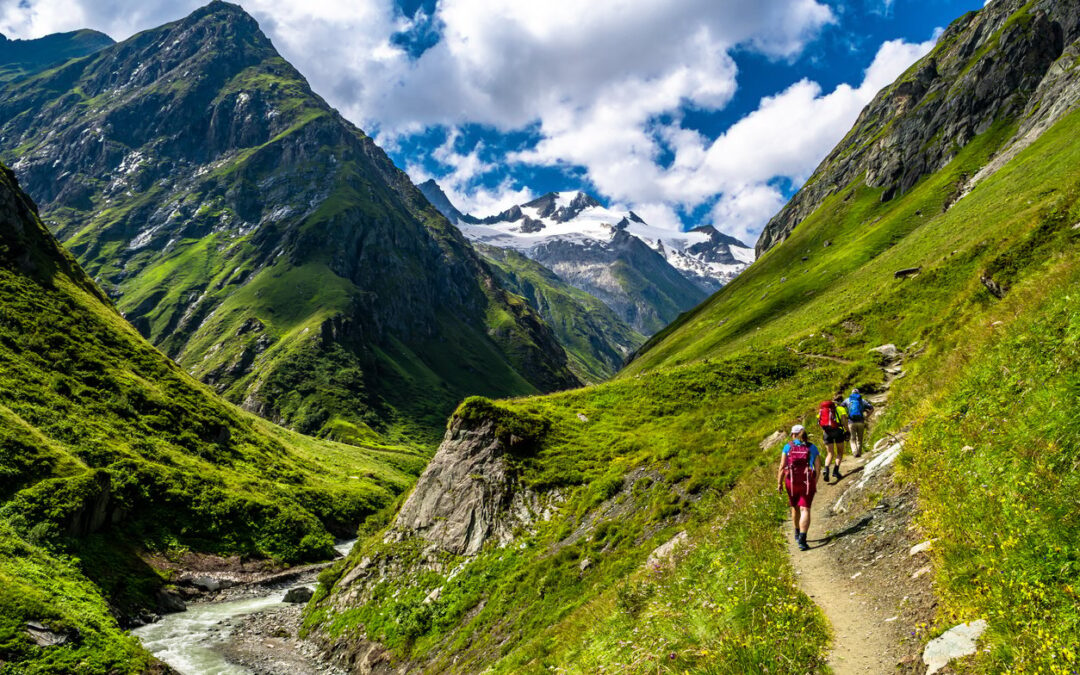
Hiking Heaven: Best Trails for Trekking in Nepal
by Trek | May 6, 2024 | Uncategorized
There is a famous saying that heaven is a myth, and Nepal is real. Well, it is due to what the country has to offer. The opinions of different people might be different as to what are the best trails for trekking. But one thing is assured all the trails are worth your...
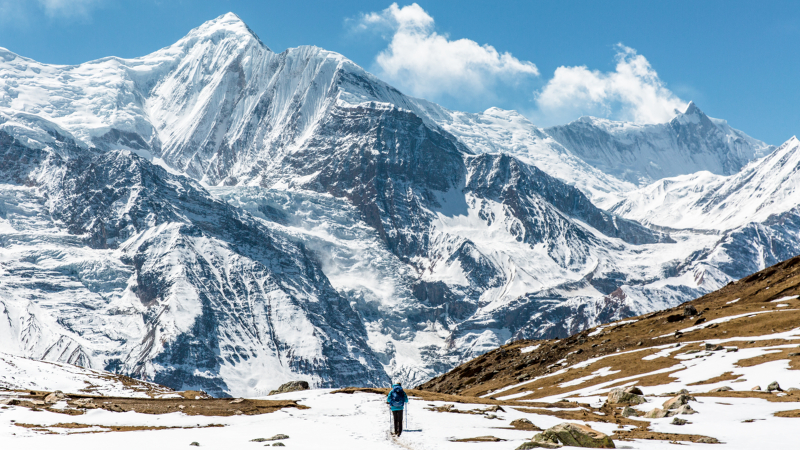
Trekking to Annapurna Circuit: A Trekker’s Journey to Himalayan Bliss
by Trek | May 1, 2024 | Uncategorized
If you are thinking of experiencing the actual beauty of the Nepalese Himalayas, you will have to visit the Annapurna circuit. Often called as a tough. trekking to the Annapurna circuit will fill your heart with happiness. Annapurna circuit is highly popular for deep...
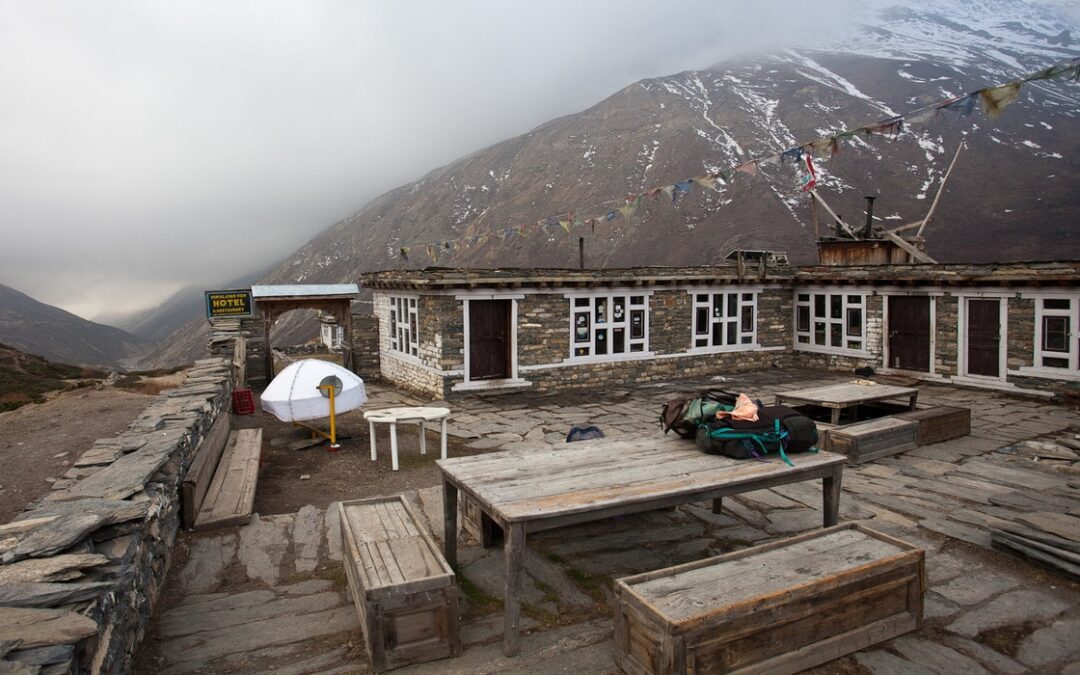
Teahouse Treks: Exploring Nepal’s Comfortable Trails
by Trek | Apr 27, 2024 | Uncategorized
Teahouse Trek provides an exciting option in Nepal. Not only does it acquaint you with the beauty of the country but also brings you closer to the Nepalese culture and people. The Teahouse trek allows the tourist to experience the local feel of the place along with...
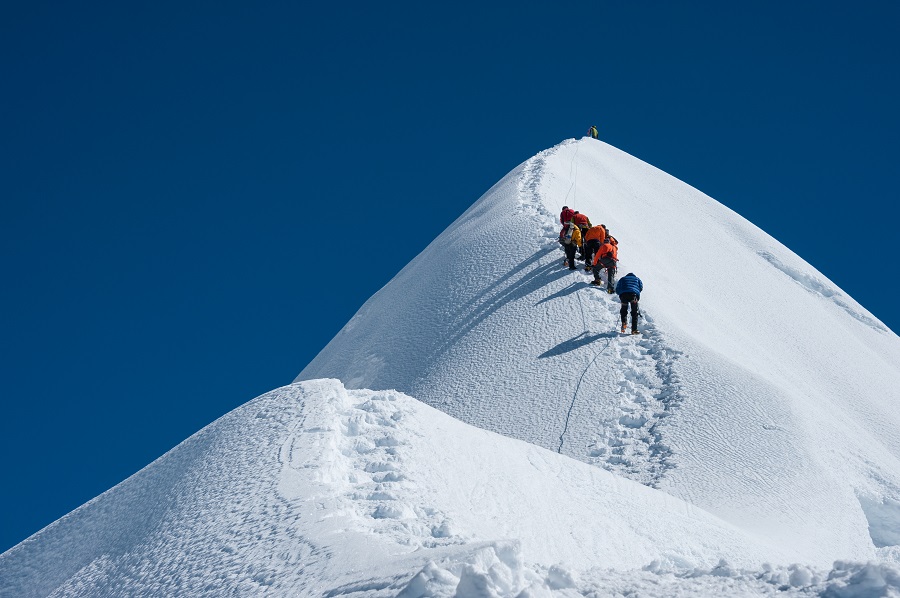
Everest Dreams: Trekking to the Top of the World
by Trek | Apr 23, 2024 | Uncategorized
There might be Everest dreams at night if you are an avid trekker. Every trekker who loves to spend their time wandering has an innate feeling to trek the top of the world. However, it is not easy for everyone to achieve with greater ease. Talking about the Everest...
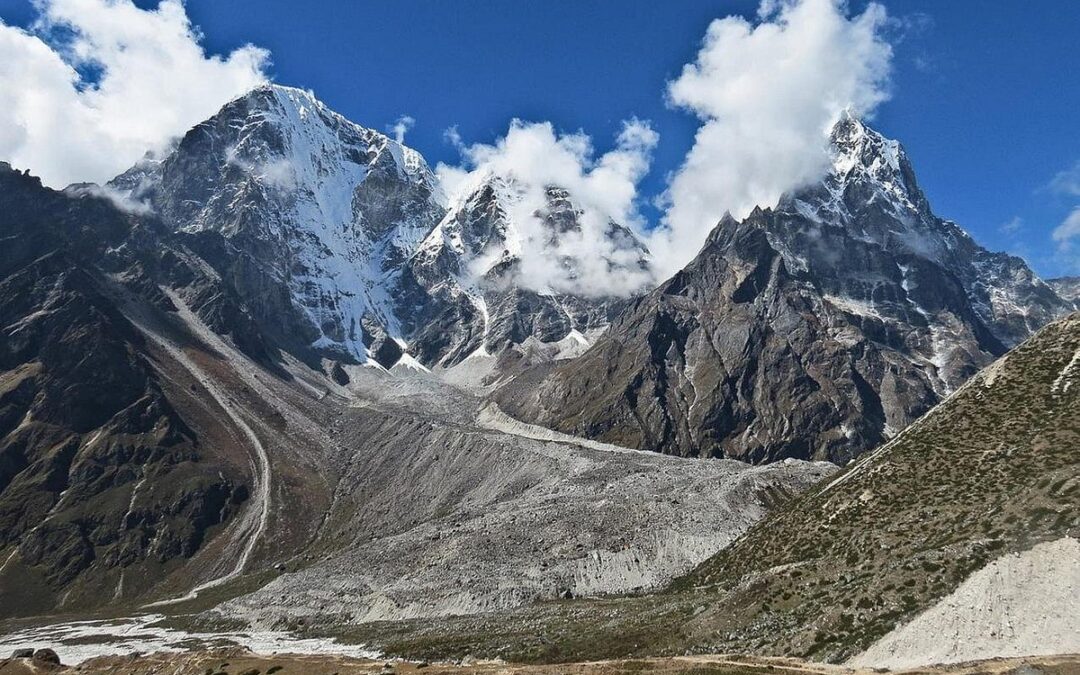
Beyond Base Camp: Trekking Adventures in Nepal’s Himalayas
What do you recall when someone says Nepal, well it is more about the temples, mountains, trekking, and the food. But there is much more to Nepalese than all of these. Life is beyond base camp, mountains, and trekking all the time. Nepal is also known for its...
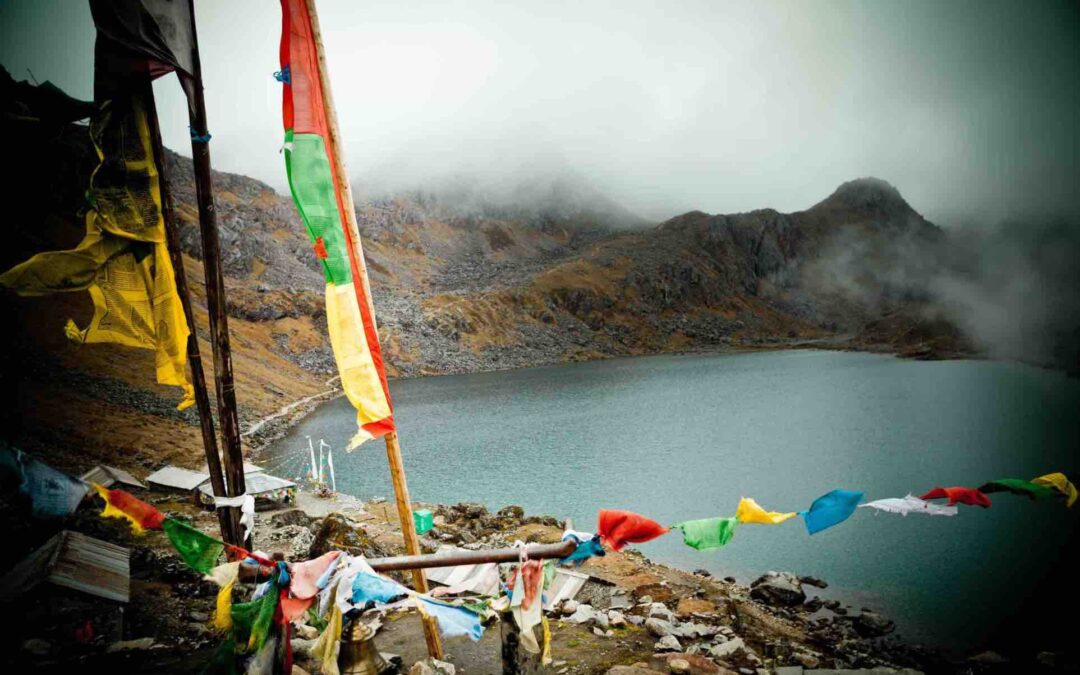
Gosaikunda Glory: Trekking to the Sacred Lakes
by Trek | Apr 7, 2024 | Uncategorized
Nepal is blessed to have beautiful places which have religious values to it. Talking about places with religious values Gosaikunda glory is one to achieve. It is critical to understand that reaching Gosaikunda isn't as easy as it sounds. However, the sacred lake...
+977 9841319155
Everest Three Passes Trek
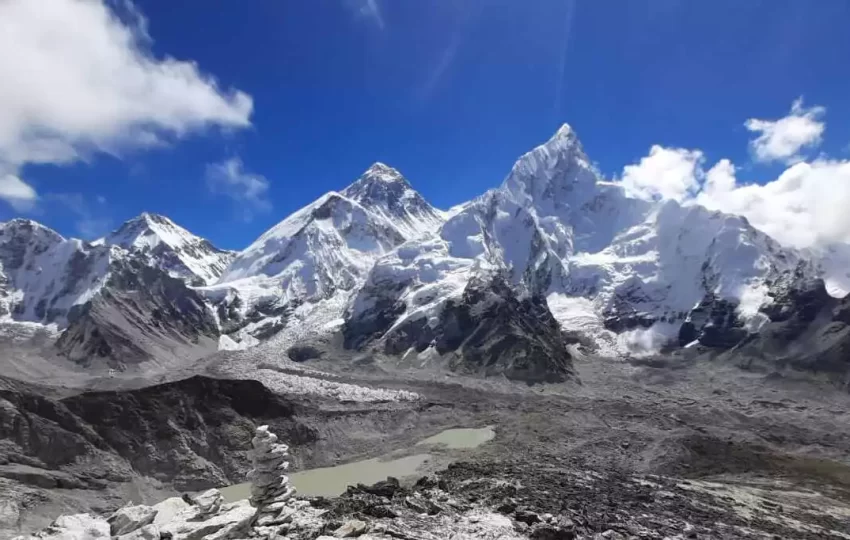
Description
Embark on an exhilarating journey through the heart of the Everest region with the Everest Three Passes Trek, a hardcore and thrilling adventure that beckons avid hikers and trekkers seeking the ultimate challenge. This iconic trek takes you through the formidable Kongma La Pass (5,535m/18,159ft), Cho La Pass (5,420m/17,782ft), and Renjo La Pass (5,340m/17,520ft) , three of the highest and most challenging passes in the Himalayas.
While the Everest Three Gigh Passes trek presents its own set of difficulties and challenges, the unparalleled mountain vistas and the overall experience make every step worthwhile. The journey unfolds amidst stunning landscapes, offering awe-inspiring views that will etch themselves into your memory. The breathtaking panoramas from Kongma La Pass, Cho La Pass, and Renjo La Pass are nothing short of spectacular.
Beyond the thrill of conquering these high-altitude passes, the trek takes you to some of the best viewpoints in the region, including Gokyo Ri (5,357m/17,574ft), Kala Patthar (5,643m/17,598ft), and Chukkung Ri (5,546m/18,196ft). From these vantage points, soak in not only the panoramic majesty of towering peaks but also feast your eyes on picturesque alpine woods, pristine turquoise lakes, and the unique terrain of the Khumbu region.
The Everest Three Passes Trek is a test of endurance and a celebration of nature's grandeur, offering a once-in-a-lifetime experience for those who dare to venture into the heart of the Himalayas.
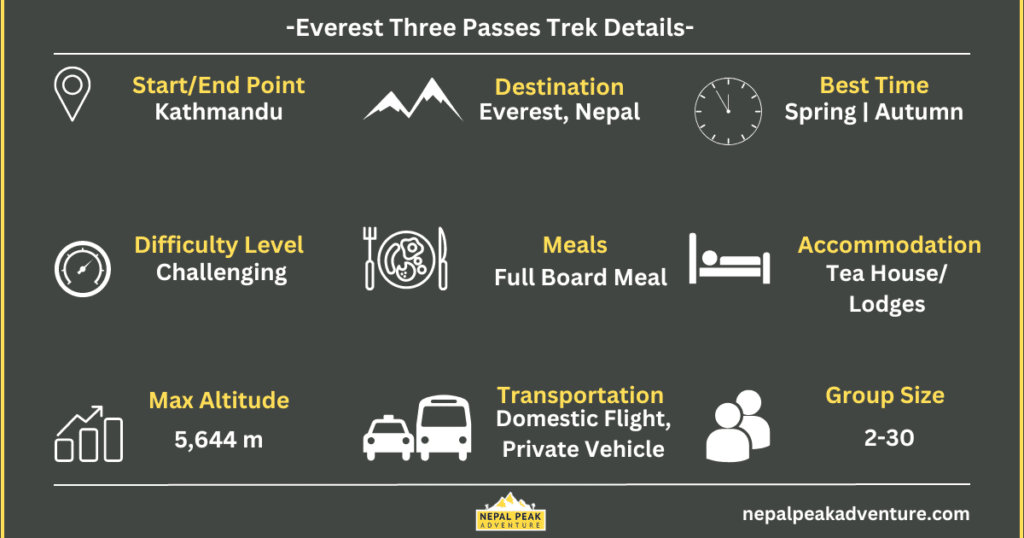
Everest Three Passes Trek Highlights
- Ultimate trekking experience in the majestic Himalayas, a journey that promises both challenge and awe-inspiring beauty.
- Thrilling mountain flight to Lukla, providing a breathtaking aerial perspective of the Himalayan landscape.
- Crossing the three high passes: Kongma La Pass, Cho La Pass, and Renjo La Pass.
- Setting foot on the iconic Everest Base Camp, a bucket-list destination for trekkers worldwide. Exploring the charming Sherpa villages and their rich culture and traditions.
- Witness the spectacular mountain vista throughout the whole journey
- Navigate the rugged terrain by crossing numerous suspension bridges, adding an element of thrill to your trek.
- Immerse yourself in the spiritual and cultural richness of the region by visiting local gumbas, stupas, and monasteries.
- Savor the flavors of the Himalayas by enjoying local cuisine in teahouses along the trekking route.
- Step into the pristine wilderness of Sagarmatha National Park, a UNESCO World Heritage Site.
- Explore a wide array of flora and fauna, including rare species that call this high-altitude paradise home.
Cost Inclusion in Three Passes Trek
Our Everest Three Passes Trek package for 19 days includes all of your expenses for the trek such as airport transfers, trek permits, accommodations in Kathmandu and during the trek, meals, trekking guides, porters, and many others throughout the trek to ensure a hassle-free and exciting journey. Here is what is included in the package in detail.
- Airport Pick-up and Transfer to your hotel from a private vehicle
- Welcome dinner at Nepalese Restaurant that shows a live Nepali cultural program
- 2 Nights at standard accommodation in Kathmandu with breakfast on the basis of twin sharing
- 2 Way Flight from Kathmandu- Lukla- Kathmandu Flight, airport tax, and domestic transfer | During Off-season
- 2 Way Flight from Ramechhap - Lukla - Ramechhap Flight, airport transfers & tax | During Spring & Autumn
- Teahouse/Mountain Lodge accommodation during the trek | 5 nights with attached bathroom & hot shower facility (1-night Phakding, 3 nights Namche, 1 night Lukla) & Remaining 11 nights in basic tea houses/lodges as only basic rooms are available there
- All meals (Breakfast, Lunch, and Dinner) during the trek | Full Board Meal
- 3 cups of coffee/tea during the trek every day
- Seasonal Fruits after dinner during the trek
- Cost of a Professional Guide (government certified experienced, fluent English speaker, first aid and eco trained).
- Porter’s cost (one porter for every two members in a group)
- Guide & Porter Insurance & Salary
- Permits (Everest trekking permit/Sagarmatha National Park fee)
- All Government and Local body taxes as applicable
- Down Jacket and sleeping bags (upon request)
- A duffle Bag and a T-shirt (as a souvenir)
- Trekking map
- Certificate of Trek Completion
- First Aid Kit carried by Guide
- The arrangement of Emergency Helicopter Evacuation (Service will be paid for by your travel insurance company)
- Farewell Dinner in a reputed Restaurant
- Final departure transfer
What are the Cost Excludes?
- Nepal visa fee
- International flight
- Personal trekking gear
- Your travel insurance
- Medical expenses
- Any other prolonged trips and accommodation
- Tipping to the porter, guide, and driver
- Any other expenses or charges that are not included in the inclusion list
Everest Three Passes Outline Itinerary
- Day 01: Arrival day in Kathmandu and transfer to a hotel (1400m/4,593ft)
- Day 02: Fly to Lukla and trek to Phakding (2610m/8,563ft)
- Day 03: Trek to Namche Bazaar (3440m/11,286ft)
- Day 04: Acclimatization day at Namche Bazaar and Day excursion
- Day 05: Trek to Tengboche (3867m/12,687ft)
- Day 06: Trek to Dingboche (4410m/14,468ft)
- Day 07: Acclimatization day at Dingboche
- Day 08: Trek to Chhukung (4730m/15,518ft), climb Chhukung Ri (5,546m/18,196ft), and overnight in Chhukung.
- Day 09: Cross Kongma La pass (5528m/18,136ft) and trek to Lobuche (4910m/16,109ft)
- Day 10: Trek to Everest Base Camp (5364m/17,598ft) via Gorakshep (5164m/16,942ft) and return to Gorakshep for overnight
- Day 11: Hike to Kalapatthar (5545m/18,192ft) and trek to Lobuche
- Day 12: Trek to Dzongla (4830m/15,846ft)
- Day 13: Trek to Gokyo (4800m/15,748ft) through Cho La Pass (5420m/17,782ft)
- Day 14: Hike to Gokyo-Ri (5357/17,575ft) and rest day at Gokyo
- Day 15: Trek to Marlung (4249m/13,940ft) via Renjo La Pass (5360m/17,585ft)
- Day 16: Trek to Namche Bazar (3440m)
- Day 17: Trek to Lukla (2860m/9,384ft)
- Day 18: Fly to Kathmandu
- Day 19: Departure from Kathmandu
Everest Three Passes Trek Map
Here is a drawing of a map for easy reading to show how you will be circulating the trek & the popular mountains you will see during the trek in Everest Three Passes Trek. See the itinerary to better understand the map.
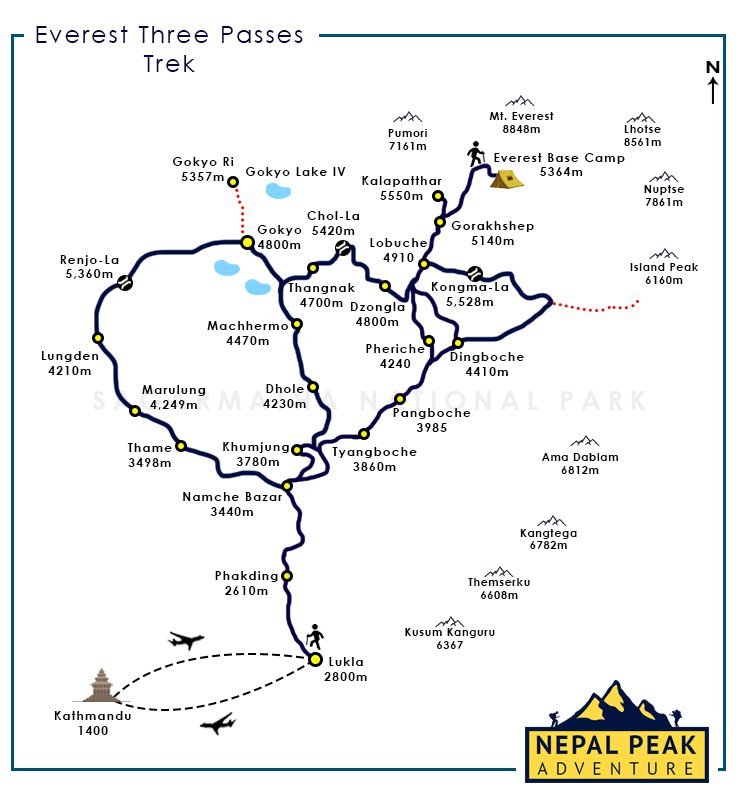
Why Nepal Peak Adventure for the Everest Three Passes Trek?
Nepal Peak Adventure (NPA) is one of the best-operating Everest Three Passes Trek companies in the world. Here's why:
- Numerous successful Three High Passes Treks organized
- Exceptional service quality with 100% client satisfaction
- Clients have access to a secure online platform for their convenience
- We are ranked top 50 out of #1545 travel companies on TripAdvisor and still growing on
- Travelers' Choice Award from TripAdvisor
- Zero client complaints and negative reviews
- We guarantee that our service is superior to that of other companies
- Personalized itineraries are tailored to match individual preferences and interests
- Client safety and security are top priorities throughout the journey
- We promote sustainable tourism practices to minimize the environmental impact
- Responsive and reliable customer support is available to assist clients 24/7
Three High Passes Trek Route Overview
The Everest Three Passes Trek journey begins with a scenic mountain flight from Kathmandu or Ramechhap (more details about the Lukla Flight) to Lukla. The trek then officially kicks off with a picturesque trail leading to Phakding at 2610 meters before ascending to the vibrant mountain town of Namche Bazaar, strategically positioned at 3440 meters where we will have one extra day for acclimatization.
Continuing the ascent forward, the journey unfolds to Tengboche, known for its charming monastery and stunning panoramic views. Dingboche, a high-altitude village, is the next destination where will stay another extra day for the acclimatization. The following day our trail leads you to the Chhukung at 4730 meters. Here, trekkers undertake the exhilarating climb of Chhukung Ri at 5546 meters, offering breathtaking vistas.
The trek's pinnacle arrives as adventurers cross the challenging Kongma La Pass at 5528 meters one of the passes among the three passes, followed by a descent down to Lobuche at 4940 meters. The journey then leads to the legendary Everest Base Camp at 5364 meters via Gorakshep (5164 meters), with a return to Gorakshep for an overnight stay. The subsequent day includes a hike to the iconic Kala Patthar at 5644 meters, revealing unparalleled views of Mount Everest, before descending to Lobuche again. The three-pass trail then progresses to Dzongla at 4830 meters, a serene location surrounded by the grandeur of the Himalayas.
The trek takes a daring turn as trekkers traverse the challenging Cho La Pass at 5420 meters (second pass), en route to the picturesque Gokyo situated by the tranquil Gokyo Lakes at 4800 meters. A day of exploration follows, including a hike to Gokyo-Ri at 5357 meters and a rest day in Gokyo at 4750 meters. The journey continues with a trek to Marlung at 4249 meters via the scenic Renjo La Pass at 5360 meters (third and final pass). The trail eventually leads back to Namche Bazaar at 3440 meters, offering a chance to reflect on the varied landscapes encountered.
The final leg of the trek involves a return to Lukla at 2860 meters, completing the epic Everest Three Passes adventure. This anticlockwise route not only navigates through the challenging high passes but also allows trekkers to witness the iconic Everest Base Camp, charming Sherpa villages, and serene alpine landscapes.
The itinerary, though presented in an anticlockwise direction, offers the flexibility for trekkers to undertake the journey in reverse, ensuring a dynamic and awe-inspiring experience in the heart of the Himalayas.
Everest Three Passes Trek Itinerary
Our 19-day Everest Three Passes trek takes you on an anticlockwise journey, challenging your spirit as you conquer Kongma La Pass, Cho La, and Renjo La Pass in succession. The trek spans 16 days within the mountain region, ensuring a comprehensive exploration of the Everest terrain. To facilitate acclimatization, our itinerary strategically incorporates three extra overnight stops at key locations: Namche Bazaar, Dingboche, and Gokyo.
This thoughtfully designed itinerary doesn't just focus on the three high passes but also ensures you experience the iconic Everest Base Camp, the mesmerizing Kalapatthar, and other major attractions such as Gokyo Ri and Chukkung Ri. Each day unfolds with a new adventure, providing a balance of challenge and awe-inspiring landscapes.
Recognizing that individual preferences and schedules vary, we offer different variations of the Everest Three Passes trek itinerary. Our flexibility extends to customization, allowing you to tailor the journey to align with your specific preferences and time constraints. Whether you prefer the anticlockwise route or wish to explore the passes in a clockwise direction, we are here to accommodate your choices.
Feel free to inquire for more details about the trek itinerary, and let us assist you in planning an Everest base camp passes trek adventure that suits your unique preferences and schedule. Your journey awaits, and we're here to make it an unforgettable experience tailored just for you.
Things You Should Know
Your typical day on the trek.
Your adventure officially commences with your arrival in Lukla, marking the beginning of an exciting journey through the Everest region.
Each day on the trail unfolds with a hearty breakfast served between 6:30 to 7:30 AM, setting the tone for the day's trekking endeavors. After breakfast, you embark on your trek, setting out towards the day's scheduled destinations. Before commencing the trek, we advise you to pack all essentials for the day in your backpack, while your duffel bags are expertly carried by the porter at their own comfortable pace.
As you traverse the stunning landscapes, the journey incorporates regular stops for short breaks, allowing you to hydrate, refuel with snacks, and capture the breathtaking scenery through your lens. Typically, after three to four hours of trekking, a well-deserved lunch break is scheduled en route, providing a moment to rest and recharge.
Upon reaching the designated overnight stop, you have the opportunity to unwind and explore the surrounding area. In the evening, a nourishing dinner is served around 6 to 7 PM, creating a communal atmosphere among fellow trekkers. Post-dinner, engage in enlightening conversations with your trekking guide, who will also provide a detailed briefing about the plan for the following day. Subsequently, you can choose to retire to bed for a restful night's sleep or spend your time playing cards, delving into a good book, or simply relishing moments of relaxation at your own pace.
This carefully structured daily routine ensures not only a smooth trekking experience but also offers ample opportunities to immerse yourself in the natural beauty and cultural richness of the Everest region.
Can I do the Everest Three Passes Trek?
The Everest Three Passes trek beckons to all adventure enthusiasts seeking a thrilling experience. While navigating the three highest passes of the Everest region poses a formidable challenge, with adequate preparation, physical fitness, and expert guidance, this trek is accessible to anyone with a passion for exploration. It is advisable, however, to have prior trekking experience at higher altitudes to enhance readiness for the demands of this epic journey.
This trek unfolds as a journey of wonders, weaving through the limitless beauty of the Himalayas, adorned with panoramic landscapes, and steeped in rich cultural traditions. The trail offers a tapestry of experiences, showcasing the diverse tapestry of the region.
Undoubtedly, the Everest Three Passes trek presents its own set of challenges, requiring trekkers to navigate rugged trails, traverse glaciers, and conquer challenging uphill sections. Despite the difficulties, the rewards are immeasurable, with each step revealing breathtaking vistas and a deep immersion into the heart of the Himalayan landscape.
For those who may be novices or prefer a more gradual introduction to the region, we recommend the classic 14-day Everest Base Camp Trek. This alternative allows trekkers to witness the grandeur of the Everest region without tackling the high passes immediately, providing a stepping stone for those aspiring to undertake the more challenging Three Passes adventure in the future.
Packing list for the Three Passes Trek
The Everest Three Passes Trek demands meticulous preparation and a thoughtfully curated packing list, considering the formidable challenges and the extended duration of the journey, typically spanning 15-17 days. Trekking through the highest passes of Everest is a serious endeavor, and success hinges on being thoroughly equipped and well-prepared for the varied conditions encountered along the way.
Hence here we will tell you exactly what should you pack for the Everest Three Passes Trek.
Basic Gears and Equipment
- Duffle Bag (The Company will provide you 50-70 liters duffle bag)
- Day Pack (35-45 liters recommended) with rain cover
- Trekking Poles (1 pair)
- Four-season sleeping bag (can be rented at Thamel)
- Sleeping bag liner (optional)
- Personal first aid kit and meditations (Company will provide the first aid kit which will be carried by the guide however you can have your own with the consultation of your doctor)
- Water bottle / Water bladder / Thermal Bottle
- Beanie (1 Nos)
- Sun hat or Cap (we provide free company cap) (1 Nos)
- Polarized Sunglass (1 Nos)
- Buff/Neck Gaiter (1 Nos)
- Headlight (1 Nos)
- Insulating layers/thermal wear (2 pair)
- T-shirt (3 pairs)
- Full sleeve t-shirt (thin and thick) (1 each)
- Waterproof and windproof outer layers (1 Nos)
- Fleece jacket (2 pairs)
- Down jacket (Company provides)
Lower Body:
- Hiking Pants (2 pair)
- Comfortable pants for the teahouses (1 Nos)
- Hiking shorts (optional)
- Waterproof and windproof pants (optional)
Hand Wears:
- Fabric liner gloves (1 pair)
- Hard-shell outer glove (1 pair)
Feet Wears:
- Fabric warm socks (2/3 pair)
- Hiking socks (2/3 pair)
- Trekking boot high ankle with good grip recommended (1 pair)
- Casual shoes for the teahouses
- Gaiters (optional)
Personal Utilities
- Undergarments (according to your needs)
- Pajamas or sleeping clothes (optional)
- Sunscreen cream
- Toothbrush and toothpaste
- Snacks (chocolates, dry fruits, energy bars, etc)
- Playing cards
- Power banks
- Trekking Map (company provides)
Documentation:
- Valid passport and necessary permits
- Extra passport-sized photos
- Travel insurance details
- Emergency contact information
- Money (local currency and small denominations)
Note: Most of the gear can be rented in Thamel, Nepal so you don’t need to carry heavy luggage. Also, some of the gear will be provided to you from Nepal Peak Adventure.
About Lukla Flight
We would like to bring to your attention to some of the significant updates regarding Lukla flights, particularly during the peak trek seasons (March, April, May, October, and November). Civil Aviation Authority of Nepal declared that there will be no direct flights during peak seasons due to heightened air traffic in these months, Lukla flights will now operate from Manthali Airport in Ramechhap rather than Kathmandu.
Conversely, in the non-peak seasons (January, February, June, July, August, September, and December), Lukla flights will continue to depart from Kathmandu.
For those boarding a Lukla flight from Ramechhap, please be advised that an early departure from Kathmandu is necessary, typically around 12:30 to 1:00 AM. The journey from Kathmandu to Ramechhap typically takes 4-5 hours. Your guide will be at your hotel at the specified time to pick you up and drive you to Ramechhap.
It's crucial to acknowledge that Lukla flights may face disruptions due to various factors, such as adverse weather conditions, airline technical issues, and unforeseen circumstances. Consequently, we highly recommend planning for an additional 2-3 days as a contingency to accommodate any potential delays.
We deeply appreciate your understanding and cooperation in adapting to these adjustments, ensuring a smoother and more enjoyable trekking experience.
For further details, you can refer to Lukla Flight.
Useful Info
Accommodations.
Our comprehensive package ensures that accommodation facilities are seamlessly included. In Kathmandu, you will enjoy a two-night stay in a star-category hotel. This accommodation follows a bed and breakfast plan with twin sharing, providing a comfortable and relaxing start to your journey.
During the trek, your accommodations will be in teahouses and lodges, carefully selected to meet your needs for a restful night's sleep. These lodgings offer warm blankets, pillows, and comfortable mattresses. Typically, rooms are designed for twin sharing, featuring two single beds. For those seeking more privacy, the option for a single room is available at an additional cost, although this may not be applicable during peak seasons.
While teahouses have undergone upgrades and offer quality rooms, it's important to note that as you ascend in elevation, only common standard rooms will be available. Our plan includes five nights with attached bathrooms and hot shower facilities (1 night in Phakding, 3 nights in Namche, and 1 night in Lukla). The remaining 11 nights will be spent in basic tea houses and lodges, as these locations primarily provide basic room amenities.
Throughout the entire journey, we prioritize securing the best possible tea houses with spectacular mountain and scenery views. Your accommodation experience is an integral part of the overall trekking adventure, and we are committed to ensuring your comfort and enjoyment at every step of the way.
Meals and Drinks during the 3 passes trek
Our Everest Three Passes trek package is designed to provide you with a hassle-free dining experience throughout the entire journey. All meals, including breakfast, lunch, and dinner, are included during the trek itself. However, it's important to note that in Kathmandu, lunch and dinner are not included as part of the package.
While on the trek, you will enjoy breakfast and dinner at the same teahouses where you stay, creating a convenient and comfortable dining routine. Lunch will be provided at designated lunch stops along the day hike, allowing you to refuel and take in the breathtaking surroundings. The teahouses and lodges along the route offer a diverse menu, featuring a wide array of Western and Indian cuisines, along with delicious local Nepali dishes. We highly recommend trying the traditional Nepali dish, Dal Bhaat, for a truly authentic experience.
Considering health concerns, especially in high-altitude environments, it is advisable to avoid non-vegetarian items, as the freshness of meat and dairy products may be a challenge in mountain regions.
For beverages, aside from the tea and coffee served with every meal, the cost of other drinks is not included in the package. You have the flexibility to purchase bottled water, hot water, and other beverage items at an additional cost, typically ranging from USD 2 to USD 5.
Our goal is to ensure that you have a satisfying and enjoyable culinary experience throughout the Everest Three Passes trek, offering a balance of convenience and flexibility in your dining choices.
Drinking Water on the 3 passes trek
Tap water is typically available in teahouses and along the trekking route during the Everest Three Passes journey. While it can be convenient, it is essential to exercise caution. Refrain from consuming tap water directly, as it may upset your stomach. Instead, consider filling up your water bottles and using purifying tablets or sterilizing methods to ensure their safety before use.
Alternatively, if you prefer the convenience of pre-packaged water, bottled water is readily available along the trek. The cost for a bottle typically ranges from USD 2 to USD 5, offering a reliable and safe option for hydration.
For those in need of hot water, teahouses provide this service at an additional cost. Hot water is available in small, medium, and large pots, each varying in price. This option allows trekkers to enjoy warm beverages on the cold temperature.
Transportation Facilities
For a seamless and comfortable journey throughout your time in Nepal, Nepal Peak Adventure takes care of all your transportation needs. From the moment you arrive in Nepal to your final departure, all transfers are meticulously arranged, ensuring a hassle-free experience all via private vehicles.
Additionally, to streamline your trekking experience, we take care of all arrangements for your Lukla flight. The flight will be pre-booked by us, allowing you to board with ease and embark on your trek with a sense of tranquility.
Best time for the Everest Three Passes Trek
The best time for the Everest Three Passes Trek is during the pre-monsoon (spring) and post-monsoon (autumn) seasons. Here are the optimal periods:
Spring (Pre-Monsoon): March to May
Pros: Mild temperatures, blooming rhododendrons, and clear skies.
Cons: Crowded trails during peak season.
Autumn (Post-Monsoon): September to November
Pros: Stable weather, clear visibility, and comfortable temperatures.
Cons: Popular trekking season, leading to crowded trails.
Both spring and autumn offer favorable weather conditions, allowing for spectacular views of the Himalayan landscape. Trekkers can expect daytime temperatures ranging from 10°C to 20°C (50°F to 68°F) during these seasons.
It's crucial to note that while these are the peak seasons for the Everest Three Passes Trek, some trekkers also venture out during the winter and monsoon seasons. However, winter brings colder temperatures, increased snow cover, and potential trail closures, while the monsoon season (June to August) brings heavy rainfall, making trekking challenging.
Everest Three High Passes Trek Difficulty
The Everest Three High Passes Trek is known for its challenging nature and is typically recommended for seasoned trekkers with a high level of physical fitness. The trek involves conquering three of the highest and most demanding mountain passes in the Everest region: Kongma La Pass, Cho La Pass, and Renjo La Pass. These passes reach elevations exceeding 5,300 meters (17,500 feet), exposing trekkers to the challenges of high altitude, including acclimatization concerns.
The route encompasses technical sections with steep ascents, descents, rocky terrain, and potential icy or snowy conditions, especially at the passes. The trek's duration spans approximately 16 to 19 days, demanding endurance and stamina. And every day you have to walk for around 4-6 hours.
Unpredictable weather conditions, including cold temperatures and high winds, add to the difficulty. The trail traverses remote and rugged landscapes, featuring challenging paths, river crossings, and varied terrain. Accommodation in teahouses along the route may offer basic facilities, and amenities become more limited at higher altitudes.
Despite these challenges, the trek rewards adventurers with breathtaking scenery, panoramic views of Everest, and a unique, demanding experience. Proper physical conditioning, acclimatization, and careful preparation are crucial for a safe and enjoyable journey.
Everest Three Passes Trek Safety and Acclimatization
Your safety and comfort are our utmost priorities at Nepal Peak Adventure. Our team of dedicated and professional guides and porters is committed to ensuring your well-being throughout the entire trip, allowing you to focus solely on enjoying the journey. They handle all aspects of accommodation and meals, providing you with a seamless and worry-free experience.
Our experienced guides are equipped with first aid kits at all times, and they diligently monitor your oxygen levels daily to ensure your fitness and well-being at higher elevations. In the event of any difficulties, our guides are trained to analyze the situation and take necessary actions promptly.
As part of our Everest Three Passes trek package, we have strategically included extra days at various locations to facilitate the acclimatization process. This is a crucial aspect of the trek, ensuring that your body adjusts gradually to the higher elevations, reducing the risk of altitude-related issues.
Moreover, our official team is well-prepared for emergencies and evacuations. If the need arises, we have a robust plan in place to safely evacuate you from the mountains and provide the necessary assistance. Your safety is our paramount concern, and our comprehensive measures are designed to make your trek not only adventurous but also secure and enjoyable.
Do you need a guide for the three passes trek?
While it is not mandatory, hiring a guide for the Everest Three Passes Trek is highly recommended for several reasons. The trek involves navigating challenging terrains, high altitudes, and technical sections, and having an experienced guide can enhance both safety and enjoyment.
They can also assist in acclimatization and monitor your well-being, reducing the risk of altitude-related issues. In case of emergencies, a guide is trained to handle situations promptly, including coordinating evacuations if necessary.
Travel Insurance
Travel insurance is essential for anyone going on the Everest Three Passes Trek. Your insurance should include provisions for emergency medical situations, covering aspects such as altitude sickness and the associated need for immediate medical evacuation and treatment.
Additionally, ensure that your policy caters to trip cancellations or interruptions, offering reimbursement for pre-paid expenses. Given the mountainous terrain, having coverage for helicopter evacuations and rescues is imperative. Protection for baggage and personal belongings, as well as provisions for potential travel delays, should also be integral to your insurance plan.
Confirm that your policy extends to adventure activities like trekking at high altitudes, and carefully review its terms and conditions, including coverage limits and exclusions. Acquiring the right travel insurance ( world nomads ) is a crucial step in ensuring a secure and worry-free experience throughout the Everest Three Passes Trek.

- Trekking in the Khumbu Region of Nepal
- Visiting Sherpa villages and monasteries
- Crossing Renjo La, Cho La and Kongma La passes
- Exploring the Gokyo Valley
- A visit to the famous Gokyo Lakes
Our representative will welcome at the Tribhuwan International Airport Kathmandu and transfer you to your respective hotel. We will take you out for a welcome dinner where you can enjoy a typical Nepalese cultural program.
You will fly to Lukla in the morning today. At Lukla, you will have breakfast before starting your trek. Your porter/porters will join you from Lukla. While enjoying the first glimpse of the Everest region, you will reach Phakding where you halt for the day.
After breakfast, you will start your day. Soon after you resume the trek, you will cross a suspension bridge with the prayer flags greeting you. Most of the time today, you will have a beautiful view of Dudh Koshi River with alpine vegetation on the bank. After passing a check post to enter Sagarmatha National Park at Monzo, the trail continues with brief ups and downs. At the end of the day, your trail continues uphill via a pine forest before arriving in Namche Bazar. You will enjoy your two-night stay in this lively town.
Today, you will stay here for acclimatization. After breakfast, you will take a tour of the nearby places including a Sherpa museum. The museum is about Sherpa culture and tradition. You will have a picturesque view of the mountains from the premises of the museum. You will climb up to Syanboche airport or Everest View Hotel which offers better views of the mountain including Mount Everest. Overnight at Namche Bazar.
Today, you will start your day on a moderate trail which continues on a hilly ridge. You will have wonderful views of the various mountain that includes Mount Thamserku (6623m), Mt. Kusum Kanguru (6367m), and Mt. Ama Dablam (6812m) on the route. You will energize yourself with lunch to climb a rocky uphill for about an hour or so before entering to Tengboche. The biggest monastery in the region is located in Tengboche. You can visit the monastery in the late afternoon to see the rituals inside. Overnight at Tengboche.
After breakfast, you will climb down quickly through a juniper forest and continue walking until you cross a stream. Then, you will ascend on a rocky path with rare mountain shrubs. You will pass a couple of Sherpa settlements prior to arriving in Dingboche. You will spend two nights here in Dingboche.
Now, you are above 4000 meters so you need your body to tune with the altitude. After breakfast, the guide will take you around Dingboche; so you will prepare for the smooth climb tomorrow onwards. In the afternoon, you can go to a nearby Bakery which offers you fresh bakery items with a documentary/movie about the mountain.
Today, you resume your treks towards Chhukung through a trail that ascends gradually. You can see the huts on the route that are supposed for the herd of yaks. You will cross through glacial debris while enjoying the views of gigantic mountains around. After a few hours of walk, you will stop at Chukung for lunch. Thereafter, you head towards Chhukung Ri. From the top, you will have an incredible view of Ama Dablam (6812m) including other picturesque mountains across the valley. You will return to Chhukung for the overnight stay.
Get prepared as you are going to the highest altitude of the entire trip today. The trail leads you uphill over the black rocks with rare scrubs. After a demanding ascend, you will be rewarded with a picturesque view of the mountains in the Khumbu region including Mt. Everest (8848m.), Nuptse (7861), and Lhotse (8516M). Besides, you feel that Mt. Amadablam (6812M) is right in front of you. Also, you will not miss the view of turquoise lakes while prayer flags are fluttering near you. After a careful descent, a trail alongside Khumbu Glacier takes you to Lobuche where you stay overnight.
It’s an exciting day today since you will reach the Everest Base Camp today. You will resume your trek following breakfast at Lobuche. The moderate rocky path leads you to the Everest Base camp via Gorekshep After spending a brief time at the base camp, you will be back to Gorekshep for the overnight stay.
After a demanding hike uphill to the top of Kalapatthar, you will be rewarded with a wonderful view of Mount Everest and the extensive range of Himalayans with the bright color of the rising sun on them. Kalapatthar is one of the three popular viewpoints in the Everest region. After breakfast at Gorakshep, you will trek to Lobuche for an overnight stay.
Today will be a comparatively shorter day than your past days. The trail goes alongside the Khumbu glacier which is the classic path to the Everest Base Camp. From Thukla Pass, you will take the right path leaving the regular Everest Base Camp route. The trek onward offers you views of Mount Arakam Tse (6,423 m), Cholatse (6440 m), and Taboche (6542 m) and a beautiful Chola Tsho lake is down the trail. After descending, you will have a quick ascend to Dzongla where you halt for the day.
As you leave Dzongla, you will start going uphill on a trail full of boulders after crossing a stream. You will experience glaciers closely today. You should have a careful ascend on the scree field while approaching Cho La Pass. After crossing the Pass, you will descend the western part of Cho La. Then, you will go up briefly to arrive Dragnag-Ri. You will have a close look at the Ngozumpa glacier while moving ahead. In a while, you will arrive at Gokyo Lake where a tiny settlement waiting for you on the east shore for tonight's stay.
After breakfast, you will hike to Gokyo-Ri, a popular viewpoint in the Everest region. This viewpoint offers you a complete vista of gigantic Himalayan peaks including Mt. Everest (8848m), Makalu (8481m), and Nuptse (7861m). The blue-greenish water of Gokyo lakes sparkles down when you enjoy the mountains. You will have lunch at Gokyo and explore the place around you. You will stay overnight in Gokyo today.
Today you will be passing one of the three passes of the region-Renjo La Pass. Initially, the path leads alongside Dudhpokhari Lake. From Renjo La Pass, you will have fantastic views of Gokyo village, and Ngozumpa Glacier including the views of Mt. Everest (8848m), Lhotse (8516m), Cho Oyu (8201m), and Makalu (8481m). Thereafter, the trail descends toward Angladumba Tsho Lake. Keep continuing as the other two lakes: Relama Tsho and Renjo will be waiting for you ahead. A narrow trail with boulders leads to you Marlung via Lumde. You will stay at Marlung tonight.
Following breakfast, as you leave Marlung the trail descends towards Taranga after crossing a bridge over the Bhote Koshi River. The trail you are following is a traditional salt trading route between Tibet and Nepal. Further down, you will arrive at Thame- a beautiful Sherpa village that is home to famous mountaineers. Thereafter, you will pass some Sherpa villages before arriving in the lively town of the region-Namche Bazaar. You will stay overnight here today.
Today is the final day of your actual trek. As you know you will go downhill through a pine forest before continuing on a moderate trail after crossing a Hillary suspension ridge. After going through a few Sherpa settlements on the route, you will arrive Lukla in the afternoon. You will bid farewell to the porters who assisted you for the entire trip. Prepare everything for tomorrow’s flight to Kathmandu.
You will fly back to Kathmandu with sweet memories of the Khumbu region. You can have a vista of the hilly region of Nepal while flying back to Kathmandu. Today, you will have time to explore Thamel and buy gifts for your beloved ones. We will take you for a farewell dinner tonight.
This is your final day in Nepal for this time unless you extend your trip. We will drop you at the International airport in Kathmandu according to your flight time. You will fly back to your home country with an adventurous experience of the Khumbu region.
Things to do upon your Arrival at Kathmandu before your trek:
Upon your arrival at Kathmandu’s Tribhuvan International Airport, a representative from our company will be there to extend a warm welcome to you. You will then be swiftly transferred to the hotel in a private vehicle. Upon reaching the hotel, you can check in and take some time to relax. At the scheduled time, our company owner, Hom Rana, will personally greet you for the trip briefing on the Everest Base Camp Trek, providing comprehensive details.
During this briefing, we will carefully go through your packing list to ensure you have everything you need. Additionally, you will have the opportunity to meet your trek guide and receive essential items such as the company duffel bag, t-shirt, cap, and trekking map.
In the evening, we cordially invite you to join us for a welcome dinner hosted by the company. Following this, the next day you will embark on a flight to Lukla to commence your trekking adventure.
Lukla Flight Information (Kathmandu & Ramechhap):
We would like to update you on important changes regarding Lukla flights during peak trek seasons (March, April, May, October, and November). Due to increased air traffic in these months, Lukla flights will be operated from Manthali airport in Ramechhap instead of Kathmandu. However, during non-peak seasons (January, February, June, July, August, September, and December), Lukla flights will continue to operate from Kathmandu.
If you are catching a Lukla flight from Ramechhap, please be advised that you need to depart from Kathmandu early in the morning, around 1:30 to 2:00 AM. The journey from Kathmandu to Ramechhap takes approximately 4-5 hours. Your guide will arrive at your hotel at the specified time to pick you up and drive you to Ramechhap.
It’s important to note that Lukla flights may face disruptions due to factors such as bad weather, airline technical problems, and other unforeseen circumstances. Therefore, we recommend planning for an additional 2-3 days as a contingency to accommodate potential delays.
We appreciate your understanding and cooperation in adapting to these changes for a smoother and more enjoyable trekking experience.
Tea House Meals During EBC Trek:
Nepal Peak Adventure consistently provides our clients with top-notch lodging and dining options. Our Everest Base Camp package includes three full-board meals: breakfast, lunch, and dinner, complemented by tea or coffee at each meal. Throughout the trek, you can choose your meals from the teahouse menu, which offers a variety of local and international dishes, ensuring you maintain energy levels with nourishing meals.
You have the flexibility to opt for Nepali, Western, or Indian cuisines during the entire trek, and the cost of food is covered in the package, allowing you to relish your preferred meals. We highly recommend trying Dal and Bhaat, a typical Nepali dish. For day hikes, it’s beneficial to carry energy bars or dried fruits and stay well-hydrated.
For health reasons, we strongly advise against consuming non-vegetarian items throughout the trek.
Typical Day during EBC trek:
Your trek officially begins upon your arrival in Lukla. Each day, a typical routine commences with a substantial breakfast served between 6:30 to 7:30 AM. After breakfast, you set out on your trek, progressing toward the planned destinations. Before starting the trek, it is advisable to pack all the essentials for the day hike in your backpack, while your duffel bags will be carried by the porter at their own pace.
Throughout the journey, you will make regular stops for short breaks to hydrate, have snacks, or capture photos. Typically, after three to four hours of trekking, a lunch break is scheduled along the route.
Upon reaching the designated overnight stay, you have the opportunity to relax or explore the surrounding area. In the evening, around 6 to 7 PM, dinner will be served. Following dinner, you can engage in conversation with your guide, who will also brief you about the plan for the next day. Subsequently, you can choose to retire to bed or spend your time playing cards, reading books, or simply relaxing at your own pace.
About Wifi, Charging, and Electricity Facility in Tea Houses:
Upon your airport arrival, it is recommended to acquire a Nepali SIM card (with Ncell being a suggested choice) for the duration of your entire trek. You can opt for a tourist data pack that remains accessible for most of the trek, covering locations like Lukla, Namche, Phakding, and Gorakshep. While teahouses generally offer WiFi facilities, there are additional charges ranging from approximately 300-500 per device. Hence, having a data pack proves beneficial in these regions.
In Tyangboche or Deboche, Dingboche, and Lobuche, you can obtain a WiFi card from Airlink. They offer an unlimited internet package at the cost of NRS 700 for 24 hours and NRS 1200 for 48 hours. This Airlink WiFi is accessible in almost all teahouses along the way but can only be logged in on one device.
For charging, an extra fee is required, depending on the devices and duration. Free charging is available until Namche, where there is an electricity supply. However, after Namche, particularly from Dingboche onward, all teahouses rely on solar energy, and charging your devices is not free. The pricing for charging varies from place to place. Note that charging may be slow and challenging at times due to low solar energy.
Best season for Everest Bsae Camp trek 14 Days:
The key ingredient for a successful Everest Base Camp trek is timing it right. The optimal seasons for trekking are spring (March to May) and autumn (November to December). However, it’s worth noting that during these peak seasons, the trail tends to be crowded with fellow trekkers. If you prefer a less crowded experience, choosing the shoulder times such as post-monsoon and pre-winter is an option, and Nepal Peak Adventure can seamlessly arrange it for you.
Preparation for trekking in Nepal is a crucial aspect, and when it comes to packing gear, careful selection of the right materials is essential. A well-thought-out preparation and packing strategy contribute significantly to the success of the trek.
We conduct a thorough packing list check during the briefing session in Kathmandu and provide you with a company duffel bag. It’s important to note that there is a weight limit of 20 kg for luggage carried by our porter, with one porter assigned for two trekkers. Therefore, each trekker’s luggage weight should not exceed 10 kg. We kindly request you to pack accordingly.
From headwear to footwear, here is the list of gear you will need to complete the trekking in Nepal properly.
Basic Gears and Equipment:
- Duffle Bag (Company will provide you with a 50-70 liters duffle bag)
Personal First Aid Kit and Medications:
- Our guides will carry a first aid kit provided by the company. However, you can have your own with the consultation of your doctor.
- Water bottle / Water bladder
- Sun hat or Cap (we provide a free company cap) (1 Nos)
- Insulating layers/thermal wear (2 pairs)
- T-shirt (2 pairs)
- Fleece jacket (1 Nos)
- Hiking Pants (2 pairs)
- Waterproof and windproof pant (optional)
- Fabric warm socks (2/3 pairs)
- Hiking socks (2/3 pairs)
- Trekking boot high ankle with a good grip recommended (1 pair)
Personal Utilities:
- Snacks (chocolates, dry fruits, energy bars, etc.)
Note: Most of the gear can be rented in Thamel, Nepal, so you don’t need to carry heavy luggage. Also, some of the gear will be provided to you by Nepal Peak Adventure.
“Feel free to inquiry or ask any question. We love to chat with avid travelers like you.”
Your Number
Your Message (optional) [wpcf7.remote_ip]
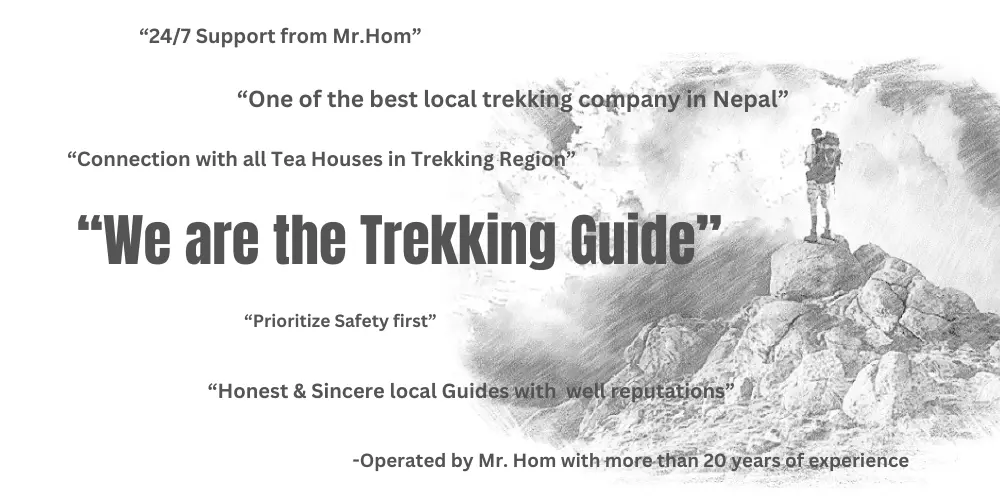
10%-25% Deposit Service Available to Book any Package | Secure Online Payment System
Government Registered Comapny | Check our Legal Documents
We are a Eco-Friendly Tour Operator | Eco-friendly Guides & Porters
Licensed English Speaking Guide | Trained for any Emergencies
No hidden charges, 100% money return upon cancellation of trip | See our Cancellation Policy
Year: Select 2024 2025
Months: Select January February March April May June July August September October November December
Lukla Flight Dates: Choose a month first
Your Message:
Book This Tour
We are affiliated with:.

Nepal Peak Adventure
Nepal Peak Adventure stands as a premier trekking and travel agency dedicated to curating exceptional and memorable journeys in the heart of the Himalayas.

Trekking & Climbing
- Everest Region
- Annapurna Region
- Langtang Region
- Manaslu Region
- Dolpo Region
- Short Treks
- Beginner's Level Climbing
- Intermediate Level Climbing
- Challening Level Climbing
- Legal Documents
- Trekking Guides
- Climbing Guides
- Celebration
Bhagwan Bahal Street, Thamel, Kathmandu- Nepal
What’s App: +977 9841319155
+(977) 9841319155

- Terms & Conditions
- Privacy Policy
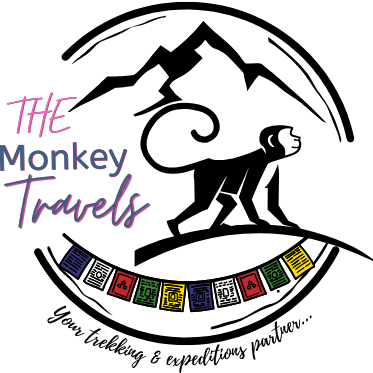
The Monkey Travels
Your Trekking & Expeditions Partner…

3 Passes Standard Trek
Conquer the himalayan heights: embark on the ultimate 3 passes trek with the monkey travels.
For adventure enthusiasts in the Himalayas, The Monkey Travels invites you to experience the excitement of the 3 Passes Trek. Indeed, this exhilarating journey guides you through rugged and stunning landscapes, igniting your spirit of exploration. The trek offers panoramic views that will create a lasting impression on your soul.
The 3 Passes Trek: A Himalayan Odyssey
Unveiling the routes:.
The 3 Passes Trek stands as a Himalayan odyssey linking the well-known Everest Base Camp to the secluded Gokyo Valley. Along this route, hikers cross three high mountain passes: Renjo La Pass, Cho La Pass, and Kongma La Pass. Successfully overcoming each pass requires enduring steep ascents and navigating rocky descents. This trek emerges as a true test of endurance and determination.
Majestic Landscapes:
Start on an exhilarating journey through a vibrant tapestry, unveiling enchanting rhododendron forests and charming local hamlets. Traverse three majestic passes, beholding awe-inspiring vistas of Everest, Lhotse, Makalu, and the majestic Himalayan peaks. Explore the grandeur of the Himalayas on this unforgettable trek.
Gokyo Lakes and Everest Base Camp:
Begin the unique 3 Passes Trek, providing a rare chance to explore the pristine beauty of Gokyo Lakes—captivating turquoise glacial gems nestled in the mountainous landscape. Additionally, delve into the abundant history and culture of this legendary region with a visit to the iconic Everest Base Camp. Hence, immerse yourself in a one-of-a-kind trekking adventure that seamlessly blends natural wonders and cultural exploration.
NOTE: THIS TREK IS CUSTOMIZABLE AND WILL BE CUSTOMIZED AS PER YOUR NEED AND CONVENIENCE.
The monkey travels: crafting unforgettable adventures.
- Expert Guidance: Setting out on the 3 Passes Trek demands meticulous planning and expertise. Additionally, at The Monkey Travels, our team of seasoned guides possesses extensive experience, ensuring that your journey is not only thrilling but also safe and well-supported.
- Customized Itineraries: Recognizing the diverse preferences of our travelers, The Monkey Travels offers customizable itineraries for the 3 Passes Trek. Whether you’re a seasoned trekker looking for an extended adventure or a first-timer seeking a slightly less challenging route, we tailor our packages to suit your needs.
- Safety First: Your safety is our top priority at The Monkey Travels. We implement rigorous safety measures, including acclimatization days, well-maintained equipment, and experienced guides trained in high-altitude rescue techniques. Thus, this ensures a secure and enjoyable trekking experience.
Finally, prepare for your 3 Passes adventure with our comprehensive trekking tips and tricks. Moreover, our blog offers valuable resources, from gear recommendations to fitness routines, ensuring you’re well-prepared for the challenges ahead. Additionally, we provide insights to enhance your trekking experience and make the most of this incredible journey.
Read More on Trekking Tips
Get your trekking backpack.
You can shop for some really reasonably priced and good quality trekking gears at Sonam Gears , Everest Outfit , Lukla Outdoor in Nepal. Notably, some of the most popular trekking backpack items can be found and are manufactured by well-known brands such as The North Face , Patagonia , La Sportiva , Osprey , Black Diamond , Solomon , and so on. If you’re considering updating your trekking gear, these stores offer a range of options at affordable prices. So, explore their selections and gear up for your next adventure with confidence!
- Language English
- Departure from KTM
- Best season March to May, and September to November
- Transportation Airplane
- Fitness level Excellent
- Maximum Altitude 5,545m/18,192ft
- Tour type Extreme/challenging
- Group Size 1-8
- Minimum Age 15
- Maximum Age 60
Overview of Three Passes Trek
Conquer the Everest Region: 3 Passes Trek Overview
Embark on an unforgettable journey through the heart of the Everest region with the 3 Passes Trek. This challenging trek is designed for adventurous souls seeking a thrilling and authentic Himalayan experience. Encounter breathtaking landscapes, rich Sherpa culture, and awe-inspiring views of some of the world’s highest peaks.
Route: The 3 Passes Trek is renowned for its demanding yet exhilarating route. The trek typically starts and ends in Lukla, the gateway to the Everest region. The route takes trekkers across three high mountain passes: Renjo La Pass (5,360 meters), Cho La Pass (5,420 meters), and Kongma La Pass (5,535 meters). Each pass offers a unique set of challenges and rewards, from steep ascents to mesmerizing panoramic views.
Best Time to Trek: The ideal trekking seasons are during the pre-monsoon (spring) from March to May and post-monsoon (fall) from September to November. These periods offer clear skies, stable weather, and optimal trekking conditions.
Embarking on the 3 Passes Trek is a test of endurance and a celebration of the Himalayan spirit. This adventure promises not only the thrill of conquering high mountain passes but also the chance to connect with the natural and cultural wonders of the Everest region. Prepare for the trek of a lifetime as you navigate the challenging terrain and immerse yourself in the awe-inspiring beauty of the Nepalese Himalayas.
Important Notice: Itineraries can change based on the change of weather which often leads to delay/postpone in flights. Therefore, you might want to adjust the number of days you stay at Kathmandu. Here, we do not bear the expenses of additional stay days at Kathmandu other than mentioned in the itinerary. Always trek with experienced guides and ensure your safety as a priority.
Highlights of 3 Passes Trek
- Renjo La Pass (5,360 meters): Start your trek with the ascent of Renjo La, offering breathtaking views of Everest, Cho Oyu, and other peaks.
- Cho La Pass (5,420 meters): Navigate through a challenging glacial route and witness stunning vistas of Ama Dablam and Pumori.
- Kongma La Pass (5,535 meters): Conquer the highest pass, providing panoramic views of the Everest massif and surrounding peaks.
- Everest Base Camp and Kala Patthar
- Sherpa Villages and Culture
- Encounter pristine alpine lakes along the trek, including Gokyo Lake, with its stunning turquoise waters surrounded by snow-capped peaks.
- The raw beauty of the Himalayan wilderness. Enjoy untouched landscapes, dense forests, and high-altitude deserts.
- Unparalleled views of some of the world's highest peaks, including Mount Everest, Lhotse, Makalu, Nuptse, and Ama Dablam.
- Diverse flora and fauna of the Sagarmatha National Park, home to Himalayan tahr, red panda, and various species of colorful alpine flowers.
Kathmandu: 1,350m/4,593ft Your Everest Base Camp trek typically starts in Kathmandu, the vibrant capital of Nepal. Trekkers often spend a day or two here, exploring ancient temples, bustling markets, and preparing for the trek ahead.
Lukla: 2,880m/9,383 ft Phakding: 2,610m/8,563ft Height gain: -270m/-820ft Flight: 47 minutes (Kathmandu to Lukla) : 15 minutes (Ramechhap to Lukla) after a 4.5 hours' drive from Kathmandu. Walking Distance: 7.8 km (3-4 hours) Difficulty: Easy From Kathmandu, a scenic flight takes you to Lukla, the gateway to the Khumbu region. This thrilling flight offers breathtaking views of the Himalayas. Lukla is where your trek truly begins. The first day of trekking usually involves a hike to Phakding (a lunch and dinner spot post breakfast at Lukla). The trail follows the Dudh Koshi River, passing through picturesque villages and lush forests. Phakding serves as the first overnight stop.
NOTE: Flights mostly take place directly from Kathmandu to Lukla. However, during the peak trekking seasons, trekkers would also have to look for an alternative route Kathmandu-Ramechhap-Lukla to avoid having to wait for weeks to find a plane ticket due to heavy air traffic issues. As mentioned above, in case of unavailability of plane tickets we will have to divert our route through Ramechhap. Upon the arrival at Lukla, the trek will continue as mentioned in the itinerary.
Phakding: 2,610m/8,563ft Namche: 3,440m/11,286ft Height gain: 830m/2,723ft Walking Distance: 12 km (6.5-7 hours) Difficulty: Hard En route from Phakding (breakfast place) to Namche Bazaar, the trekkers will come across the famous Tenzing-Hillary bridge near Jorsalle (lunch place), where almost every trekker who have been there takes a picture with the bridge. After an approximately 6.5+ hours walk, the trekkers will enter Namche with a welcoming view of the mountains kissed by the afternoon setting sun. On this day, you will get to view the first view of Everest from Top Dada, on the way to Namche.
Namche: 3,440m/11,286ft Everest View Hotel: 3,880m/12,729ft Height gain: 440m/1,443ft Walking Distance: 6 km (5 hours) Difficulty: Medium After the morning breakfast, the trekkers will be visiting the Sagarmatha National Park, from where you can view the 360degree panoramic scenery of Mt. Everest, Mt. Lhotse, Mt, Nuptse, Mt. Amadablam, Mt. Thamserku, Mt. Tabuche, Mt. Peak 38, Mt. Kongde, and many more. The National Park offers a sight of the Wildlife and Local Culture of Khumbu in the museum that is within the National Park area. There is also a statue of the legendary Climber Mr. Tenzing Norgay Sherpa. Once we're done with the sight-seeing, we shall proceed our hiking towards the famous Everest View Hotel, where we will again be sight-seeing with a great cup of tea. The trekkers can shop for their trekking items at Namche, as and if required.
Namche: 3,440m/11,286ft Tengboche: 3,860m/12,660ft Debouche: 3,710m/ 12,171.92ft Height gain: 420m/1,377ft (Tengboche) : 270m/885.83ft (Debouche) Walking Distance: 10-11.5km Difficulty: Medium After a breakfast at Namche Bazaar, we will reach Somare while enjyoing some of the most amazing mountain views and the breath of fresh air. Once we have our lunch at Phunge Thanga, we will hike to Tengboche Monastery and to the top of Tengboche. After enjoying the view for a good amount of time, we will head back to Tengboche to call it a night. Note: During peak seasons, in case of unavailability of places to stay at Tengboche, we will have to stay at Dibuche (45 mins downhill from Tengboche) after the hike.
Tengboche: 3,860m/12,660ft Debouche: 3,710m/ 12,171.92ft Dingboche: 4,410m/14,469ft Height gain: 550m/1804.46ft (Tengboche) : 700m/2,296.59ft (Debouche) Walking Distance: 11km Difficulty: Medium On this day, we will have our dinner at Somare, and head to Dingboche, where we will be staying one more day for acclimatization. En route, the trekkers can capture mesmerizing views of Mt. Amadablam, Mt. Lhotse, Island Peak, Mt. Thamserku, Mt, Kangtega, Mt. Tabuche, Mt. Chola che, and many more. The village of Somare, Dingboche and the trails following Imja Tshe is known as Imja Valley as these villages are based morraines of Imja glacier.
Dingboche: 4,410m/14,469ft Nang kartshang Hill: 5,121m/16,801ft Height gain: 711m/2,332ft Walking Distance: 2.5 hours/1.5 hours (to and fro) Difficulty: Hard On this particular day, once we have our breakfast, we will hike to Nang Kartshang Hill, a walkable peak above the Dingboche village. The locals call the peak as Nangar-JOONG. Trekkers can view mountains like Kangtega, Ama Dablam, Nuptse, Lhotse, Makalu, Taboche, and many more from the peak. Trekkers can get a clear view of Imja Valley from the top of Nang Kartshang Hill.
Dingboche: 4,410m/14,469ft Chhukung: 4,730m/15,518ft Height gain: 320m/1,049.86ft Walking Distance: 4.5km Difficulty: Easy The morning breakfast takes place at Dingboche, followed by lunch at Chhukung. Then, the trekkers will take a hike to Chhukung-ri (5,546m/18195.54ft), and hike to the top (if possible), else the team will return back to Chhukung, where the team will enjoy their dinner and call it a night.
Chhukung: 4,730m/15,518ft Kongma-la Pass: 5,535m/18159.45ft Lobuche: 4,910m/16,109ft Height gain: 180m/590.55ft Walking Distance: 10-11km Difficulty: Hard Starting from Chhukung at 4,730m, we hike to Lobuche via Kongma-la Pass at 5,535m. The height gain is 180m, covering 10-11km. With a pre-packed lunch, the day's highlight is crossing the Khumbu Glacier. The trek is challenging.
Lobuche: 4,910m/16,109ft Gorekshep: 5,164m/16,942ft Everest Base Camp: 5,364m/17,598ft Height gain: 254m/833ft Walking Distance: 10km Difficulty: Medium We rise early in Lobuche, savoring a hearty breakfast before commencing our trek to Gorakshep. The journey offers gradual ascents, treating us to breathtaking views of the surrounding peaks. After reaching Gorakshep, the last settlement before Everest Base Camp, we take a break for lunch and a brief rest. In the afternoon, we continue our relatively flat trek to Everest Base Camp, maintaining a steady pace due to the increasing altitude. We arrive at Everest Base Camp by 3:30 PM, exploring the area and capturing stunning views until 4:30 PM. As we start the descent back to Gorakshep, we exercise caution on the rocky terrain. In the evening, we reflect on the day, sipping warm drinks, and enjoy dinner. We share our trekking experiences, connecting with fellow travellers, and then rest for the night, eager for the adventures that lie ahead.
Gorekshep: 5,164m/16,942ft Kalapatthar: 5,545m/18,192ft Dzongla: 4,830m/15,850ft Walking Distance: 14-15km Difficulty: Medium-Hard On this day, we embark on a picturesque morning journey by starting from Gorakshep early, where the day unfolds with a trek to Kalapatthar. This iconic vantage point promises breathtaking panoramic views, offering a captivating spectacle of Mount Everest and the surrounding peaks. As the afternoon sets in, gracefully descend from Kalapatthar to Gorakshep. The trek's allure persists as we seamlessly continue towards Dzongla, each step revealing the unique beauty of the Himalayan landscape.
Dzongla: 4,830m/15,850ft Cho-la Pass: 5,420m/17,782ft Dragnak: 4,700m/15419.95ft Walking Distance: 6-7km Difficulty: Hard We start the trek from Dzongla at 4,830m. In the morning, we face the challenge of ascending towards Cho-La Pass, which stands high above, offering stunning views of peaks and glaciers. Then we descend carefully in the afternoon from Cho-La Pass to Dragnak, being mindful of the potential challenges in the descent. There, Dragnak welcomes you with its beauty, nestled in the Himalayan landscape, marking the end of a day filled with both physical and visual exploration in this high-altitude terrain. Note: It's crucial to be well-prepared, both physically and mentally, for the challenges presented by the Cho-La Pass.
Dragnak: 4,700m/15419.95ft Gokyo: 4,700m-5,000m/15,400ft-16,400ft Height gain: 657m/2,155.51ft Walking Distance: 8-9km Difficulty: Medium We begin a fresh day, departing from Dragnak amidst the captivating Himalayan scenery. Our journey takes us on a trek towards Gokyo, renowned for its serene lakes and awe-inspiring mountain vistas. We navigate through the rolling paths, gearing up for the challenging Cho-La Pass to Dragnak stretch, promising a satisfying descent. As we advance, the landscape transforms, unveiling the enchanting beauty of the Gokyo region. This part of the journey becomes a collective experience, blending physical engagement with the sheer visual allure of our surroundings.
Gokyo: 4,700m-5,000m/15,400ft-16,400ft Gokyo Ri: 5,357m/17,575ft Walking Distance: 4-5km Difficulty: Medium Today is a well-deserved rest day in Gokyo, providing an opportunity to recharge and appreciate the stunning surroundings. In the morning, we embark on a hike to Gokyo Ri, a vantage point known for its panoramic views of the Everest region. The ascent may be challenging, but the breathtaking scenery of the Gokyo Lakes and surrounding peaks makes it worthwhile. Take your time to enjoy the vistas, capture memorable moments, and immerse yourself in the tranquil atmosphere. After descending, the rest of the day is free for relaxation and exploration of Gokyo. Whether you choose to stroll around the lakes or simply take in the mountainous beauty, this rest day offers a chance to rejuvenate and soak in the unique charm of Gokyo.
Gokyo: 4,700m-5,000m/15,400ft-16,400ft Renjo-la Pass: 5,360m/17,585 ft Lungden: 4,491m/14,734ft Walking Distance: 12-13km Difficulty: Medium to Difficult Today's journey takes us from Gokyo to Lungden via the scenic Renjo Pass. In the morning, we set out from Gokyo, surrounded by the picturesque landscapes of the Everest region. The trek leads us to Renjo Pass, offering breathtaking views of the surrounding mountains and valleys. The ascent may be challenging, so it's essential to take it at a steady pace, ensuring everyone's well-being. Once at the pass, soak in the spectacular scenery before making a careful descent towards Lungden. The descent may have its own set of challenges, so we proceed with caution. Lungden welcomes us with its unique charm, nestled in the heart of the Himalayas.
Lungden: 4,491m/14,734ft Thamo: 3,600m/11,811ft Walking Distance: 8-10km Difficulty: Medium Today's adventure takes us from Lungden to Thamo, exploring the beautiful landscapes of the Everest region. As we set out in the morning, the trail meanders through charming villages and lush greenery. The trek offers a moderate challenge, with some gradual ascents and descents along the way. Enjoy the serenity of the surrounding mountains and immerse yourself in the local culture as you pass by traditional Sherpa settlements. Around midday, take a break for a packed lunch, provided by the lodge or prepared beforehand. The journey continues in the afternoon, bringing us closer to Thamo. Upon reaching Thamo, take time to relax, perhaps exploring the village and interacting with the locals.
Thamo: 3,600m/11,811ft Chhuma: Walking Distance: 10-12km Difficulty: Moderate Today's journey leads us from Thamo to Chhuma, promising a day of exploration in the heart of the Everest region. As we start the trek in the morning, the trail unfolds through picturesque landscapes and traditional Sherpa villages. The day's trek is moderately challenging, with varying terrains that include gradual ascents and descents. Embrace the tranquility of the mountains and engage with the local culture as we pass by charming settlements. Around midday, we pause for a packed lunch, either provided by the lodge or prepared in advance. The afternoon trek continues, offering glimpses of the unique beauty that surrounds us. Upon reaching Chhuma, take the time to unwind and appreciate the serene surroundings.
Chhuma: Lukla: 2,880m/9,383 ft Walking Distance: 14-16km Difficulty: Medium Our journey from Chhuma to Lukla marks the final leg of our adventure in the Everest region. Starting in the morning, the trail takes us through picturesque landscapes and traditional Sherpa villages. Today's trek is relatively moderate, with some gradual descents and flat stretches. As we bid farewell to the mountainous terrain, take time to absorb the sights and sounds of the surroundings. Around midday, enjoy a packed lunch, either provided by the lodge or prepared in advance. The afternoon trek continues, bringing us closer to Lukla. Upon reaching Lukla, there's a sense of accomplishment and reflection on the incredible journey. In Lukla, we celebrate the completion of the trek, share stories with fellow trekkers, and take a moment to appreciate the Himalayan experience before preparing for the journey back home.
Altitude: 1350m/4428ft Flight time: 35 min So, as the trek will have come to an end, the trekkers will be seen off by the team members at Lukla, to Kathmandu, where you will be having your breakfast of the day.
NOTE: Flights mostly take place directly from Lukla to Kathmandu. However, during the peak trekking seasons, trekkers would also have to look for an alternative route Lukla-Ramechhap-Kathmandu to avoid having to wait for weeks to find a plane ticket due to heavy air traffic issues. As mentioned above, in case of unavailability of plane tickets we will have to divert our route through Ramechhap. Upon the arrival at Ramechhap by air, you will have to take roadways to Kathmandu through a 4-5 hours' drive.
Now, as the journey has come to an end, we bid our trekkers a heartfelt farewell, and see you off to the airport. THANK YOU FOR CHOOSING US TO SERVE YOU!!!
3 PASSES STANDARD PACKAGE
Our services for the package includes:.
- Experienced local guide and porter services.
- Accommodations (common room) in tea houses/lodges along the trek route.
- Three meals a day (breakfast, lunch, and dinner) during the trek.
- Hot beverages 3x a day, to your liking.
- Sagarmatha National Park and Khumbu Pasang Lhamu Rural Municipality permits.
- Round-trip flights between Kathmandu and Lukla.
- Airport transfers in Kathmandu.
- Basic medical kit and emergency evacuation arrangements if needed (Rescue charge not included in the total costs).
- Pre-trek briefing in Kathmandu.
- Certificate of achievement.
- The Monkey Travels' t-shirt or cap, up to your preference.
Our services for the package does not include:
- International airfare to and from Kathmandu.
- Nepal entry visa fees.
- Meals and accommodations in Kathmandu.
- Personal expenses, such as laundry, phone calls, and extra snacks.
- Travel insurance (highly recommended, including coverage for trekking at high altitudes).
- Optional tips for guides, porters, and staff.
- Extra costs incurred due to unforeseen circumstances like natural disasters or flight cancellations. This includes the extra stay days at Kathmandu, and Lukla, before and after the trekking.
- Any additional expenses or activities not specified in the trek package itinerary.
- Phone charging costs, shower charge, wi-fi usage charge, laundry charges that are/may incur on the trekking days.
The most asked questions about the 3 Passes Trek
- The Monkey Travels is birthed by passion, not profit.
- Licensed Trekking guides with First Aid Training, Oxygen & CPR Training along with the Climbing Training.
- We work with local porters, which means creation of local employment opportunities.
- Fair pay and fair treatment to porters, who are often neglected in the trekking & tourism industry.
- Our super-friendly and highly experienced guides have been familiar with the Everest region for more than a decade.
- Young & energetic team members, who believe in sustainable trekking experience.
- Our co-founder, Sonam, himself is equipped is a decade+ long experience as the trekking/climbing guide.
- We are 24/7 available at your service, and also easily accessible.
- Open to feedback as well as criticisms.
- We provide customized trekking itineraries to make your trekking experience extra-ordinary.
The Three Passes Trek primarily relies on teahouse accommodations. Teahouses are lodges scattered along the trail, offering basic rooms with shared facilities. They provide a warm and communal atmosphere, often allowing you to interact with fellow trekkers.
Teahouses usually provide blankets, but it’s advisable to bring your own sleeping bag for hygiene and added warmth. We can recommend suitable options based on the trek’s weather conditions.
While it’s generally not required to book teahouses in advance, especially during the off-peak seasons, we make advance reservations for our clients to ensure a comfortable and seamless experience. This also allows for better planning and allocation of resources.
Yes, we highly recommend hiring a guide and porter for the Three Passes Trek. A knowledgeable guide ensures a safe and well-guided journey, providing insights into the local culture and assisting with any challenges that may arise. Porters help carry your gear, allowing you to enjoy the trek without the burden of a heavy backpack.
As part of our service, we provide experienced and reliable guides and porters. Our team is carefully selected based on their expertise, knowledge of the region, and commitment to ensuring our clients have a memorable and safe trekking experience.
The cost of hiring a guide and porter is included in our comprehensive trekking package. This covers their fees, insurance, food, and accommodation during the trek. You won’t need to worry about additional expenses for the guide and porter.
The optimal times for the Three Passes Trek are spring (March to May) and fall (September to November). During these periods, the weather is generally stable, with clear skies and pleasant temperatures. The trails are at their best, showcasing the stunning landscapes of the Everest region.
At higher elevations, temperatures can drop significantly, especially during the night. We recommend bringing layers of clothing, including a waterproof jacket, insulated layers, and a good quality fleece. Thermal wear, gloves, and a hat are also essential to stay warm in the chilly conditions.
While we plan our treks meticulously, weather conditions in the mountains can be unpredictable. Possible challenges include sudden changes in weather, such as snowfall or rainfall, which may affect trail conditions. Our guides are trained to assess and adapt to such situations for the safety of the trekkers.
The overall cost of the trek is detailed in our comprehensive package, covering permits, accommodations, meals, and guide/porter services. We provide a transparent breakdown of costs so that you have a clear understanding of what is included.
There are no hidden costs or surprise fees. Our pricing is transparent, and we discuss all aspects of the trek, including any potential additional expenses that might arise during the journey.
While some teahouses in more populated areas may accept credit cards, it’s advisable to carry cash for small purchases and emergencies. ATMs are scarce in remote regions, so having cash ensures you have access to essentials.
Physical preparation is crucial for a challenging trek like the Three Passes. We provide a detailed fitness guide as part of our pre-trek information. This includes recommendations for cardiovascular exercises, strength training, and hiking practice to build endurance.
Altitude sickness is a concern at higher elevations. Our trek is designed with gradual ascents to aid acclimatization. We also factor in acclimatization days during the itinerary. Our guides monitor your health, provide guidance on acclimatization, and are trained to handle altitude-related issues.
Safety is our top priority. Our guides are trained in first aid, and we have established evacuation plans in case of emergencies. There are medical facilities in some villages along the trail, and we can assist in arranging emergency evacuations if needed.
We take care of obtaining all necessary permits for the trek on your behalf. This includes the Sagarmatha National Park Entry Permit and the Khumbu Pasang Lhamu Rural Municipality Permit.
While it’s possible to trek independently, we highly recommend a guided tour for a more enriching and safer experience. Our guides provide valuable insights into the local culture, navigate the trails, and ensure your safety throughout the journey.
We adhere to Leave No Trace principles to minimize environmental impact. Our guides brief you on responsible trekking practices, including waste disposal and respecting local customs.
The Three Passes Trek typically takes around 17-20 days. Our itinerary includes acclimatization days and allows for flexibility to accommodate unexpected events or changes in weather conditions.
Internet and phone services are limited in remote areas. While some teahouses may offer Wi-Fi in more populated regions, it’s best to embrace a digital detox during the trek. Limited connectivity adds to the adventure, but you can find some communication facilities in certain spots for essential needs.
- Best Price Guaranteed
- No Booking Fees
- Professional Local Guide
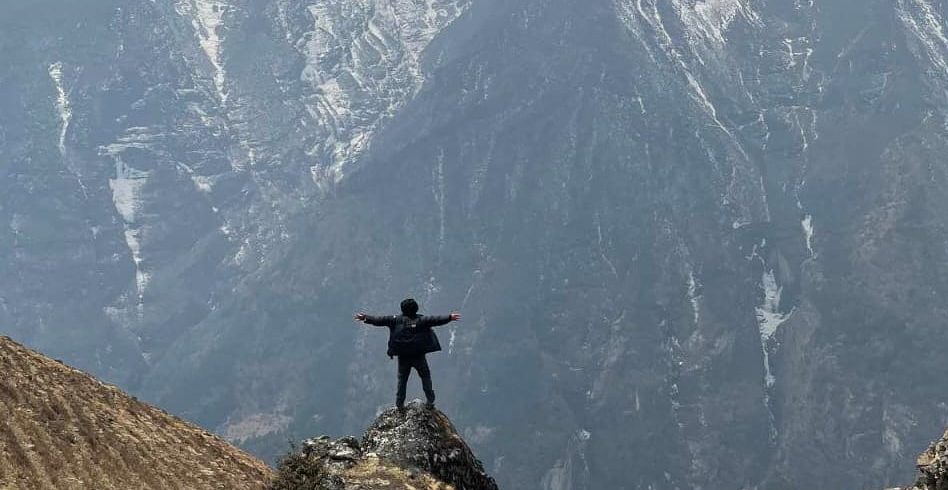
Hiking (4 Trips)
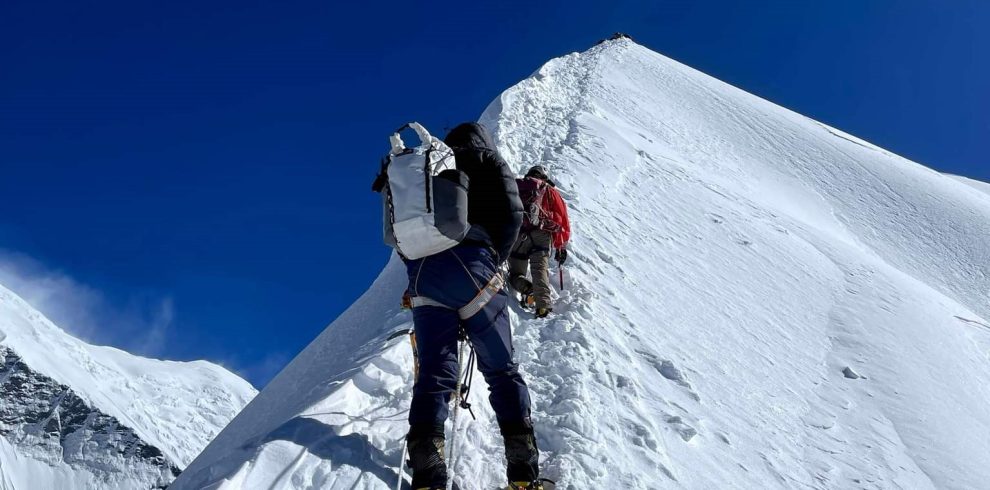
Peak Climbing (2 Trips)
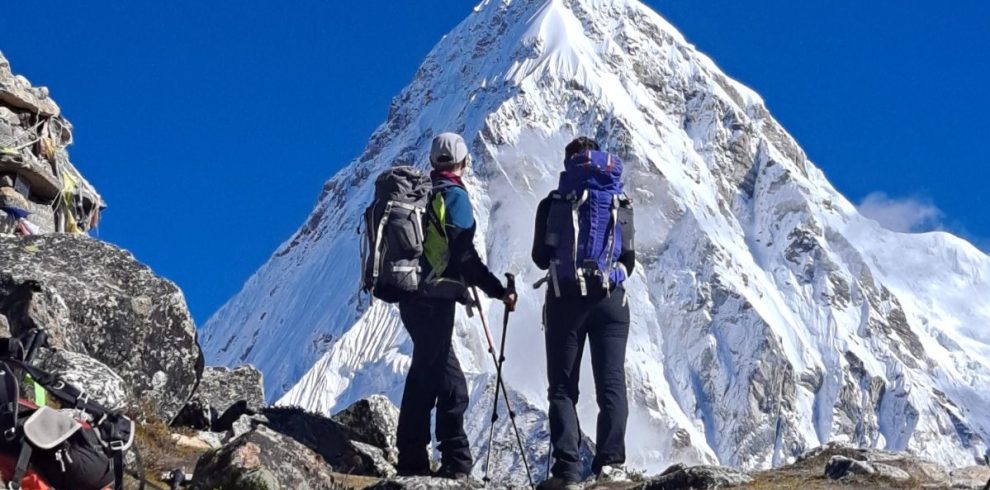
Trekking (11 Trips)

https://www.youtube.com/@Thesonamdiaries
Featured Trips
Related trips.

Namche Bazaar & Khumjung Luxury Trek
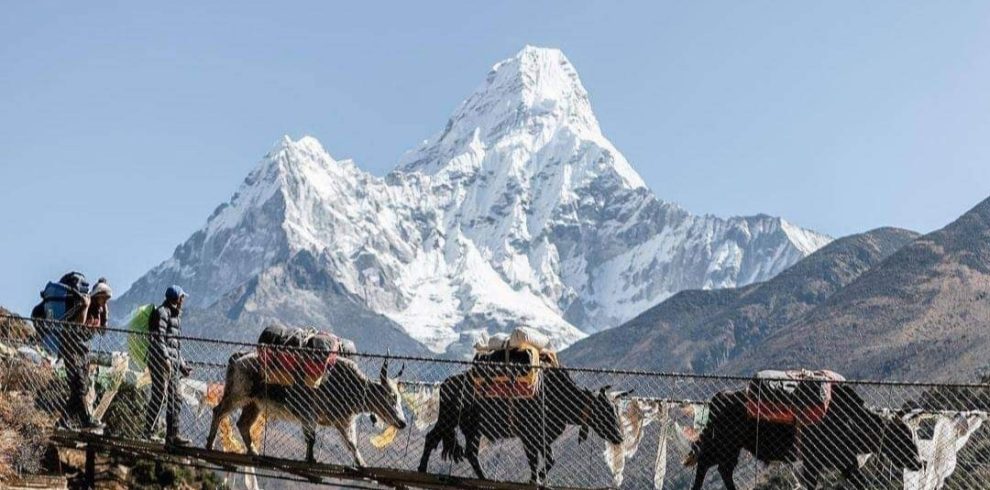
Everest Base Camp – 15 Days Standard Trek

- Mount Kilimanjaro
- Mount Kenya
- Mount Toubkal
- Mount Aconcagua
- Mount Everest
- Mera Peak and Island Peak
- Mount Kinabalu
- Himalayan Mountains
- Borneo treks
- Nepal treks
- Moroccan Atlas treks
- Treks in East Africa
- Trek in Europe
- Wildlife Safaris
- School Expeditions
- Family Holidays
- Medical Electives
- Volunteering
- Private Expeditions
- Indonesia and Papua
- Experiences
- Trip Finder
- Trip Leaders
- Sustainable Tourism
- Adventure blog
- Add a review
- Trip reviews
Ask Us A Question...

- Three Passes & Three Peaks Trek to Everest
Dates & Bookings
If you have a bit more time to really absorb the beauty of the Himalayas then this is the ultimate trek to Everest Base Camp! This really is an extended trek or journey that is a lot more challenging than the standard itinerary as it takes you over three of the Khumbu regions high passes being the Kongma La at 5535m, Cho La at 5420m and the Renjo La at 5340m. This is a full circumnavigation of the region and a stunning trek on a trail less travelled, which also has the opportunity for you to trek to the top of three non technical Himalayan peaks being Chukkung Ri (5550 m), Kala Pattar (5550 m) and Gokyo Ri (5385 m). If you are looking for a trekking challenge with jaw dropping scenery, far fewer people and gaining some achievable summits, without tackling mountains over 6000m such as Island Peak or Mera Peak , then this is the trek for you!
This particular route is best suited to people who like a challenge, are fit and used to multi-day treks. The conditions on the passes can be cold, windy and if the weather is inclement, challenging. We take a anti-clockwise approach as it allows for better acclimatisation and also means the sun is on you in the mornings, as you go over the passes.
We have a long history with this region of Nepal. We have been running treks in Nepal since the early 90's and climbs to the summit of Mount Everest since 2000; we also started and run our own company in Kathmandu. You'll be in good hands with excellent travel advice and tips on weather conditions and what to expect from the moment of booking, through our experienced UK staff and throughout your trek with our highly experienced team on the ground. We provide all permits in advance of your visit and include your meals during the trek.
SUMMARY OF THREE PASSES AND THREE PEAKS TREK TO EVEREST BASE CAMP ITINERARY
A detailed daily itinerary is on the Itinerary tab above: Days 1 & 2 : Arrival and preparation/rest day/ sightseeing in Kathmandu Days 3 - 20 : Fly to Lukla* and under take circular 3 Passes Trek. Reach Everest Base Camp on day 12. Days 21 - 22 : Fly back down to Kathmandu & depart
*If you are not time restricted there are options to travel in and out by road or plane and start / leave below Lukla at Phaplu or Saleri.
THREE PASSES AND THREE PEAKS TREK TO EVEREST BASE CAMP ROUTE MAP
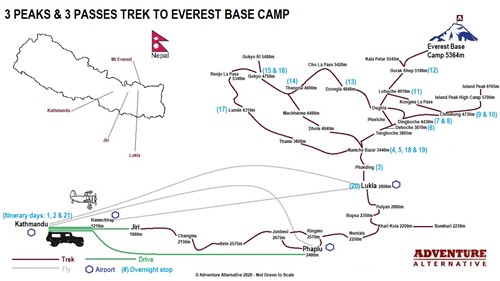
Click on the Map above for a larger version.
THREE PASSES AND THREE PEAKS TREK TO EVEREST BASE CAMP TERRAIN
The trek is on a well trodden path for most of the way though this can be rocky and uneven in parts. It is not precipitous and there is no rock climbing or ‘mountaineering’ which requires equipment. It is a walk all the way, although some of the hills can be steep and never-ending and occasionally on the passes you may need to scramble over some boulders! If the weather is bad then the passes can be slippy and some simple pull on boot spikes (not crampons) can be a handy thing to have in your back pack. Poles are useful, depending on conditions and especially so if you have problems with knees. Higher up, the open slopes and moraine may give you added reassurance with a pole, but again the path is quite easy to follow. The treks high ascents to Chukkung Ri (5550 m), Kala Pattar (5550 m) and Gokyo Ri (5385 m) are not difficult nor technical in any way but occasionally can be slippery underfoot. Medium weight hiking boots with a high ankle are recommended for this trek, to protect you against possibly going over on an ankle and ensure that they're big enough to add warm socks when up high and don't forget that your feet will swell slightly at altitude. You can use heavier boots if you like, but they can be hot, heavy and cumbersome lower down, in which case also bring a pair of trek shoes or cross trainers for that section.
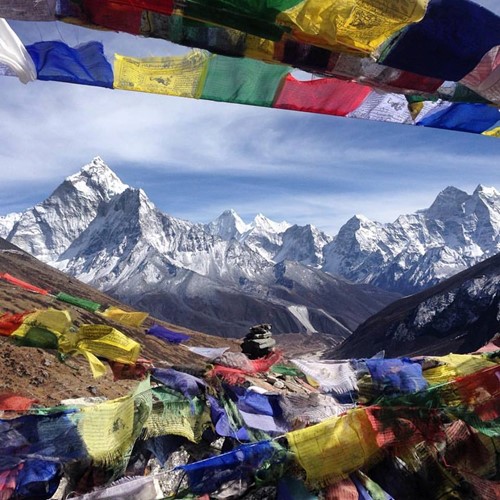
3 PASSES AND 3 PEAKS ALTITUDE PROFILE
Our trek takes you to altitude over a controlled period of time. We don't go over 5000m until day 10 of the itinerary or day 8 of the trek, which compared to the likes of Kilimanjaro is a lot slower giving you a good amount of time to acclimatise effectively. Only at Gorak Shep do we sleep above 5000 m and for one night. This is a challenging trek with high passes and three possible summits meaning that we go above 5000m on seven different occasions, but with a responsible itinerary that should give you a maximum amount of time to acclimatise.
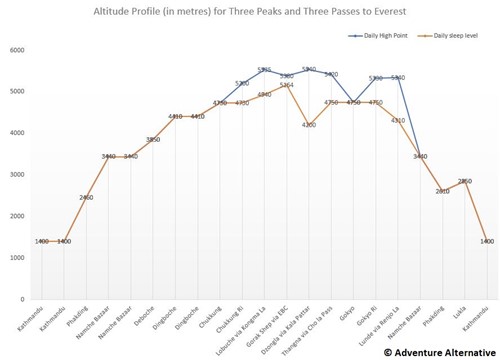
ACCOMMODATION ON THE THREE PASSES AND THREE PEAKS TREK TO EVEREST BASE CAMP
Accommodation on the trek will be in comfortable lodges run by local families, unless people specify a preference for tents. Each lodge has a central communal area with stove, while the bedrooms are unheated with two beds and mattresses, blanket and pillows. You will need to bring a sleeping bag (3 season is normally enough). The lodges generally have showers which are powered by gas and some use the infamous ‘drop’ toilets, though most now have flush systems now.
Food on the trek is very good quality, and a mixture of local Nepali / Sherpa food and western recipes. Burgers and chips are a common meal, as is dal bhat with rice. You will find everything from fresh pastries to beer, stir fries to deep fried Mars bars available in the lodges and shops a Nepal price guide can be found here . And there are many shops selling all types of drinks and snacks, sweets and chocolate. The biggest challenge will be avoiding all the unhealthy foods and sticking to a simple diet of rice and dal!
PACKING LIST FOR THE THREE PASSES AND THREE PEAKS TREK TO EVEREST BASE CAMP
The basic idea of the kit that you need to take is to keep you warm, dry, protected from the sun, able to move comfortably in the mountains and able to be comfortable in the evenings and at night.
You will be given a detailed kit list after booking, but the main points to cover are as follows:-
- BAGS - Rucksack or duffle bag for a porter to carry plus a day pack to be carried by you
- SHELL - Top and bottom waterproofs to keep off wind/rain
- LAYERS - Shirts, trousers, shorts, Tshirts, jumpers and jackets, hats and gloves
- BASELAYER - Thin layers to wick away any sweat and to wear for cold mornings
- FEET - Comfortable boots with a good sole and ankle support. Lighter footwear to change into in the evenings.
- SLEEPING - Warm sleeping bag (3 or 4 season) to get a good nights sleep at the lodges (they also have blankets)
- DRINKING - Water bottles should be hard plastic (Nalgene), not throwaway bottles.
- WASHING & MEDICAL - wash kit, towel, first aid kit
- SUN CARE - sunglasses, sunhat
- TREKKING - trekking poles, umbrella, dry bags
- PERSONAL ITEMS - cameras, books, music
We also hire lot's of equipment which can be seen in the 'Extras' tab. If you look at the 'More Information' section you will find in-depth details covering a Packing List for Nepal , Trekking Boots , Sleeping bags and Local prices . In Kathmandu has an area called Thamel which is full of hundreds of equipment shops, each one an emporium of new, used, quality and fake equipment all very reasonably priced for rental and buying. You can buy almost anything needed for any trek.
If you have any questions about what kit to bring then to please call or email us. Do consider this is a long trek though it is possible to wash items en route however drying them can at times be difficult, especially higher up, though there are rest days. You must be prepared for cold conditions on the passes and peaks, hopefully that won't be the case, but best to prepare with good insulating layers and windproof outer shells.
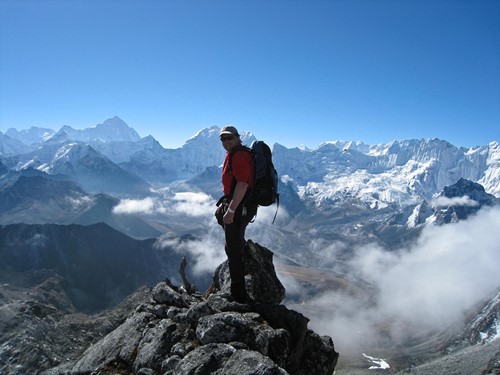
FREQUENTLY ASKED QUESTIONS (FAQS) FOR THE THREE PASSES AND THREE PEAKS TREK TO EVEREST BASE CAMP
How fit do i need to be for the three passes and three peaks trek to everest base camp.
Doing a trek for twenty days straight inevitably is tiring and it's certainly a benefit to be fit, but don't forget that during the trek you are exercising every day and you will end up wonderfully mountain fit and weather beaten! Come back toned, healthy, detoxed and several kilos lighter!
So do train beforehand, do lots of walking with a day sack, but don't overdo it. It's not a marathon, but there are lots of hills to go up and down! The high passes are quite challenging, especially in inclement weather. Work on your thigh muscles, calf muscles and shoulders for carrying the bag (it's only about 5kg but it feels like 10 when you've been walking uphill in the sun). The days vary with a few short and acclimatisation days but a few are longer days. The main paths are fine, but the passes can be slippy and a set of boot spikes, rather than full on crampons can be handy, plus at times there can be boulders to cross. The porters help a lot, but the enjoyment of this trip will be much more if you have worked on your fitness before going.
The trek is not a forced march and the pace is always slow, the days generally being shorter than a day hike at home. You are likely to carry about 5 kilos in your day sack so this is a good weight to work with. If you are going to be using the gym then concentrate on step machines which work on the thigh and calf muscles, and try to build your heart rate up to 50% above resting rate. Any cardiovascular activity is good, but remember that swimming will not train the correct muscle groups so it must be added to other exercises to be effective. Exercise groups like bodypump, Pilates and aerobic are all excellent preparation for a trek like this, especially those which work on core strength, balance and stability.
WHAT HAPPENS IF I MEET A YAK WHILST TREKKING IN NEPAL?
You will meet many people along the way, and also yaks. There is only one rule of the road when meeting an oncoming yak, and that is to always ensure you step to one side, towards the inside of the trail, to avoid the cliff edge on the other side!
WHAT SUPPORT WILL I HAVE WHEN ON THE THREE PASSES AND THREE PEAKS TREK TO EVEREST BASE CAMP?
The porters will carry your main bag up to a maximum weight of 14 kgs and cater for all the group needs, including assisting you if you need to go back down the valley. Unless specifically tenting, all accommodation is in lodges or tea houses which are very well equipped, warm and sociable.
The guides all speak English and are qualified and experienced. They will be on hand to help you all the time and guide the route as well as talk about the country and the people. Furthermore:-
- All our guides are personally trained by Gavin Bate, Company Director and high altitude climber
- We do not contract out our trips, we employ full time staff, offering job security and good benefits, and we are continually improving our quality service year on year.
- We follow the IPPG five guidelines on porter safety
- Porters' health and welfare is constantly monitored by local and UK trekking group leaders.
- All the staff in our UK office have been to Nepal so you can chat to people who understand what its like to go up for the first time, before you go.
- We are a company founded and run by people who are passionate about trekking, climbing and exploring in the world's most beautiful wildernesses.

Do have a read of our various Blogs about treks in Nepal and also the 'More Information' section, both have tabs on this page and will answer every question you may have! We also have a lot of useful information on our Nepal Preparation page.
You'll find the trek dates on the 'Dates and Bookings' tab, however we welcome private dates and can adapt the itinerary to suit your preferences - more details can be found under the 'Cost' tab.
The first date shown is the date that should arrive into Kathmandu. This is followed by a rest and briefing day when you can explore the vibrant capital. On day 3 of the itinerary we fly to Lukla, which takes 35 minutes. The trek is nineteen days circling the passes and Khumbu Valley anti-clockwise, which includes three full days rest and acclimatisation. We always allow a bad weather day for flying into or out of Lukla and the end date refers to the earliest you can book your return flight home from Kathmandu.
Detailed Itinerary Three Passes and Three Peaks Trek to Everest
Lukla flight.
The Lukla flights fly-by-sight, so if there is bad weather there can be delays, which occurs in about 30% of all trips with an average delay being 24 hours. We can be flexible and adapt the itinerary to catch up on lost days, and we include a weather day in the itinerary, but if the planes can’t fly then there is little to do except wait.
Occasionally the planes can’t fly but helicopters can; if you prefer this option, and there is group consensus, we can organise this but there would be a supplemental charge which is normally around $500 per person one way. Please look at our Delayed Flight page so you are fully informed and do consider booking your holiday for a day or so longer just in case you do end up with a delay.
RAMECHHAP / MANTHALI AIRPORT
Over recent years there has been a change, sometimes with little notice, regarding the airport you fly from to reach / return from Lukla. Traditionally, and still occasionally, you fly from Kathmandu airport, however there are now (mostly) regular seasonal changes that have moved the flight to depart / return from Manthali Airport, which is in a place called Ramechhap. If your flight does depart from Ramechhap we will let you know in advance, as far as possible, as this will impact your itinerary slightly, and there will be additional costs as the airport is a four hour drive from Kathmandu.
We prefer to make this journey on your rest and briefing day (day 2 of the itinerary). Some make this journey at 2am on the day you fly up to Lukla, but this can lead to you being very tired and a very long day. We prefer to drive on the afternoon of day 2 of your itinerary, so that you can relax on the morning of day 2, then enjoy the drive in daylight through the beautiful countryside and communities that you pass en route. This means you will arrive at a decent time to have dinner and get a good nights sleep before you fly up the next morning and start trekking.
If this applies to you then there are additional costs for 1) return road transport to / from Ramechhap and 2) accommodation. You will be accompanied and travel with your trek guide. You will of course save some money with one less night in your Kathmandu hotel. These costs are paid in country to our co-ordinator and they vary depending on the size of the group / vehicle required. As an estimate they can range from £70pp to £140pp for a return land journey and an overnight stay in a local hotel for you and your guide. We will book and manage all of this for you.
Three Passes and Three Peaks Trek: £2225.00 per person
- Airport transfers (to / from Kathmandu airport to Kathmandu, for international & Lukla flights)
- Accommodation in lodges/tea houses (twin rooms with beds and mattresses) during the trek
- All meals on trek (3 meals a day), with a hot drink
- National Park Fees & Permit
- Sherpa guides (English speaking, trained in first aid)
- Staff food, insurance and equipment
- International flight to Kathmandu (~£550-650)
- Accommodation in Kathmandu (~ £15 - £25pp/n) - we can book this for you. Click here for details or check out www.booking.com
- Transfers to / from Ramechhap airport 'IF' required (see 'Lukla Flights' below)
- Meals and drinks in Kathmandu (~50-100)
- Personal costs on trek, e.g cold drinks, laundry, hot showers, bottled water (~£50)
- Travel Insurance (~£50-100) must cover trekking at altitude & helicopter rescue in the event of an evacuation
- Visa (~$30)
- Tips (~£60)
- Sightseeing Tours
Dates and Private treks in Nepal
Alongside our advertised trek dates, which you'll find under the 'Dates & Bookings' tab, we also have the ability to provide bespoke climbs and treks on dates that suit you. Our prices are based on 4 trekkers, so if there are less on your bespoke dates, there would be a supplemental charge (contact us for a quote on [email protected]). We also run many treks and climbs for charities, family holidays, walking clubs, schools, universities, groups of friends and for corporate challenges. If you have more than four people we can offer discounts.
Please Note:
Luka Flights - Over recent years there has been a change, sometimes with little notice, of which airport you fly from to reach / return from Lukla. Traditionally, and still occasionally, you fly from Kathmandu airport, however there are now (mostly) regular seasonal changes that have moved the flight to depart / return from Manthali Airport, which is in a place called Ramechhap. If your flight does depart from Ramechhap we will let you know in advance, as far as possible, as this will impact your itinerary slightly and there will be additional costs as the airport is a four hour drive from Kathmandu.
We prefer to make this journey on your rest and briefing day. Some make this journey at 2am on the day you fly up to Lukla, but this can lead to you being very tired and a very long day. We prefer to drive on the afternoon of day 2 of your itinerary, so that you can relax on the morning of day 2, then enjoy the drive in daylight and get to see the beautiful countryside and communities that you pass through. Then arrive at a decent time to get a good nights sleep before you fly up the next day and start trekking.
If this applies to you then there are additional costs for 1) return transport to Ramechhap and 2) accommodation. You will be accompanied and travel with your trek guide. You will of course save some money with one less night in your Kathmandu hotel. The travel costs are paid in country to our co-ordinator and they vary depending on the size of the group / vehicle required. As an estimate they can range from £70pp to £140pp for a return land journey and an overnight stay in a local hotel for you and your guide. We will book and manage all of this for you.
Hotels - We don't include your hotel in Kathmandu as there is such a wide range of choice and styles for all budgets. We offer some recommendations which you can see on the Extras tab and can confirm during your booking process or after. Hotels will usually transfer you from the airport, but if not we're happy to do so.
Meals on Trek - We include three meals per day whilst on trek. It is a common practise on cheaper treks to have a food kitty which would normally add £400 - £500 per person to the cost of a trek, but we provide all meals within the trip price.
Payments - A deposit of £100.00 is required on booking to secure your place and we ask that the remaining balance (trip price minus the deposit) is paid in full 6 weeks prior to your departure. When you book with us you're given your own secure online account which you can access 24/7. Through this account you can edit your booking, add flight, health, insurance and dietary details and also make interim payments. We make payments as flexible as possible and you can choose, if you wish, to pay a bit off your trip fee whenever it suits you.
Value for money - Our prices are competitive and good value, and we offer quality, service, security and an ethical stance on tourism in a developing country. We don’t want to be so expensive to run fewer trips and have our staff idle, but on the other hand we believe that running cheap trips that promote the practice of skimming budgets would result in the porters getting next to nothing, which is something we cannot consider. Acclimatisation - Our treks allow a good time to acclimatise and as a mountain guiding outfit we always want to ensure the trek is safe. Reducing the number of days may make the price cheaper but the chances of safely reaching base camp also greatly reduce. We follow established mountaineering principles of height gain on all treks to altitude. Travel Insurance - As soon as you book you should purchase a policy which covers trekking to 5500m this will cover you should any unexpected events force you to cancel. Your policy should also include helicopter rescue in the event of an evacuation.
FLIGHT DELAYS IN LUKLA
The mountain flight in and out of Lukla which is where most treks begin and end in the Khumbu (Everest) region can be delayed due to bad weather. Normally it is for about 24 hours but it can be longer. We recommend you allow some time in Kathmandu after the specified day of the internal flight just in case. There is more information about Himalayan flight delays.
Some people choose to cancel the internal flight and book a helicopter which can fly below the cloud level and is not so determined by the weather. This is possible but there are no fixed prices for a seat on the helicopter. There are now around 12 helicopter companies operating and we can check them all for you.
For a one way place on the helicopter to Lukla can cost around $500.00 minimum. The cancelled portion of your aeroplane flight can be refunded and used to offset this figure, which is about $170.00 for a one way sector, so there would be a balance to pay for the helicopter. You can use your credit card to cover off this additional expenditure.
Unfortunately there is nothing we can do if the flight is delayed. Sometimes you can end up waiting in the airport from early hours to get the 'green light' to go, only to find yourself back in the hotel by mid morning. People do get very frustrated because it can impact on the trekking itinerary. A helicopter is one option, or else to wait until the weather improves. However, if it does not then very quickly a queue of people at either end can build up, and it is always hard to get priority for when the weather clears. The airline companies put as many planes on as possible to clear the backlog.
We try to assist as best we can, but it's important to accept that the route has this potential delay and also that it's advisable to book the international flight home a little later in case the delay affects your return ticket.
There is another option which is to drive to Paphlu and then take a jeep on the new road as far as it will go and then walk to Lukla. This option takes more days - two in total each way currently - and there is a saving but only of about $70 compared to the flight.
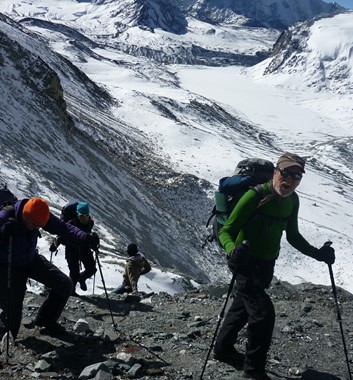
These duffles are waterproof with a top zip, side handles and rucksack straps. They come in two sizes: 90 or 120 litres.

3 season sleeping bag
A good quality 3 season synthetic mummy shaped bag rated to a low of -12°C and a comfort rating of -5°C. Comes with a liner.

Trekking poles
A pair of adjustable trekking poles.

Climbing Helmet
Wild Country Fusion (fits head circumference 56-63cm). Polypropylene shell with EPS foam inner, with twistlock and adjustable chinstrap and headlight mount.

Hotel Manang
3 nights twin/double standard room in the heart of Thamel in Kathmandu. Hotel Manang is a 4 star establishment with excellent facilities, spacious ensuite rooms and a good restaurant.

Yak and Yeti Hotel
3 nights twin/double standard room in this luxury 5 star hotel offering a blend of modern day sophistication and cultural heritage with its 100-year-old palace and the newly designed structure of the hotel.

Kathmandu Guest House
3 nights B&B in a standard twin or double in the famous 4 star Kathmandu Guest House in Thamel, central Kathmandu. KTMGH is set in beautiful grounds with a number of restaurants and gardens, shops and museum pieces.

Kathmandu Eco Hotel
Budget hotel near city centre, price is for 3 nights double or twin room.
Choose a scheduled date or contact us to set up private dates or a bespoke itinerary. The minimum deposit is £100.00 and the balance is due four weeks before travel.
This is a challenging trek with high passes and peaks that are above 5000m. 7 times we go above 5000m however the itinerary allows for good acclimatisation. A good standard of fitness is required however the reward is the best views that Nepal's Himalaya can offer!
- Accommodation in Kathmandu
- How hard is it to trek to Everest Base camp?
- Common mistakes people make on mountains
- Nepal named as No.1 travel destination in 2017
- Happy New Year Nepal!
- What's alternative about Adventure Alternative?
- Nepal trek food & lodging
- Nepal trekking seasons
- Nepal Trek emergencies
- Nepal trip preparation
- Health and altitude
- Nepal Seasons
- Mountaineering Preparation
- Trekking boot advice
- High altitude climbing
- Acclimatising safely
- Kathmandu Accommodation
- Nepal trek kit list
- Nepal: Local price guide
- Hygiene on trek
- Travel vaccinations
- Sleeping bag advice
- Porters rights
- Himalayan Flight Delays
- Guest House in Kathmandu
- Island Peak, 6189m
- Everest Base Camp trek
- Gokyo Lakes trek
- Khumbu Peaks
- Mera Peak, 6476m
- Baltic Equities
- Cryptocurrencies
- Outta bubble
- Personal Growth
- Social Conditioning
- Best of Internet
- Musical Inspiration
- Short Quotes
- Professional Photography
- Alternative Artistic Mastery
- Tolerable Shots
- About Generalist
- Got a question?
Recent Posts
- Reviewing Lesser Known Movies (Part 2)
- Annual Portfolio Overview & Market Outlook for 2024
- Reviewing Lesser Known Movies (Part 1)
- Thieve in the Wire
- Essentials for Alta Via 2: A 9-Day Hike Guide In Italian Dolomites
Stay in touch
Email address:
Prefer Twitter?
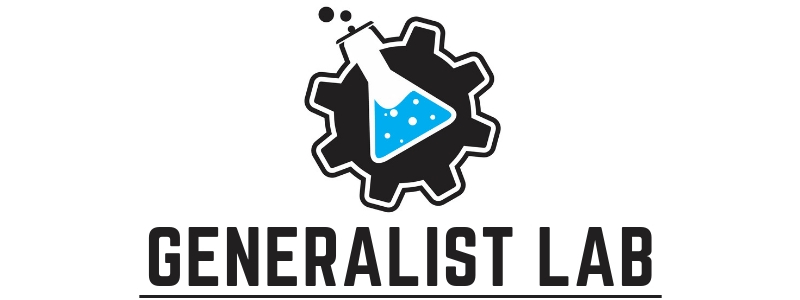
Nepal’s Three Passes Trek – Tips for Solo Travelers
Trekking and climbing in Nepal’s Himalayas happens in one of two season openings: Spring (late March-May) and Autumn (October-November). We (2 guys) landed in Kathmandu on evening of 2022 April 2 and flew back on April 23. Health condition slightly modified our journey to two passes, but nonetheless we climbed 4 peaks , walked 170-180 kilometers , slept and conquered steps above 5000m elevation . This is the story, lessons and hopefully practical tips embedded in the text to anyone going after Three Passes Trek and Everest Base Camp .
Three Passes Route
Three Passes Trek route is well established, basic outline could be seen below. From Namche Bazaar that’s a closed loop that will take you somewhere between 10 to 14 days including acclimatization days, several summits and visiting Everest Base Camp (EBC).
If you want a high resolution map, that we bought in Kathmandu Tourism Center, click here .

We had offline Maps.me, which was sufficient for unguided hike. Compared to European Alps – there are barely any signs, but they are not needed. Area is vast and only few paths and plenty of people on the way.
But before trek, there’s Kathmandu and a drama with flights.
Day #-1: Arrival to Kathmandu
It was already dark when we landed. Airport is in the city and hotels are within 5-10 minute walk from terminal. There’s tourist district Thamel within Kathmandu, but if you plan to leave for Lukla the next day, there’s no point going there, save it for after trek treat (more on that in the end). Prepare to break taxi drivers hearts with your cold rejection near airport.
We had booked “OYO” branded hotel through booking.com and failed (even with aid from local hotel owners within nearby streets) to locate it. Walked in and arranged a night at another hotel.
Checked in, filled hand with relatively expensive local beer and went for a walk.
Newari Festival
We talked to several guys with beers too and they invited us to Newari (local ethnic group) festival going on in temple territory nearby. Of course we couldn’t skip on free accidental cultural excursion.
Much people (youth mainly), sound and positive energy. Two mythical gods fighting each other.
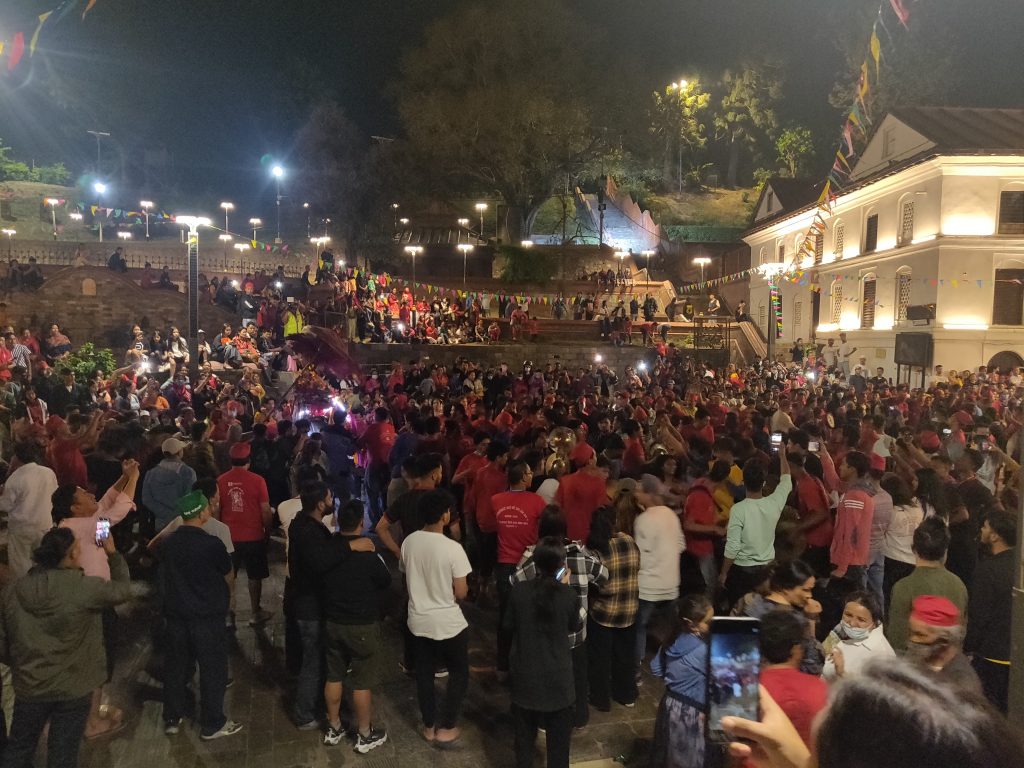
On the way we also met the opposite energy. Dead bodies are being burned for 24 hours near this river.
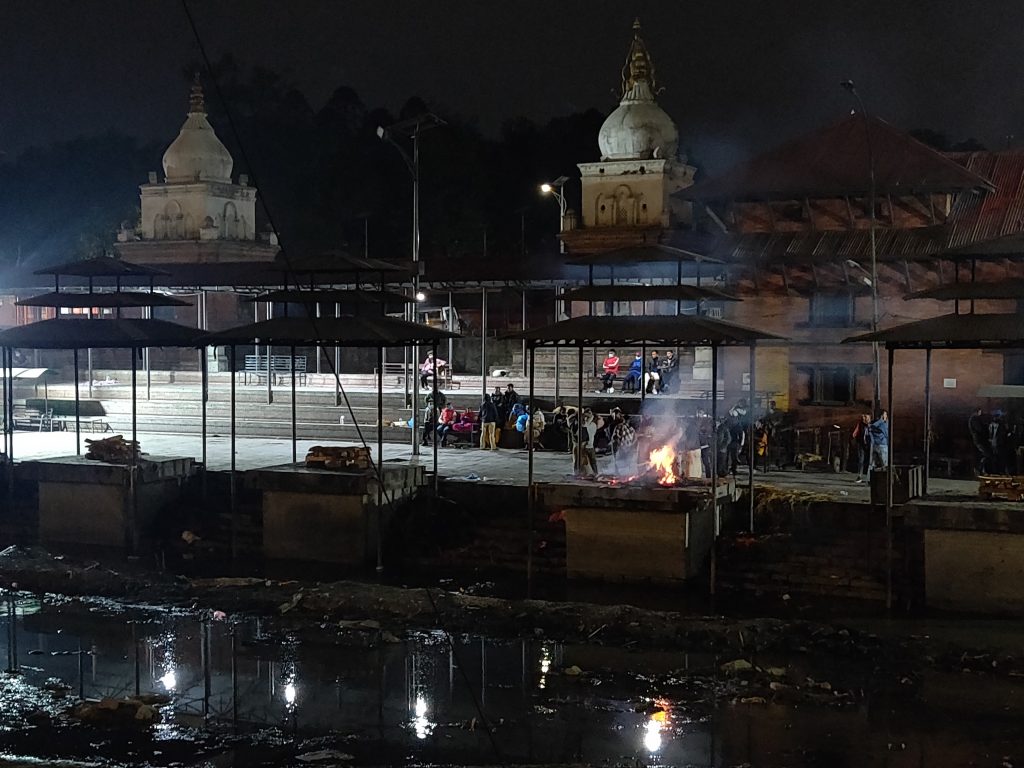
Day #0: No Lukla Flights
Trek starts at Lukla. There are 4-5 local airlines flying there. We had booked a flight before with departure time of something like 9:30 in the morning. However that morning it was too cloudy and no flights to Lukla were talking place. First setback of the trip.
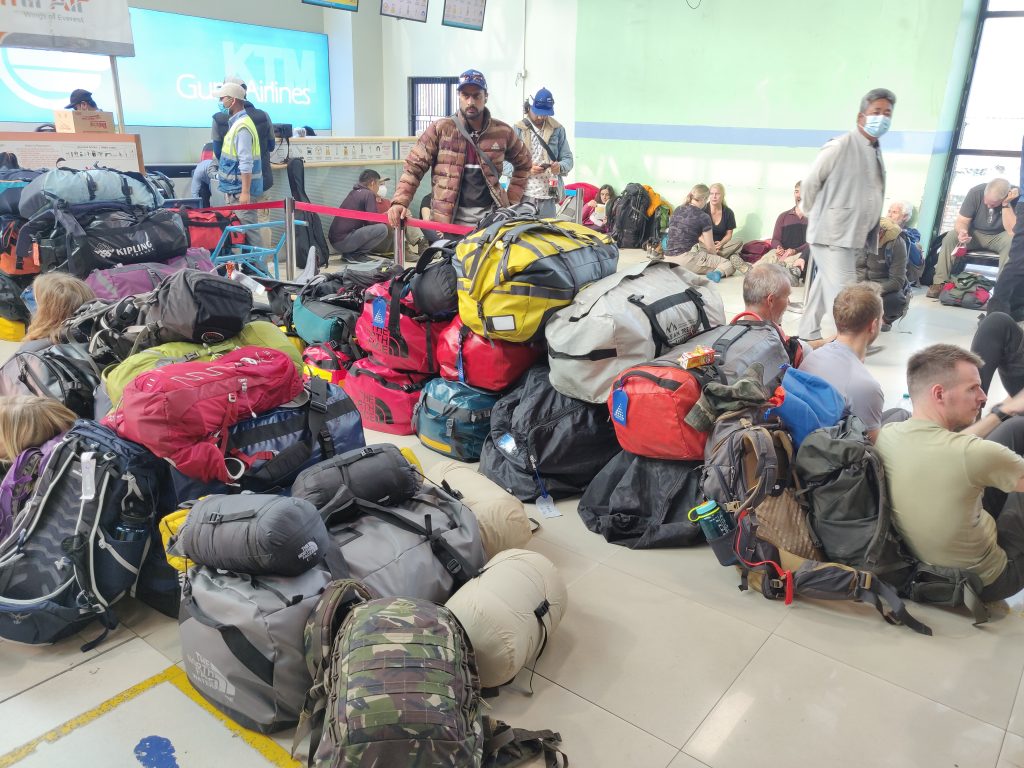
From what we gathered in the airport:
So we have a day to compile all possible options and resolve a conflicting information online about TIMS card at Kathmandu Tourist Center (for Three Passes Trek you DO NOT need TIMS ). Travel options ultimately boil to:
- do nothing, hope for better weather and flights tomorrow;
- take a helicopter to Lukla (400-500 USD/person). Helis are more adaptive to weather and fly more often;
- take a whole day jeep drive to Salleri and another 2 days trek to get to Lukla;
- [after talking with multiple agencies] book earlier time flight for tomorrow (08:00) and change original tickets to return – bingo.
Airlines are reasonable and flexible about cancel and refunds, change of flight dates and in our case even direction (from KAT -> LUK to LUK -> KAT).
This day we took like 5 taxi drives, so:
Day #1: Lukla after Half Day in Airport
We were at airport 5:30 and took off around 12:30. I don’t even want to remember the nerve-wracking experience near airline stand and later the gates. One picture captures the waiting spirit well:
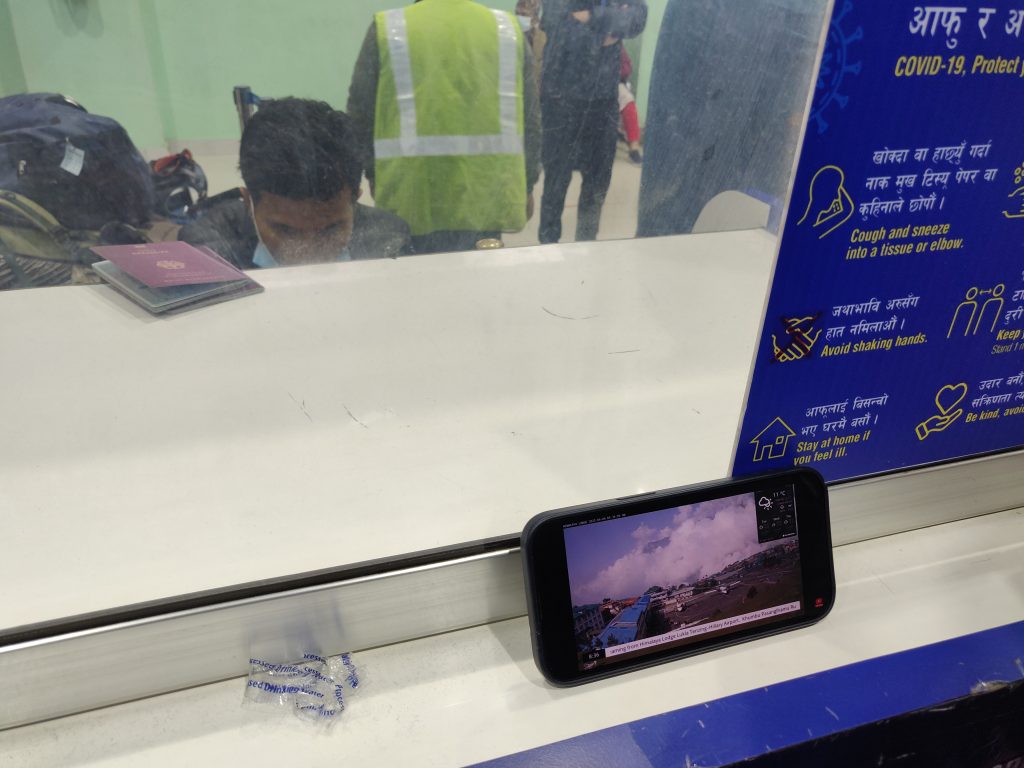
Finally on the trek
After a shaky flight and even more stressful landing we could put flight related worries to rest for at least 2 weeks. We got to Lukla (2840m above sea level).
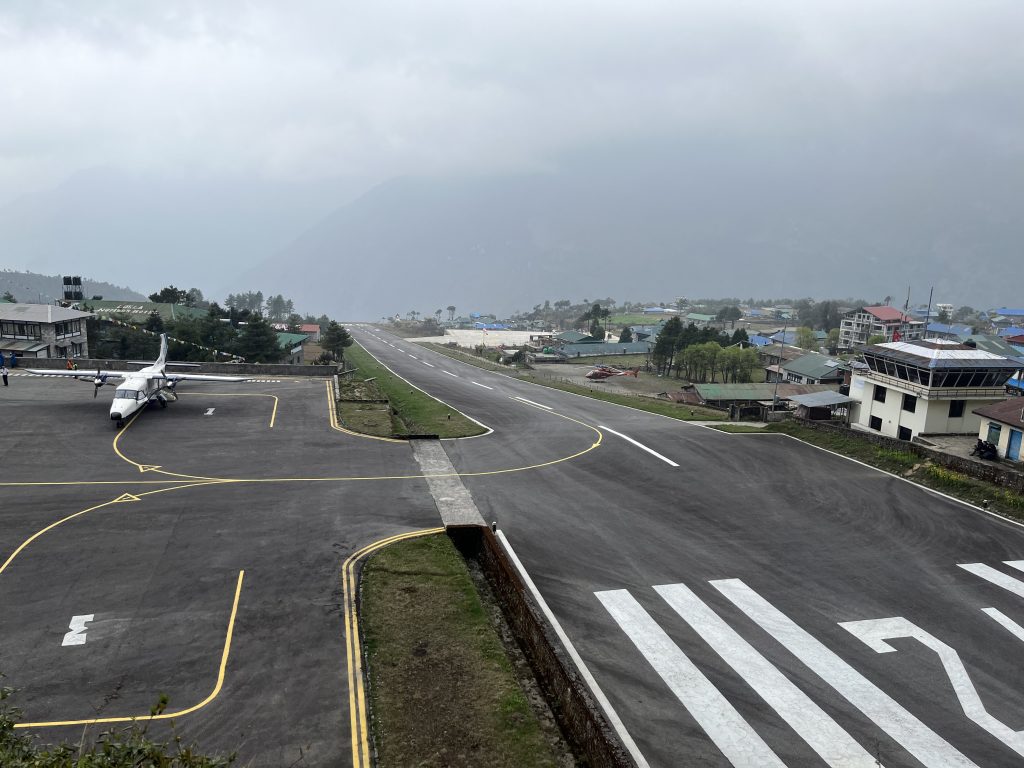
And so it begins…
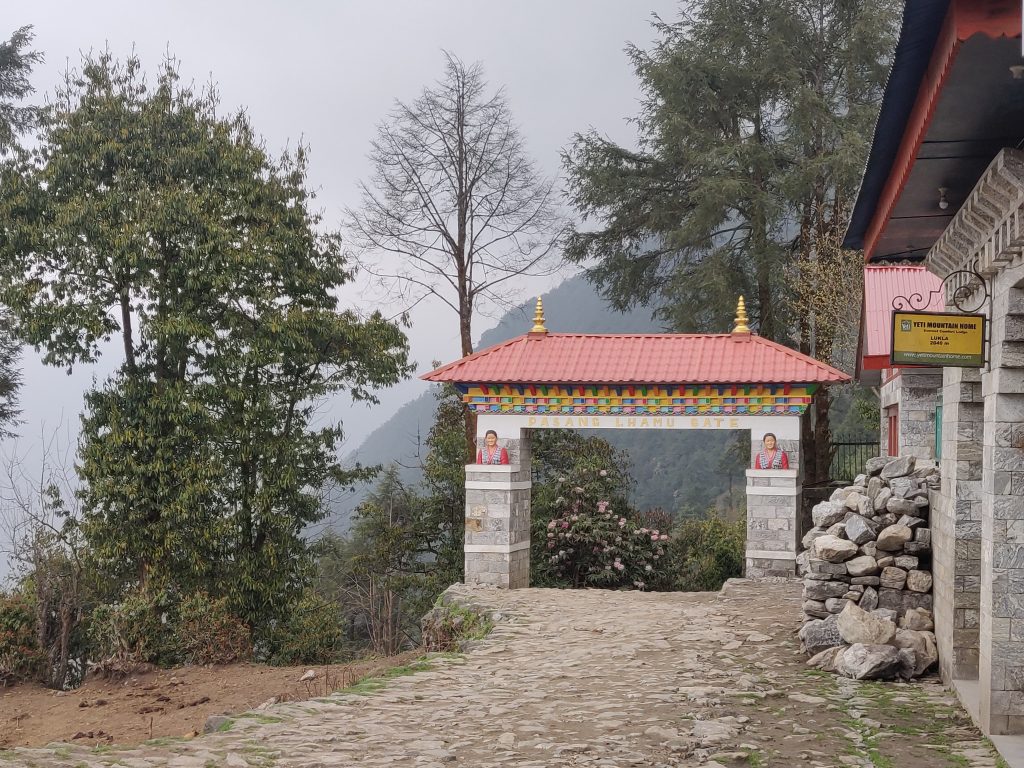
We got to buy our first trekking permit for Sagarmatha National Park just outside of Lukla for 2000 NPR per person (~15 EUR). So also loaded on cash at Lukla, although the are also last ATMs available at Namche Bazaar before “real” trek starts.
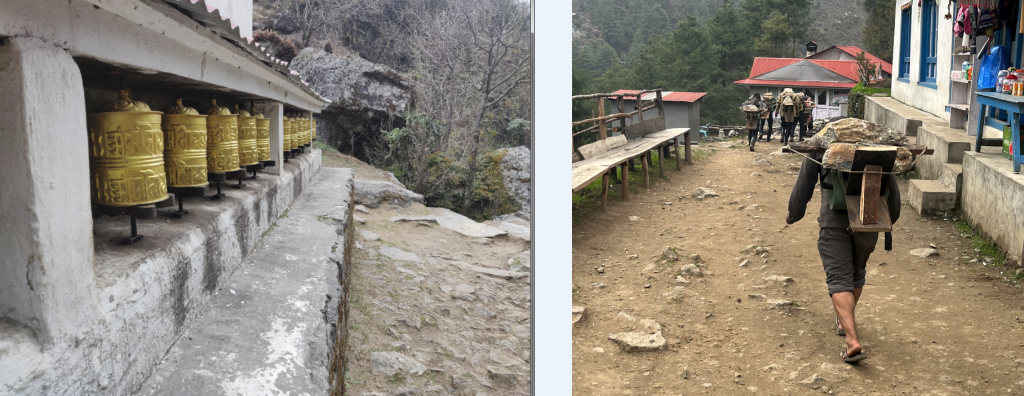
Although our initial target stop was Monjo (2835m) we settled for 200 NPR (1.5 EUR for both, it’s the food, that lodges make the money on) at a lodge just after Tok Tok (2760m).
Water Treatment
I have a marked tip:
So perhaps it’s worth mentioning about water situation. It’s all bottled in Kathmandu. When on trek, there are water purifying tablets that change taste (or add additional tablets to treat taste…), UV light filters and a machanical – bacteriological filter we used and found no problems with it. It’s ~30 EUR investment for 1000 litres throughput lifetime.
I was consulted by a more serious climber – shop owner, Nepal waters have no viruses, it’s the bacteries one must protect his gut from. I lost the filter and we drank water directly after 2/3 of trek was done and eventually both got sick in Kathmandu. These may or may not be related, but majority of tourists treat the water they drink one way or another.
Stay Vegetarian
Meat is sort of luxury in Nepal. Lack of refrigeration casts doubt over quality of meat in mountains. Try local dishes, some of them are really good! Also helps environment. At higher altitudes, it was common to hear people vomiting in the bathroom. It’s 80% altitude sickness I suppose, but worth mentioning regardless.
Day #2: Reaching the Namche Bazaar “Base”
At Monjo, there’s a second round of permit buying. 3000 NPR per person this time. It’s a less cloudy day and we can see the valleys more clearly.
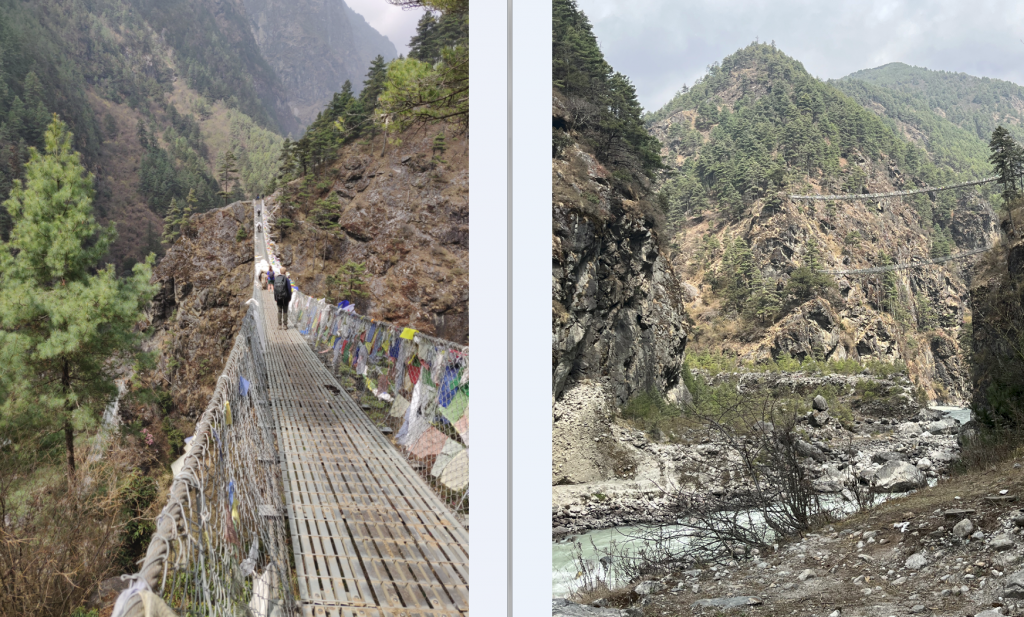
After a demanding (+600) ascent and few suspension bridges we got to Namche (3440 m), sitting in a valley.
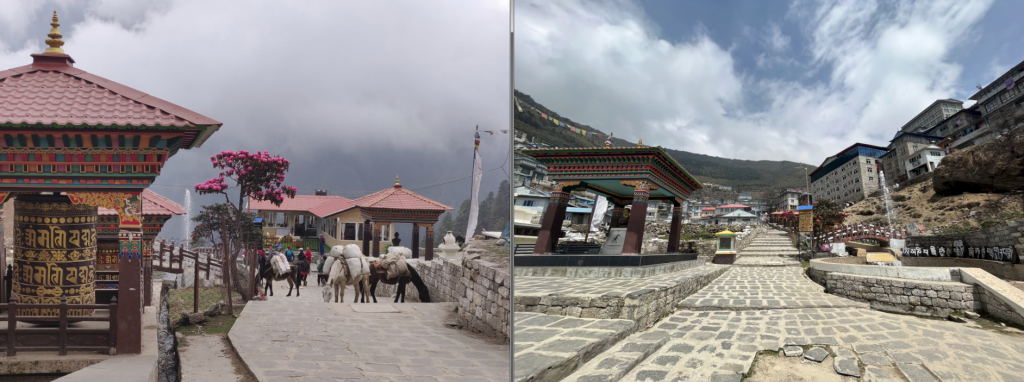
Namche is a full on city with 800 permanent residents, school with kids, highest live music bar and Irish pub, plenty of gift shops, ATM’s and anything a trekker would need (boots, flasks, jackets you name it). Which brings me to another takeaway:
Example: cheapest walking pole in Decathlon was around 16 EUR; 7 EUR in Thamel.
Lodge rooms have electric sockets, cellular network is working and wifi is almost always on. Windows are well insulated, the sink is inside and the water – although cold – is always running.
These details makes Namche first and last “base” before the wilder rest of the trek.
In evening I felt mild headache so took preventative Domeridon Actavis (for altitude sickness) medicine before sleep.
Day #3: Acclimatization Day around Namche & Khunde Peak
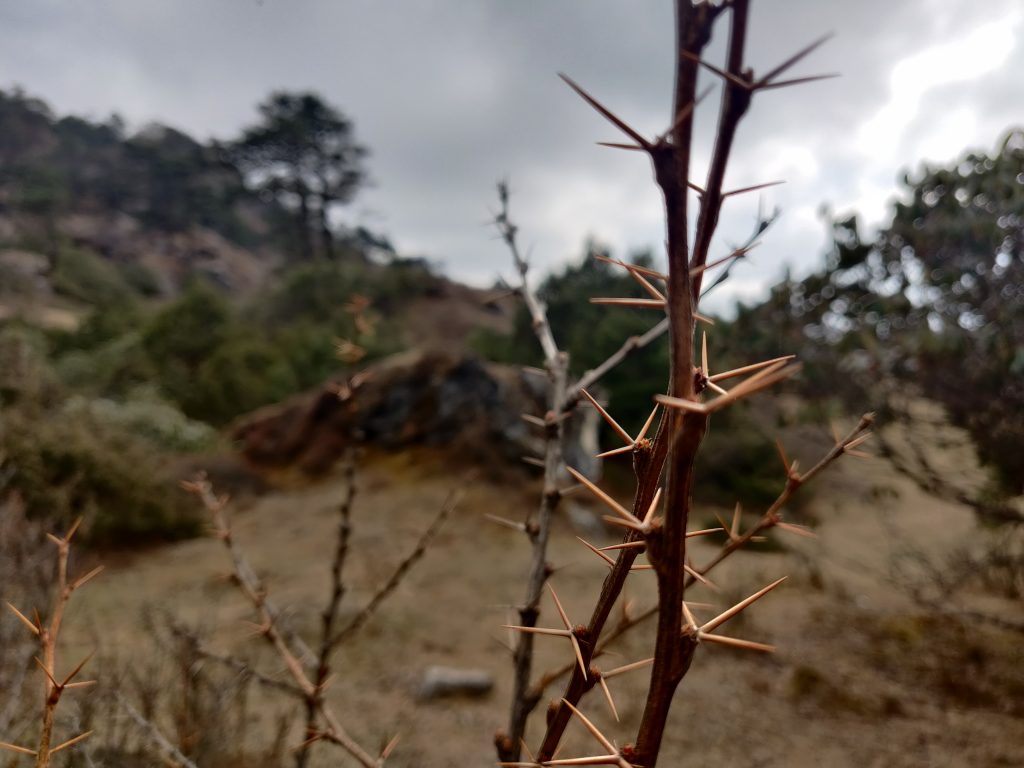
Our typical day started at 6:00 and around 7:00 we already had had breakfast and started walking. This is an acclimatization day. Pushing a body upwards, give it some altitude stress and go back down for the night.
Most people are after “ Everest View Hotel ” on this day, for obvious reason hiding in the name itself, but after talking to hotel owner (ex guide), we decided it would be more challenging and rewarding (these come hand in hand in mountains ) to first summit Khunde Peak (4200 m.) and then do a lap through Khunde, Khumjung, Everest View Hotel back to Namche.
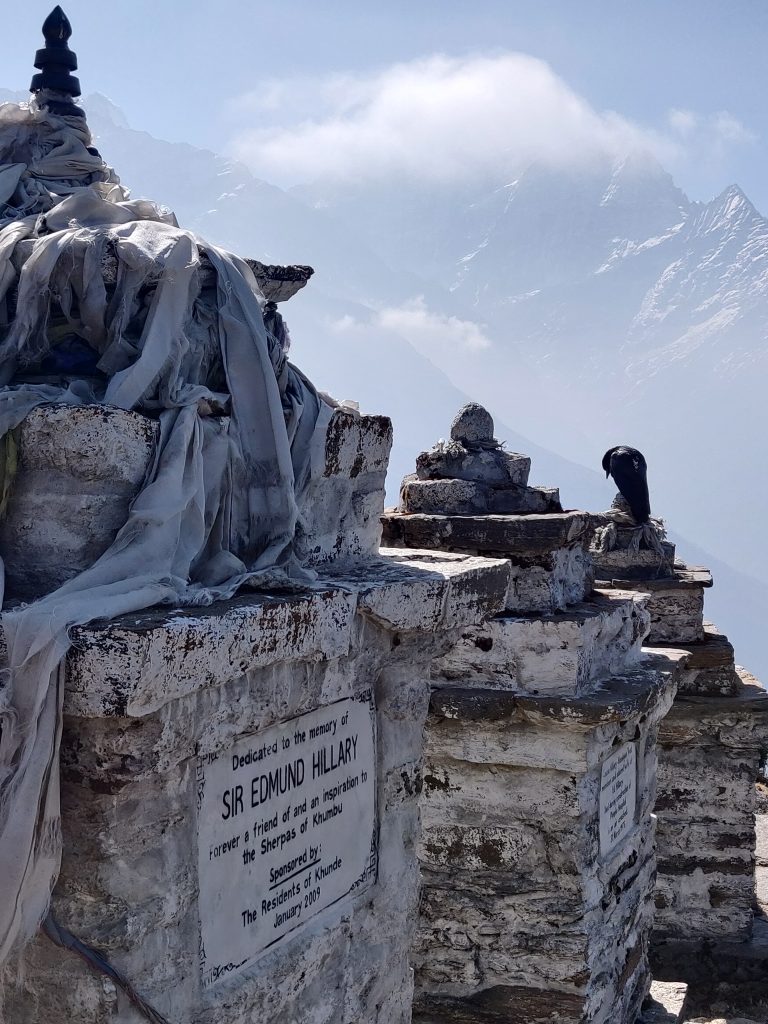
We did +800 meters ascent to Khunde peak with already noticeable lack of oxygen in the air in three hours.

Only on our way back down to Khunde (village) we met 4 person group. It was at this peak we reconnected with serenity that mountains typically have. Zero man-made sounds .
Skies – clear in early morning got cloudy afterwards and by the time we got to Everest View Hotel we were in total fog (cloud).
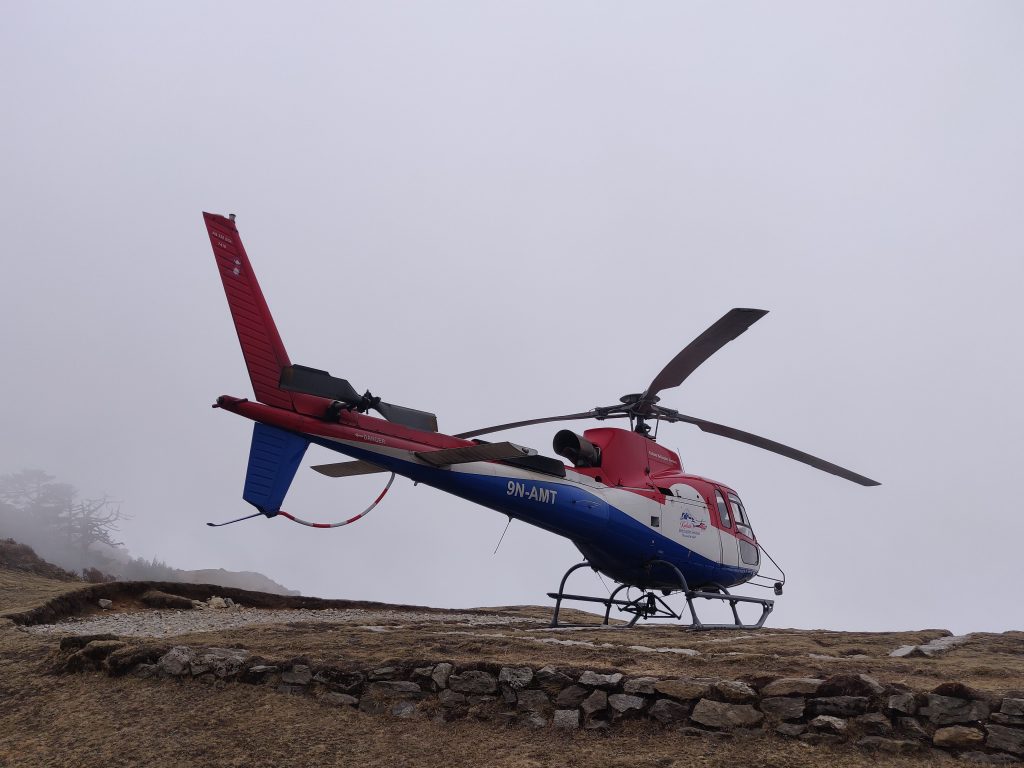
After we got back, we went for sweets shopping to stock up for higher altitudes, peaks and passes. One German dude we met at a bar (just visiting and playing fusball at this point) said the next day will the hardest. He also said it’s all shit except for the views after Namche (lol).
Day #4: Scramble for Dobuche
In the land of N ever E nding P eace A nd L ove, people rarely lie. To get out of Namche there’s 200m rise to 3600 m only to get down to cross the river at 3200 m then some rough sex to get up to 3900 m (+700) where Tengboche sits (rounded numbers to hundreds).
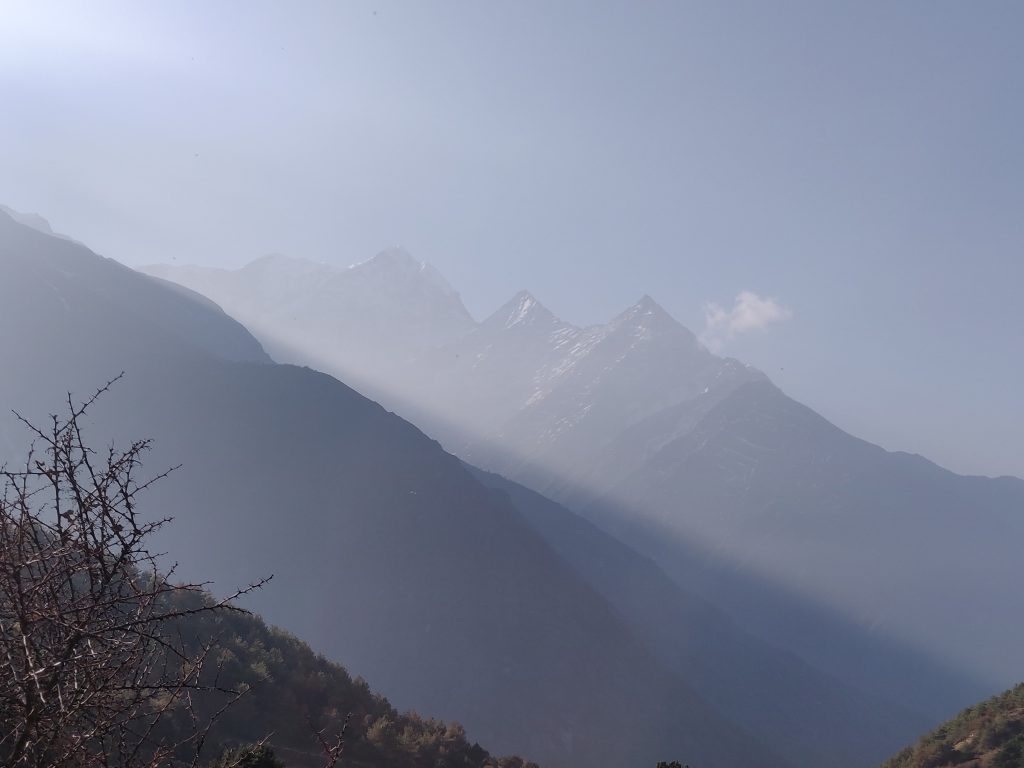
Although a lot of people stay here, we initially planned to sleep in another village Dobuche (-150 m down), 15 minutes out further. Tengboche has an impressive monastery and we heard there will be a 1 hour prayer at 16:00 (no idea if it’s daily).
So after lunch at Tengboche we went on to find a place to sleep, took a solid nap. To our surprise few tea houses (lodges) we tried at first were full already. Later we went back to Tengboche for another cultural exploration.
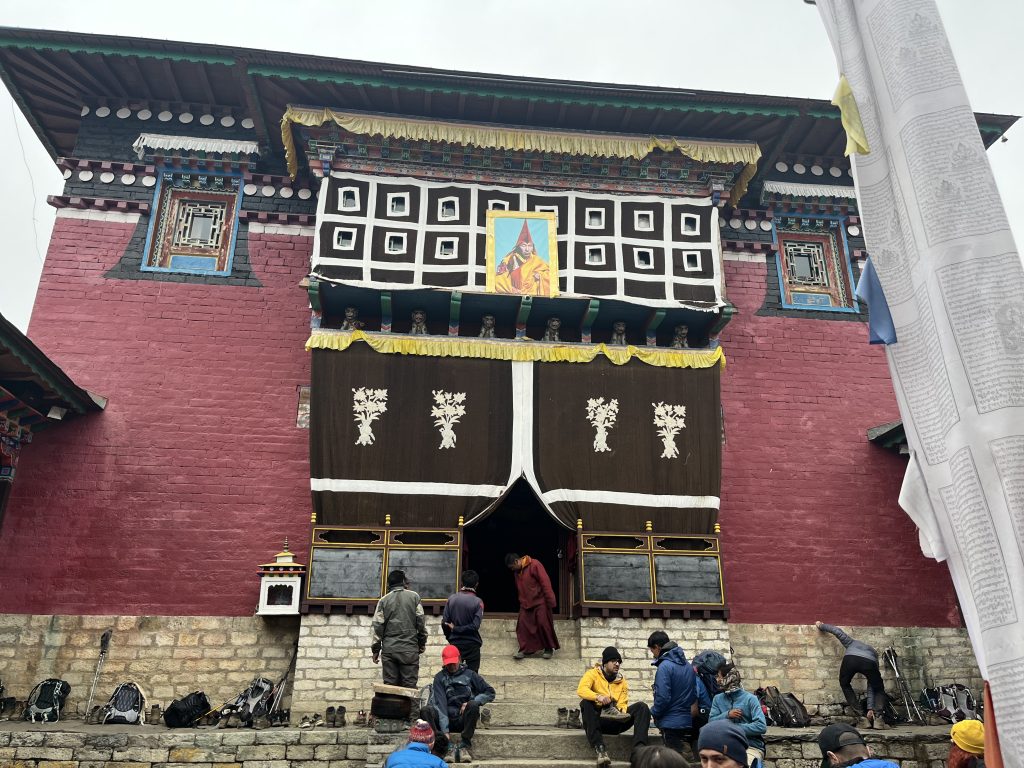
No pictures were allowed inside, but it was my first time in Buddhist monastery and it was beautiful! Much colors. Prayer took 1.5 hours, a lot of people left early. Going back to sleep, there appears this Japan-like style postcard:
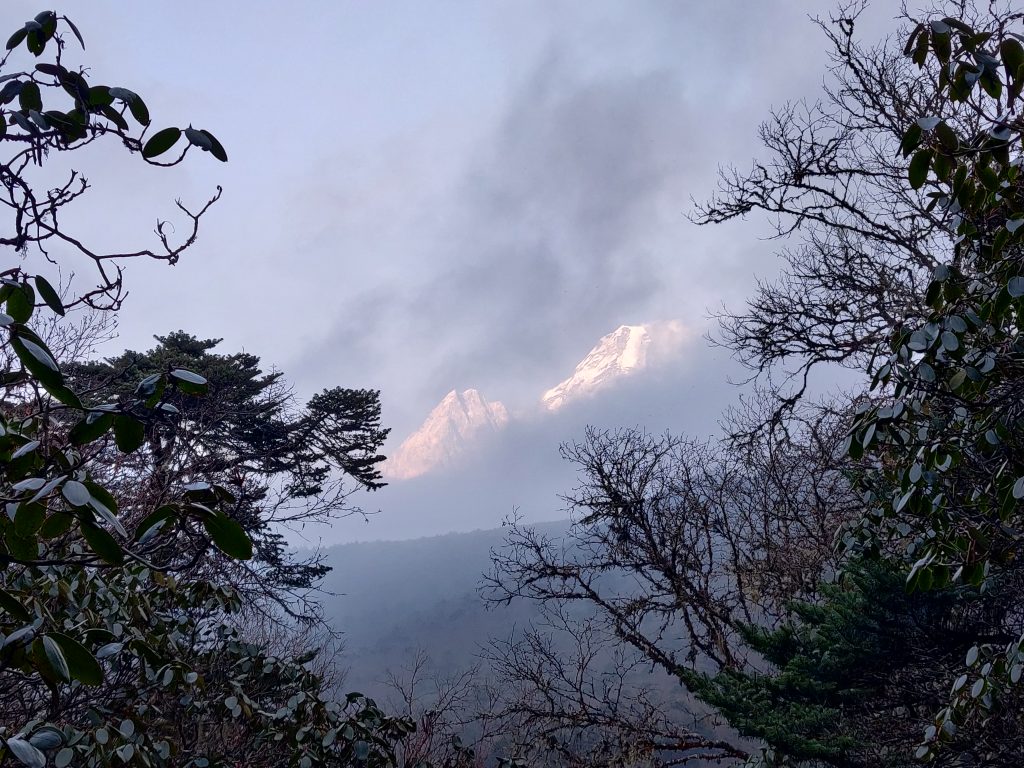
In the evening we learned a story of two guys who were waiting for a flight to Lukla at Kathmandu: their flight was after ours and turned around mid-way to Lukla due to worsened weather, they took a helicopter afterwards.
Day #5: Trekkers split at Dingboche
Path from Dobuche to Dingboche (4410 m) is not difficult. A fairly steady ascent of 600 meters and 9.5km horizontal distance. Last kilometer before Dingboche is more steep. After traditional 6:00 morning start we reached Dingboche around 11 – 11:30.
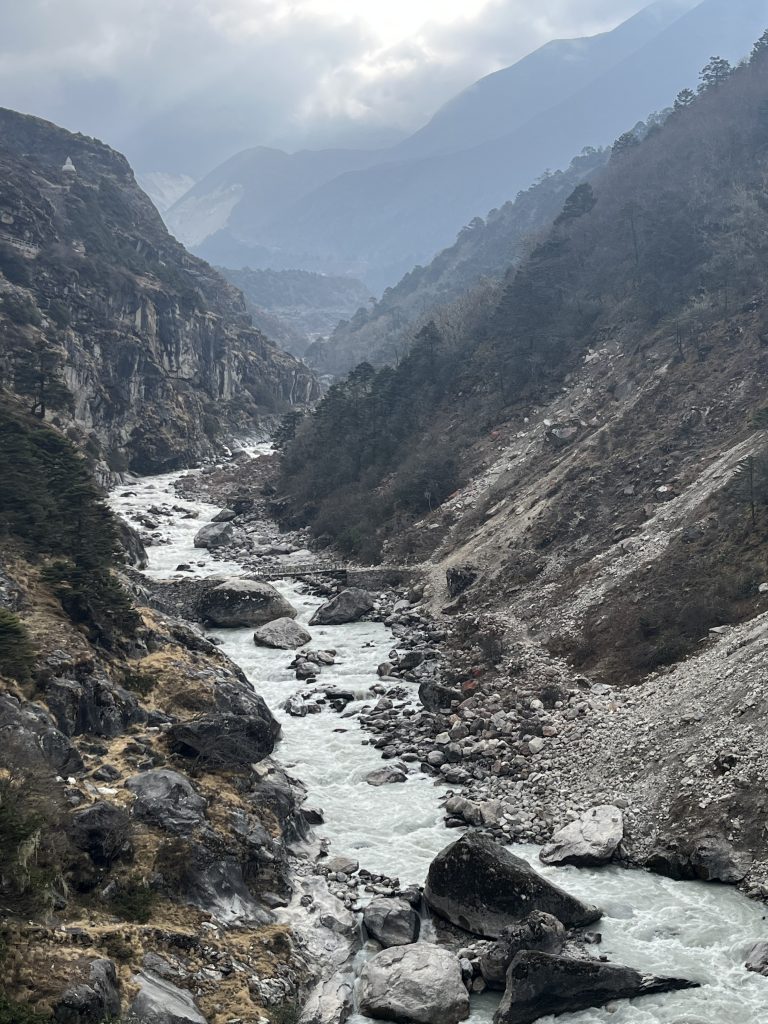
I don’t want to name the place we stayed, but my god what a shithole, with an actual shithole in fact. But it’s about the time we get used to discomfort and lower temperature.
On a positive note it has a “French” bakery with great cakes and movies (3 – all about mountains of course)! Views were a bit cloudy on the afternoon we got there, but we saw a promise.
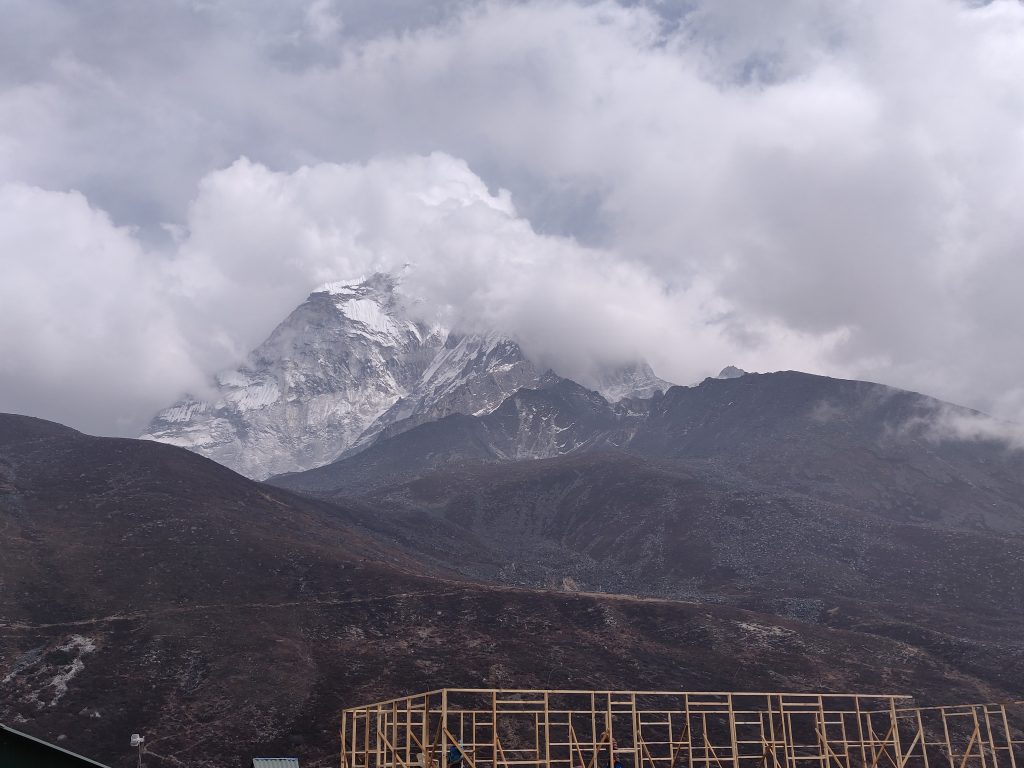
Dingboche splits two groups of trekkers: majority of tourists come and trek directly to Everest Base Camp (EBC), probably a third are here for Three Passes Trek and few are doing some combination of EBC and additional Cho La or/and Renjo La passes.
In most evenings above 4000 m. I experienced a heat coming off from the face, also with mild headache (wind, sun throughout the day?), which felt like I had mild fever.
Day #6: Acclimatization Summit Nangkar Chang
Another acclimatization day according to well-established practices. Target: Nangkar Chang summit. The day is clear is early morning, but clouds were chasing us and by the time we reached a lower version of the summit (5083m) we are already well in the cloud with 30m visibility max.
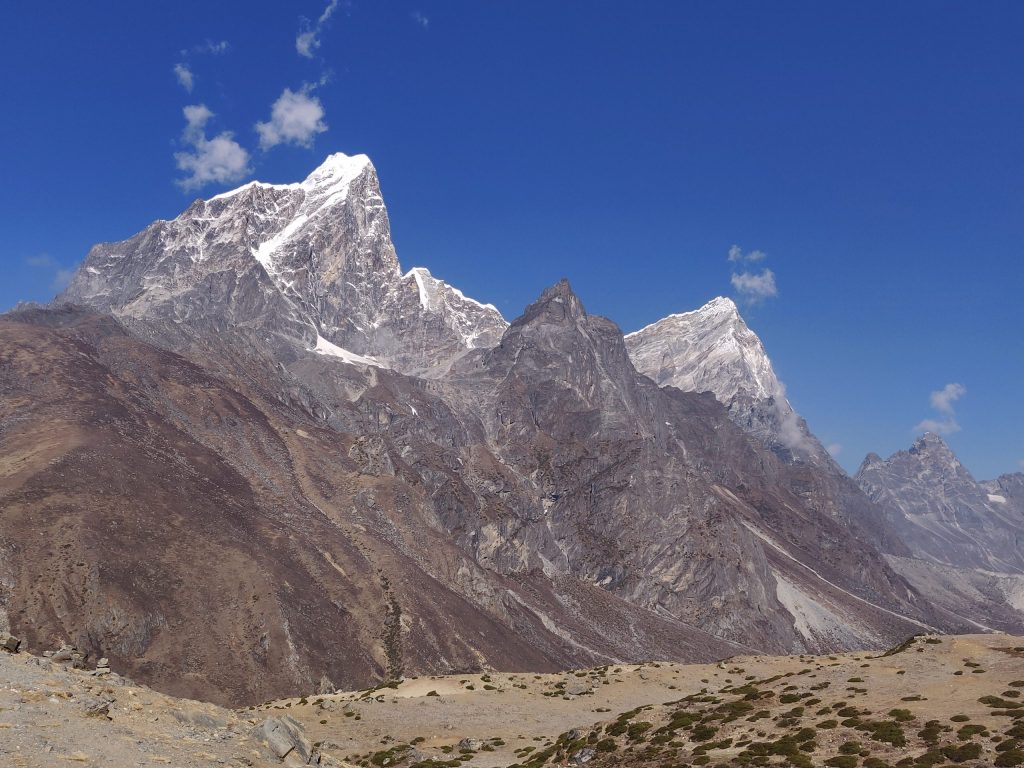
On the way up, to the other side, as clouds have not caught us, Ama Dablam in all its glory:
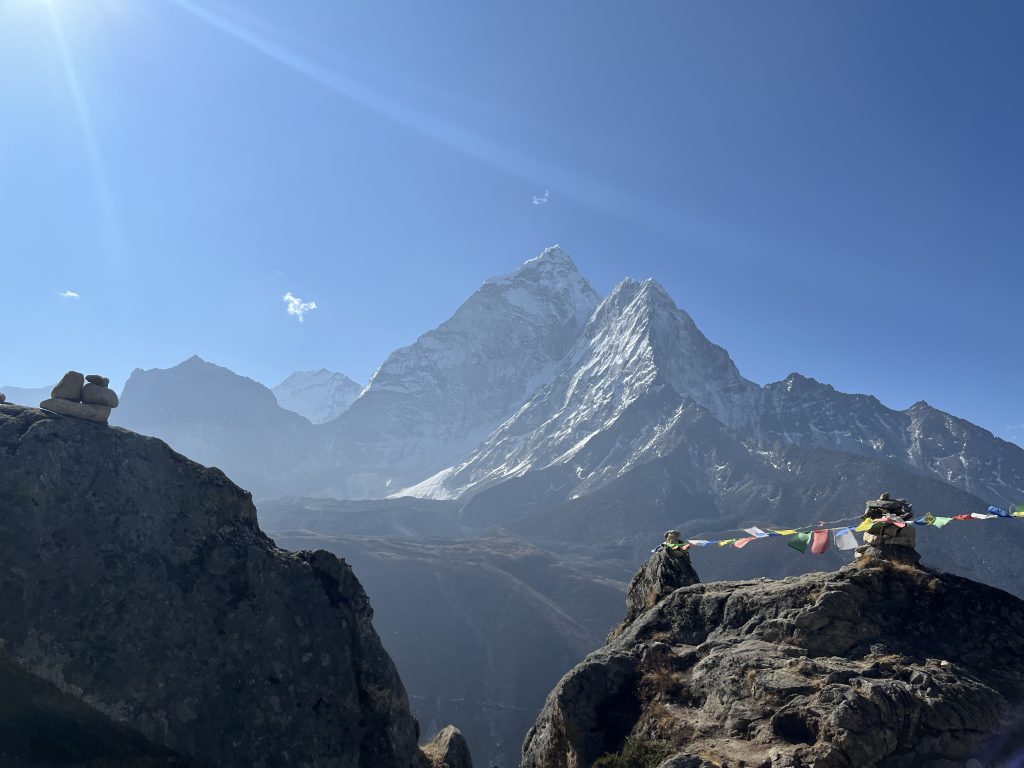
Nangkar is not technical, but sheer altitude makes it difficult to catch a breath. We both agreed 650-700 ascent and whole day was #2 most difficult so far. Step after step; one step at a time – something too familiar above 4500 m.
We reached 5083 altitude today – way above highest peaks of Europe or north Africa , crazy.
On the way back we see troves of people who woke up too late for the views.
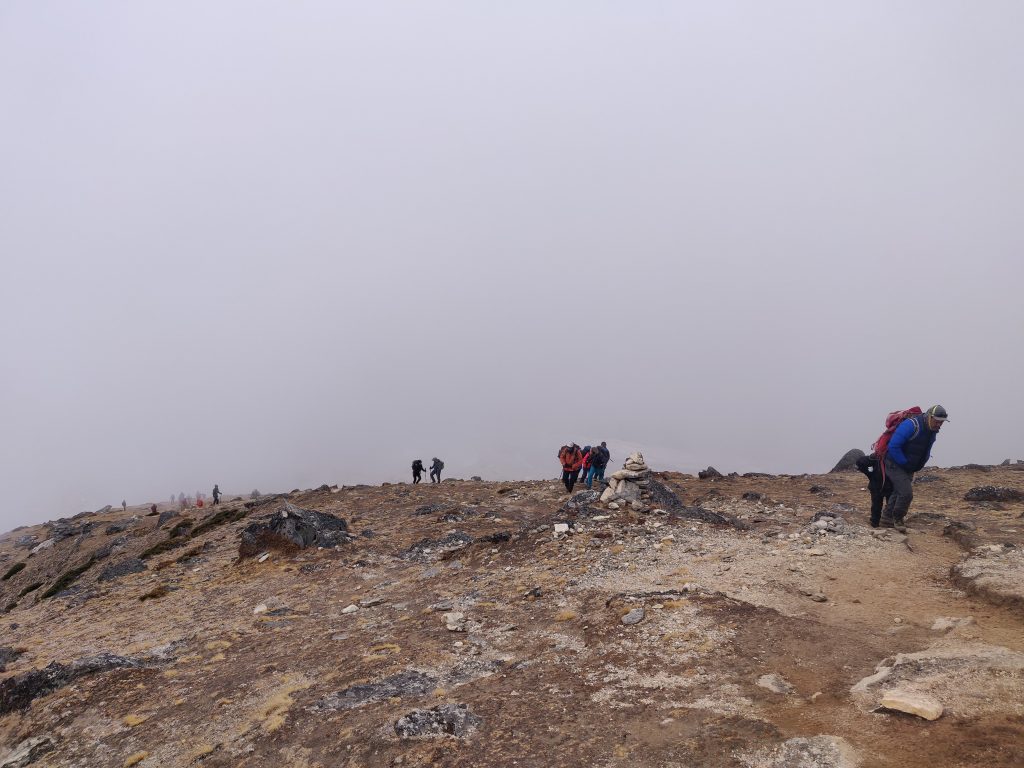
We feel like we deserved another cake and movie. It’s snowing outside. Little cough in the evening, but overall health is ok.
Day #7: Chukung and Day I became a Liability
Yesterday I was showering half naked at 0°C with draught wind in the evening. Barely slept, full nose, cough. Woke up with obvious temperature. Breakfast with lots of tea did not help.
Luckily next stop Chukhung (4730 m) is only even +300 elevation and 4.5km away. The walk is substantially different today. Weaker coordination: less control over feet placing precision, significantly harder to breathe – feeling full blown sick with added pressure of impairing trek plan.
At Chukhung I lay and drink fluids as much as I can, friend takes a hike around, brings some moments to share
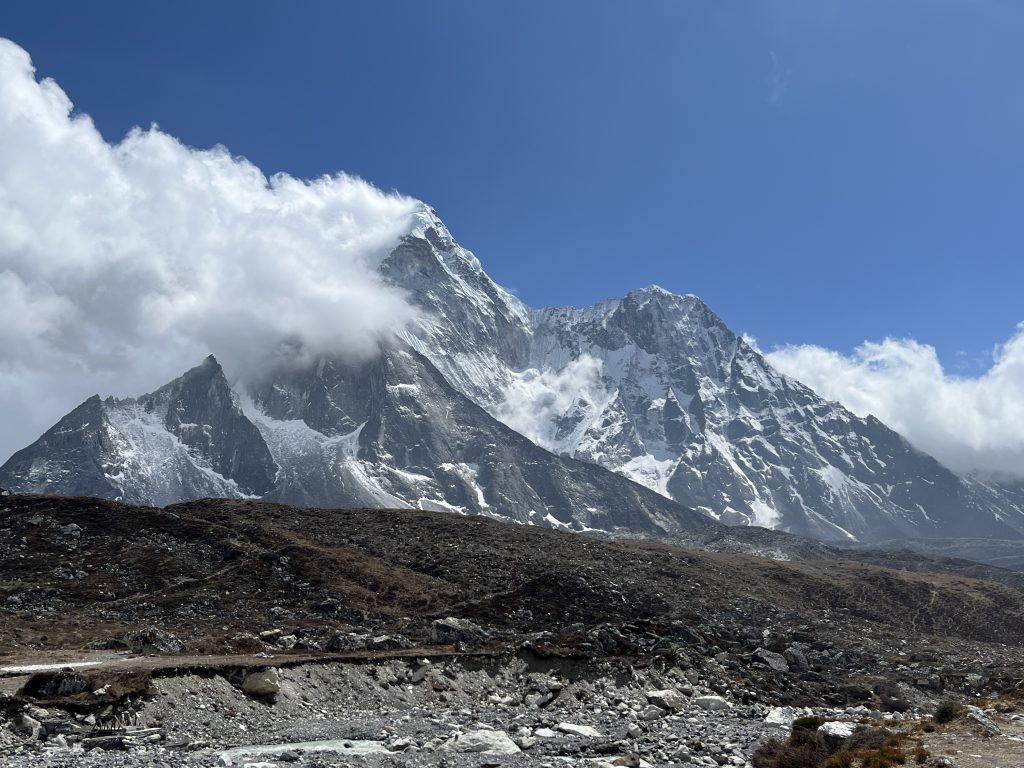
We discuss possible options in the evening and settle down on passing on first (hardest – Kongma La) pass. To spend an original acclimatization day in Chukhung back in Dingboche (2 hours max on an easy ride down). Took a red pill (I’m already orange-pilled, by the way) from our “French” buddy we already met multiple times in the evening.
Day #8 Rest day at Dingboche
The walk was easy and downhill, although I was lagging behind. The day was the clearest one so far.
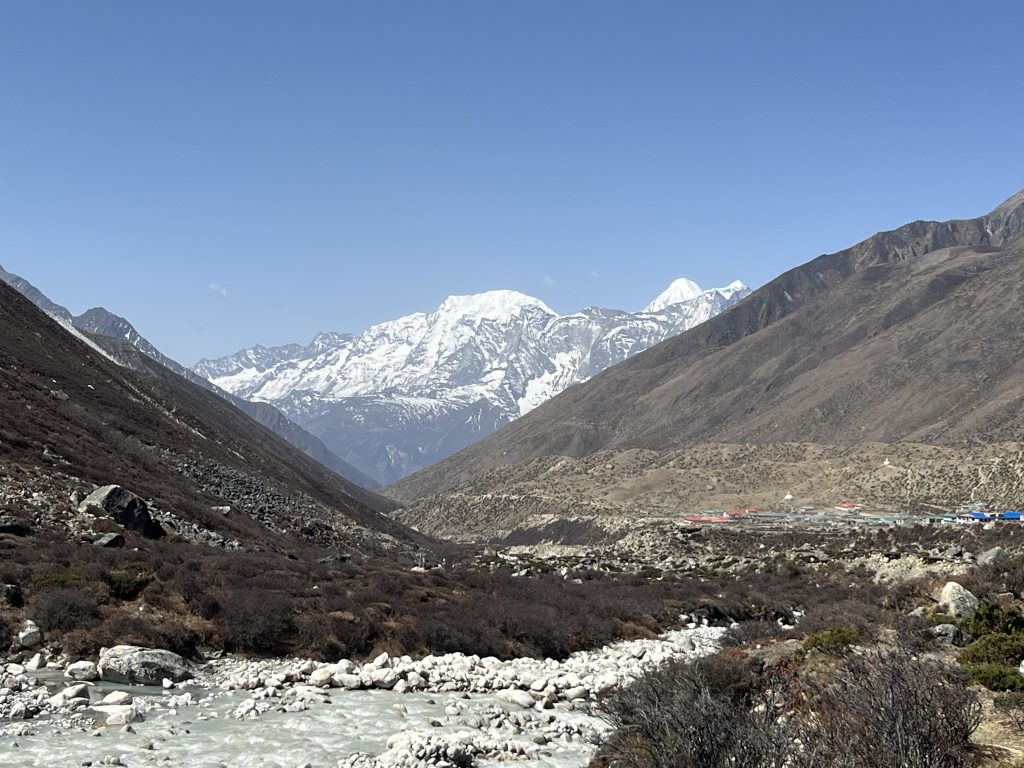
Found ourselves a better stay this time and went for a walk. As the sky is clear, satelite network works and shops offer paid wifi. Took a pot of tea and sat down to update ourselves with the rest of the world for couple of hours.
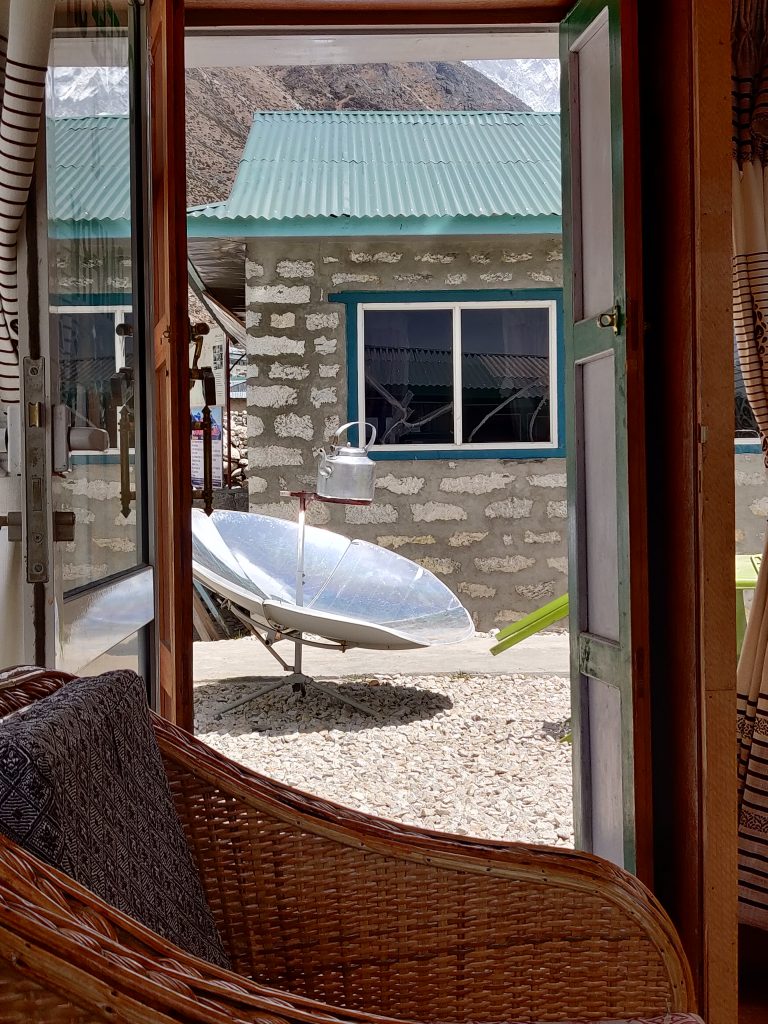
Drank enormous amounts of soups, water and teas these two days and by the evening I felt way better. However next day’s target was Lobuche hefty distance away and with fair amount of elevation.
Day #9: Lobuche
The road from Dingboche starts throughout valley on mild ascent, nothing too difficult – however I can feel both altitude and previous sickness taking a toll, I’m lagging again. Skies are clear and views are…
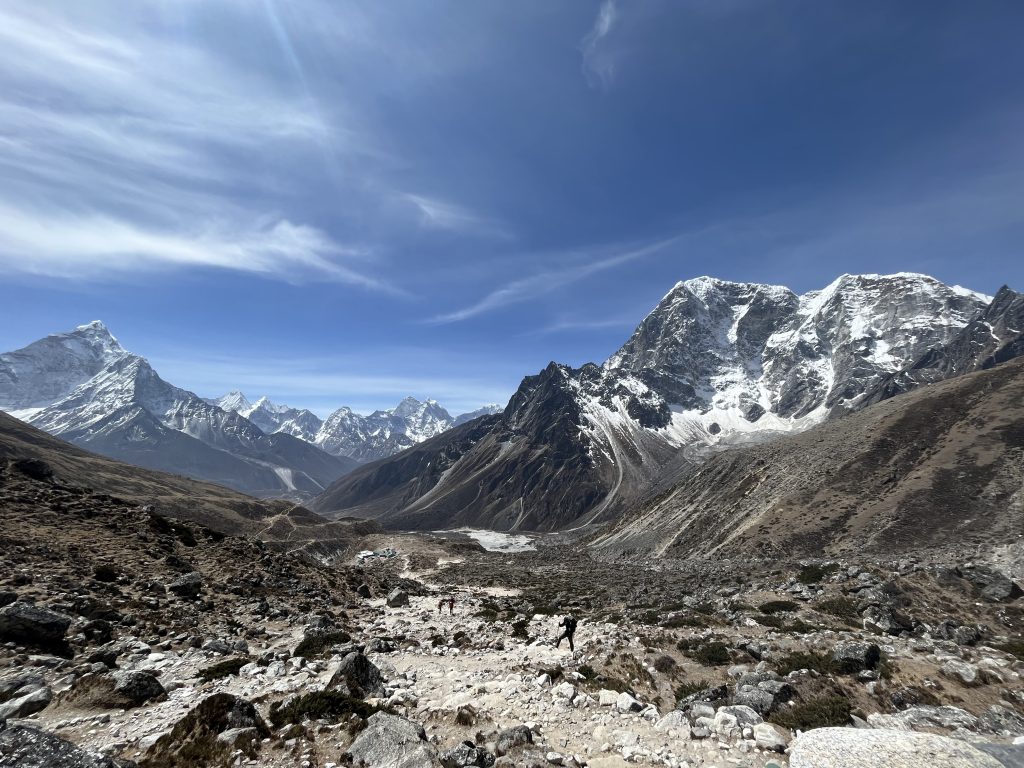
A brutally steeper climb starts after crossing the river at ~4600 m. just before the Scott Fisher and other climber’s memorials. Reached some katharsis at this place. Emotional and physical fatigue came out with tears, resting on a warm ground. Such a beautiful place the Earth.
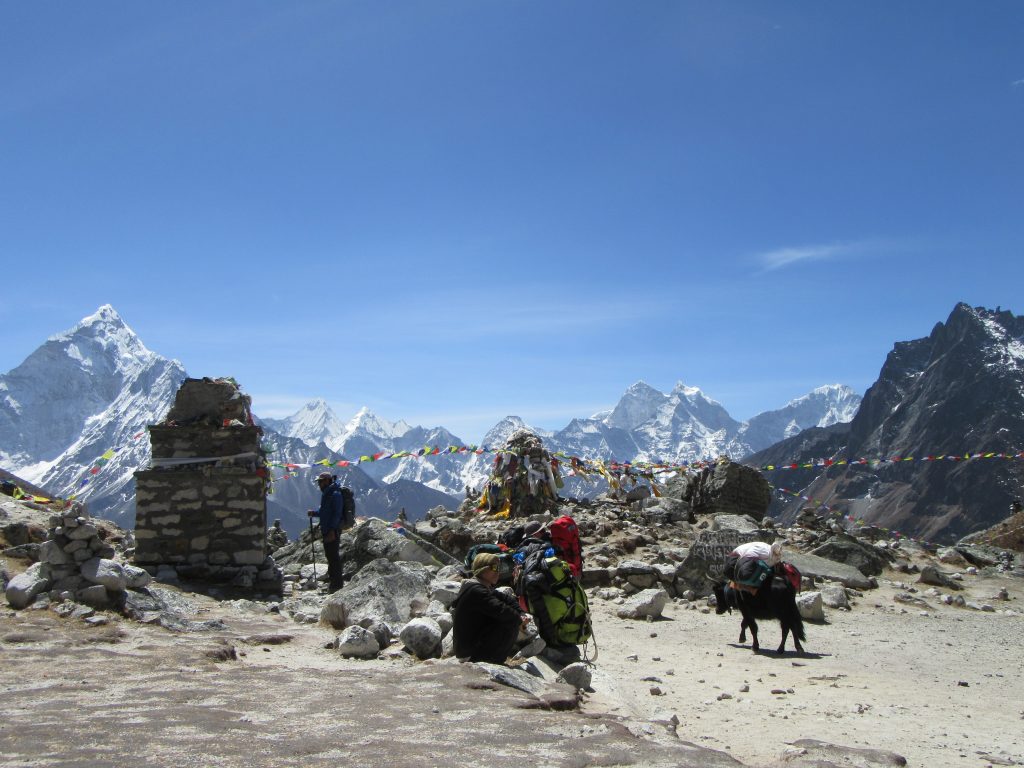
But it’s not Lobuche yet. Onto it… More beautiful paths.
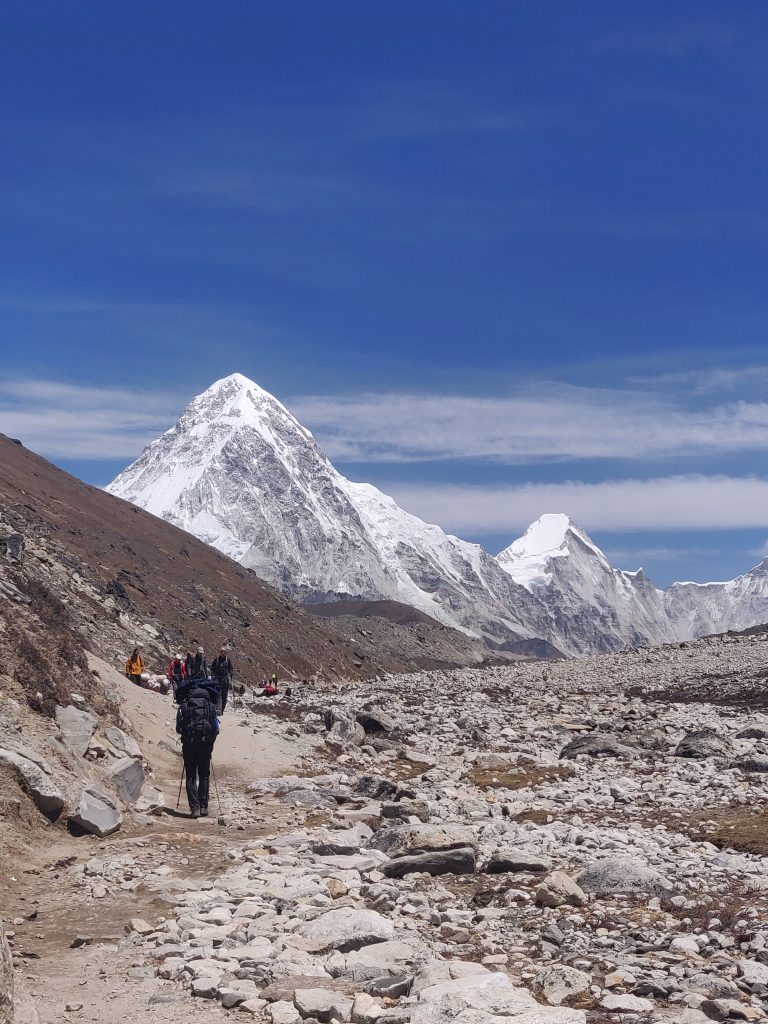
Although lagging, I was happy we got back on track with effectively no day-planning deviation from the plan. This has to be one of the most iconic moments of the trip.
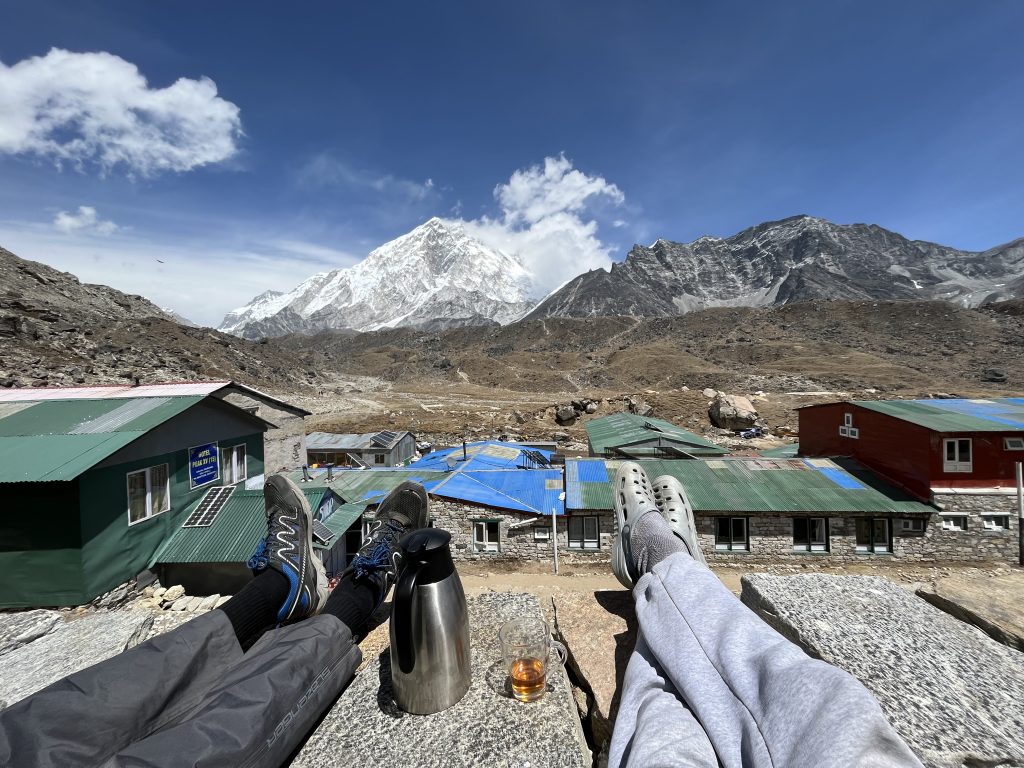
In dinner we learned local “hashbrown” is actually a huge potato pancake, which I love. We also conclude we are getting fed up with cold, lack of hygene, constant physical challenges and dragging of 10+kg. Expected. Another technical tip on trekking:
Should be obvious, but worth mentioning for complete newbies:
Took a wet wipes “shower”. Changed majority of under and middle clothes – tomorrow is a big day -Everest Base Camp, lol.
Day #10: Goraksherp & EBC
Contrary to our imagination, Lobuche – Goraksherp (5160 m) path is way more difficult. Lots of up and downs, turns and rocks, that require special attention.
Altitude difference between two villages of 250 m by no way resembles the difficulty . Got tired, angry and tired several times. That’s the teaching of the mountains…
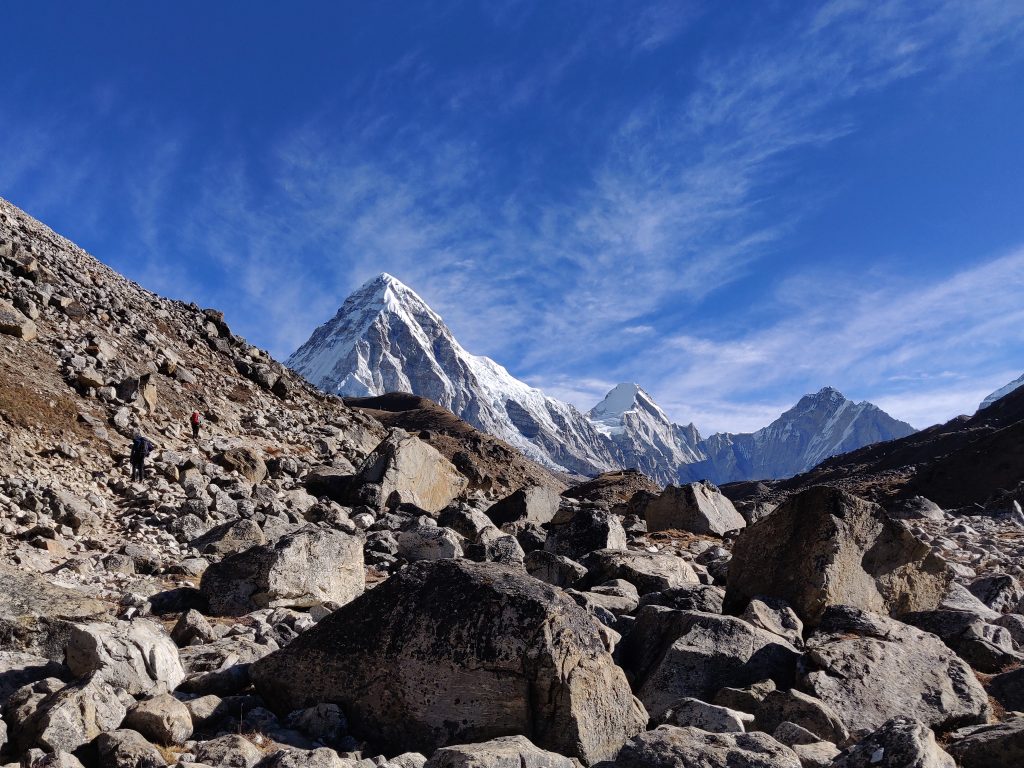
Road to EBC (Lobuche – EBC “highway”) depending on a day and hour can get busy. Herds of loaded jaks, sherpas, horses, individual, guided and groups of tourists – all on the same road, which at times gets slim.
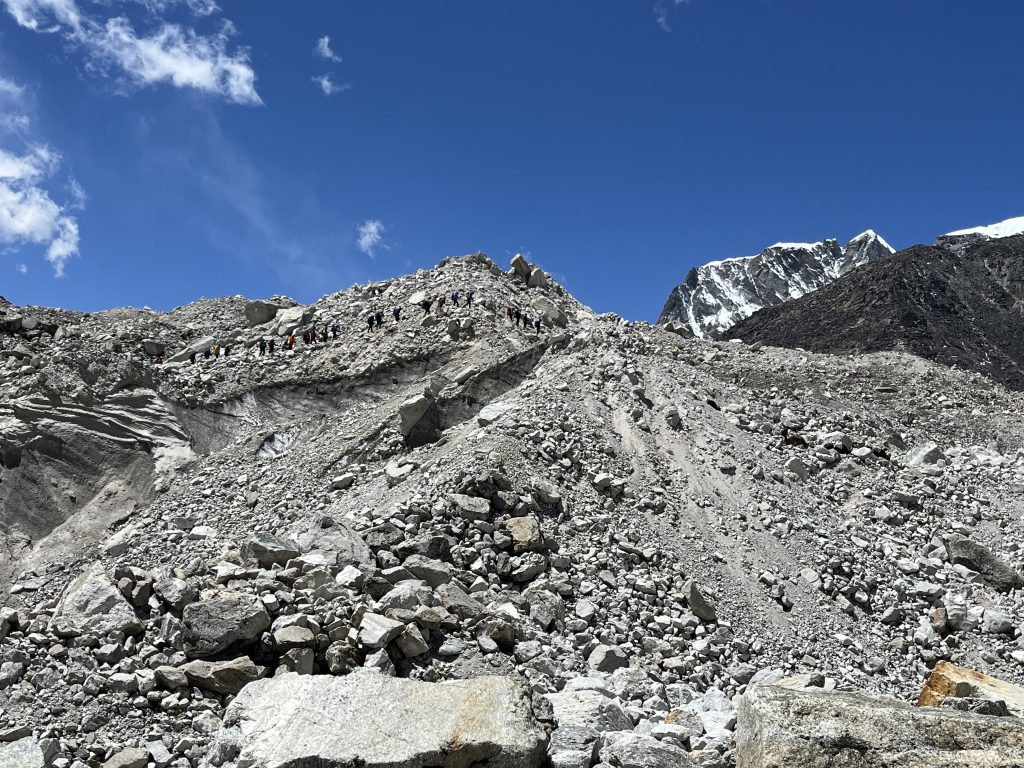
After we got settled in Goraksherp (5160 m), our highest sleeping location in entire trek, left bags, packed some snickers, tea, water and went for by no means easy walk to Everest Base Camp (5364 m).
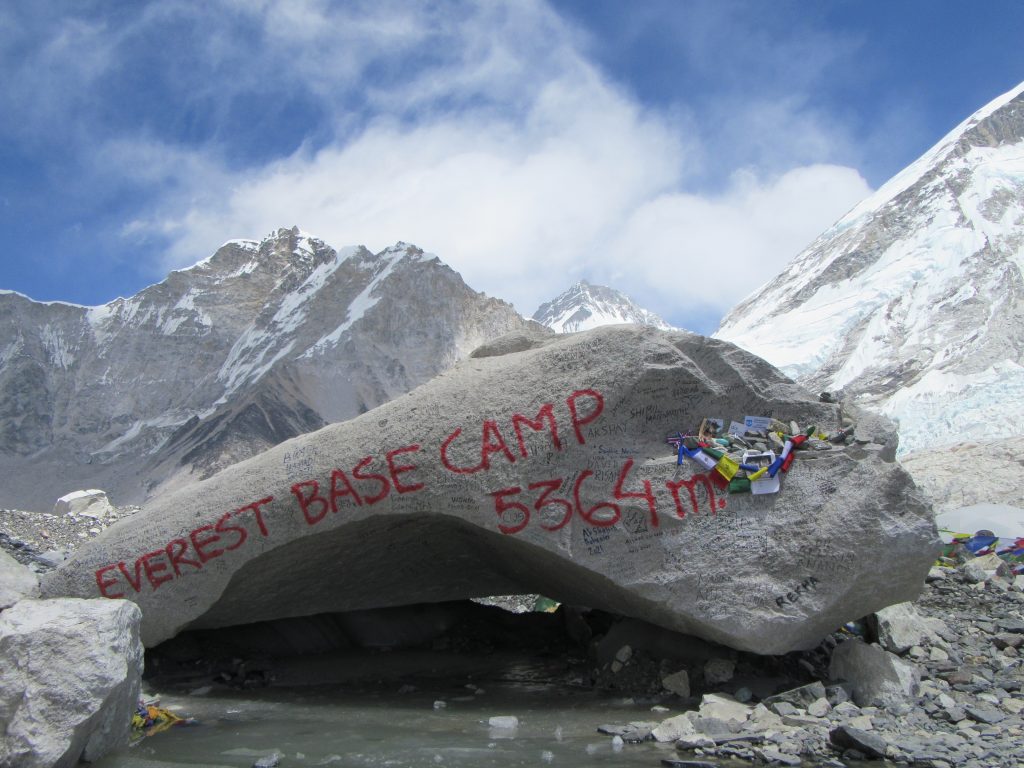
Manager of company, organizing Everest summits came to us as we were chilling with snacks and tea, one interesting thing he told.
People that will attempt a summit in a ~month will come in a week. Right now tents are being setup (hence the intense jak / sherpas traffic) with bars, massage salons, restaurants, wifi’s and this and up to base camp 2 (!). People will acclimatize, hiking up to 3rd base camp (maybe 4th) and will be flown to Kathmandu to wash and rest before weather window suitable for summit opens. They are then flown back to base camp and attempt a summit. What a high roller game…
Day #11: Kala Patthar Summit and Dzongla
We both woke up with a headache. Slept 6 hours, with mediocre quality. It snowed during the night, not much, but enough to have covered everything white in the morning. My morning headache, as usual disappeared quite quickly. Friend got nausea with first few minutes of climbing Kala Patthar. We split, I cover the team this time, he goes to rest and drink water (drank anti-altitude medicine after waking up).
Climb is hard and I left my heavy duty gloves. Feet and hand fingers are freezing. I don’t even use walking poles, carry them on wrist in an attempt to warm hands in pockets. Can’t wait for sun to lift the temperature.
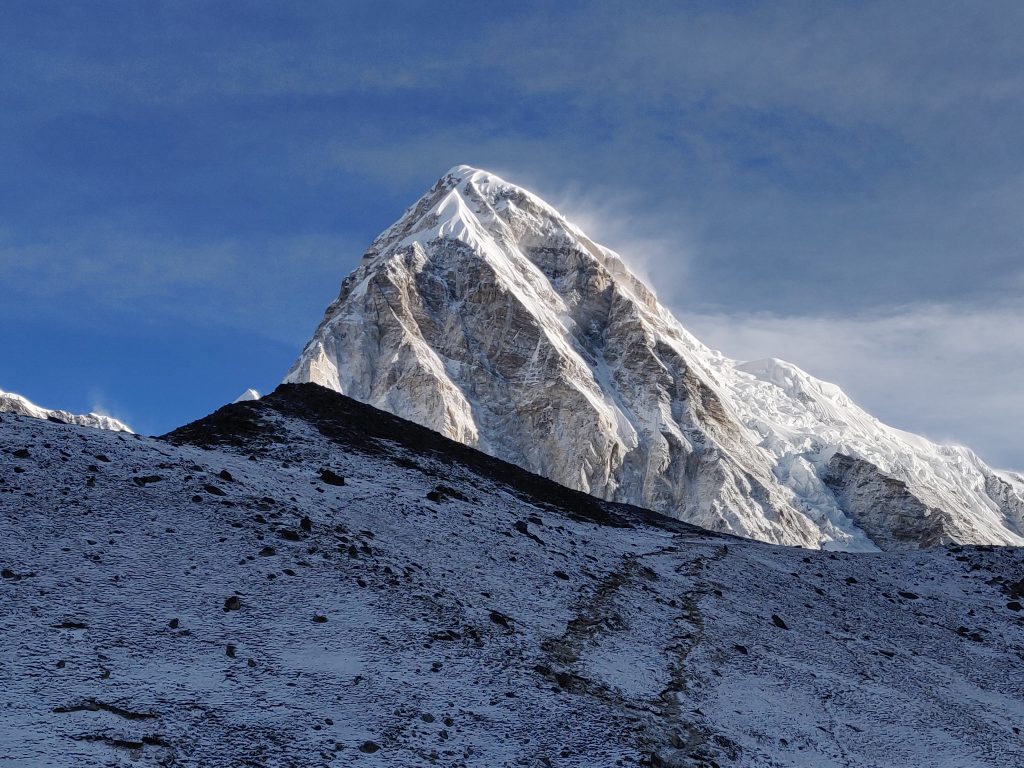
Mountain is identical to Nangkar Chang. Just a constant grind upwards (+500 meters) with little oxygen. Skies are clear and views are amazing.
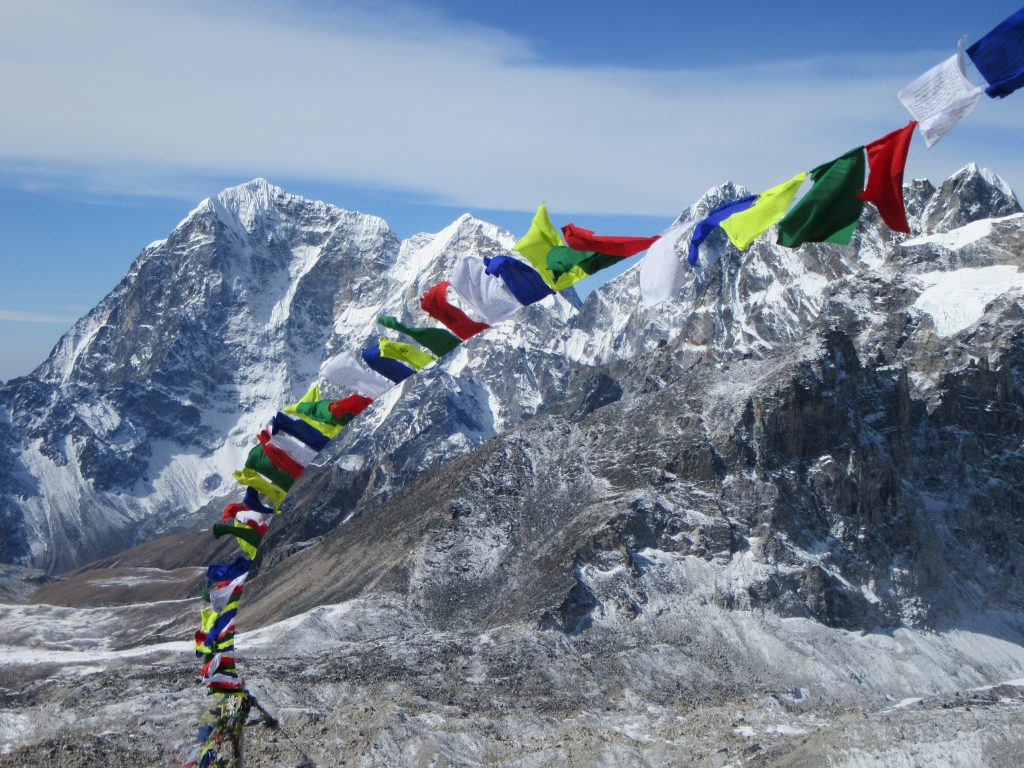
When I got down, friend was feeling better, ate a late breakfast and although our plan we set out in Lithuania was to return to Lobuche. We somehow did not even considered it and pushed into the evening for Dzongla (4830 m) (left Goraksherp at ~11, reached Dzongla at ~16).
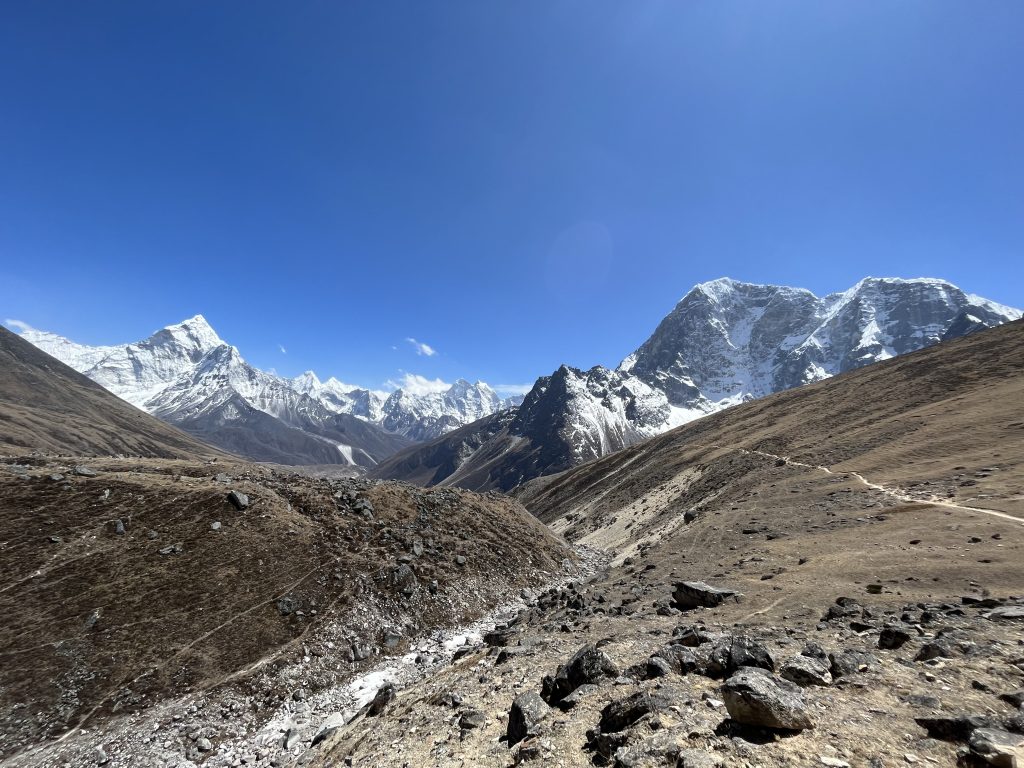
Views on a sudden turn besides mountain slope path were probably the most beautiful of all the trip. What an amazing place.
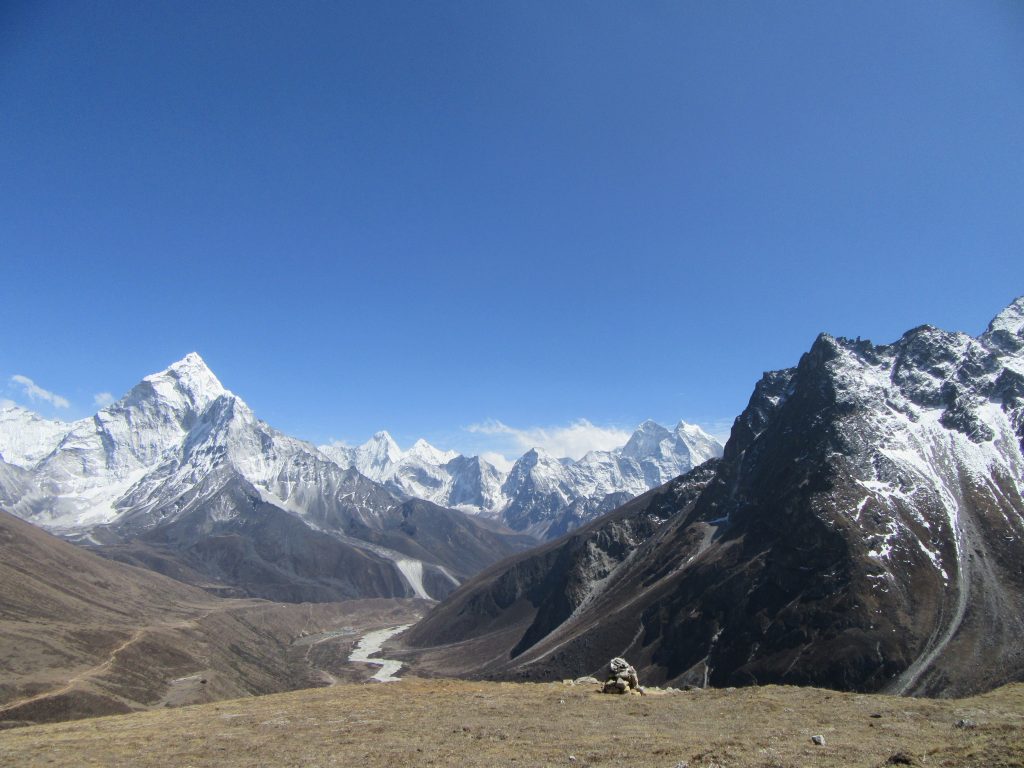
Exhausting day for me.
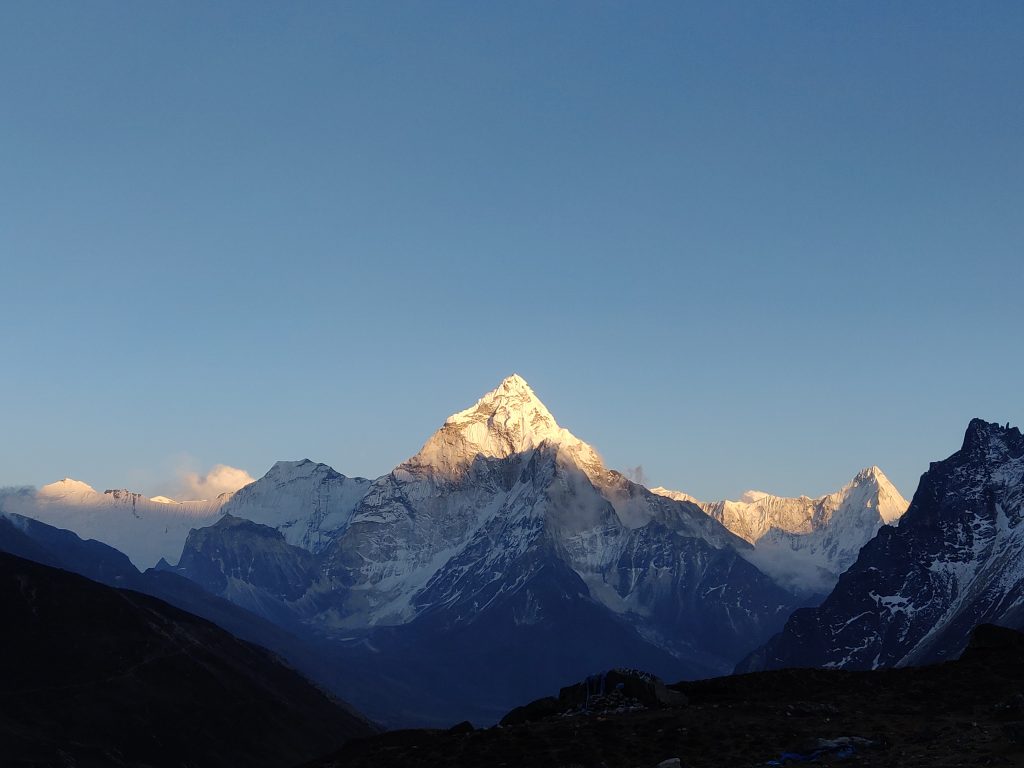
Day #12: Cho La Pass and Walk on Glacier
The night was the coldest from the whole trek. Ice on room glass in the morning. Blasted some Boney M to pump our selves up for a difficult day ahead. We talked about the cold with lodge owner at the breakfast, he said in Autumn it’s “way colder” here.
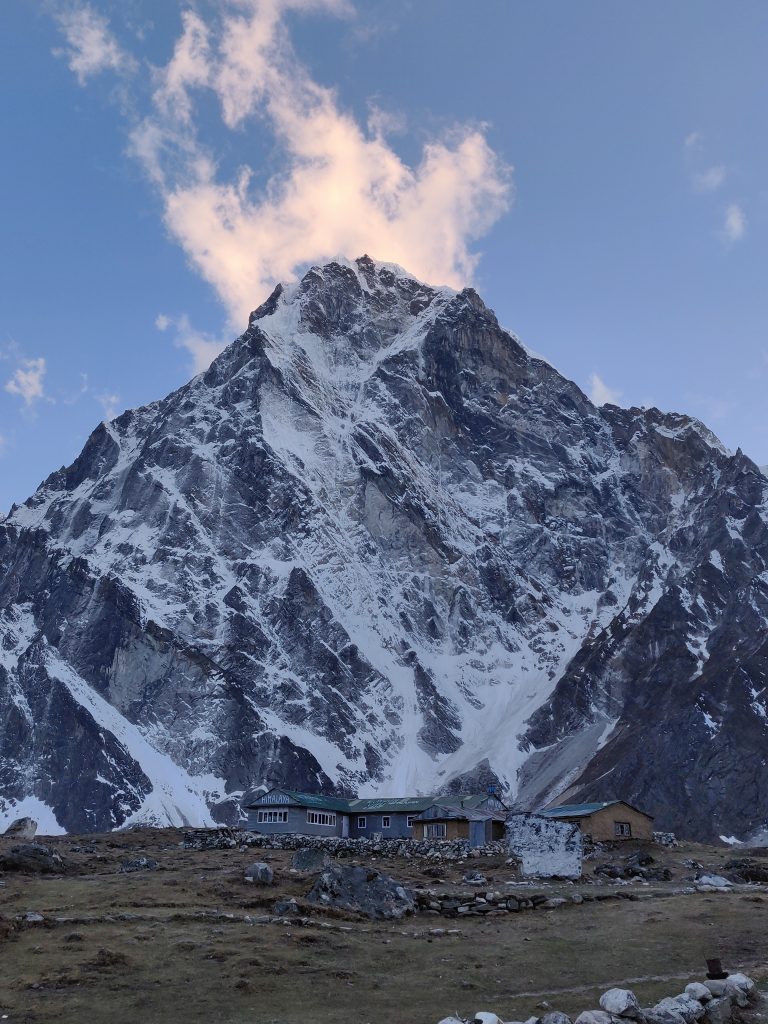
Trek Autumn or Spring?
Haven’t done googling on season differences but on two separate occasions we heard locals refer to autumn as harsher. Our host and Dzongla, without referring to numbers, implanted an impression it could be as low as -15°C here in October.
Another time (3 days ahead) while at the lodge, we talked to a guide, who said in 2019 autumn enough snow suddenly fell, you could not do a pass (he was referring to Renjo La). Something to consider.
Cho La Pass
Cho La is our first pass (second in Three Passes Trek). It was definitely the day with most diverse terrains, steepness and it’s properly hard. Around 20km horizontal and plenty of ups and downs along. The Cho La, as well as Renjo passes in our opinion are easier counter-clockwise (our direction). Decent, length and steepness from both must have been brutal for people going in the opposite direction. Of course nature rewards the effort.
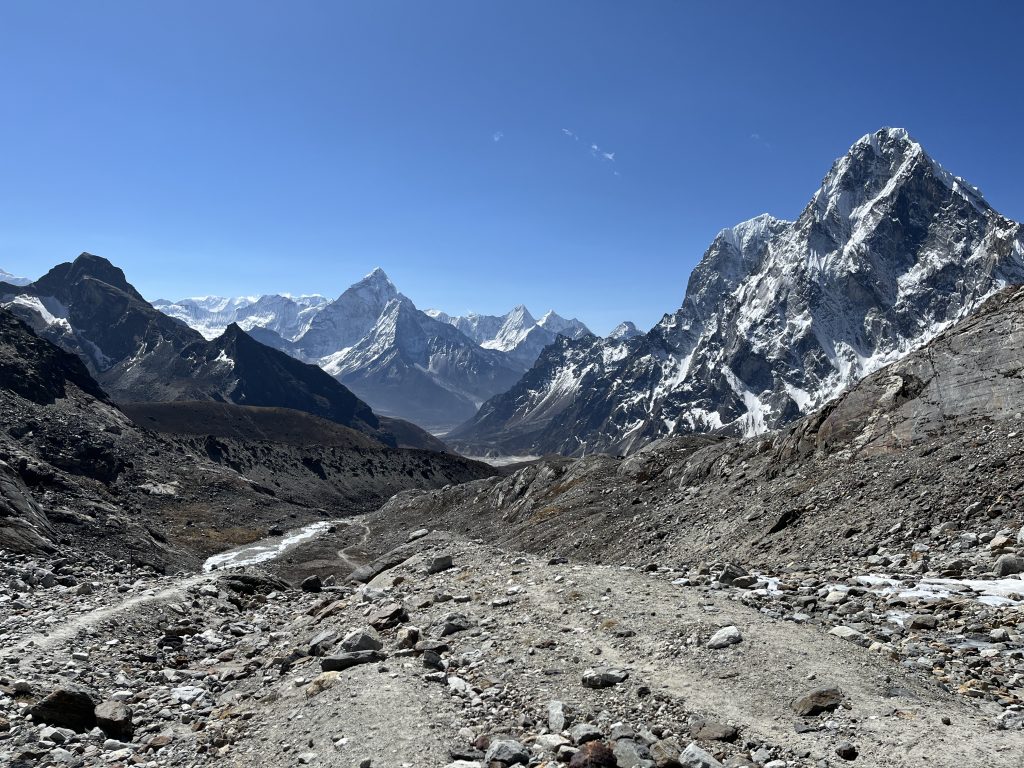
Just before the pass, lies a glacier. Time to wrap those crampons we been carrying.
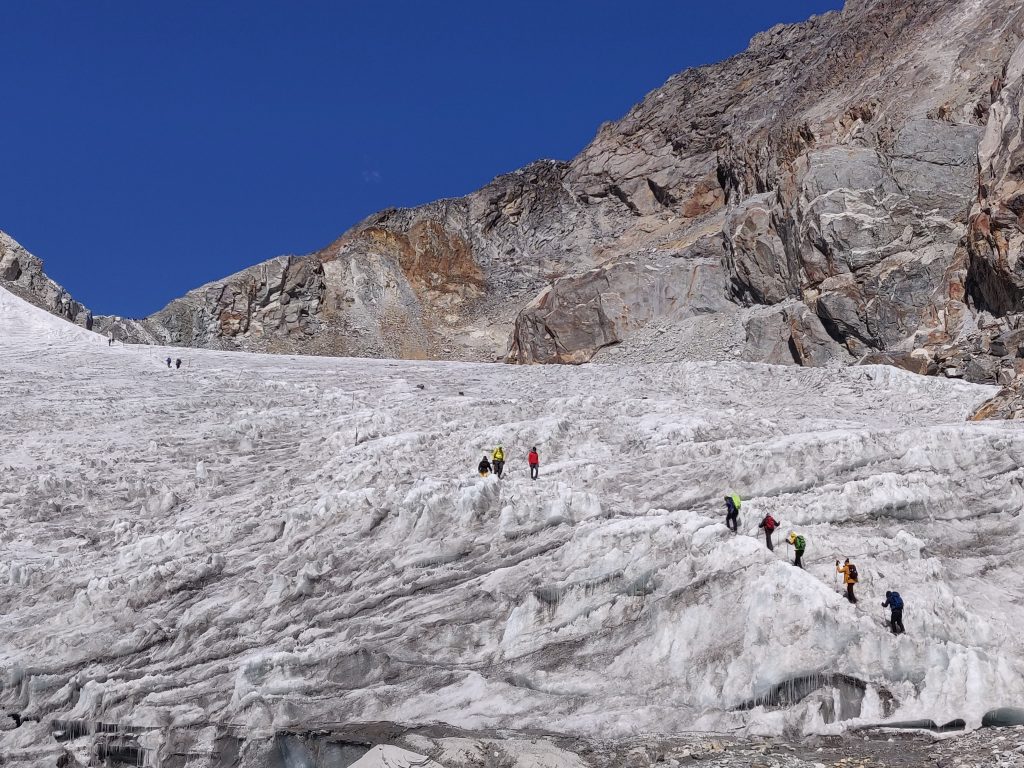
The pass tops out at 5420 m, that’s +600 ascent from Dzongla.
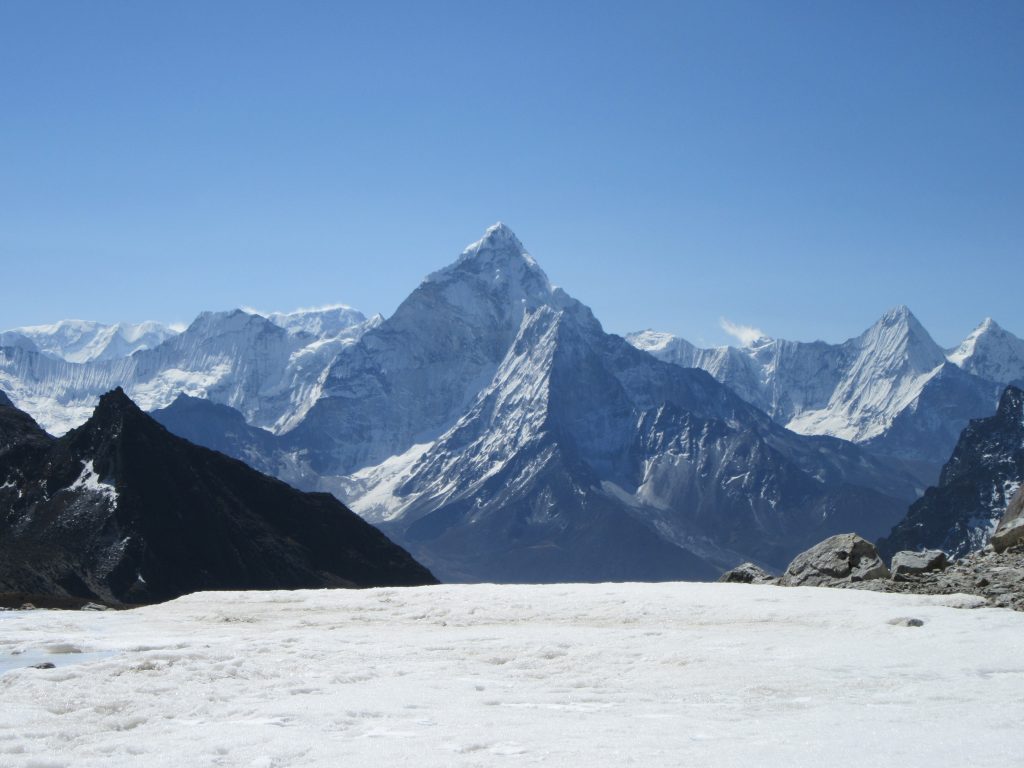
And finally a look at the other side.
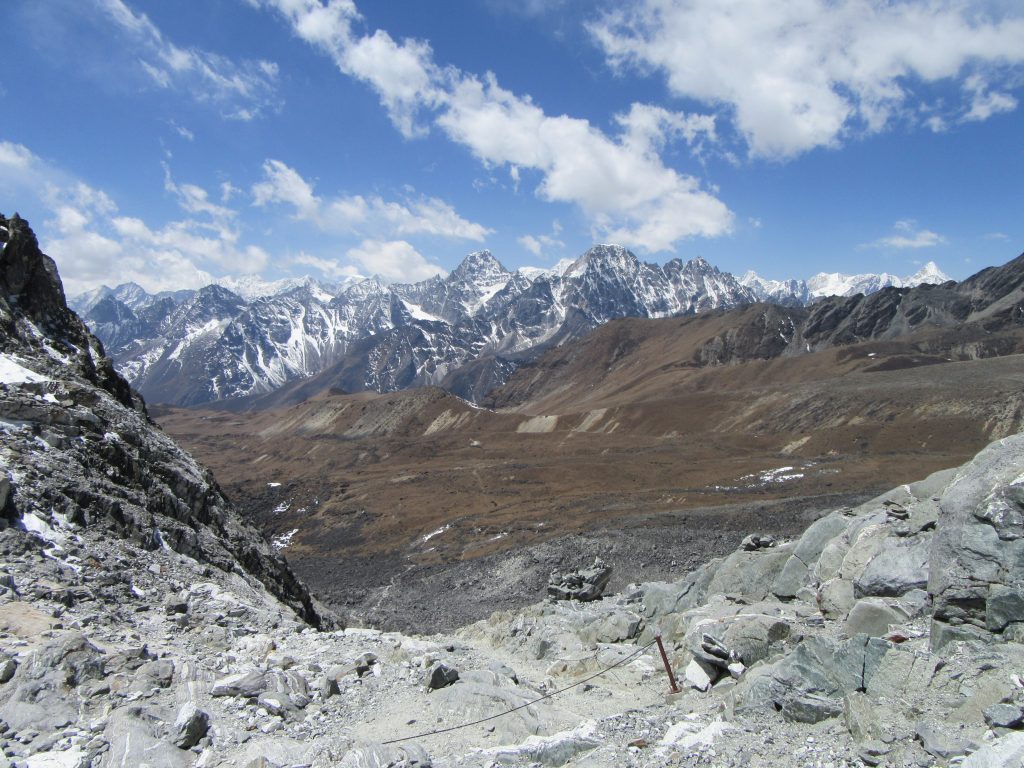
We reached and had lunch at Dragnag. Some people were staying here after the pass, but we decided we want to stay at Gokyo tonight, which seemed like 1,5h away only on maps.me.
Second glacier
We left Dragnag (4700 m) at 15h and only reached Gokyo (4790 m) 17:30. Altitude difference once again does not resemble the reality of frustration and fatigue and ups and downs of what is supposed to be another glacier (Ngozumpa), or what I personally called – a death valley.
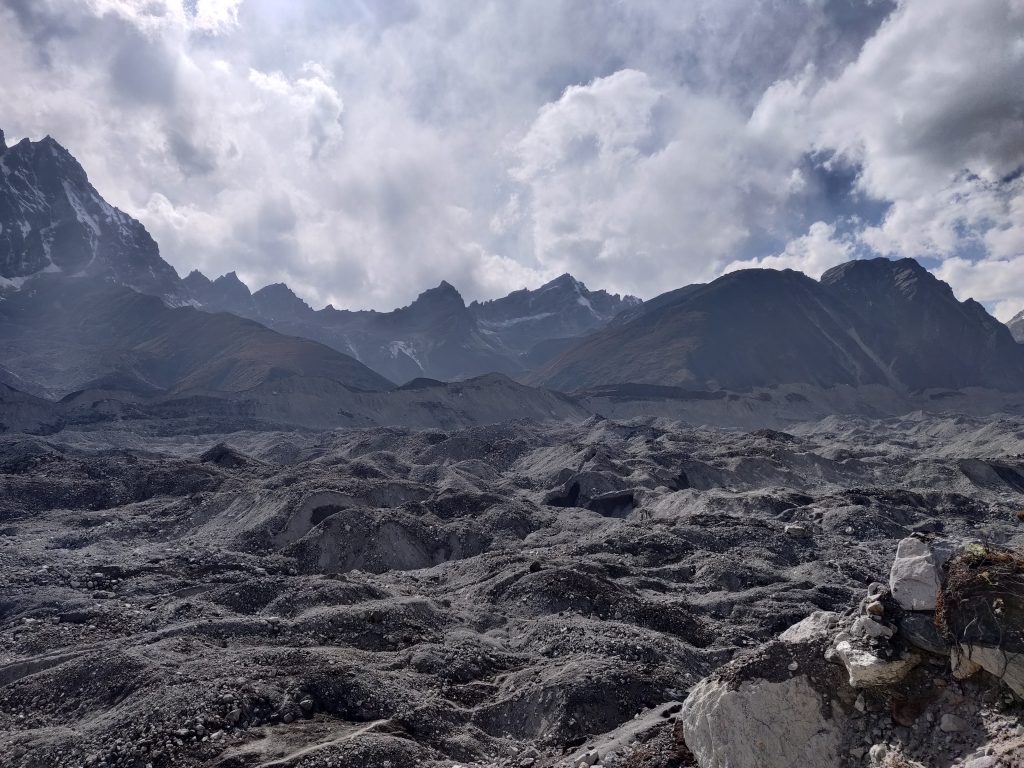
Next day we learned the path shifts every year. Zero people, sun setting; ~80 m steep borders, with gravel shifting below the boots, barely finding a path. This thing is 2km wide and we had to cross it sideways. What seemed like endless ups and downs, quickly drawnn out our patience after an already hard day and heavy backpack. Not to forget an lack of oxygen.
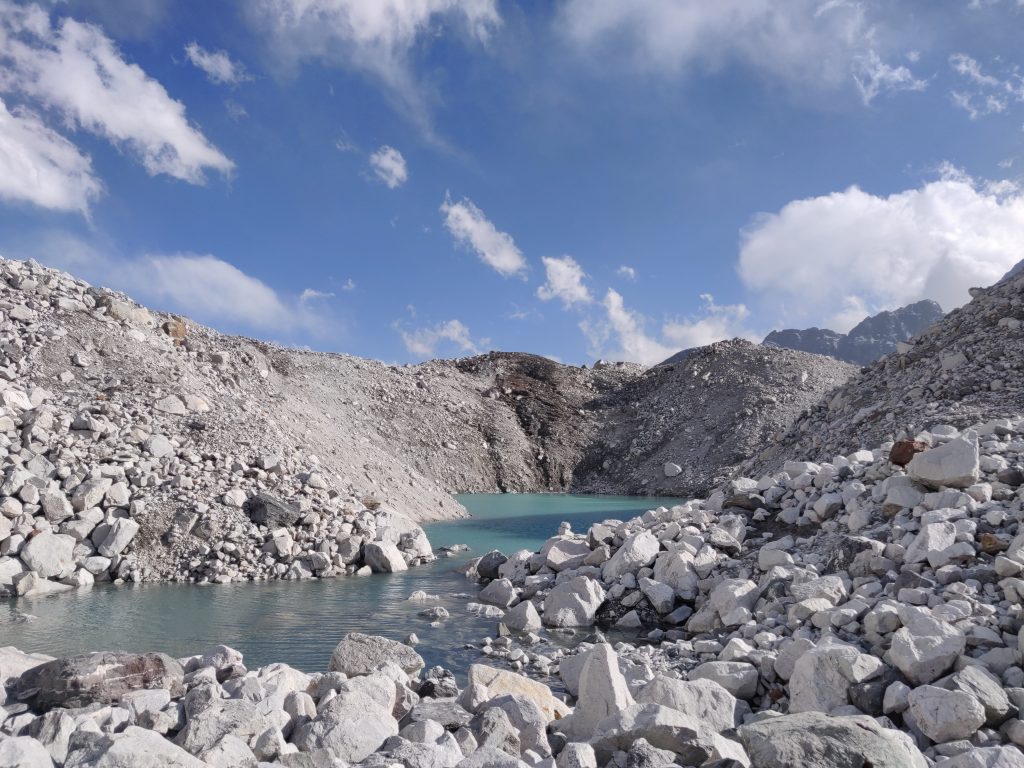
Climbing out of this pit was especially frustrating. Take a step, 1/3 comes down with gravel below a boot.
First impression of Gokyo – it’s a resort. Warm welcome from new hosts with a glass of hot orange and a deserved rest.
Day #13: Gokyo Ri Summit
Gokyo had wifi! We stayed in beds online for a little longer this time. Started climbing the last summit of the trek at 8:15. Mountain is like the rest, but with an extraordinary lake besides Gokyo. +610 grind with little oxygen, step by step to the top of Gokyo Ri…
Little settlement near the lake – that’s Gokyo. And just outside the “wall” is yesterday’s final “boss” – second glacier.
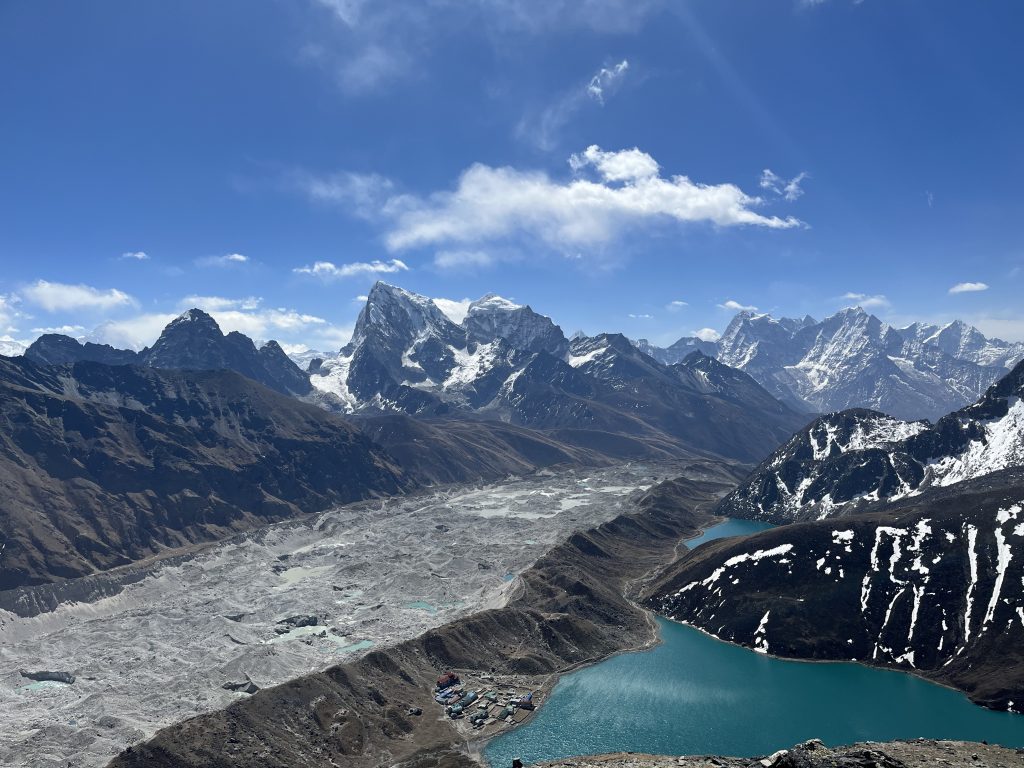
As a side note, we found a dog lying at the very summit. Cool. Weird, but cool. Can you find it?
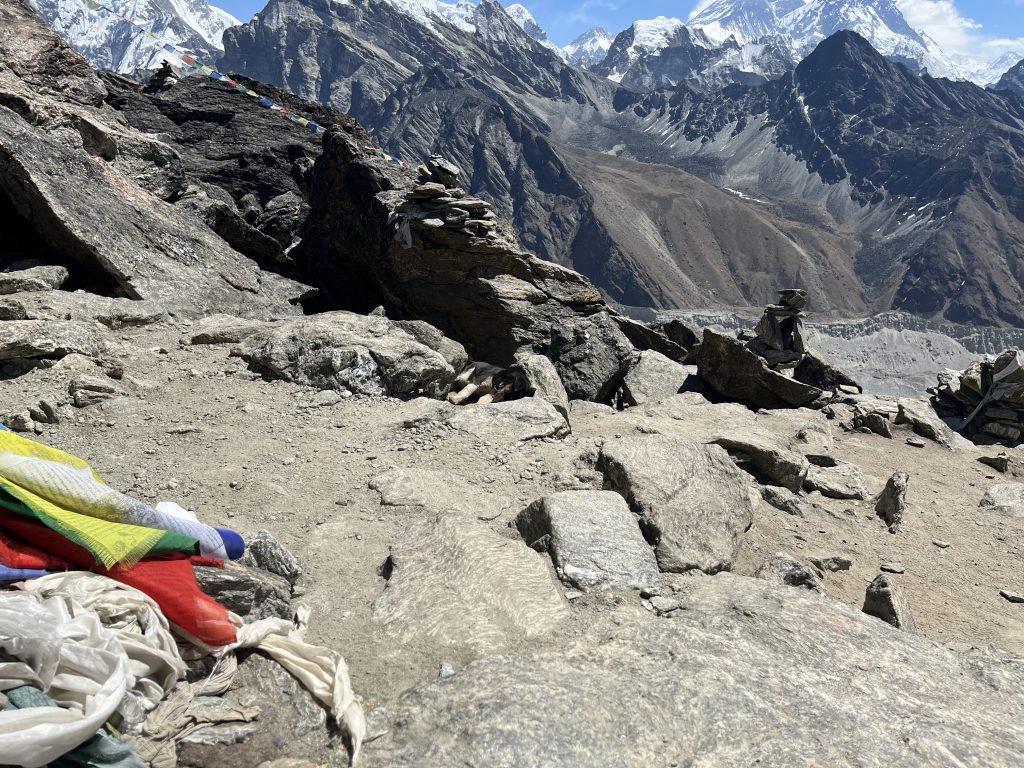
Another look at the highest of them all – the Everest.
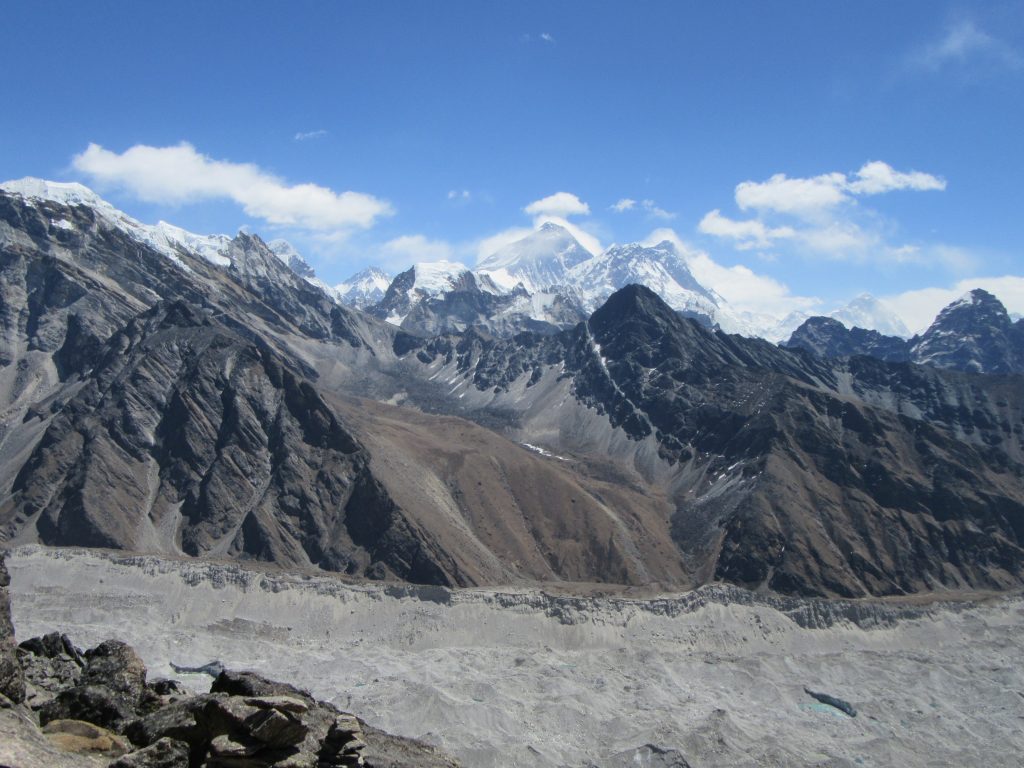
Going back to rest, try to use unstable wifi and prepare for last pass. Water ran yesterday, not today…
Day #14: Renjo La Pass
We are hiking for two weeks already! Time flies here. Morning with usual headache, that will be gone soon. We start hiking traditionally at 7:00. We reached Renjo La Pass top (5360 m) at 10:30. +610m had pretty steep stages, taking a breath away very literally. Bye Gokyo.
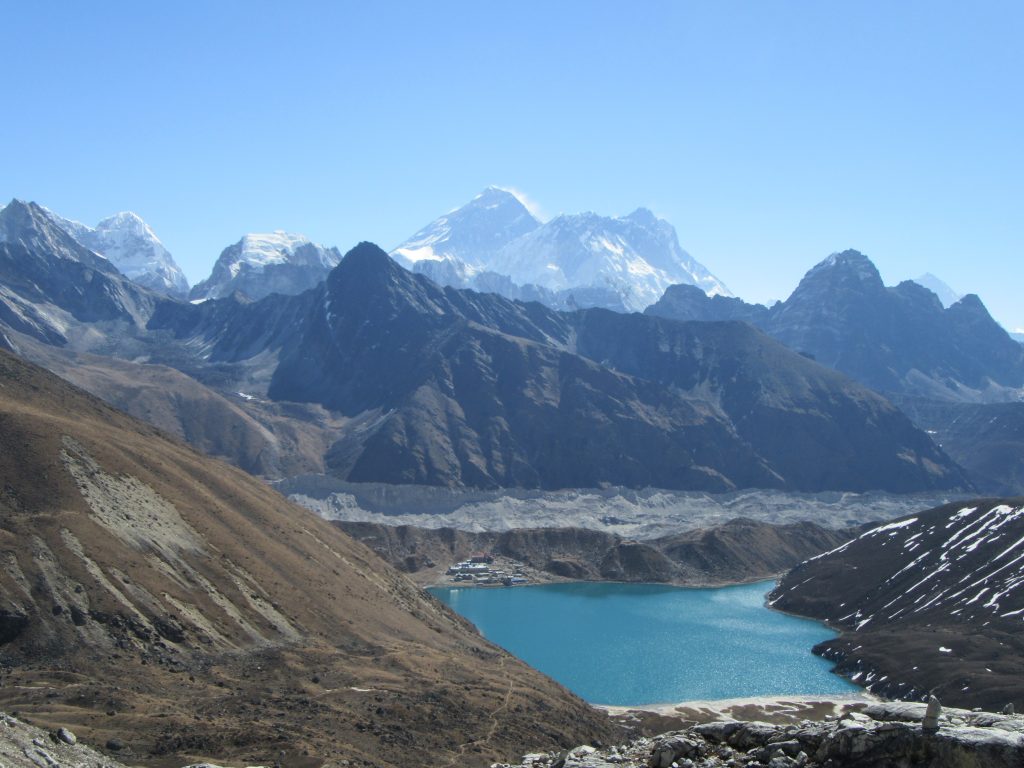
After the pass we start our two day descent back to Namche.
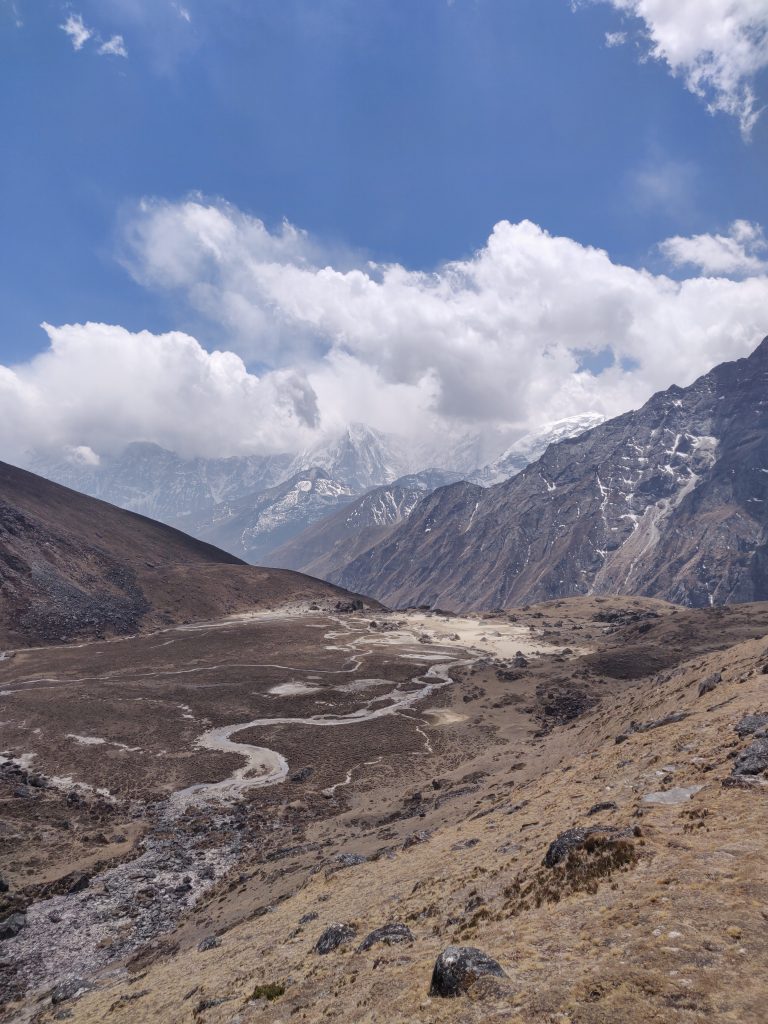
We take a stop to have lunch at a village I marked as Lunghen, which might have been Lumde (4370). Host woman had climbed Everest, Island Peak, Ama Dablam. And there we eat. “Serious trekkers” – hilarious.
We sleep again above our plan – closer to Namche – Tarangar (Taranga) (4380 m). At lodge I get to taste rice beer – interesting; ok.
Day #15: I Hate my Backpack so much I Stayed at Another Place
Road to namche.
We took around 5 hours to get back to Namche (3440 m). There had to be another hike uphill of course… Views were nice, trees started to show up again…
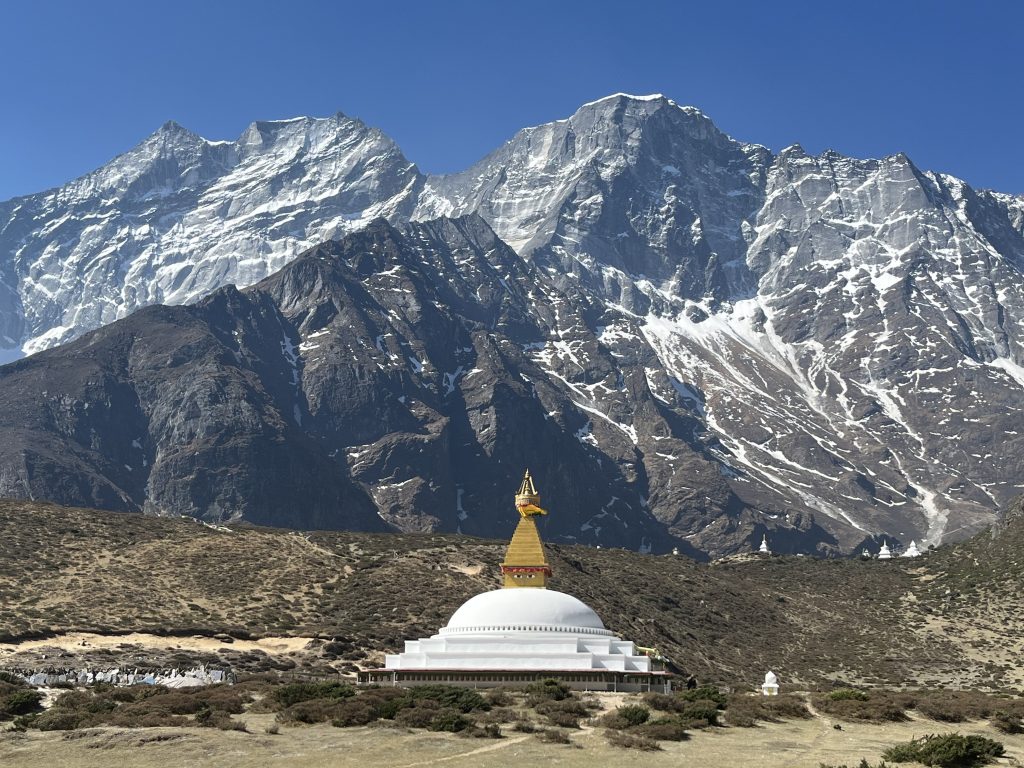
And finally Namche Bazaar again.
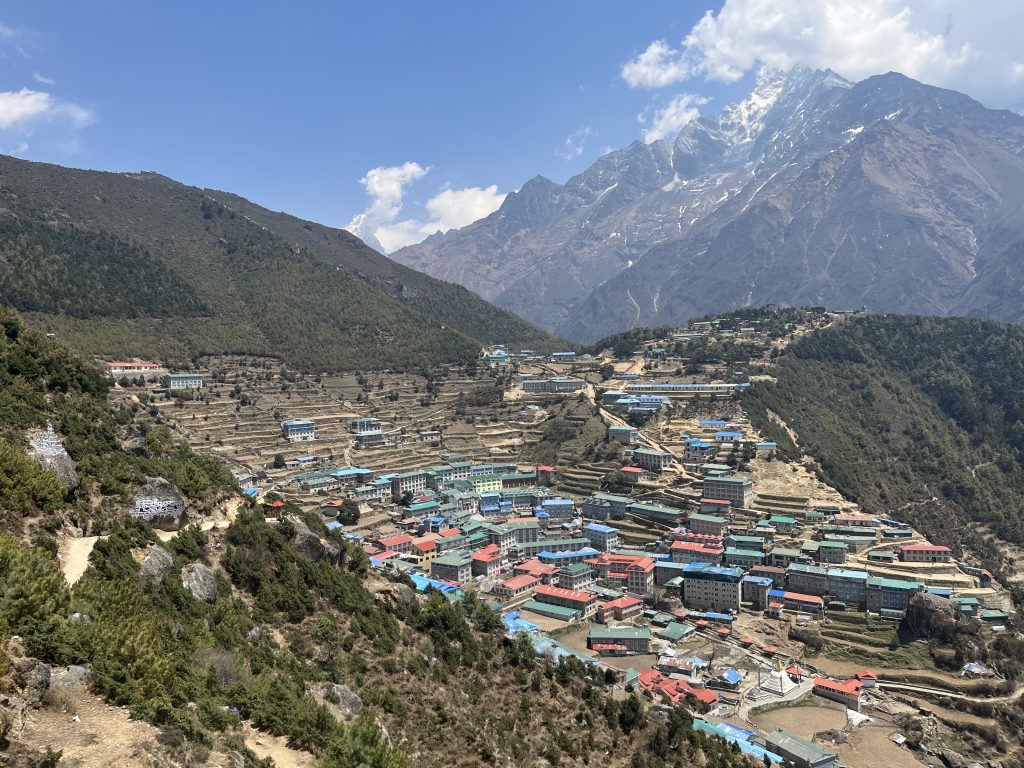
Celebration
Drop stuff off, take ouside cold tap “shower”, change clothes and .. to the Irish pub. With a short break we spent around 11 hours and way too much money on beer, but we felt we deserved a celebration. Rarely I get cheered by a third of a bar for playing pool well. Music and atmosphere was great.
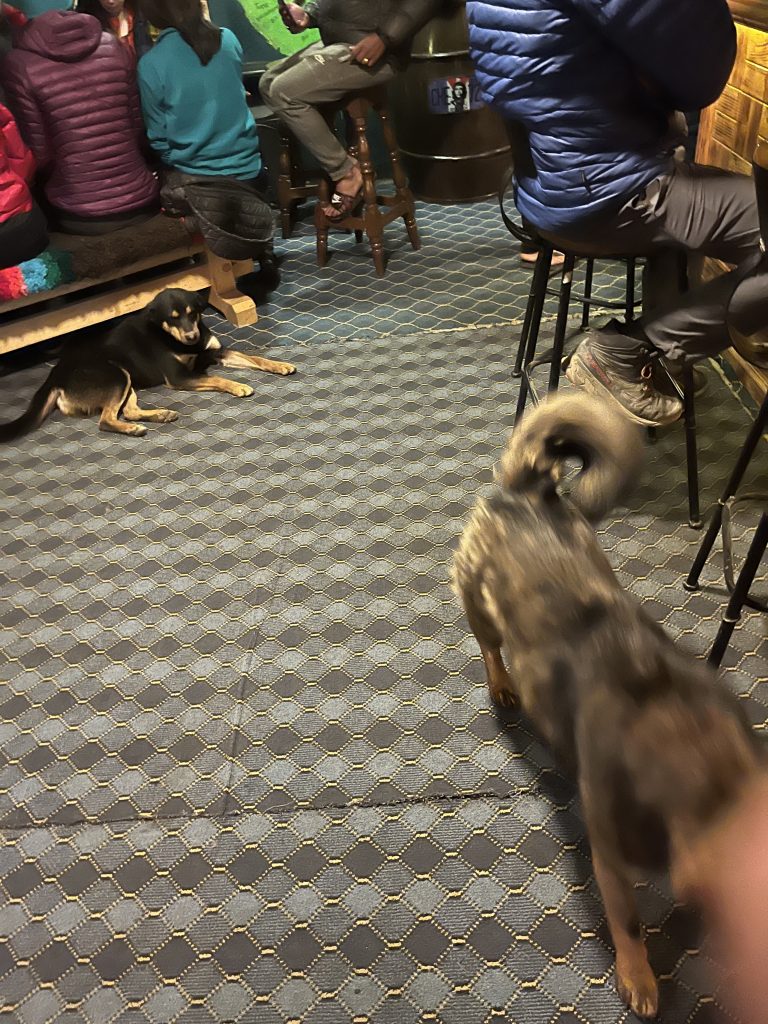
However our lodge closes doors at 10 sharp and we skipped that. Had to ask bar manager to find us a another place past midnight. To weirdly related tips:
The break I mentioned before: we bought some gifts and if you have an additional day in Kathmandu, there’s another one:
Day #16 Long and hangover’y Hike to Lukla
For us it was 7 hours (18km) hike with a killer ascent right before Lukla. Last third we walked through rain and thunderstorm. What an epic ending for the hike. Probably the only thing that made the day easier was the oxygen in the air.
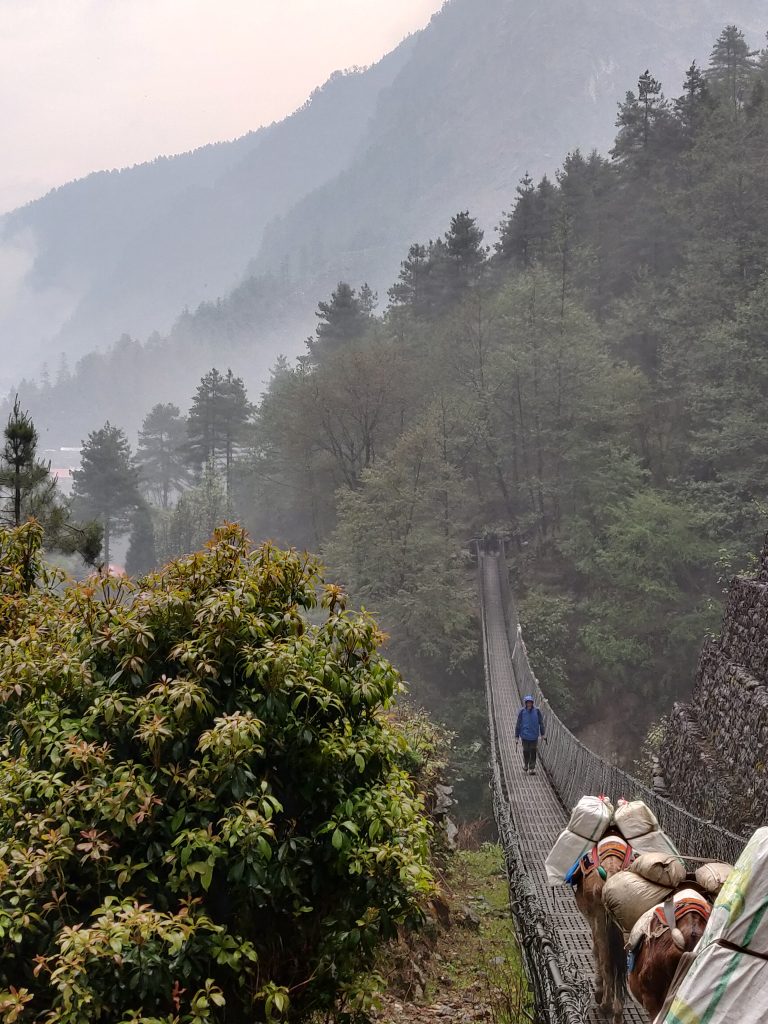
Another night, food poisoning in Lukla and a morning flight to Kathmandu.
Days #17, #18, #19 in Kathmandu
Flight back went without problems, if you don’t count a hour delay. Booked ourselves a 20 USD / night 4 “star” hotel to refresh ourselves with shower and warm sleep. In remaining three days:
- bought remainder gifts;
- got ourselves a massage (some very novel moves I might add);
- shared joints with locals and ourselves;
- both got food poisoning (nausea, high temperature, no energy);
- watched movies;
- ate cheap fruits and consumed internet inside a comfy bed.
Enough time to think how Nepal compares to Lithuania. For the other curious:

Quite naturally I omitted a lot, so want to bring focus to several points.
Nepalese are Great
People are super friendly and unlike elsewhere, taxi drivers, salesmen seem to seek win-win without outright scams and cheating. Nepals dominant religion is Hinduism (close ties with India), but some and Buddhists. And in mountains it’s de facto dominant. And Buddhism is beautiful .
When people greet you in Kathmandu with “Namaste” – I felt some guilt to have a preconceived notion there’s a sales pitch lurking behind a greeting, but at times, people were just genuinely friendly towards tall white dudes.
Mountains Humble You Fast
It’s somewhere above 5000m and air is thin. There was a steep ascent, that is not finished. There’s a rock, with height up to your knees. You walk slowly and position your feet right at the stone, so there’s no excessive leg lift or movement. You place both your poles on the rock, inhale and push your body upwards. Another step made.
Never in my life I felt so weak while being healthy. During smoke in Kathmandu in daunted on me: 50 years from now, I’ll moving like this at normal altitude in my home or on a way to the shop. I’ll probably be using the same body mechanics. What a mind trip into the future…
At least I’ll have a memory of walking among the highest peaks on this planet.
Trekkers are Awesome
Me met 70 olds that have climbed peaks in Himalayas, visited EBC multiple times. We could barely catch some of them. A lot of people are doing EBC / Three Passes Trek, that started -1/+1 day from you. Faces start to repeat, conversations deepen, temporary hike friendships form.
Great stories with one reoccurring theme, some people are here for the second time. They did Annapurna trek first. It’s easier, lower. Take this with a grain of salt, as we had not done it, but:
Unless you have time, budget and willpower to fly and walk multiple treks multiple times, it makes little sense. Planet is too diverse and there are too many places waiting to be discovered.
I May Have the Best Friends
Similarly to the publicly untold story of 1100 km bicycle trip across Spain coastline years ago, none of this could had happened if not for the invite to join by my friend. Eternally grateful for this challenge.
Now onto the next one. Peace out.
You might also like
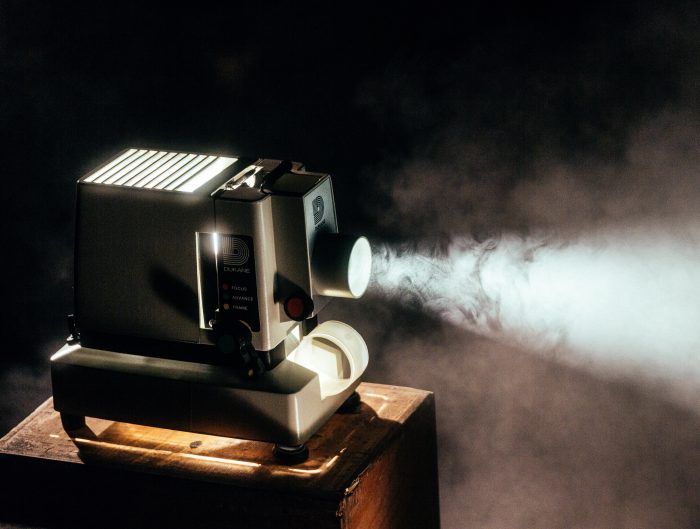
Leave A Reply
Leave a reply cancel reply.
Your email address will not be published. Required fields are marked *
Save my name, email, and website in this browser for the next time I comment.
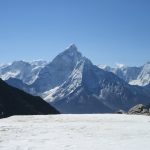
- Africa & the Middle East
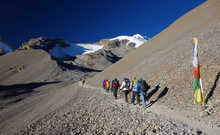
- The Three Passes Trek
- Kandoo Trekking
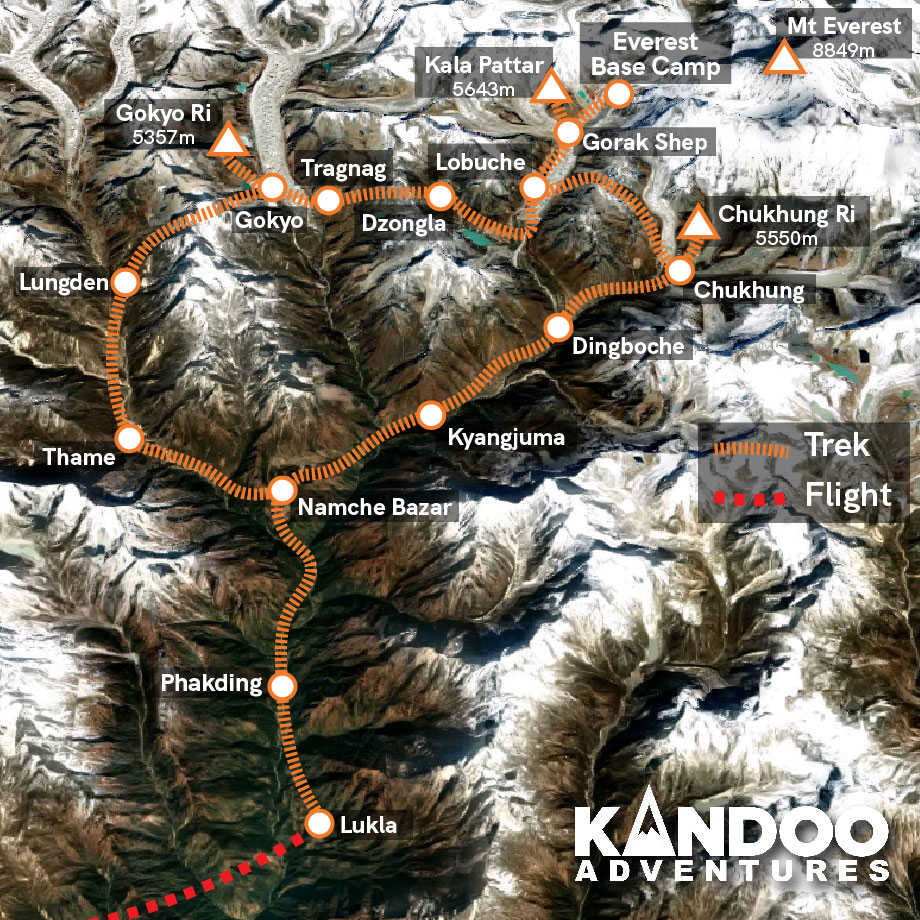
Contact our UK team
Our local team
Kandoo's view, trip highlights.
- An amazingly scenic circular route, climbing three peaks
- Cross the challenging Renjo La, Cho La and Kongma La Passes
- Lodge-based accommodation
Experiences
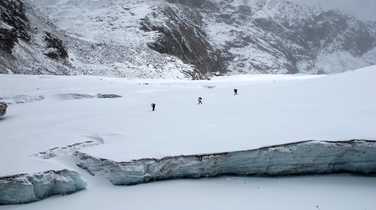
ARRIVE IN KATHMANDU
All trekkers need to organise their own flights to Kathmandu International Airport (KTM). From the airport we will arrange a private transfer to your hotel. That night you will meet your local Kandoo representative and have a full pre-trek briefing
- Accomodation: Hotel
FLIGHT TO LUKLA – TREK TO PHAKDING
The flight from Kathmandu to Lukla takes 45 minutes and is an adventure in itself with great views of the Everest region and ending with a hair-raising landing on a steep mountain runway. After meeting our crew, we will start our trek by heading up the Dudh Koshi Valley on a well- marked trail to Phakding.
- Transport: Flight (0.8 hour, 136 km)
- Hiking time: 3 - 4 hours
- Ascent: 1500 m
- Descent: 144 m
- Max. altitude: 2800 m
- Accomodation: Teahouse
- Meals included: Breakfast
TREK TO NAMCHE BAZAAR
From Phakding, we cross and re-cross the river on high suspension bridges. Beyond Monjo is the entrance to the Sagarmatha National Park. We then ascend steeply to Namche and along the way, if the weather permits, catch the first glimpse of Mt Everest. Namche Bazaar is the main trading village in Khumbu and has a busy Saturday market. You can enjoy an Illy coffee and amazing brownies here!
- Hiking time: 6 - 7 hours
- Ascent: 794 m
- Max. altitude: 3450 m
ACCLIMATISATION IN NAMCHE
Namche is tucked away between two ridges and has lots of lodges, tea shops and souvenir shops. Today we will trek up to the Everest View Hotel at 3880m for our first view of Ama Dablam and Mount Everest. Following the ‘walk high, sleep low’ principle, this hike will really help with your acclimatisation.
- Ascent: 430 m
- Descent: 430 m
- Max. altitude: 3880 m
TREK TO THAME
The trail now splits from the popular base camp route and heads north-west to the village of Thame where you will be staying the night. Take some time here to learn a bit about the local traditions and their intrinsic connection with the mountain on which you are standing.
- Hiking time: 4 - 5 hours
- Ascent: 434 m
- Max. altitude: 3884 m
TREK TO LUNGDEN
Today we will start to climb back up to higher altitude heading up the valley to Lungden. Make sure you have your camera at the ready as the higher you go the views across the snow-capped peaks in the region just get better and better.
- Ascent: 496 m
- Max. altitude: 4380 m
TREK TO GOKYO VIA RENJO LA PASS
Today wewill encounter the first of the Three Passes – Renjo La. The route starts off gently but will soon turn into a hard day of hiking as we near the end of the ascent to Renjo La. Try to think of the magnificent views you will get at the top to motivate you! After the pass, we will descend to the third of the beautiful turquoise Gokyo Lakes and then trek onto the village of Gokyo for the night.
- Hiking time: 7 - 8 hours
- Ascent: 1008 m
- Descent: 638 m
- Max. altitude: 5388 m
ASCENT OF GOKYO RI
Today you climb your first peak, Gokyo Ri, for fabulous views of Cho Oyu. We start the climb early and then have the rest of the day to rest to help our acclimatisation. If we still have energy, then later in the day we can hike up some of the surrounding moraine ridges and enjoy the views. As a treat for all our hard work we can then tuck into some delicious cake from the wonderful Gokyo bakery.
- Ascent: 733 m
- Descent: 733 m
- Max. altitude: 5483 m
TREK TO TRAGNAG
We leave Gokyo to cross the Ngozumpa Glacier. We descend to the second lake and drop down onto the glacier. The route across the glacier is marked by cairns and is generally quite well defined. We climb off the glacier and follow a shallow valley to Tragnag.
- Descent: 60 m
- Max. altitude: 4750 m
TREK TO DZONGLA VIA CHO LA PASS
An early start is required today to cross the Cho La Pass and make the long descent to Dzongla. Continuing up the valley, we cross a ridge and an old lateral moraine, before beginning the rocky scramble to the pass. From the top there are excellent views, across to the Rolwaling Valley in the west and Ama Dablam to the south east. The descent from here involves crossing a small glacier which is fairly straightforward. There are more excellent views of Ama Dablam and Cholatse as we descend.
- Ascent: 730 m
- Descent: 590 m
- Max. altitude: 5420 m
TREK TO LOBUCHE
The way to Lobuche contours the grassy slopes above a lake, the Tshola Tsho, to join up with the main Everest trail from Pheriche and Tengboche. The trail flattens out and follows the valley on the west side of the Khumbu Glacier to Lobuche.
- Ascent: 98 m
- Descent: 4928 m
TREK TO GORAK SHEP – EVEREST BASE CAMP – GORAK SHEP
To reach Everest Base Camp, we follow the Khumbu Glacier. The trail offers superb views of the surrounding mountains, especially where the path is forced to rise to cross a tributary glacier. We stop at Gorak Shep before making our way to Base Camp itself. This takes several hours as the trail weaves its way through ice pinnacles and crevasses of the Khumbu Glacier.
- Hiking time: 8 - 9 hours
- Ascent: 436 m
- Descent: 200 m
- Max. altitude: 5364 m
ASCENT OF KALA PATTAR - TREK TO LOBUCHE
An early morning start is needed to summit the trekking peak of Kala Pattar – the iconic viewpoint of Everest. After snapping some pics, we head back to Gorak Shep for a quick meal before descending further to Lobuche for the night.
- Ascent: 390 m
- Descent: 626 m
- Max. altitude: 5554 m
TREK TO CHUKHUNG VIA KONGMA LA PASS
We leave the classic base camp route today as we head east through the Khumbu Glacier to reach the third and final pass of the trip – Kongma La. At 5,535m the pass is the highest of the three. After a tiring ascent to the top, we descend into the Chukhung Valley and eventually to the village of Chukhung where we will stay in the lodge overnight.
- Ascent: 607 m
- Descent: 785 m
- Max. altitude: 5535 m
ASCENT OF CHUKHUNG RI - TREK TO DINGBOCHE
Today we will climb Chukhung Ri - the hardest of the three peaks on this trek which involves some easy scrambling near the summit. The views from the top down the Khumbu Valley are superb. We descend to Dingboche.
- Ascent: 800 m
- Descent: 1190 m
- Max. altitude: 5550 m
TREK TO KYANGJUMA
We now descend back to the main Everest trail through Pangboche before climbing to the monastery at Tengboche. From Tengboche we make a steep descent before climbing back up to Kyangjuma where we will stay overnight in a lodge.
- Descent: 696 m
- Max. altitude: 4360 m
TREK TO PHAKDING
We continue through Namche Bazaar, descend Namche Hill and cross the Dudh Koshi. We will trek back along familiar paths to Phakding where we will stay the night.
- Descent: 1008 m
- Max. altitude: 3664 m
TREK TO LUKLA
Our final day's trekking follows the Dudh Koshi back down to Lukla. This last evening in the mountains is the ideal opportunity for a farewell party with the Sherpa guides and porters, where you can look back on a memorable trekking experience.
- Ascent: 144 m
RETURN TO KATHMANDU
After an early breakfast, we will begin our return journey to Kathmandu.
FREE DAY IN KATHMANDU
A free day in Kathmandu to explore the city at your leisure
DEPART FROM KATHMANDU
We will collect you from your hotel and transfer you to Kathmandu Airport for your departing flight.
Trip information
Formalities & health, equipment & clothing.
Treks in the Himalaya present a substantial physical challenge , and the more fit you are before you start, the more you will enjoy your trek. However, the number one most important thing to cultivate is mental toughness . Most of the people who trek in the Himalaya aren’t professional athletes or mountain climbers; they are average people with an unusual degree of determination.
If you are comfortable walking for 7-8 hours with an ascent of 1000m every day for two weeks then you are certainly fit enough to succeed on this trek. We find that all successful hikers share a real Kandoo attitude and that means high levels of grit and determination.
Food & drink
You choose what you want to eat at the lodges, and settle your own bill in the morning. While you can eat heartily for very little money at any lodge, we do recommend that you budget £20 to £25 ($30 to $35) per day for meals and drinks. This will ensure that you not only have plenty of food, but that you enjoy it a lot more. Where once there was a choice of perhaps 5 different rice or lentil based meals at any one lodge, most now offer a wide menu of 40 or more choices from the basic (such as dhal bhat) to the sophisticated (yak steak with blue cheese sauce).Please note that we prefer some of the more expensive lodges, so the prices are higher than they might be at more spartan facilities.
One word of advice, place your meal order as soon as you can upon arriving at the lodge as it is strictly ‘first ordered, first served’, and the best lodges are quite busy at meal times.
Accommodation
Trekking in Nepal is more popular than ever. As a result, the standard of accommodation available on most of the trek routes has improved dramatically. Where there were once simple peasant huts, large hostels have been built featuring running water, indoor toilets (some en-suite) and electricity. However, while internet access, charging facilities and hot water are available, you will need to pay to use them - if you plan on using the internet and showering every day, then you should budget around $10 per day.
However, development is still ongoing, and as you get higher into the mountains the lodges become more basic. Furnishing is generally fairly spartan, and most rooms feature little more than a bench bed and a thin mattress, so your sleeping kit will probably see some early use. Showers are not always available and it tends to be just the communal areas that are heated.
The exception to that rule is Namche. Namche features some really great lodges, including the Hil-Ten (this is not a region that makes much of copyright infringement) and if you are in need of refreshment there both Illy and Lavazza coffee are available
Kandoo has a list of lodges that we prefer to work with, all of which are regularly inspected to ensure the best quality rooms available. Even at the worst, they are clean and well-kept. When the route is busy, we send a porter ahead to hire rooms for the night, as they cannot be reserved in advance.
The general standard of driving throughout Nepal is poor and badly regulated . Roads in Kathmandu are very congested, many drivers are not properly licensed and vehicles are poorly maintained. During the monsoon season (June to September) many roads outside the Kathmandu valley are prone to landslides and may become impassable.
We insist on using a high standard of vehicle and driver for all of our transfers. In Nepal it is not a legal requirement to have seatbelts fitted in the back of vehicles, and while we try to use vehicles that do have rear seatbelts fitted, this cannot always be guaranteed. If you are unhappy about any aspect of the vehicle or the standard of driving, please speak to the driver or our local office.
Duffel bags
You will be provided with a large duffel bag at the pre-trek briefing that will be yours to use for the duration of your trek. Your equipment will then need to be transferred into this bag. If you are travelling with a duffel bag then it is up to you which bag you choose to use for the trek, if you are travelling with a suitcase then this will need to be left at the pre-trek hotel and collected upon your return as our porters need the bags they carry to be flexible.
All items must be packed in your main equipment bag. They should not be attached to the outside, as we are not responsible if items fall off when the bags are being carried on the trek.
How do I get there?
Budget & change.
If you are relying on a credit or debit card for emergency funds, make sure you tell your card issuer that you will be using it abroad, or you may find that it won't work when you really need it.
We realize that tipping may not be a common practice in all countries but for Nepal it is a standard practice that all operators support. The decision on how much to tip should be determined by how well the team served you while you were on the trek. Tips are always discretionary and if you are not happy with the service you have received you do not have to pay tips. Tips can be made in US dollars or Nepali Rupees. It is very important that US bills be new (less than 10 years old), crisp and untorn.
We are members of the Trekking Agencies Association of Nepal and the Nepal Mountaineering Association, and follow their guidelines when recommending tip levels for guides and porters. We would suggest you budget $175-$225 per trekker for your tip contribution.
We say goodbye to our porters in Lukla before we return to Kathmandu. Any tips that you wish to give to the porters will need to be carried on the trek with you.
Vaccinations
Equipment supplied by kandoo adventures.
We do not have other gear available for rental but there are many places offering gear for rental in Kathmandu and we can recommend a number of places for you. The quality of rental gear is very variable and it is your responsibility to check carefully the condition of any item you rent. We accept no responsibility for the quality of equipment hired. An indication of the likely rental costs is below.
- Four Season Sleeping Bag - $2 per day
- Down Jacket - $2 per day
- Trekking Poles - $1 per day
Most of the rental shops close around 8pm, so if you are arriving on a late flight the day before the trek starts there will not be an opportunity for you to visit a rental store. If you are planning on renting equipment, you need to make sure you have allowed sufficient time at the beginning of your trip.
All rental equipment is included in your overall trekking bag weight, so make sure you have allowed for this when packing your bag at home. A sleeping bag will weigh around 2kg.
Clothing to bring
- Warm beanie style hat – knitted or fleece
- Neck gaiter or scarf. It can get dusty in Nepal and the air very cold. A scarf or balaclava comes in useful for keeping dust out and can double as a warm layer for your neck / face!
- Sun hat – preferably wide-brimmed for protection
- Sunglasses – high UV protection
- Headlamp (plus extra batteries)
- Thermal or fleece base layer (x2)
- Long sleeve shirt/tshirt – light or medium weight, moisture wicking (x3)
- Short sleeved shirt/tshirt – lightweight, moisture wicking (x2)
- Fleece or soft shell jacket (x2)
- Insulated jacket – down or primaloft
- Lightweight water/windproof hard shell outer jacket
- Gloves – lightweight, fleece or quick drying fabric
- Gloves or mittens – heavyweight, insulated, preferably water resistant
- Leggings – thermal or fleece base layer (x1)
- Trekking trousers – light or medium weight (x2) – convertible trousers work well
- Waterproof hard shell trousers – ski pants work fine (x1)
- Trekking boots – mid weight with good ankle support
- Training shoe or similar – to wear around the teahouses
- Micro-spikes – may be required in snowy conditions
- Mid-weight trekking socks (x5 pairs)
- Breathable, high-wicking liner socks (x3 pairs)
- Thermal trekking socks for upper reaches of your trek (x1 pair)
Equipment to bring
- Small Rucksack or Daypack (30-40 litres) to carry water and personal items
- Sleeping bag (4 season or -10 Deg C) and compression sack
- Trekking poles
- Water bottle or hydration bag – must be able to carry 1.5-2L of water
OTHER ACCESSORIES
- Sunscreen and lip balm - high SPF
- Toiletries, including toilet paper, wet wipes and hand sanitiser – please carry all rubbish back off the trail
- Camera and spare batteries
- Plug adapter, for charging devices in teahouses and hotels
- Personal medication and first aid kit
- Personal snacks and energy bars – dried fruit and nuts are also a good source of energy
- Isotonic drink powder / energy drink powder to mix in with your water. This improves flavour and helps replace electrolytes
- Microfibre towel for wiping hands and face each day
- Ear plugs, if you are a light sleeper
- Pee bottle, useful for late night toilet needs
- Dry bag (only required if your main duffle bag is not waterproof)
Dates & prices
Want to ask us a question or book a private trip? Don't hesitate to contact us!
Price includes
- Your hotel stay for one night before and two nights after the trek
- All airport transfers
- Return flight between Kathmandu and Lukla
- National Park entry and TIMS fees
- A fully supported trek with a qualified mountain guide
- All drinking water on the trek
- Teahouse accommodation on a room only basis
- Access to emergency oxygen and first aid kit
Price does not include
- International airfares and visas
- Tips for your guides and porters
- Personal items
- Travel insurance (you must be insured, and specifically for treks up to 6000m)
- Your personal trekking gear
- Your personal medicines or prescriptions
- Meals and drinks on the trek
- Meals and drinks in Kathmandu (breakfast is included)
- Additional hotel nights before or after your climb
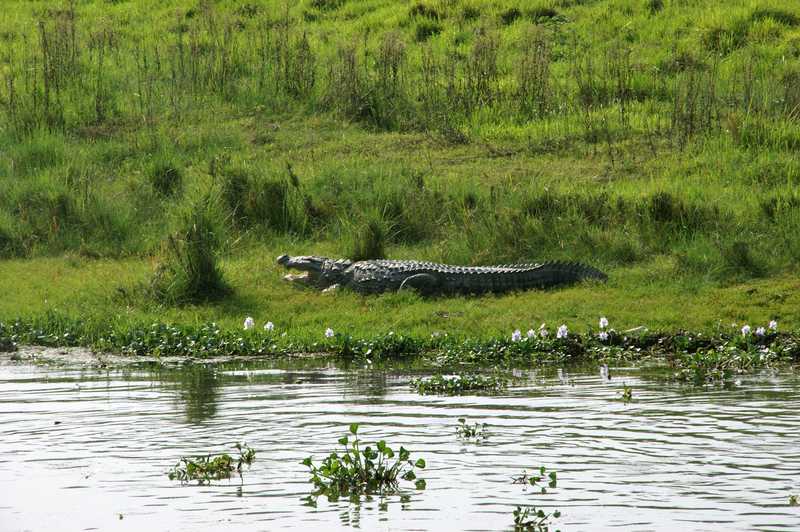
Chitwan National Park 3-day extension
You may also like.
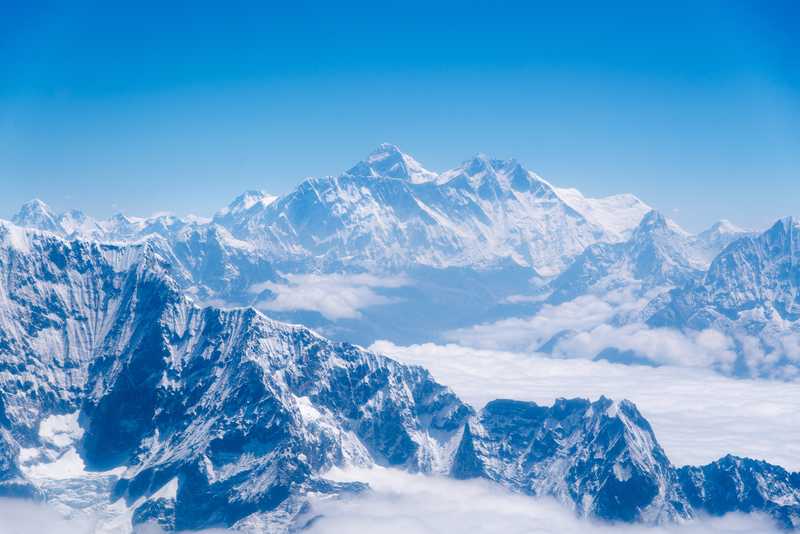
Everest Base Camp
- from $1,725
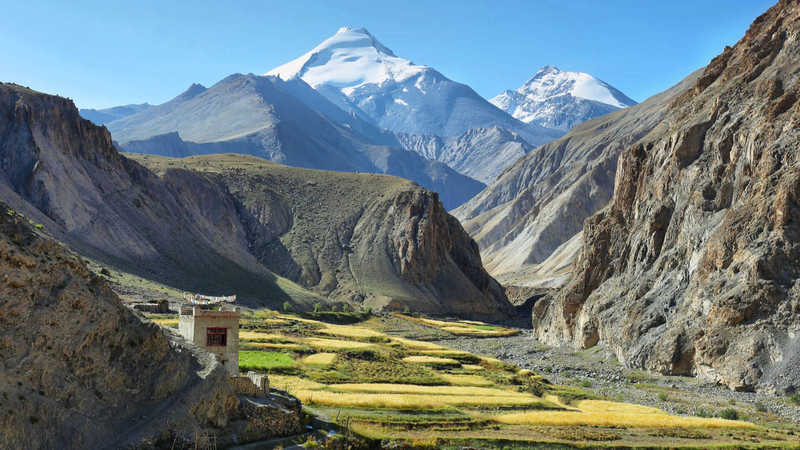
Markha Valley and Kang Yatse II
- from $2,335
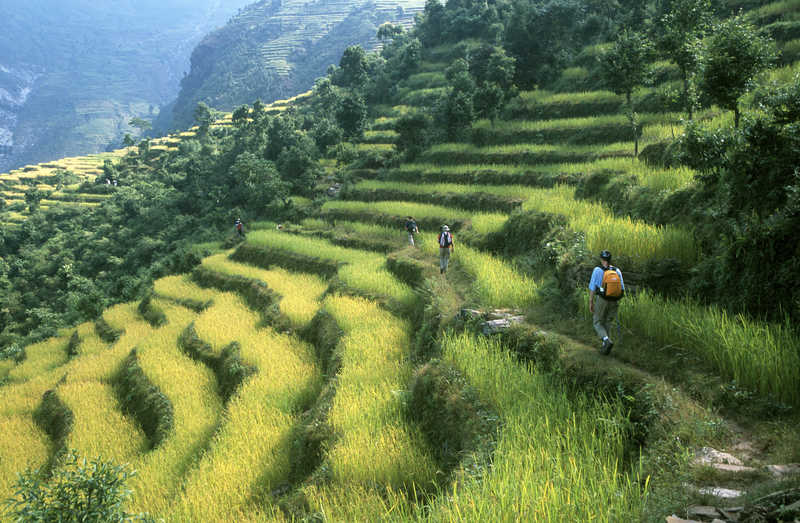
Poon Hill Trek
- from $1,365
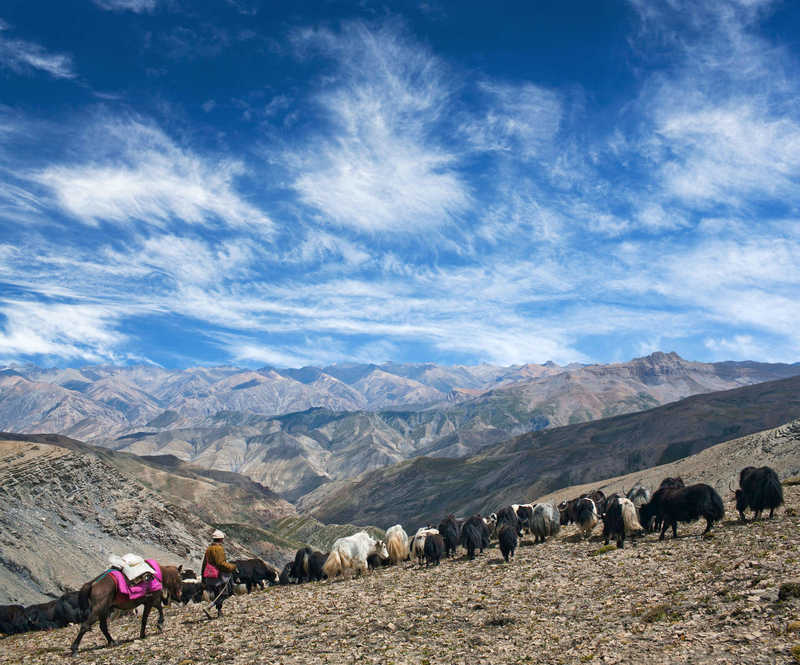
Changtang Lakes to Spiti Valley
- from $3,385
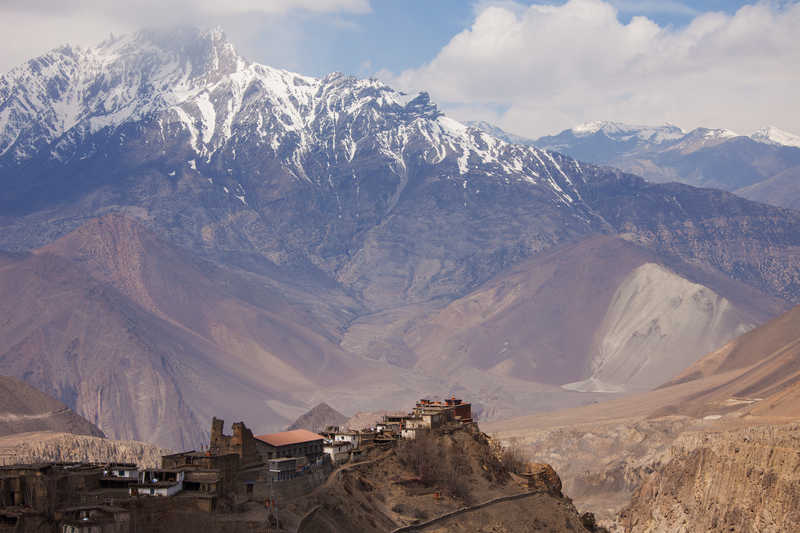
The Chomolhari Trek
- from $4,095
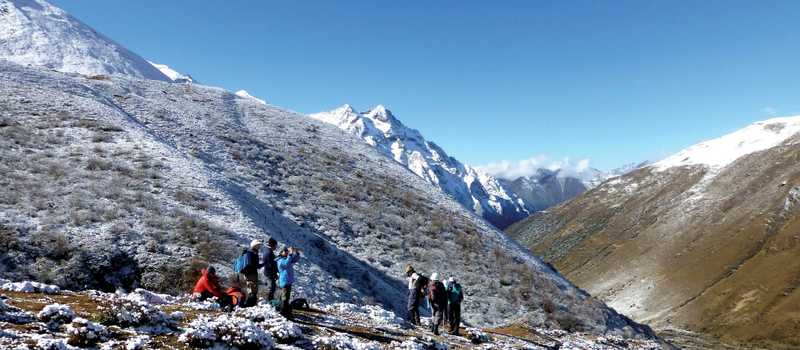
The Snowman Trek
- from $12,345
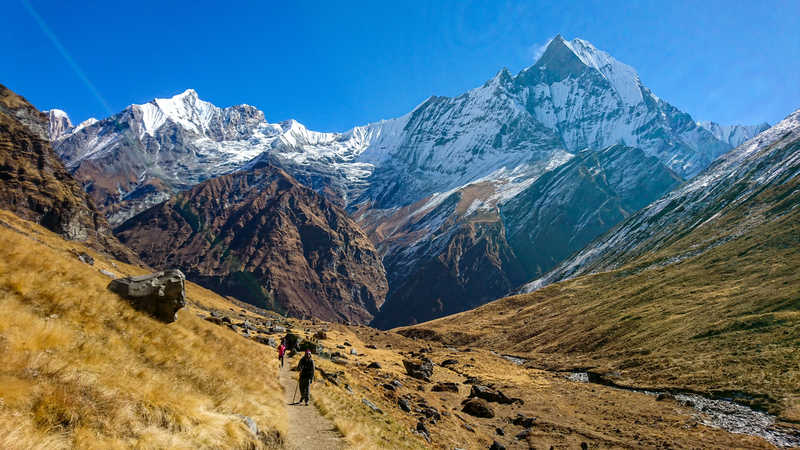
The Annapurna Sanctuary
- from $1,555
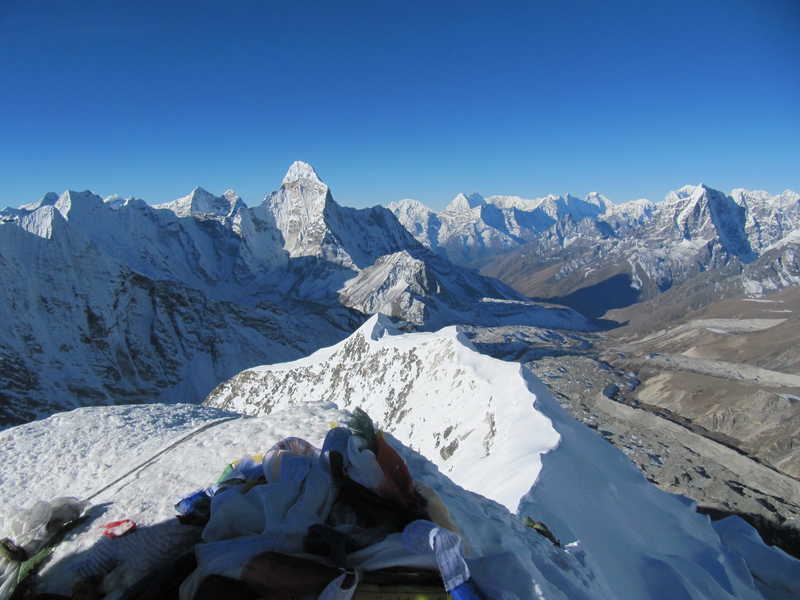
Everest Base Camp and Island Peak
- from $3,575

- Colombie Britannique
- Ruines du nord
- Centre – Montagnes
- Où partir ?
Trek des 3 cols (Three Passes Trek) – Népal
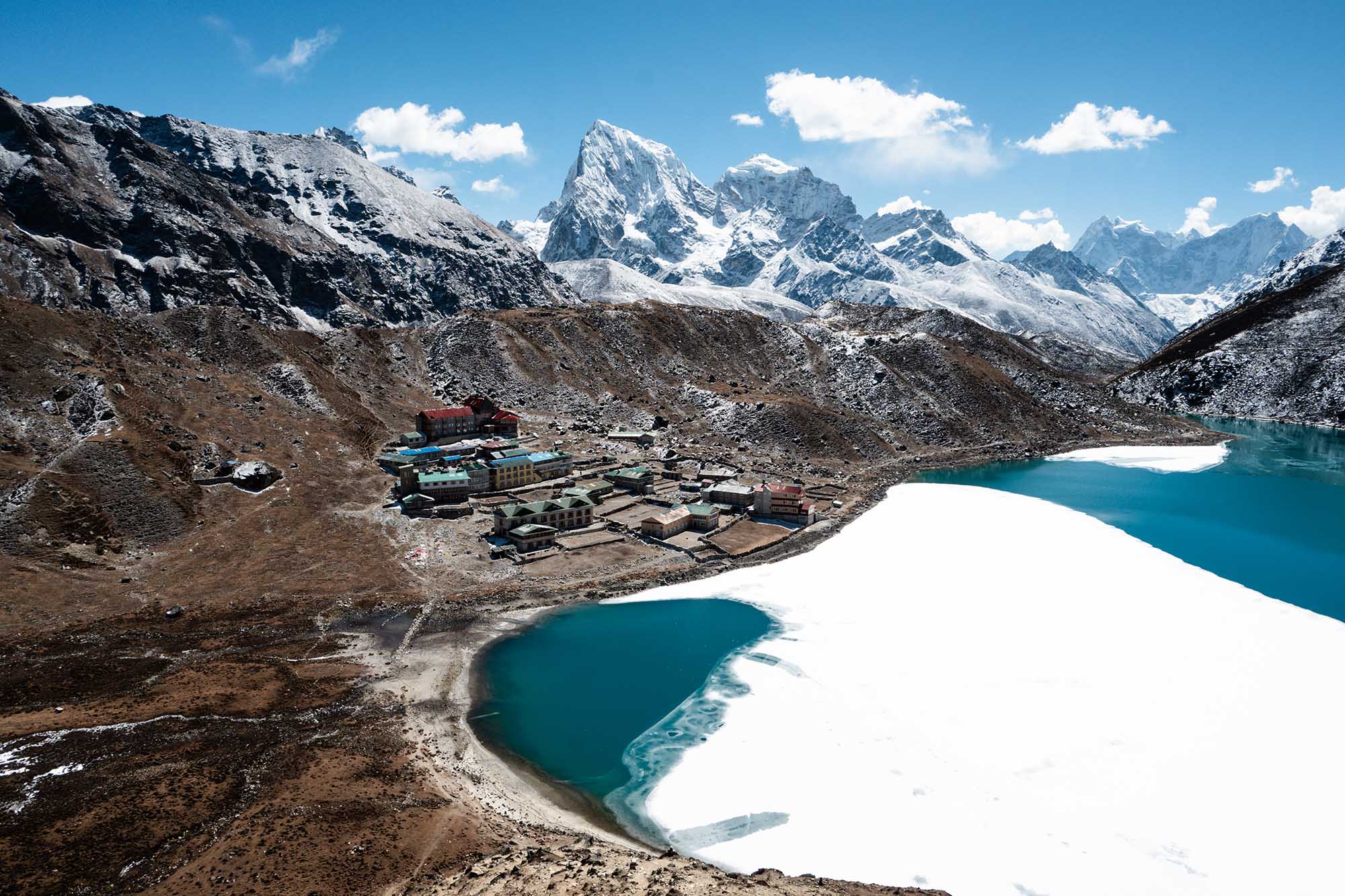
Trek des 3 cols ou le Three Passes Trek au Népal. Ce trek qui sort des sentiers battus et qui emprunte des chemins peu fréquentés. Je vous raconte cette aventure !
Dans cet article je vais vous partager cette super aventure qu’a été le Trek des 3 cols dans le sens des aiguilles d’une montre. Un long article, jour après jour, qui j’espère, vous donnera envie de suivre ces sentiers.
Tout savoir sur ce trek
- 1 Tout savoir sur ce trek
- 2.1 Le Visa
- 2.2 Prendre ses permis ou ticket de parc national en avance ?
- 2.3 Avoir un guide… ou pas.
- 3 Dans quel sens faire ce trek ?
- 4 Quel budget pour le Trek des 3 Cols ?
- 5 Quel équipement prévoir pour le trek ?
- 6 Map du Trek des 3 Cols
- 7.1 Le trajet
- 8 Jour 1 – Lukla vers Monjo
- 9 Jour 2 – Monjo vers Namche
- 10.1 Le village
- 11 Jour 4 – Thame
- 12.1 Les lodges
- 13.1 Le réveil
- 13.2 L’ascension
- 14 Jour 7 – Gokyo
- 15.1 Le glacier
- 16.1 Étape une
- 16.2 Etape deux
- 16.3 La descente
- 17.1 On arrive enfin
- 18.1 Kala Patthar
- 18.2 Camp de Base de l’Everest
- 19 Jour 12 – Lobuche
- 20.1 À la conquête de Dingboche
- 21 Jour 14 – Namche
- 22 Jour 15 – Surke
- 23.1 Les 2 chemins
- 23.2 Thame Dada vers Adderi
- 23.3 Adderi vers Salleri (un cauchemar)
- 24.1 Fin de journée, ça se complique…
- 25.1 EBC or not EBC
- 25.2 Timing
- 25.3 Rentrer sur Katmandou
Comment préparer le Trek des 3 cols ?
Pour commencer, il va vous falloir un visa . Je vous explique comment avoir son Visa pour le Népal , dans un petit article dédié, c’est le visa le plus simple et rapide que j’ai jamais vu !
Prendre ses permis ou ticket de parc national en avance ?
Aucune inquiétude, vous pourrez les acheter sur place. Il y’a des checkpoint où ils les vendent.
Avoir un guide… ou pas.
Il y a 2 camps : ceux qui prennent un guide et/ou porteur (Sherpas) et ceux qui partent solo . Je suis plutôt de la team solo pour diverses raisons (autonomie, liberté dans le timing, ne pas se sentir responsable de quelqu’un, etc.), mais les deux se valent. Il n’y a pas de bonnes ou de mauvaises situations.
Aujourd’hui, il y’a de nouvelles règles sur les guides obligatoires au Népal. Mais le Trek des 3 Cols et l’EBC Trek sont dispensés d’obligation de guide.
Pour avoir un guide, de nombreuses agences en proposent. Elles conseillent fortement d’avoir un guide ET un porteur, car les guides-porteurs ne seraient pas très expérimentés.
J’ai donc pris un billet direction Katmandou (du 2 au 26 mars) !
Dans quel sens faire ce trek ?
La majorité des personnes le fera dans le sens inverse des aiguilles d’une montre. C’est en effet plus facile car la montée des cols est « douce » et la descente raide. Dans l’autre sens, celui que l’on a choisis, c’est plus complexe car on se prend de gros dénivelés en montant et des plus petits en descendant de l’autre coté des cols.
Ca permet aussi d’avoir de magnifique paysage en passant le col (dans l’autre sens, vous avez le paysage dans le dos).
Quel budget pour le Trek des 3 Cols ?
Pour comprendre mon budget, voici comment j’ai voyagé : nous étions 2, sans guide, sans porteur, dormis en lodge tous les soirs et repas matin, généralement sandwich le midi et repas le soir.
Plus on monte en altitude plus les prix augmentent (car les frais des porteurs augmentent également).
- Prix du billet d’avion Katmandou / Lukla : 190$
- Lodges : entre 12 à 20€ la nuit Pensez à négocier la nuit en leur disant que vous mangez sur place. La nuit passe de 4€ à 0€.
C’est un peu les seules dépenses… il faut donc compter en moyenne 15€ par jour sur le trek. À ça vous ajouterez surement des cartes wifi à 4€ les 24h et une semi douche chaude à 3€
Quel équipement prévoir pour le trek ?
Pour éviter d’agrandir cet article déjà très long, j’ai décidé de dédier un article à l’équipement nécessaire pour le Trek des 3 Cols.
Map du Trek des 3 Cols
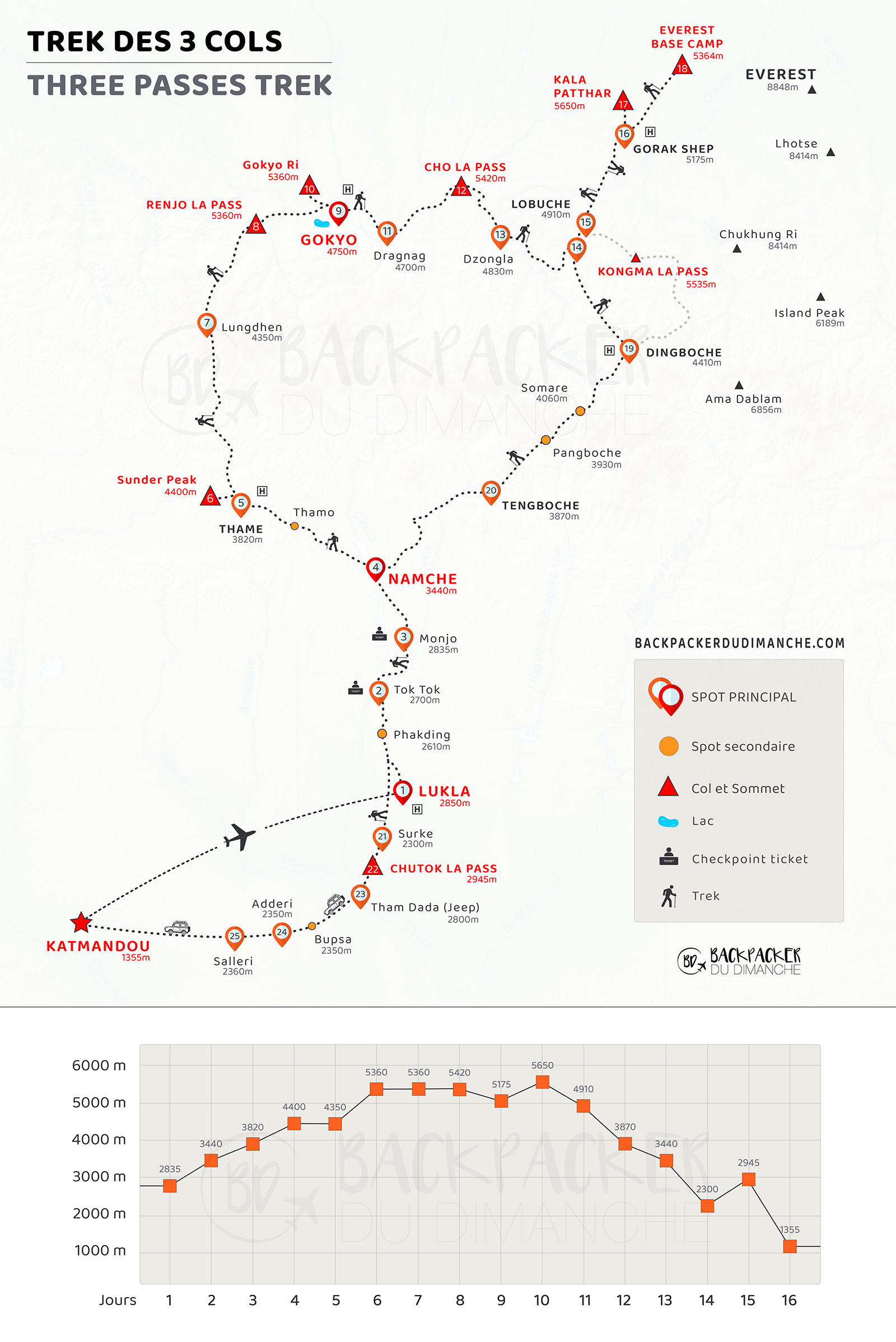
Arriver à Lukla
Avant d’attaquer mon récit sur ce trek, je suis obligé de faire un petit arrêt sur l’arrivée en avion à Lukla.
Pensez à prendre les premiers vols au départ de Katmandou (6 ou 7h du matin). Si vous attendez les derniers vols (9h) les conditions météo deviendront mauvaises et votre vol aura de grande chances d’être annulé. C’est ce qui nous est arrivé.
L’avion se prend au terminal au Domestic Terminal (dans l’aéroport de Katmandou).
L’ aéroport de Lukla est réputé comme étant le plus dangereux du monde car il ne mesure que… 500m. Pour dire… la pente est inclinée à 12° ce qui permet d’aider les avions arrivant à freiner et à ceux qui décollent de prendre de la vitesse… Il enregistre un crash d’avion tous les 2 ans…
Vous avez différentes compagnies d’avions : Yeti Air (la plus connue), Summit Air, Sita Air, Tara Air…
Le sais-tu : les locaux payent 90$ moins cher le billet mais ont du mal à en avoir car ils sont réservés à prix fort aux touristes…
On monte à bord d’un petit avion de 12 places où l’on est tellement proche que l’on peut taper sur l’épaule du pilote pour le féliciter.
Le voyage se passe plutôt bien (30 mn) avec quelques belles turbulences vers la fin quand même ! Ce qui fait le plus peur, je pense, c’est toute cette adrénaline ajoutée à ce qu’on lit sur internet sur Lukla qui nous stress.
Essayez de vous mettre à gauche à l’aller (le paysage sera dingue).

Jour 1 – Lukla vers Monjo
Lukla : 2850 m Monjo : 2835 m 500 D+ / 400 D-
Il est 9h30, à Lukla , on refait nos sacs en fonction de la température et de nos besoins pour la journée. À côté de nous, un groupe de Sherpas s’empile sur le dos 3 sacs chacun de la taille de nos propres sac… j’ai un petit sourire… je regarde autour de moi… et je me dis que ça y est, qu’on y est vraiment !
On décide de rejoindre Monjo qui est l’un des derniers villages avant la montée sur Namche Bazar . Chemin assez facile, ça monte, ça descend, on découvre le paysage montagneux de la région avec une vue dégagée sur des kilomètres.
On rejoint Monjo en 4h assez facilement, ce qui est très bien pour entrainer les jambes (demain ça sera une autre histoire).
On s’arrête au Summit Hotel qui est super sympa (500 rs la nuit) avec… une douche chaude gratuite ET dans la chambre ! C’est un luxe que nous ne reverrons plus jusqu’à notre retour à Katmandou (voir Paris ) !
On se balade le soir dans le village jusqu’à un temple, où l’on est invité à partager une Sherpa Stew, du thé et des gâteaux. Une dame nous explique qu’on est au premier soir de 4 jours de festivités.

Jour 2 – Monjo vers Namche
Monjo : 2835 m Namche : 3440 m 675 D+ / 110 D-
La nuit a été fraiche, entre 10 et 15°, mais pas suffisamment pour sortir le duvet. Les lodges donnent des couvertures.
9h15, on entame la montée vers Namche Bazar . On enchaîne les petits villages et les ponts suspendus plus haut les uns que les autres. On croise des boeufs, des mules, qui approvisionnent les villages et Namche .
L’arrivée à Namche se fait en 1h30, assez vite mais ça grimpe pas mal déjà. Les jambes commencent à s’habituer.
Namche Bazar , perchée au bord de la falaise, est une petite ville où l’on aime se perdre dans les ruelles pavées et qui est un gros carrefour de randonneur s, alpiniste et Sherpas. Je m’attendais à plus de monde, une ville fourmillant de monde avec qui pouvoir discuter de montagne. Mais nous sommes au début de la saison (qui commence dans 10 jours) et nous sommes pratiquement les seuls…
C’est aussi ici que l’on peut faire ses (derniers) achats : duvet, doudoune, gants, bâtons, barres de céréales, etc.
On passe le reste de l’après-midi a déambuler dans ses ruelles étroites plongées dans la brume. En haut de Namche , on surplombe ce village qui a une atmosphère assez mystique en cette fin de journée.

Jour 3 – Namche vers Thame
Namche : 3440m Thame : 3820 m 520 d+ / 170 D-
Le réveil est bon, pas de gros mal de crâne en vue, on décide de monter sur Thame malgré nos 1400 m de dénivelé positif en 2 jours (sachant que c’est 500 par jour recommandé…).
Il fait beau, le sentier longe la montagne, la vue est magnifique… que demander de plus ? On s’arrête à Thamo une bonne heure pour que le mal de crâne de Léo passe. De mon côté, rien à signaler (mais ça va pas durer…). On se prend un grand thermos de thé au lait à côté du monastère.
Le chemin jusqu’à Thame est relativement facile même si on se perd un peu du côté de Samde … sauf si déboucher dans le village à travers les bussions et les bouses est normal…
L’arrivée à Thame par le grand pont suspendu est un bon soulagement. Le mal de crâne de Léo semble doucement disparaitre, la journée se termine bien.
L’arrivée dans le village vers 15h est assez impressionnante, car Thame est sur un plateau au creux des montagnes, le soleil tape, en même temps il fait doux et de la neige persiste dans les coins d’ombre.
Thame ressemble aux petits villages que l’on a croisés jusqu’à maintenant, avec ces petits champs de terre entourés de murs de pierres avec des maisons par-ci par-là, assez étendu.
Le Sun-Shine sera notre point de chute pour 2 nuits. On décide de se poser là le temps de s’acclimater à l’altitude. Ce lodge est géré par l’adorable Nema (Nima) et sa femme. Il s’occupe de vous avec un bébé dans le dos. C’était le meilleur spot de tout le trek.
Internet difficile, pas de chauffage à part le poêle au milieu de la pièce, alimenté en bois et bouse de vache.
Attention, vous n’aurez plus de magasin jusqu’à la fin… donc prévoyez bien avant de partir de Namche.
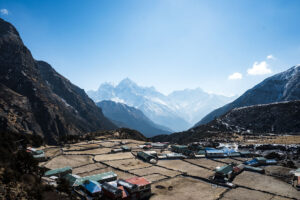
Jour 4 – Thame
Thame : 3800 m
Sale nuit… mal de tête de l’enfer… réveillé à 5h par une douleur au crâne qui me donne envie de me trépaner avec ma lampe de poche… J’avale du Diamox et de l’Aspirine… je mange difficilement mon porridge au petit-déjeuner… on est censé partir à 11h pour grimper le Sunder Peak à 600m de dénivelé, sur lequel est construit un joli monastère… je me force à partir et au bout de 15 mn… plus rien !
La douleur disparait aussi vite qu’elle est venue !
On se monte donc cette petite montagne avec un joli dénivelé de 600 m quand même, avec la neige qui tombe arrivé en haut ! On fait une pause, on sort le saucisson, les suisses sont ravis !
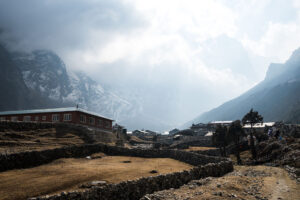
Jour 5 – Thame vers Lungden
Thame : 3800 m Lungden : 4360 m 580 D+
Le premier col se rapproche. Renjo La Pass… L’appréhension aussi… on a 1000 m à gravir dans la matinée. Mais ça, ça sera demain.
En attendant, on doit rejoindre le petit « village » de Lundgen (il doit y avoir 3 maisons) à 10 km de Thame pour y passer la nuit. Le chemin longe la rivière Bhote Koshi , qui nous fait passer par des petits villages de maisons en pierre qui se sont pour beaucoup effondrées durant le tremblement de terre de 2015 .
Nema nous accompagne, il doit aller voir son oncle qui possède le lodge où l’on va et il porte un des sacs des suisses jusqu’en haut de Renjo la Pass. Sympa le mec ! Il est très bavard ! Il a 30 ans, il est marrant. Il nous raconte qu’aujourd’hui il porte un pull moche parce que sa femme l’a obligé vu le froid qu’il fait dehors.
Il nous fait jouer à un jeu qui consiste à envoyer des cailloux sur un gros rocher en face et les cailloux doivent s’arrêter sur le rocher. Autant vous dire qu’on envoie une centaine de cailloux pour peu de résultat. Ça l’amuse beaucoup en tout cas.
Il commence à faire froid quand on arrive à Lungden , la neige se met à tomber…
L’ambiance des lodges est toujours la même, concentré dans la pièce principale autour du poêle , ça discute, ça joue aux cartes, les rares randonneurs et guides (généralement 3 ou 4 avec nous) mangent et se réchauffent, puis vient le tour des porteurs qui mangent après (assez bizarre). J’ai l’impression que les guides prennent un certain plaisir à créer une hiérarchie presque gênante avec les porteurs.
On se couche dans une chambre froide, on sort le duvet ce coup ci.
Durant la basse saison, il y a peu de locaux dans les villages. Ils préfèrent être plus bas ou à Katmandou (surtout peur ceux ayant un lodge). Vous aurez par contre toujours un lodge d’ouvert. Le lodge ouvert durant la basse saison change chaque année, pour faire tourner le business.
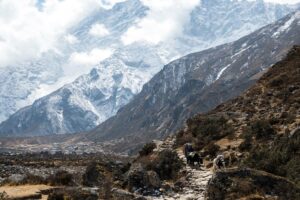
Jour 6 – Renjo la Pass
Lungden : 4360 m Renjo : 5360 m Gokyo : 4750 m 1000 D+ / 590 D-
Aujourd’hui, on attaque d’entrée la partie la plus complexe du Trek es 3 Cols … Renjo La Pass à 5300 m ! En vrai je l’appréhende un peu, car on doit faire 1000 m ce matin et dans la chambre, l’eau des gourdes a gelé, je pense qu’il fait – 10 / -15° (on apprendra plus tard qu’il faisait beaucoup plus froid).
Entre excitation et envie de rester là à élever des yacks, ce réveil est un peu spécial.
Il est 5h30, on prend notre petit déjeuner, on s’équipe et on s’élance vers ce premier col .
Ca ne fait pas 30 mn qu’on a commencé, que j’ai une douleur atroce dans les doigts… comme des aiguilles… ils sont en train de geler ! Les 3 phalanges de tous mes doigts (sauf les pouces) sont bleus !
C’est la galère… je fous mes mains dans le froc, sous les bras, le ventre, tout ce que je peux… j’aurai volontiers pissé dessus si j’avais eu envie.
J’apprends plus tard qu’il ne faisait pas -15° mais -35° et que j’aurais dû mettre tout de suite mes gants les plus chauds… Le souci de la marche avec les bâtons, c’est que le sang circule moins bien dans les extrémités.
Après 5mn d’effort (et d’insultes envers moi-même), ça semble s’améliorer. Bref, l’ascension vers Renjo continue.
L’ascension
L’ascension jusqu’au Renjo la Pass est relativement simple, jusqu’au dernier tronçon (quand on est au pied de la montagne). Le manque d’oxygène se fait sentir. C’est assez drôle la sensation d’épuisement alors qu’on sent que physiquement, les jambes et le corps suivent.
Jusqu’ici, le terrain n’est pas trop accidenté, heureusement qu’il a neigé cette nuit pour voir où l’on va (un guide est passé avec 2 allemands 1h plus tôt). C’est la technique qu’on a utilisé n’ayant pas de guide : suivre les traces.
On passe à côté de petits plans d’eau, on suit un semblant de sentier jusqu’au pied du dernier tronçon, la vue est dégagée sur la vallée qu’on a traversée. L’oxygène est de plus en plus manquante (on doit en avoir que 50%).
Arrivé au dernier plan d’eau, il reste 200 m à gravir, qui seront les plus hard ! On va pas se mentir, les bâtons n’empêchent de m’effondrer sous mon propre poids tous les 10 pas !
Je me chantonne une comptine (« un éléphant qui se balançait… ») qu’on a (trop) chanté à mon filleul il y’a quelques jours. Elle m’aide à garder mon souffle et mon rythme. Après quelques vertiges et un épuisement complet… la vue en haut du col est merveilleuse !
Gokyo se découvre derrière le lac d’un bleu fou !
Un petit sandwich, un peu de saucisson, des petites miettes jetées aux drôles d’oiseau qui nous attendaient et on descend vers Gokyo .
La descente est longue (2h) et on se perd un peu sur le glacier à la recherche d’un chemin.
On arrive enfin à Gokyo , où l’on est un peu seul. Dans le refuge ( Cho-Oyu , face au lac), on doit être 5 ou 6. On décide d’y rester 2 nuits pour souffler un peu et aller se balader dans le coin.
Pour la douche chaude… on repassera. C’est beaucoup d’émotion pour pas grand chose, on lutte à avoir un jet relativement puissant, mais bon, ça fait quand même un peu de bien !
Wifi : le wifi est disponible en achetant des petites cartes auprès du refuge.

Jour 7 – Gokyo
Gokyo : 4750 m
Pas de réveil, pour une fois ! On a dû se coucher à 21h30 et réveillé à 9h ! Le tour du cadran !
Pour notre journée de repos, on va se balader un peu voir les lacs . On part sur « 2nd Lake », qui d’après le gérant du refuge, serait le plus sympa. Ce n’est qu’à 20 mn à pied du lodge et effectivement, il est bien sympa.
Dans ce silence, on entend la glace, à la surface du lac, craquer.
L’après-midi ça sera sieste et bouquin.

Jour 8 – Gokyo Ri vers Dragnag (Thagnak)
Gokyo : 4750 m Gokyo Ri : 5350 m Dragnag : 4700 m 600 D+ / 600 D-
C’est reparti pour un réveil à 6h ! Planning du jour : ascension du Gokyo Ri.
Le Gokyo Ri est une montagne qui domine toute la région (« Ri » veut dire « sommet » en Tibétains) et avec une vue folle à 360° sur le lac, Gokyo et le glacier.
Hormis la vue, monter la haut permet de s’acclimater aux prochains cols (le sommet du Gokyo Ri est à 5350 m), car on va commencer à bien grimper jusqu’au Camp de Base de l’Everest .
La montée se fait assez facilement maintenant qu’on a passé Renjo . Le sommet donne vraiment une vue dingue sur le lac ! Ça vaut clairement le coup.
On est seul, pas un bruit… rien. Tellement agréable !
On rentre manger au lodge et on entame la drôle de traversée du glacier. Avant de partir, la patronne du lodge nous offre des Snickers. Seuls ceux qui ont fait le Trek des 3 Cols ( Three Passes Trek) ou le trek de l’EBC comprennent ce que signifie le Snickers !
Un long glacier que l’on traverse en largeur pour rejoindre le « village » de 4 maisons de Thagnak . Le glacier est recouvert de pierres et donne l’impression d’un paysage lunaire. On découvre par ci par la quelques petits lacs et ou crevasse qui nous laisse apercevoir l’épaisseur transparente de la glace. Ça a été un vrai bon moment.
On arrive au village en fin de journée, il commence à neiger, à faire froid et la brume tombe donnant un côté très mystérieux à cet endroit.
Le Khumbila Lodge (400 Rs la nuit en négociant un peu) sera le plus gros que nous ayons fait, on est étrangement 30 ce soir ! C’est 10 fois plus que dans les précédents ! Chaque groupe est avec son guide, il n’y a pas trop d’échange entre les groupes, ça fait un peu usine mais ça fait une ambiance agréable quand même.
Ça permet aussi de voir la différence entre les groupes qui interagissent avec leur guide et porteur et ceux qui restent entre eux les laissant de côté…

Jour 9 – Cho la Pass
Dragnag : 4700 m Cho la pass : 5370 m Dzongla (Zanlhag) : 4830 m 670 D+ / 540 D-
Ce col là est bien plus sympa, il se fait en 2 étapes : ça grimpe, c’est plat et ça re-grimpe.
Température extérieure -15° / -20°, donc pas bêtes 2 fois, je mets les gros gants !
Le premier tronçon se fait assez facilement en 1h30 en prenant son temps. On monte le long et sur la rivière gelée . On entend l’eau couler sous nos pieds.
On s’arrête sur la partie plate pour reprendre un peu notre souffle avant d’attaquer la plus grosse partie.
La deuxième étape est plus raide, on croise 3 gars qui nous demandent si on a bien nos crampons… héhé… non… on devrait ?! En effet avec des crampons c’est surement plus agréable à certains moment, car ça glisse bien. Il y’a une ligne de vie tout de même pour s’aider donc ça passe.
En haut du col on a une impressionnante vue sur le glacier et la vallée en dessus. Il va falloir qu’on marche dessus pour rejoindre le petit village de Dzongla .
La descente
La descente nous a paru une éternité, on en voyait pas le bout ! La première partie, sur le glacier, il faut bien suivre les bâtons rouges, sinon on mets le pied dans une petite crevasse.
Après 1h dans un paysage de terre et de roche, on découvre le micro village de Dzongla . On s’arrête à « Maison Sherpa », on prend la chambre (gratuite si on mange sur place), on s’assoit sur le lit… et on s’endort, sac sur le dos !
Autour du poêle, on discute avec un anglais qui fait le même trajet que nous mais plus doucement, car il doit avoir 65 ans… et a des problèmes de coeur ! On papote, on discute du cours du Snickers .
Le lodge fonctionnant au solaire, on a pas d’électricité h24. De toute façon, on ne fera pas de vieux os ce soir !

Jour 10 – Gorak shep
Dragnag : 4700 m Lobuche : 4910 m Gorak shep : 5175 m 475 D+ / 130 D- Temps : 4h (avec une pause dej d’1h à Lobuche)
Départ à 7h45 pour monter sur Gorak Shep en prévision d’y passer 2 jours pour monter sur Kala Patthar et le Camp de Base de l’Everest .
Gorak, c’est le nom des corbeaux que vous verrez le long du trek.
Le sentier qui va nous amener à Lobuche longe la montagne en surplombant la vallée et les glaciers. Une fois la première montagne passée, on voit des hélicoptères passer toutes les 10 mn (touriste, matériel, rapatriement…), un vrai ballet.
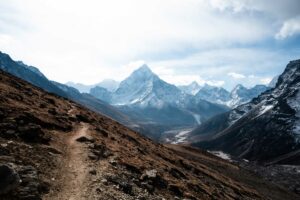
Notre trajet sur le Trek des 3 cols, croise maintenant celui du trek de l’Everest Base Camp (EBC Trek) , on commence donc à voir un peu plus de monde. On parle de 8 ou 10 personnes en plus, hein, mais comparé à notre solitude depuis le début, ça fait beaucoup de monde !
Petite bifurcation au mémorial pour les disparus de l’Everest . Ca me tenait à coeur d’y aller, pour se rendre compte à quel point l’alpinisme ou la simple rando en haut montagne n’est pas une partie de plaisir. Je me rends compte que beaucoup d’alpiniste disparaissent sur la décente du sommet (fatigue, manque d’oxygène…).

Après 2h30 de marche, on s’arrête à Lobuche pour manger un morceau au Peak XV . Il reste un bon bout de chemin à faire encore.
1h avant d’arriver, la neige commence à tomber, on est dans les nuages et il y’a encore le petit col de Lobuche à passer. Il est pas hyper haut, mais il est raid, et on en avait pas envie !
Le col passé, on se retrouve sur le glacier, au milieu des rochers, avec la neige et le brouillard , c’est vraiment pas simple. À chaque crête on pense que c’est fini… et non… ça va durer 1h, ça n’a pas été la partie la plus marrante du trek.
On arrive enfin
On arrive enfin à Gorak Shep , le dernier point de vie du coin. On s’arrête au premier lodge, l’Hymalayan , qui est (après avoir regardé les 2 autres), celui le plus accueillant, même si sommaire.
On se pose dans la chambre, je m’endors, et je me fais réveiller par de la neige qui me tombe dessus… je n’avais pas vu que la vitre était cassée et qu’il neigeait dans la chambre… On change de chambre, au rez-de-chaussée, ça fera l’affaire.
Si vous pouvez, le bon plan et de choisir la chambre la plus au-dessus ou à côté de la pièce de vie, car il y’a le poêle qui chauffe la pièce.
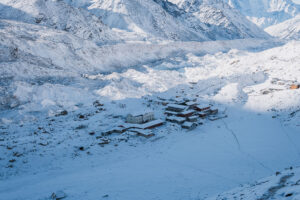
Jour 11 – Kala Patthar et EBC
Gorak shep : 5175 m Kala Patthar : 5648 m Camp de base Everest : 5364 m 540 D+ / 540 D- Temps : 6h
Kala Patthar
Départ à 5h30 pour aller apprécier le lever de soleil au sommet du Kala Patthar (partir à 5h serait même mieux). Il y’a 500 m à grimper, ça va nous réveiller !
Évidemment, à cette heure là et cette altitude… on est à -30° ! Les doigts regèlent, mais ça passera plus facilement qu’à Renjo !
Arrivé en haut du Kala Patthar , les lueurs des premiers rayons de soleil viennent caresser le haut des montagnes et de l’Everest. On domine tout le coin, c’est plutôt agréable !

On n’y reste pas faire une partie de belote, donc on reprend le chemin inverse 30 mn plus tard pour rejoindre le chemin de l’ Everest Base Camp . Normalement, il y aurait un raccourci, mais on ne l’a pas trouvé. Les hélicoptères continuent de faire visiter le coin au touristes fortunés qui veulent juste le voir, sans s’y arrêter…
J’ai un peu de mal avec leur concept de « protégeons nos montagnes » et au final, « open bar sur les hélicos » !
Bref, on revient vers Gorak Shep pour récupérer le chemin pour le camp de base. Je voyais ça plus près car au final on fait une belle marche d’1h30.

Camp de Base de l’Everest
Le Camp de base n’est pas encore entièrement équipé. Seulement quelques tentes par ci par là. Les Sherpas et les yacks sont justement en train de monter les équipements . On les croise avec des planches, de la nourriture, du gaz… tout s’agite pour l’ouverture de la saison dans une semaine.
On finira la journée au lodge avec du Milk tea et du saucisson. Il est midi, on a fait nos 10 000 pas !

Jour 12 – Lobuche
Gorak shep : 5175 m Lobuche : 4910 m 265 D- Temps : 2h
On décolle de Gorak Shep et sur le chemin, on croise une foule de gens. Ça semble être des vagues tous les 2 jours (un jour il y a foule, l’autre c’est vide).
Une rumeur de tempête de neige cours depuis 2 ou 3 jours, jusqu’à maintenant on a toujours eu 24h d’avance sur la neige, on espère qu’on ira plus vite que la tempête.
On redescend tranquillement sur Lobuche pour y passer la journée et la nuit. On s’arrête au New EBC qui est clairement le meilleur du coin. Tenu par une femme, le lodge est top, elle est adorable , bref c’est parfait pour se reposer avant le dernier col demain matin : Kongma , que l’on peut voir depuis le lodge (c’est la première fois que l’on peut voir d’en bas, le col qu’on va faire).
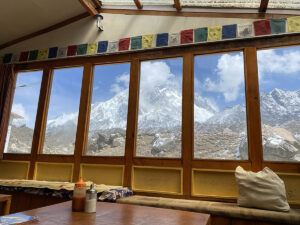
Jour 13 – Tengboche
Lobuche : 4910 m Tengboche : 3867 m 240 D+ / 1300 D- Temps : 7h30
Au réveil, rien ne se passe comme prévu… vers 5h, j’entends dans la chambre d’à coté… « Hôpital, oxygène, hélicoptère… », ça commence mal… On se lève pour le petit-déjeuner et on voit par la fenêtre que le temps est vraiment pas bon : nuage, neige, mauvaise visibilité…
En descendant, on voit le malaisien qui était dans la chambre d’à côté sous des couvertures, ça s’agite… il est à 35% d’oxygène. C’est pas bon du tout. Les hélicos ne peuvent pas venir à cause du temps. Il y’a une tempête de neige qui sévit. Elle nous a rattrapé…
Quelqu’un trouve de l’oxygène pour le gars, il va remonter péniblement à 50% et la patronne du lodge le secoue toutes les 2mn pour qu’il respire, sont corps en a perdu le réflexe.
On apprendra le lendemain qu’un Tchèque de 68 ans est mort la veille à Gorak Shep dans les mêmes conditions…
Avec Léo, on se regarde, on regarde le col qu’on ne voit plus, on se tâte… ne pas faire le 3e et dernier col serait dommage et en même temps ça semble risqué. On a pas de guide, pas de porteur, le sentier la haut n’est visiblement pas bien indiqué contrairement à Cho la Pass . Donc on a toutes les chances de se perdre, d’avoir froid et en plus d’arriver en haut et ne pas avoir de visibilité sur la vallée.
On prend la décision la plus sécurisante, on va couper par en bas et tant pis pour ce col. On aura eu raison, car tout au long de la descente, le sommet sera dans les nuages.
Dingboche est notre objectif aujourd’hui.
À la conquête de Dingboche
On traverse les plaines vierges, c’est calme, reposant et le fait que ça descende doucement et vachement agréable. On arrive en surplombant le village , c’est très joli. Comme on est arrivé assez tôt finalement, on décide de continuer jusqu’à Shomare .
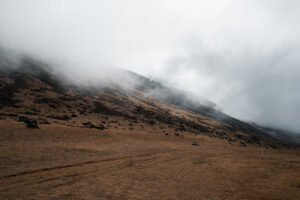
Shomare est très mignon comme village. On en a encore dans les jambes, donc on décide de pousser finalement jusqu’à… Tengboche !
Le chemin surplombe la rivière qui est magnifique avec ses couleurs turquoise et rouge . On traverse de petits villages d’agriculteur avec tous ces petits champs cerclé de pierre.
La neige commence à tomber, il nous reste encore 30 mn. Ça s’assombrit, il fait froid, on marche en plein brouillard et on en a plein les pattes. Bien content d’arriver !
Le lodge principal, Tashi Deleck , est immense. Il y’a la pièce principale plus un petit magasin de pâtisserie.
- Nuit au lodge : 500 Rs
- Snickers : 300 Rs

Jour 14 – Namche
Tengboche : 3867 m Namche : 3440 m 330 D+ / 760 D- Temps : 4h
On se réveil avec le soleil et 3 cm de neige dehors, autant dire que le paysage est magnifique !
Pile à ce moment, le monastère ferme (il ouvre toutes les 2h), mais on peut le voir de l’extérieur avec ses super couleurs et la neige, c’est magnifique.
La descente vers Namche se fait assez facilement, même si le premier tronçon est une bonne descente qui tire sur les mollets. On a commencé avec les doudoune et la neige et on finira en tee-shirt tellement la température change vite.
En arrivant à Namche , on prend un lodge qui fait de la… raclette ! Bon, on paye cher pour ce que c’est… le fromage est assez fade, pas de viande, que des légumes cuits. Sacrés touristes…

Jour 15 – Surke
Namche : 3440 m Surke : 3440 m 330 D+ / 1460 D- Temps : 8h
Pour finir le Trek des 3 Cols, on a décidé de ne pas rentrer avec l’avion, mais de prendre une jeep de Bupsa jusqu’à Katmandou . On ne le sait pas encore, mais ça va être une sacrée aventure…
On doit donc faire en une journée, ce que l’on a fait en 2 jours à l’aller. Soit 20km, mais en descendant et surtout, arriver avant la nuit.
On repasse par tous les petits villages d’il y’a 10 jours, ça a une saveur différente, presque familiale. Un petit thé à Tok tok , où l’on voit passer une bonne quinzaine de caravanes de mules !
On mange à Phakding , où la patronne fabrique ses Momo sous nos yeux (et ils sont très bons !), puis on s’arrête au bout du village faire un foot avec les gamins. On a pas été bon, on dira que c’était la fatigue…
Jusqu’à Chaurikharka , ça va, le sentier se tient, les villages sont sympa. Après ce village, ça devient très très rural… on passera le reste de la journée à marche dans un mélange de bouse et boue… surement bon pour la peau des pieds…
En arrivant à Surke vers 16h30, on est bien content. Il restera encore demain, à passer le col Chutok , puis ça sera la jeep.
Surke est un petit village très mignon , perdu au creux de la montagne. Faut pas avoir oublié le pain en rentrant…
On dormira à l’ Everest Trail Lodge . Sympa, simple et efficace.
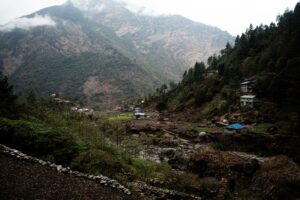
Jour 15 – Surke vers Tham Dada puis Salleri
Surke : 3440 m Thame Dada : 2900 m Salleri : 2362 m 790 D+ / 170 D- Temps : 11h
Bon, là, clairement… on est sur le pire trajet que j’ai jamais fait de ma vie… même les chauffards en Indonésie ou les Tuk tuk de l’enfer au Sri Lanka c’est rien à côté de ça. !
On part assez tôt de Surke car la route est plus ou moins simple à comprendre. On se prend d’entrée de jeu les 600m du col de Chutok , puis on marche le long de la montagne.
On sait qu’ils sont en train de détruire la montagne pour construire une route pour les 4×4… donc on ne sait pas trop par où on doit passer. Et en effet, on voit au loin les grosses explosions à la dynamite pour déchiqueter la montagne.
En discutant avec les habitants des villages que l’on croise, ils sont contents de cette route, ça va amener plus de touriste. Ça sera malheureusement la fin de leur tranquillité, mais on ne peut que les comprendre de vouloir avoir accès à la route, à la modernité, au tourisme et donc à l’argent. Rien est dit d’ailleurs qu’ils ne raseront pas leur maison pour faire la route…
Les 2 chemins
On avance donc, en sachant qu’ il y’a 2 chemins , un qui monte, qui rallonge mais qui fait passer au-dessus du chantier, et un autre, où normalement le chantier devrait se trouver. On croise un gars qui nous dit qu’on peu passer vers le chantier… sachant qu’ils font tout exploser, on est moyen chaud, mais lui il y va. Alors on le suit.
Et en effet… le mini chemin s’arrête, car plus de montagne, mais en escaladant un peu (facile avec les sacs…), on passe à travers les mecs qui piochent la montagne… hallucinant.
On s’arrête un peu plus haut pour manger, dans une des dernières habitations debout (l’endroit s’appelle ou s’appelait Thame Dada ). La montagne ayant disparue, il ne reste qu’une grosse route boueuse et caillouteuse… et une jeep ! Un type nous demande où on va, on lui dit Bupsa puis Salleri , il nous propose de nous y emmener après le déjeuner.
Fini de manger, on monte dans le 4×4 … et là commence le pire trajet du monde.
Thame Dada vers Adderi
Ca bringueballe dans tous les sens, ça serpente, ça secoue. Il faut comprendre qu’on est sur une route qui n’est pas terminée, comme si vous conduisiez dans un chantier en cours.
Arrivé à Adderi après 2h de voiture (soit à encore 4h de Salleri), le chauffeur s’arrête et nous dit « fini ». Comment ça fini ? on est au milieu de nul part ! « Fini, plus de route »… et en effet, 50 m plus loin, un trou béant avec un pont à moitié en cours de construction… la blague !
Mais c’est pas grave, il trouve le premier gamin qui passe, qui a une jeep, il faut juste monter plus haut dans le village pour récupérer la route. On suit notre nouveau chauffeur, on monte dans sa jeep et c’est reparti.
Adderi vers Salleri (un cauchemar)
Bon, là, rien allait… le trajet s’est fait de nuit, dans la brume, sous des trombe d’eau, sur un chemin boueux défoncé et en pente (donc torrent d’eau sur la route) avec la même musique en boucle à fond et le mec conduisant à une main, car dans l’autre il y’a le téléphone. On part en travers à 2m du ravin, on patine, on galère. Je cherche des endroits où m’agripper quand on fera des tonneaux dans le ravin, car pour moi je ne vois pas d’autres fins…
Ça sera un enfer comme ça pendant 4h. On arrive à Salleri , épuisé par le stress et la journée…
On prend le premier lodge ouvert et on y passe la nuit.
À savoir, en arrivant à Salleri, booker immédiatement la Jeep pour le lendemain, sinon vous n’en aurez pas.
Jour 15 – Salleri vers Katmandou
Temps : 12h
De bon matin, on va au premier kiosque qui book des Jeep , et on comprend rapidement qu’il n’y en a plus, tout a été réservé la veille. Il faut attendre demain… moyen cool.
En insistant un peu auprès d’un mec qui va profiter un peu de la situation, on arrive à avoir une Jeep à 15 000 rs, soit 100€ (puis 10 000 Rs (68€) avec l’aide de notre lodge qui lui demande d’arrêter de nous arnaquer). En échange, il prendra les auto-stopper sur la route (il en prendra quasiment une dizaine en tout)
Le trajet est très très long, mais le paysage est vraiment chouette.
Fin de journée, ça se complique…
A 30 km de Katmandou , la nuit tombe et je comprends que le mec commence à être inquiet… il n’a plus de phare. Et là bas, les lampadaires n’existent pas vraiment… donc on est là, à 8 dans la Jeep, à rouler dans le noir, phare éteint. Il essaie de coller aux autres voitures pour bénéficier de leurs lumières et autre technique, faire marcher les clignotants (un coup à droite et un coup à gauche) pour faire de la lumière… sympa ! On s’arrête finalement à un gros carrefour, qui semble être le point des Jeeps ! Et là on se retrouve au milieu de la circulation, à récupérer nos backpacks avec une horde de taxi qui nous sautent dessus.
On finira dans un petit hôtel dans le super quartier de Thamel !
À refaire, je prendrai clairement l’avion (100€ plus cher, mais 47h plus rapide). Les 2 derniers jours n’ont pas été agréables du tout et faire autant de Jeep avec autant de mauvaises conditions, c’est pas cool. Ça fera clairement des souvenirs et des choses à raconter, mais sur le moment c’était l’enfer.
Conclusion sur le Trek des 3 cols
Ce trek des 3 cols est clairement le plus beau que j’ai fait, peut-être parce que le plus douloureux et que je fais un bilan difficulté/beauté. Dans les Rocheuses au Canada, c’était magnifique, complètement sauvage, les paysages incroyables, mais au Népal, peut-être ce côté difficile d’accès, peu touristique, l’Everest… bref, ça ne s’explique pas.
Il n’y a pas besoin d’être un athlète de haut niveau ou un alpiniste pour faire ce trek. Une bonne condition physique et de bons gants (haha…).
Le trek du Camp de Base est plus simple et plus accessible à tous.
Le fait d’avoir fait le trek sans guide et sans porteur était un choix, non pas économique, mais pas souci de vouloir le faire à 2. Certains diront qu’on ne contribue pas au commerce local, le débat est ouvert, mais je pense que tout le monde ne se déplace pas en taxi en France…
Ca se fait très facilement sans. L’application Maps Me , quelques renseignements avant, puis les sentiers sont assez souvent visibles.
L’avantage du guide par contre, s’il est anglo ou francophone, c’est qu’il vous permettra d’en savoir plus sur la région, de lui poser des questions, etc.
Au tout début de la saison, il n’y a pas grand monde dans les villages, donc peu de rencontre avec les locaux hormis dans les lodges, peu de monde sur les sentier aussi et ça c’est très agréable !
Bref, si on aime les trek en haute montagne, le trek des 3 cols au Népal est juste incroyable !
EBC or not EBC
Ne pas passer par le Camp de Base de l’Everest (EBC) serait une erreur à mon avis (sauf si vous êtes pris par le temps), car il n’est pas si loin du tracé du trek et à moins de revenir dans la région plus tard, on a peu d’occasion d’y revenir.
Il faut compter 14 jours pour terminer le trek (Lukla à Lukla). On a choisi de prendre 2 jours d’acclimatation pour que notre corps ne nous lâche pas. Je conseille fortement de faire la première acclimatation à Namche, même si votre corps vous donne l’impression d’être ok, le lendemain vous risquez de le payer.
Les villages se rejoignent facilement dans la journée (entre 4h et 8h de marche par jour) et vous trouverez toujours un truc ouvert pour dormir.
Rentrer sur Katmandou
Comme dit dans l’article précédent, à refaire je prendrais l’avion pour rentrer. C’est une expérience aussi, avec l’incapacité de savoir si vous aurez votre avion le jour souhaité, mais vu la galère que sont les Jeep…
Article précédent
Article suivant
Vous aimerez aussi
Vidéo du trek des 3 cols (three passes trek) au népal.
En mars 2023 je partais sur le trek des 3 cols (Three passes trek). Après 150 km, 3 cols et 7080 de dénivelés...
Népal, nouvelle règle sur les guides au 1er avril 2023
Nouvelle règle sur les guides obligatoires au Népal, voilà ce qui agite la communauté des voyageurs au Népal en ce...
Laissez un commentaire Annuler la réponse
Votre adresse e-mail ne sera pas publiée. Les champs obligatoires sont indiqués avec *

COMMENTS
Difficulty. Very Challenging. Accommodation. Teahouse. The Everest Region is one of Nepal's top trekking destinations, and the Three Passes Trek is its ultimate trekking adventure, crossing three passes over 5,000m, each offering amazing scenery and views. This trek was ranked the number 2 on kimkim's list of the best treks in Nepal .
Day 01: Tara air to Lukla Hillary airport early in the morning ( 2860 meters, 35 minutes) and treks to Phakding ( 2640 meters, 3 hours). Overnight at Lodge. During the evening village tour, Day 02: Trek to Namche Bazaar ( 3440 meters 6/7 hours walking) and stay the night at the lodge.
The Three Passes Trek in Nepal is in the Everest Region (Sagarmatha National Park) and takes trekkers across three high passes, Kongma La (18,209 ft / 5,550 m), Cho La (17,782 ft / 5,420 m), and Renjo La (17,560 ft / 5,360 m) - hence, the Three Passes Trek. It's a lollipop loop that can be done starting at Lukla (that scary mountain airport ...
Nepal's Three Passes Trek is perhaps the greatest trekking adventure you can have in the Khumbu (Everest) region of Nepal. Also known as the Three High Passes, this loop trek wraps around Sagarmatha National Park, leading trekkers over the Khumbu passes of Kongma La at 5,550 m (18,209 ft), Cho La at 5,420 m (17,782 ft), and Renjo La at 5,360 m (17,560 ft).
The Everest region is one of Nepal's top trekking destinations, with the Three Passes Trek being the ultimate challenging destination. You cross three passes over 5,000 m, each offering panoramic views of some of the world's highest mountains.This adventure in the Himalayas gives you a unique experience in terms of the vistas and culture of the Sherpa people.
Three Passes Trek - A Complete High Altitude Route in Everest. Three Passes Trek offers the ultimate trekking experience in the Everest region. This 3 passes trekking explores the high pass routes in the Himalayas. This is a strenuous and less-trodden high-altitude trek in Nepal. It best suits to experienced trekkers with good physical fitness.
Nepal - 3 Passes trekking adventure. A 12-day travel itinerary with tips for the 3 Passes Trek and the Katmandu area. Being active travel lovers who experience peace and awe in the mountains, Nepal has been on our 'bucket list' for more than 20 years. My husband, who is a professional photographer, suggested the trip when we first met.
Your 17-day Everest Three Passes Trek begins with a breathtaking 45-minute flight from Kathmandu to Lukla (2,840m). After crossing several suspension bridges over the fast-flowing white rivers, you will reach Namche Bazaar (3,440m) the next day. You will stay one more day at Namche Bazaar for acclimatization.. While in Namche Bazaar visit shops, restaurants, and internet cafes.
Trek to Chhukung (4,730 m) from Dingboche - 4 to 5 hours. Overnight at a guesthouse. Day 09 : Trek to Lobuche (4,910 m) via Cross Kongma La pass (5,535 m) - 7 to 8 hours. Overnight at a guesthouse. Day 10 : Trek to Everest Base Camp (5,364 m) and then back to Gorak Shep (5,164 m) - 8 to 9 hours.
The trek is more challenging than the classic Everest Base Camp Trek and its other variations as it involves traversing the three high passes that lend the trek its name - Renjo La, Cho La and Kongma La - each over 5,000m. The trek begins in the popular starting point of Lukla before heading north along the classic trek to Namche Bazaar.
The 3 Passes Trek in Nepal is a challenging trekking route that takes you through the heart of the Himalayas in Nepal. The trek is a circular route that starts and ends in Lukla, with the aim of crossing three high passes in the Khumbu region: Kongma La (5,535m), Cho La (5,420m) and Renjo La (5,360m). The trek takes around 20 days to complete ...
2. Cho La (5,420m): This pass requires a bit more technical skill, especially during the icy conditions of the pre-monsoon season. However, the view of Ama Dablam, Cholatse, and the shimmering Taboche Tsho Lake more than compensates for the challenge. 3. Kongma La (5,535m): The highest of the three passes, Kongma La offers dramatic views of ...
Learn everything you need to know to prepare for the Three Passes Trek. Discover the basics, see the difficulty rating and use our list of tips.
That being said, if you are stuck in Lukla, you can take a helicopter to Phaplu, then a 10-hour jeep or bus ride. The helicopter will cost about $200 USD, and the jeep will cost 13,000r to 20,000r depending on the demand. I'll go into more detail about this option in the last section.
Day 01: Arrival to Kathmandu. Day 1 of the three passes trek begins after arriving at Kathmandu. After boarding the flight in their home countries, they will make Kathmandu their first destination. Exiting Tribhuvan International Airport, they will have officially entered the land of Nepal. After arrival to Kathmandu, the trekkers will be ...
Our goal is to ensure that you have a satisfying and enjoyable culinary experience throughout the Everest Three Passes trek, offering a balance of convenience and flexibility in your dining ...
The trek typically starts and ends in Lukla, the gateway to the Everest region. The route takes trekkers across three high mountain passes: Renjo La Pass (5,360 meters), Cho La Pass (5,420 meters), and Kongma La Pass (5,535 meters). Each pass offers a unique set of challenges and rewards, from steep ascents to mesmerizing panoramic views.
A detailed daily itinerary is on the Itinerary tab above: Days 1 & 2 : Arrival and preparation/rest day/ sightseeing in Kathmandu. Days 3 - 20 : Fly to Lukla* and under take circular 3 Passes Trek. Reach Everest Base Camp on day 12. Days 21 - 22 : Fly back down to Kathmandu & depart. *If you are not time restricted there are options to travel ...
Nepal's Three Passes Trek - Tips for Solo Travelers. Posted On 2022-04-29. Trekking and climbing in Nepal's Himalayas happens in one of two season openings: Spring (late March-May) and Autumn (October-November). We (2 guys) landed in Kathmandu on evening of 2022 April 2 and flew back on April 23. Health condition slightly modified our ...
Namche is tucked away between two ridges and has lots of lodges, tea shops and souvenir shops. Today we will trek up to the Everest View Hotel at 3880m for our first view of Ama Dablam and Mount Everest. Following the 'walk high, sleep low' principle, this hike will really help with your acclimatisation. Hiking time: 3 - 4 hours; Ascent: 430 m
Trek des 3 cols (Three Passes Trek) - Népal. Trek des 3 cols ou le Three Passes Trek au Népal. Ce trek qui sort des sentiers battus et qui emprunte des chemins peu fréquentés. Je vous raconte cette aventure ! Dans cet article je vais vous partager cette super aventure qu'a été le Trek des 3 cols dans le sens des aiguilles d'une montre.
Three Passes Packing List. Here is my recommended Three Passes packing list and what I usually bring on most hikes in Nepal, including the Three Passes, the Manaslu Circuit, and the basic trekking kit for climbs like Island Peak and Mera Peak.. I initially developed this list based on my personal experience on the Three Passes trek, as well as with the help of several trekking shops in Thamel.